

18 Top-Rated Tourist Attractions in Seville
Written by Michael Law and Lisa Alexander Updated Dec 24, 2023 We may earn a commission from affiliate links ( )
Author Michael Law spent a week soaking up the sights of Seville in the fall of 2022.
From the minute you step foot on the quaint cobblestone lanes and stroll the palm-lined promenades of Seville, you'll be enchanted. Elegant edifices, old-fashioned street lamps, and horse-drawn carriages create a magical ambience, and the sights are as stunning as the famous flamenco performances and flamboyant festivals.
The city boasts the largest Gothic church in Christendom with a majestic tower that was once the minaret of a great mosque. Another relic of the Moorish past, the Alcázar dazzles with its lavish Mudéjar decor and lush gardens.
The charm of this quintessential Andalusian city is found in the quiet courtyards and winding alleyways of the medieval Barrio de Santa Cruz, as well as in the beautiful open spaces of the Parque de María Luisa and the Plaza de España, Seville's most graceful square.
Brimming with cultural attractions, Seville is a gem of Southern Spain's Andalusia region . Find the best places to visit with our list of the top attractions and things to do in Seville.
1. Catedral de Sevilla
2. real alcázar, 3.plaza de españa, 4. parque de maría luisa, 4. barrio de santa cruz: seville's most charming neighborhood, 5. museo de bellas artes, 6. iglesia colegial del divino salvador, 7. santa semana (holy week festival), 8. museo del baile flamenco (museum of flamenco dance), 9. real maestranza de caballería de sevilla, 10. barrio de triana, 11. casa de pilatos, 12. museo arqueológico de sevilla, 13. ayuntamiento de sevilla (town hall), 14. palacio de la condesa de lebrija, 15. monasterio de santa paula, 16. archivo general de indias, 17. torre del oro, 18. metropol parasol, 19. seville's riverfront, where to stay in seville for sightseeing, tips and tours: how to make the most of your visit to seville, map of tourist attractions & things to do in seville.
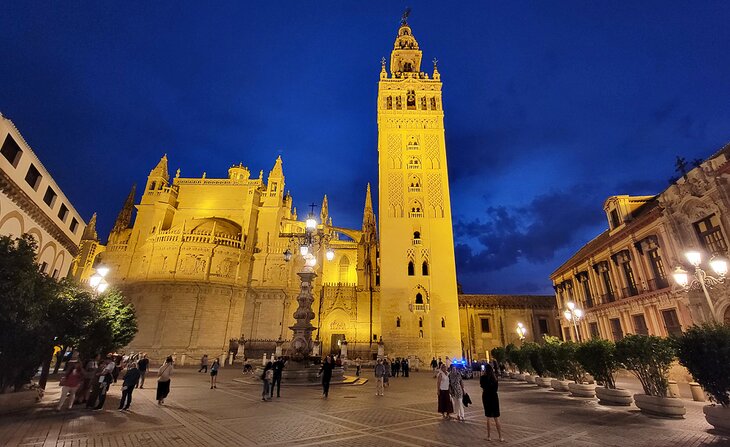
The Catedral de Sevilla makes an unforgettable impression. As the world's largest Gothic cathedral , this monument is unmatched in its impressive scale and abundance of art treasures. Listed as a UNESCO World Heritage Site , this glorious place of worship was constructed between 1402 and 1506 on the site of the town's principal mosque.
The cathedral's bell tower, La Giralda , was originally the minaret of the mosque built in the 12th century by Moorish rulers of the Almohad dynasty. This 93-meter-high tower is still the emblem of Seville.
Entering the cathedral, visitors are surprised by the immense proportions of the nave. The five-aisled interior extends 117 meters in length and 76 meters across and soars to 40 meters in height. This overwhelming space is the most grandiose Gothic interior in Spain.
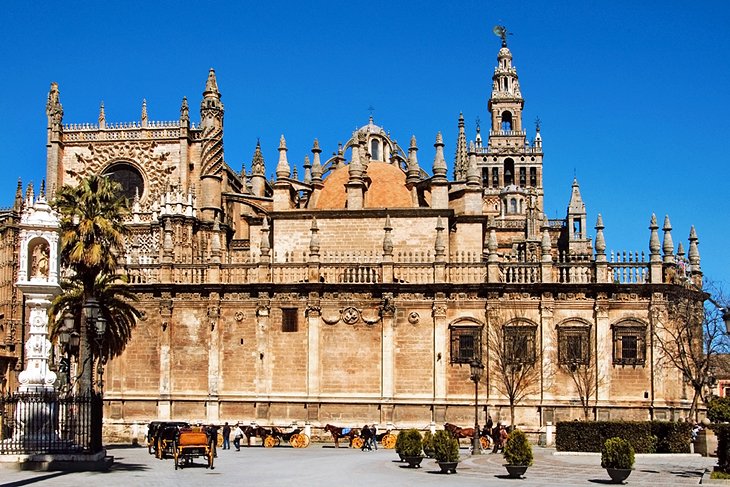
The Capilla Mayor (Main Chapel) features a resplendent retablo , considered a masterpiece of Gothic woodcarving. In the center is an image of the Virgen de la Sede surrounded by 45 scenes from the Life of Christ and the Life of the Virgin. In the south transept stands a striking monument to Christopher Columbus, fitting of his historic stature.
Behind the Capilla Mayor is the Capilla Real (Royal Chapel). Built between 1551 and 1575, this domed Renaissance chapel contains the royal tombs.
The Sacristía Mayor is a magnificent 16th-century chamber, which contains a large candelabrum and a crucifix by Pieter de Kempeneer. Within the Sacristía Mayor, the Treasury displays the precious gem-adorned crown of the Virgen de los Reyes .
A notable feature of the Cathedral's architecture is the Patio de los Naranjos (Patio of Orange Trees), which was the forecourt of the mosque. The octagonal fountain in the center is a remnant of the fountain used by worshipers for religious ablutions in Moorish times.
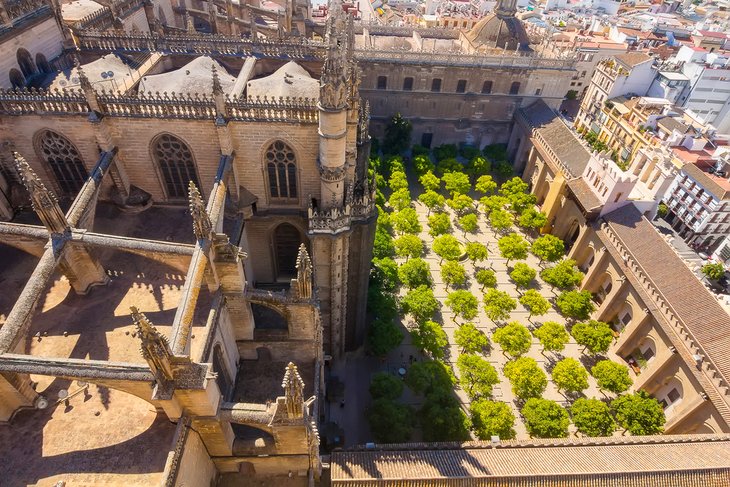
On the east side of the Patio de los Naranjos is the Biblioteca Colombina . The son of Christopher Columbus, Hernando Colón, put together the collection for this library between 1496 and 1539, and it is one of the most important collections of Renaissance-era volumes in Spain, with a special focus on the humanist writings of the Golden Age.
The best way to appreciate the Cathedral of Seville is on the Cathedral & Alcázar Skip-the-Line Tour . Not only will you save time by avoiding the queues on this three-hour small-group guided tour, you'll also learn about the history of Seville and these two UNESCO World Heritage-listed monuments.
For a break from sightseeing after visiting the cathedral, head to the Calle Sierpes, north of the Plaza Nueva. This narrow pedestrian lane is Seville's main shopping street, lined with shops, cafés, and restaurants.
One of the most popular café-restaurants in Seville, Robles Laredo , is tucked away at the end of the Calle Sierpes on the Plaza de San Francisco. This lively restaurant specializes in tapas and other Andalusian cuisine. Tourists can opt for the restaurant's outdoor terrace seating to soak up the ambience of Seville.
On the other end of Calle Sierpes, the Confitería La Campana tempts customers with its enticing Andalusian confections. This artisanal pastry shop has been selling handmade cakes, cookies, chocolates, and other sweets since 1885. The selection ranges from Tortas de Polvorón , traditional cinnamon- and anise-spiced biscuits made in Seville, and Yemas Sevillanas (another local specialty), sugar-coated custard-like mini cakes, to cream puffs; chocolates; and candied figs, oranges, and pears.
Address: Catedral de Seville, Plaza del Triunfo, Avenida de la Constitución, Sevilla
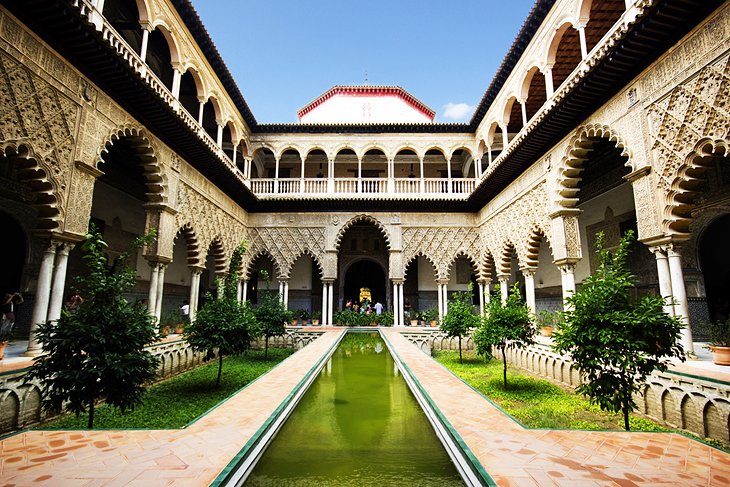
The Real Alcázar invites travelers to step into another world, an exotic place sure to inspire the imagination. Fascinating history and a breathtaking interior decor await visitors.
This UNESCO World Heritage Site was built as a fortress in the 10th century for the Caliph of Cordoba. In the 11th century, the Alcázar was the seat of the legendary Moorish ruler and poet al-Mu'tamid. Subsequent Moorish rulers expanded the site and added to the group of buildings.
After the Christian Reconquest, the palace was renovated in Mudéjar style (a blend of Gothic details and Arabic elements) for Pedro I in the 14th century. Elaborate embellishments throughout the palace, such as colorful tile floors ( azulejos ) and patterned walls and ceilings, reveal the fanciful new architectural aesthetic.
Visitors enter the Real Alcázar through the Puerta Principal , which leads to the Patio de las Doncellas (Maidens' Courtyard). This elegant courtyard was built between 1369 and 1379 and exemplifies Islamic architecture, with magnificent arches featuring open arabesque designs above 52 marble columns.
The throne room of Pedro I, the Salón de Embajadores (Hall of the Ambassadors) has a splendid domed ceiling, with decorative friezes and inscriptions in Arabic script.
Off the Patio del León (The Lion Courtyard) is the Sala de Audiencias (Chapter House), one of the most exquisitely adorned rooms in the palace, featuring a 16th-century artesonado (intricately carved wood) ceiling. The Sala de Audiencias contains a noteworthy gilded triptych on its altar titled Virgen de los Mareantes (Virgin of the Seafarers) by Alejo Fernández .
Also not to be missed are the beautifully manicured grounds, Los Jardines del Alcázar . The gardens are planted with leafy palms, fragrant orange trees, and vibrant roses. In traditional Andalusian style, patios, ornamental pools, and refreshing fountains define the landscaping. Adding to the dreamy quality, an ostentation of peacocks wanders this luxuriant outdoor space.
The Alcázar gardens and the Salón de Embajadores were used as a film set for the Game of Thrones series. Fans of the show will recognize the fountain-filled gardens as the Kingdom of Dorne's Water Gardens. Cinema buffs will also discover the Palace of the Kingdom of Naboo from Star Wars , as well as the setting for some of the scenes in Lawrence of Arabia .
The Spanish royal family still uses the upper level of the Real Alcázar as an official royal residence in Seville. The Real Alcázar has the distinction of being the oldest royal palace in Europe that is still in use.
Address: Patio de Banderas, Sevilla
Official site: https://www.alcazarsevilla.org/en/
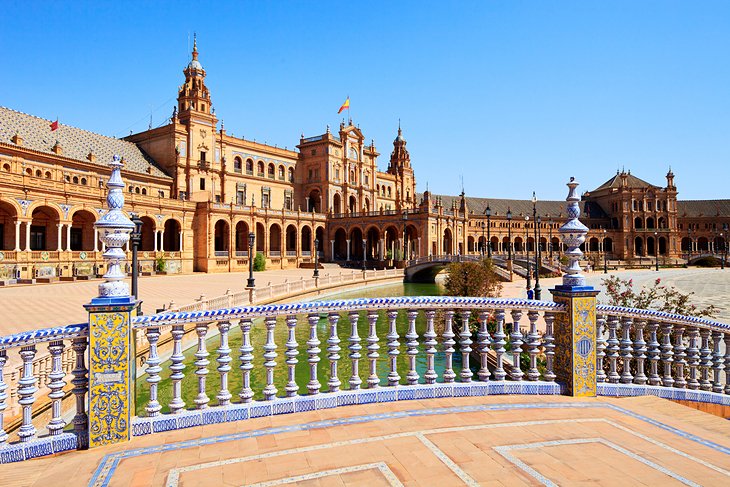
Inside the Parque de María Luisa, the Plaza de España dazzles visitors with its scale and grandeur. The enormous 50,000-square-meter plaza is surrounded by the balustraded balconies of a Neo-Moorish building, which curves around following the shape of the canal running through the square.
A monumental fountain graces the center of the square, while the peaceful canal is crossed by four footbridges. Tourists can rent a rowboat for the afternoon to experience the " Venice of Seville " or opt for an equally romantic horse-drawn carriage ride through the park.
The Plaza de España is frequently the site of open-air concerts and performances. The sight of the historical building lit up behind the stage at night is magical. Note that if a performance is scheduled, the entire area will be gated and inaccessible.
Address: Parque de María Luisa, Avenida de la Palmera, Sevilla
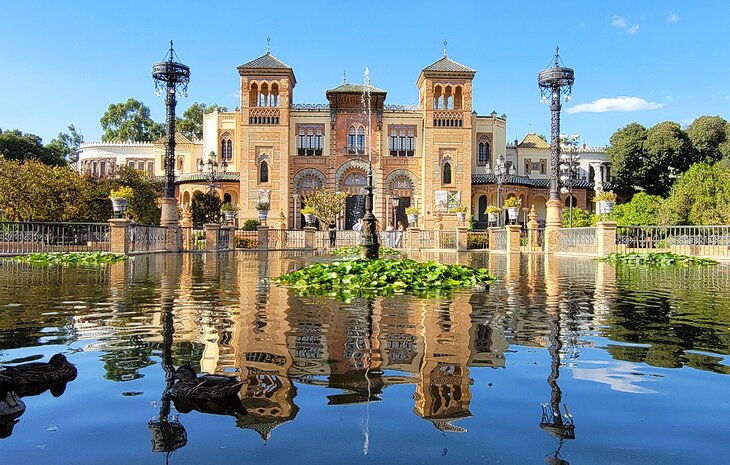
The Parque de María Luisa , with the Plaza de España at its center, was the site of the Exposición Iberoamericana in 1929. This expansive green space was created for the Infanta María Luisa Fernanda de Borbón, who donated it to the city of Seville in 1893.
The lush 34-hectare park flourishes alongside the river, with its exotic palms, orange trees, elms, and Mediterranean pines. The landscaping features bright flower beds, shady avenues, Moorish-style fountains decorated with colorful ceramic tiles, and ornamental pools. Park benches and pathways add to the inviting ambience.
The Archeological Museum and Museo Artes y Costumbres Populares are located at the far eastern end of the park across from one another. The building housing the Museo Artes y Costumbres Populares is spectacular, and a fine photo can be had by framing the duck pond and fountain in front.
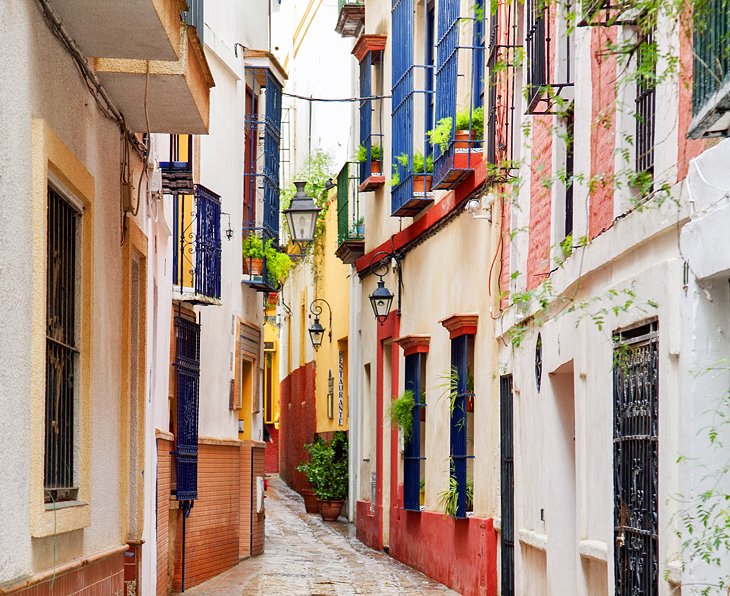
Found between the Catedral de Sevilla and the Real Alcázar, the Barrio de Santa Cruz is one of the most charming places to explore in Seville. It was the Judería (Jewish quarter) during the medieval era under Moorish rule, when many of the quarter's churches were originally synagogues.
Full of old-world atmosphere, this captivating medieval neighborhood is characterized by its labyrinth of cobblestone pedestrian lanes (too narrow for cars), whitewashed houses with attractive patios, and picturesque plazas with outdoor cafés.
Many of the quiet courtyards, such as the Plaza de Doña Elvira , are planted with fragrant orange trees. The Plaza de Santa Cruz features rose beds and a 17th-century wrought-iron cross in the center. At the Plaza de los Refinadores , visitors will find a statue of Don Juan Tenorio, a local literary character.
Two noteworthy museums are found in the Barrio de Santa Cruz: the Centro de Interpretación Judería de Sevilla (Calle Ximénez de Encisco 22A), which illustrates the history of the city's Sephardim (Spanish Jews) who lived in this quarter during the Middle Ages and until the Inquisition; and the Hospital de los Venerables (8 Plaza Venerables), a 17th-century hospital for retired priests, which now houses a collection of Spanish paintings and sculptures.
One of the special things to do in Seville is stroll through the Jardines de Murillo , beautiful gardens filled with palm trees, fountains, and tiled benches.
For an excellent view of the cathedral's La Giralda tower, head to the Patio de Banderas , a small square featuring a fountain and orange trees.
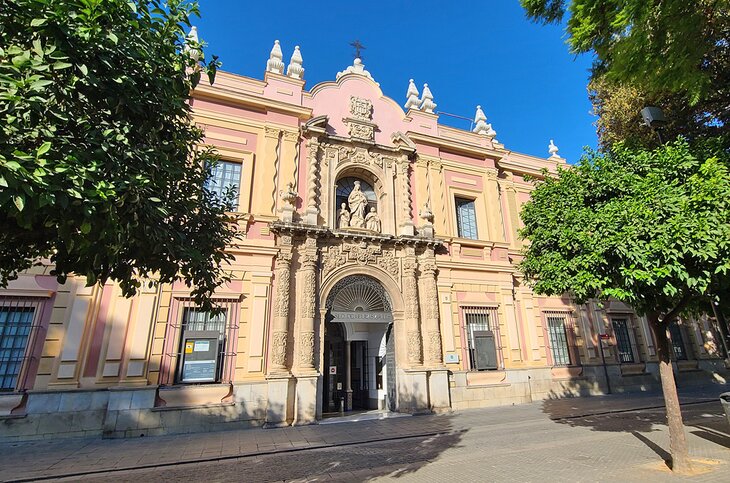
Seville has an exceptional Museum of Fine Arts, housed in the stately 17th-century Convento de la Merced Calzada . This museum is considered to have the best collection of paintings in Spain after the Prado in Madrid. The collection covers artworks from the Gothic period through the 20th century.
The representation of works by 17th-century Spanish painters is especially noteworthy. Visitors will see masterpieces by renowned Spanish artists including El Greco, Francisco Pacheco, Diego Velázquez, and Alonso Cano.
The museum has a special focus on masterpieces by Bartolomé Esteban Murillo, as well as works by the Seville school of the 17th century. The religious paintings by Francisco de Zurbarán are also excellent.
Tour the museum and then spend a bit of time on the delightful plaza located in front. Settle in with a coffee under the tall trees. The tinkling fountain and relaxed vibe tend to encourage lingering.
Address: 9 Plaza del Museo, Sevilla
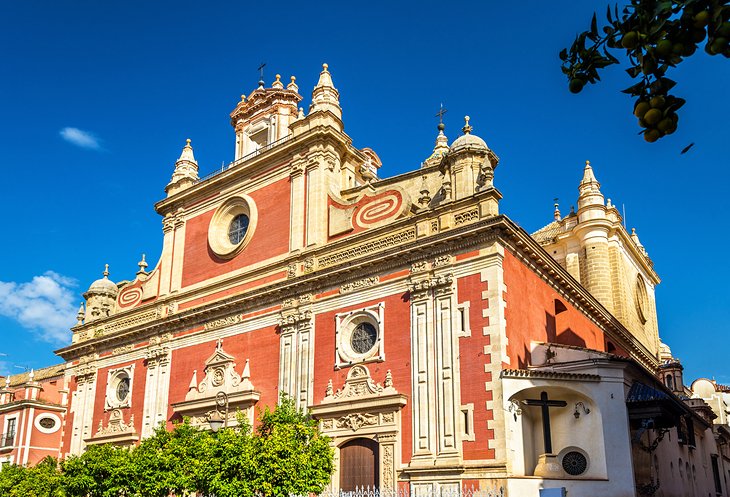
A short walk from the cathedral, the Iglesia Colegial del Divino Salvador is a stunningly beautiful Baroque church. Construction began in the late 17th century on the site where La Mezquita Aljama de Ibn Adabbás, Seville's old mosque once stood, and many additions have taken place since this time.
Glowing pink in the late afternoon light, the ornate facade is influenced by the Mannerist-style. Equally splendid and surprisingly grandiose, the extravagant gilded interior is a treasure trove of Sevillian Baroque details and lavish artwork.
Two spectacular altarpieces adorn the sanctuary: Sacred Christ of Love by Juan de Mesa and Jesus of the Passion by Juan Martínez Montañés. Other highlights are the soaring dome, the 18th-century organ, and the 16th-century Sacristy.
Like the cathedral, this lovely church also includes a courtyard with orange trees. The patio is a vestige of the original Moorish architecture.
Tip for Travelers: You can purchase a combined ticket here for Iglesia Colegial del Salvador and the Catedral de Sevilla , which allows you to skip the typically long lines at the cathedral.
Address: Plaza del Salvador, S/N, 41004 Sevilla
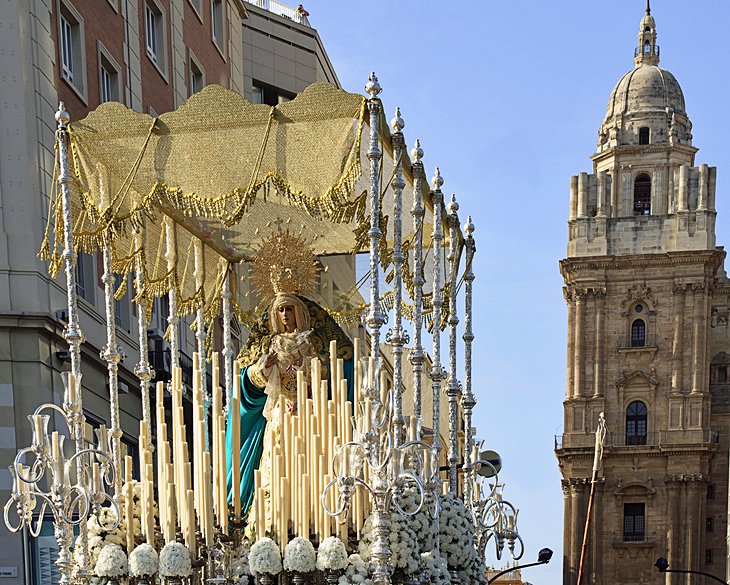
The Semana Santa celebration in Seville is one of the most exciting festivals in Spain. Following centuries-old traditions, the Catholic brotherhoods ( cofradías and hermandades ) from different quarters of town participate in elaborate processions. Clad in penitents' garb, they carry ornately decorated floats that display statues of saints.
The main procession is the eve of Good Friday and on Good Friday morning, and marvelous ceremonies are held in the cathedral during Holy Week.
During the rest of the year, visitors can still see the famous icon of the Holy Week procession at the Basílica Menor de la Santísima María de la Esperanza Macarena (1 Calle Bécquer). This church possesses the Virgen de la Esperanza , (also known as "La Macarena"), which makes a tour around town on a lavish float during Holy Week. With a tender expression and tears running down her cheeks, this Virgin figure evokes an emotional response.
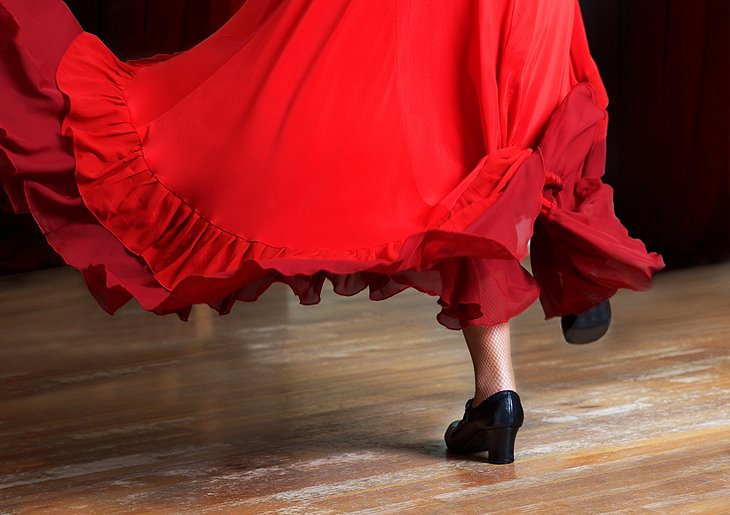
Seville is famous for its flamenco, a flamboyant art form with roots in the Gypsy culture. Flamenco includes both dancing and singing, but most importantly, it is an expression of the soul. The best flamenco dancers have technical prowess, as well as a special gift of channeling the emotions.
The Museo del Baile Flamenco celebrates the beauty of flamenco with exhibits on all aspects of the art: dancing, singing, and guitar. This innovative museum features flamenco costumes, creative video displays, and other educational exhibits.
The museum also has a Flamenco School and hosts professional Flamenco Performances daily year-round. The performances begin at 7pm and last for one hour.
Other places to see flamenco shows include El Palacio Andaluz (4 Calle Matemáticos Rey Pastor y Castro), a traditional tablao -style (small venue) theater near the Basílica de la Esperanza Macarena; the Tablao Flamenco Los Gallos (11 Plaza de Santa Cruz, in the Barrio de Santa Cruz), one of the oldest tablaos in Seville; and La Casa del Flamenco (28 Calle Ximénez de Enciso, also in the Barrio de Santa Cruz), where flamenco shows are presented in the courtyard of a 15th-century palace.
Flamenco shows are also held almost every night at La Carbonería on Calle Céspedes. It's a popular nightlife spot, so arrive early to score a seat.
Address: Museo del Baile Flamenco, 3 Calle de Manuel Rojas Marcos, Sevilla
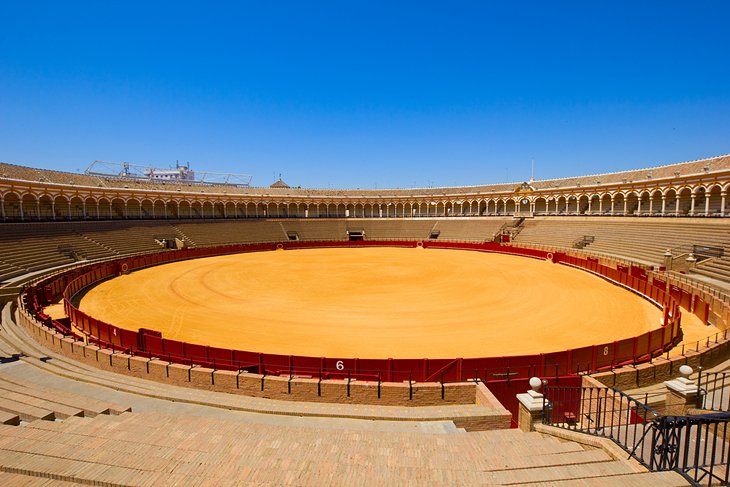
The Real Maestranza de Caballería de Sevilla (Royal Bullring of Seville) is one of the finest bullrings in Spain, and with seating for around 12,500 spectators, it is also one of the largest.
Built in 1761, the Royal Bullring is an emblematic landmark of Seville. The design is distinctly Baroque, with an oval-shaped ring that makes it unique among Spanish bullrings, and its graceful arcaded seating provides welcome shade on sunny days. A special box within the bullring, the Palco del Príncipe , is reserved for members of the Spanish royal family.
The Royal Bullring contains a museum with a collection of traditional matador costumes, as well as photographs and paintings related to the dramatic art of bullfighting. Highlights are the prints by Francisco de Goya and a painting titled Cogida de Muerte de Pepe Hillo by Eugenio Lucas Velázquez. A visit to the museum provides a glimpse into the fascinating heritage of bullfighting.
The tradition of bullfighting in Seville has its roots in a custom of medieval chivalry: The nobility trained in horsemanship and using weapons to be prepared for warfare. In 1670 during the reign of Carlos II, the Real Cuerpo de Maestranza de Caballería de Sevilla (Royal Corps of Cavalry) was founded to serve the Crown.
Visitors continue their tour by walking from the museum to the Patio de Caballos (Courtyard of the Horses), which leads to the Capilla de los Toreros (Bullfighters' Chapel). Matadors pray at this chapel before a fight and leave votive offerings at the Virgen del Rosario altarpiece.
Address: 12 Paseo de Colón, Sevilla
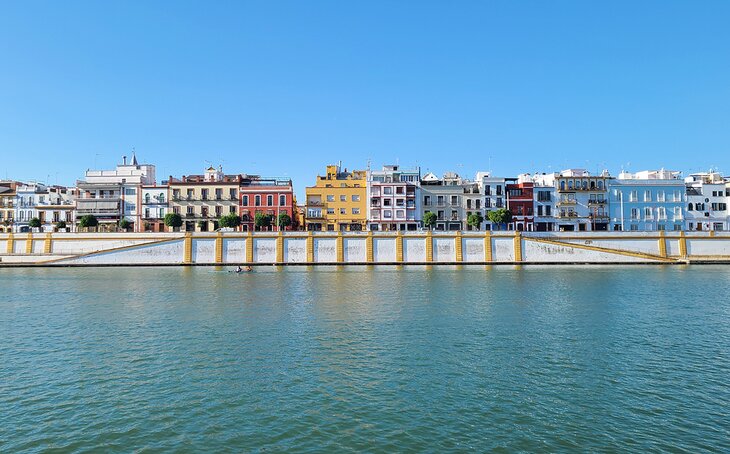
This historic quarter of Seville has its own distinct character and identity. Across the river from the main tourist attractions of Seville, the neighborhood has the ambience of being a world apart.
Similar to the Barrio de Santa Cruz, the Barrio de Triana is a maze of narrow cobblestone streets and alleyways leading to atmospheric squares.
What distinguishes the Barrio de Triana is its heritage as a traditional potters' quarter, as well as its Gypsy community. For centuries, the people of this neighborhood have used the clay from the banks of the Guadalquivir River to create authentic Andalusian ceramics.
The ceramic workshops and boutiques of the Barrio de Triana, mostly located on the Calle Callao , the Calle Antillano Campos, and the Calle Alfarería , are especially renowned for their fine azulejos , glazed ceramic tiles adorned with colorful geometric patterns–a legacy of Andalusia's Moorish aesthetic.
The boutiques of this quarter also sell beautiful decorative ceramic plates, cups, pitchers, serving pieces, and other objects for the home. After browsing the little shops, tourists will be ready for a meal at one of the neighborhood's riverfront restaurants; many have outdoor terraces overlooking the monuments of Seville.
An interesting trivia fact about the Barrio de Triana: From this quarter near the San Telmo Bridge , Magellan set out for his voyage around the world.
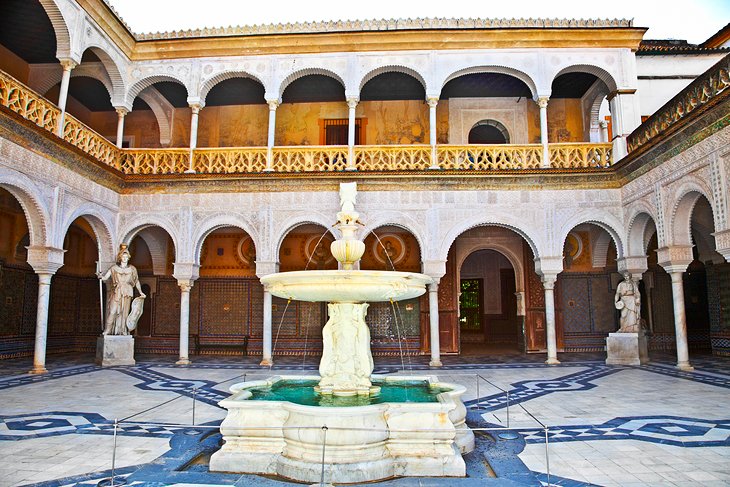
The Casa de Pilatos (Palace of the Governors of Andalusia) is a designated National Monument . This exquisite palace was once the private residence of the aristocratic Enríquez de Ribera family, including the Dukes of Alcalá.
Built in the 15th and 16th centuries, the Casa de Pilatos is believed to be a replica of Pilate's house in Jerusalem. The house features a variation of Mudéjar style, with Renaissance-era Plateresque details, as well as Baroque elements. Typical of Andalusian architecture, the building has a central patio adorned with azulejos (colorful ceramic tiles) and antique sculptures.
The Salón Dorado (Golden Room) is a beautiful room with faience decorations and an artesonado (coffered wood) ceiling. The main staircase and the private chapel are also noteworthy. A collection of ancient Roman sculptures is displayed throughout the house.
Tourists may take a self-guided tour of the Casa de Pilatos. The price of admission includes an audioguide.
Address: 1 Plaza de Pilatos, Seville
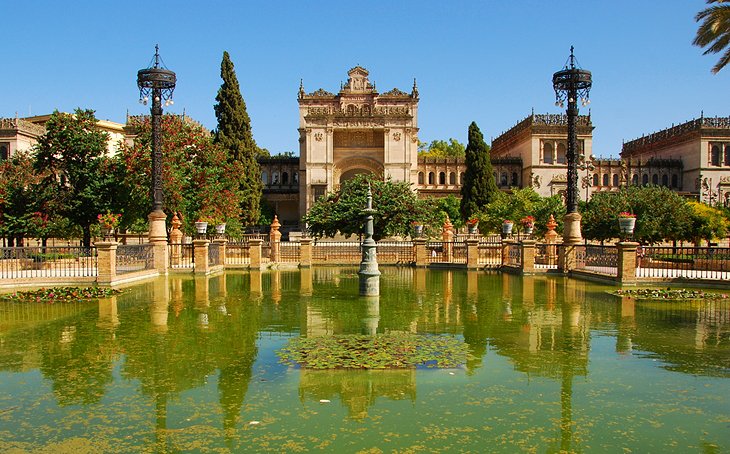
Located within the Parque de María Luisa, the Archaeological Museum of Seville occupies a Neo-Renaissance pavilion built for the Ibero-American Exposition of 1929.
The collection begins with the early Paleolithic period; continues with Phoenician, Greek, and Roman antiquities; and finishes with Moorish and Mudéjar items from the Middle Ages.
The ground floor displays artifacts discovered at the Itálica archaeological site (nine kilometers away) in the province of Seville. Among the highlights are the gold jewelry and a statue of Diana.
Another remarkable piece is the Carambolo Treasure from the Tartessian period, which is displayed in its own room on the first floor. This room contains a reproduction of the gold treasure and a shrine dedicated to Phoenician divinities.
Address: Plaza de América, Parque de María Luisa, Sevilla
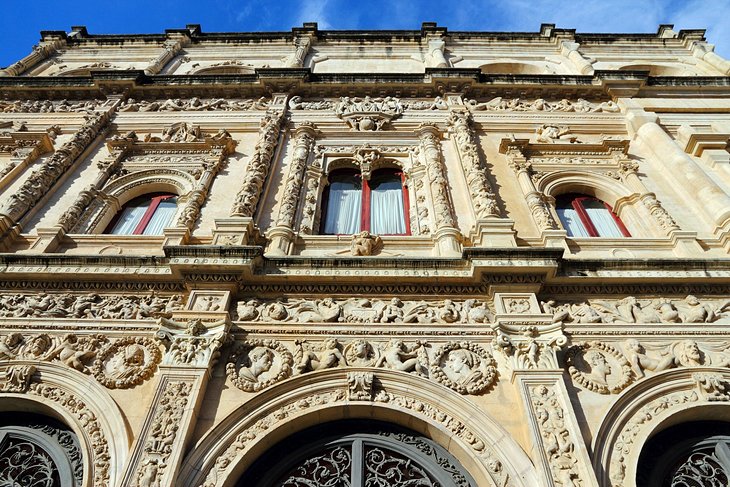
This impressive 15th-century town hall was designed in the Plateresque style by Diego de Riaño. The intricately carved reliefs on the southern facade depict figures from historical stories and mythology, as well as emblems of the storied founders of the city, Hercules and Caesar.
The building was renovated in the 19th century with a Neoclassical main facade that looks out onto the Plaza Nueva. A small archway connects the town hall building to the adjacent Franciscan monastery.
Tourists may make an appointment (advanced reservations are required) to visit the interior, which contains several important artistic works including a painting of the town's patron saints, Justa and Rufina.
Address: 1 Plaza Nueva, Seville
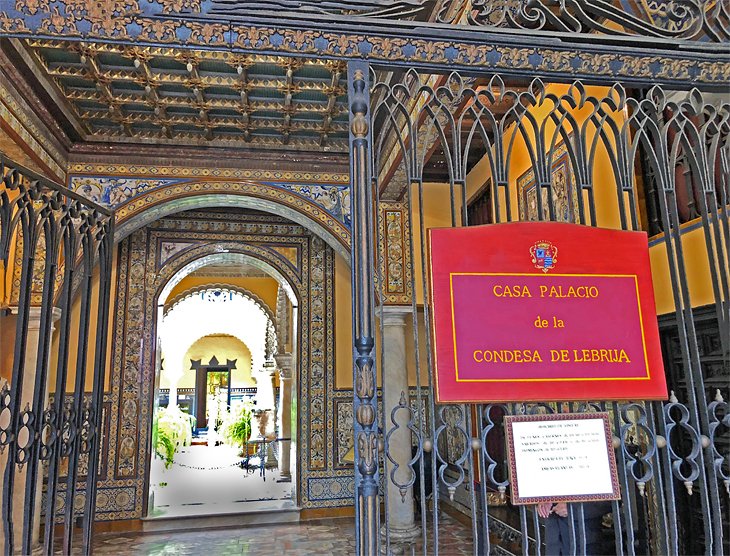
The Palacio Lebrija is a lovely aristocratic Sevillian mansion of the 16th century. The palace was designed to impress, with its splendid mosaic floors, grand staircase leading up to the second floor and gorgeous artesonado ceilings. The walls are decorated with Arabic-style plateresque ornamentation, and the courtyard is filled with Andalusian plants.
The palace displays a collection of archaeological treasures, including Ancient Greek mosaics, glasses, vases, and sculptures. Other highlights include paintings by Joaquín Sorolla, the famous 19th-century Spanish painter (the "Master of Light") known for his vibrant sun-dappled scenes.
The Palacio Lebrija is open to the public for visits every day. Admission is free on Friday mornings.
Address: 8 Calle Cuna, Seville
Official site: https://palaciodelebrija.com/en/
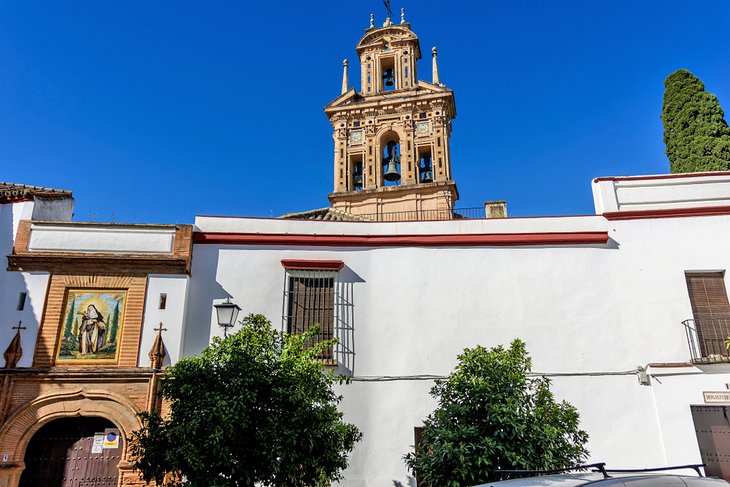
The Monasterio de Santa Paula was founded by Doña Ana de Santillán in 1473 for the Jerónimas nuns. For five centuries, this monastery has been devoted to divine worship and the study of Scripture.
Within the cloisters of the building, the monastery possesses an important art collection. Tourists can visit the monastery to discover its artistic heritage. Sometimes the nuns can also be found selling their handmade cakes and confections here.
Address: 11 Calle Santa Paula, Seville
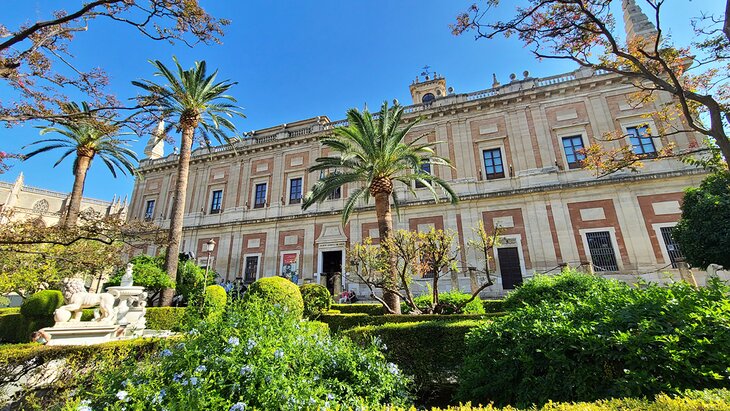
Across from the Alcázar is the 16th-century Casa Lonja de Mercaderes (merchants' exchange building), which houses the UNESCO-listed Archivo General de Indias, an archive of documents from Spain's colonial years in the New World.
The General Archive of the Indies was created by the Spanish government during the reign of Carlos III, for the purpose of the administration of overseas territories. Besides providing safekeeping for historic documents, the General Archive displays a small selection of documents and presents exhibits focused on Spain's Age of Exploration.
Address: 3 Avenida de la Constitución, Sevilla
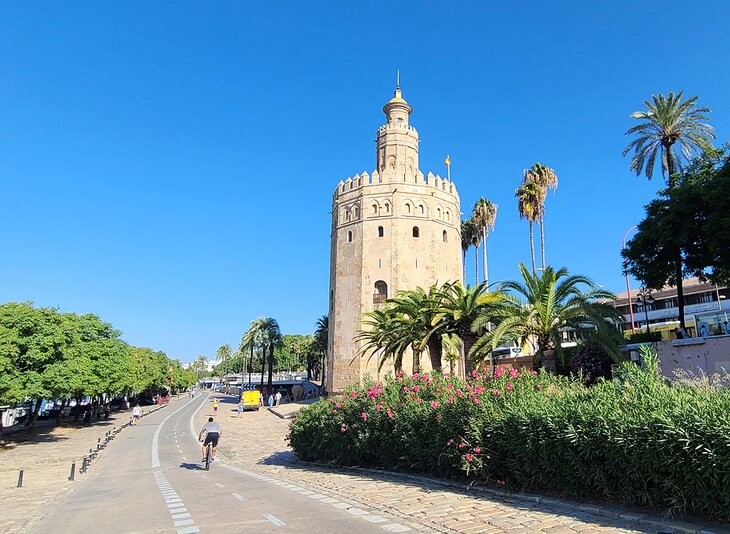
Built in 1220, this iconic tower was originally part of the city's defensive walls. The 36-meter-tall monument stands on the left bank of the Guadalquivir River and was designed as a watchtower to protect against invasions.
Golden-hued tiles once covered the tower, which explains its name: "Tower of Gold."
Today, the Torre del Oro houses the Museo Marítimo de Sevilla (Naval Museum), which contains a collection of old ship models, historic navigation charts, and other exhibits related to Spain's maritime heritage. The museum also features a terrace that affords panoramic vistas.
Address: Paseo de Cristóbal Colón, Sevilla
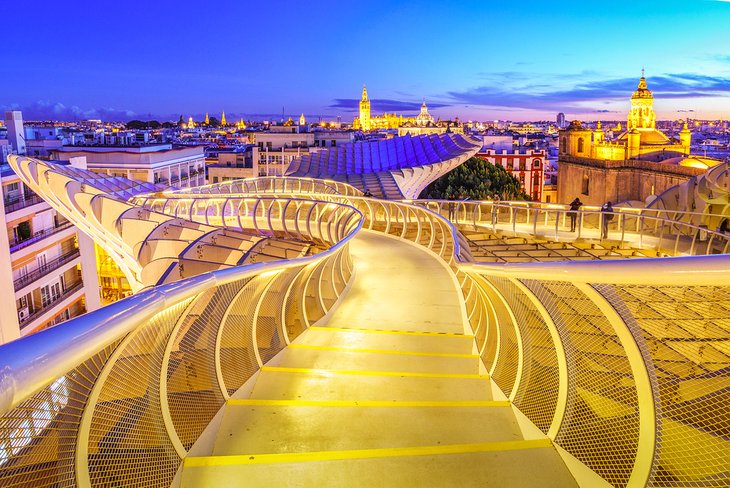
For amazing views of the Seville cityscape, head to the Metropol Parasol walkway and viewpoint. This unique structure created by the German architect Jürgen Mayer and inaugurated in 2011 is known as " Las Setas " ("The Mushrooms") because the shape resembles six large mushrooms.
The walkway and viewpoint are found on the top of the structure at 26 meters above the ground, which provides a wonderful perspective of the city's rooftops and landmarks.
At a lower level than the walkway, there is a tapas restaurant .
The basement of the structure contains the Antiquarium , an archaeological site. Visitors have a chance to see ruins from the ancient Roman, Visigoth, and Moorish eras.
Address: Plaza de la Encarnación, Sevilla
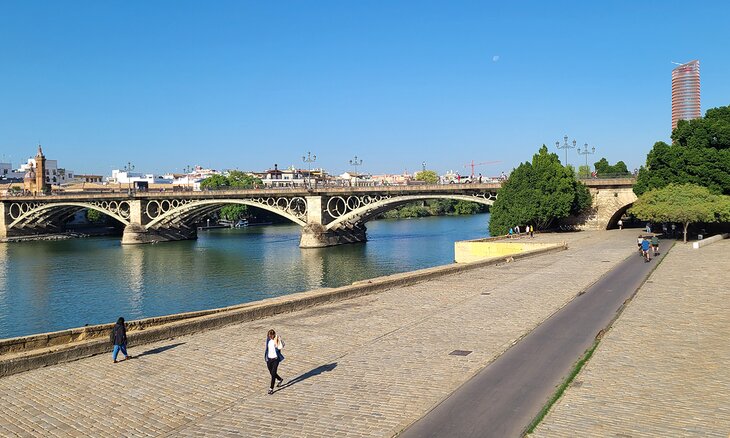
If you've had enough sightseeing and every church and old building is starting to look the same, an escape from the historical center is nearby. Seville's riverfront area is a special place with open spaces to walk, run, ride a bike, or even go stand up paddleboarding or rowing.
The main area runs right along the banks of the Guadalquivir River from the Punte de San Telmo past the Torre del Oro to the Puente del Cachorro. The entire area is set below the main roadway so it's quiet and peaceful with public artwork along the way.
Across the river are wonderful views of the colorful Barrio de Triana. After your riverfront stroll, cross one of the bridges and find a perfect patio all the while getting lost in the maze of alleyways.
The best place to stay is in the historic center of Seville, close to the cathedral and the Alcázar. Just adjacent to these landmarks is the medieval Judería, a maze of charming streets known as the Barrio de Santa Cruz. A number of the old houses in this area are now small hotels, while larger hotels are plentiful in the nearby streets of the Alameda district. Here are some highly rated hotels in Seville that are close to the top-rated attractions:
Luxury Hotels :
- Exuding the old-world grace and elegance of a grand hotel, the five-star Hotel Alfonso XIII is Seville's most luxurious hotel. The hotel is ideally located near the Real Alcázar and the Cathedral of Seville. Guest rooms are outfitted with sumptuous Andalusian, Moorish, or Castilian decor.
- The Hotel Colón Gran Meliá , selected as one of The Leading Hotels of the World, is in the center of Seville near the Museo de Bellas Artes and a 10-minute walk from the cathedral. The area is known for its great shopping and gourmet restaurants. This five-star hotel offers stylish rooms and exceptional service. Amenities include a spa, traditional Andalusian restaurant, and a rooftop terrace with a swimming pool.
- Near the Casa de Pilatos and a 10-minute walk to the cathedral, the Hotel Palacio de Villapanés occupies an elegant 18th-century Andalusian palace with interior courtyards. The guest rooms are decorated in a warm contemporary style. One of the Small Luxury Hotels of the World, this five-star property features concierge service, a wellness center, fine-dining restaurant, and a rooftop terrace with a plunge pool.
Mid-Range Hotels:
- In the heart of atmospheric Barrio de Santa Cruz, close to the cathedral and Alcázar, the four-star El Ray Moro Boutique Hotel is found in a renovated 16th-century manor house. This charming family-run hotel has rooms that surround a lovely courtyard with a fountain. Amenities include a hot tub, rooftop terrace, breakfast buffet, and restaurant that serves traditional Andalusian cuisine.
- The Hotel Bécquer is in the historic center of Seville near the Barrio de Santa Cruz and a 10-minute walk to the cathedral. This four-star hotel has large rooms, some with balconies, and views of the cathedral from its rooftop terrace and pool.
- Just steps away from the river, the NH Sevilla Plaza de Armas is about a 15-minute walk from the cathedral. This modern four-star hotel offers excellent amenities, including a gastronomic restaurant, spacious lounge areas, a sun room, and an outdoor swimming pool.
Budget Hotels:
- The Hotel Monte Carmelo is on a pedestrian street in the Barrio de Triana, a picturesque neighborhood with lots of restaurants, just across the river from María Luisa Park and the historic center. This affordable hotel offers four-star amenities, such as parking, a 24-hour front desk, breakfast buffet, and concierge services.
- Housed in a characteristic Andalusian building, the Hotel Goya is in the heart of the Barrio de Santa Cruz, steps from the cathedral and Alcázar. This family-run hotel offers a 24-hour front reception desk and simple yet stylish guest rooms.
- In the central shopping area close to all the historic sites, the Hotel America Seville has spacious contemporary-style guest rooms. Amenities at this three-star hotel include concierge services, a 24-hour front desk, breakfast buffet, and coffee shop.
Seville Sightseeing Bus Tour:
- If you plan to see most of the top attractions in Seville, the City Sightseeing Seville Hop-On Hop-Off Tour is a great-value and flexible option. You can hop on and off this open-top double-decker bus at any of 12 stops, including the Plaza de España and the Seville Aquarium. The tour also includes free entry to select museums and three complimentary walking tours. A highlight is the stroll around the Seville Cathedral.
Córdoba Day Trip:
- To add some other evocative Spanish cities to your itinerary, consider the Cordoba Day Trip from Seville including Skip-the-Line Ticket to Cordoba Mosque and Optional Tour of Carmona . This full-day tour explores the magnificent Moorish architecture and cultural attractions of this atmospheric Andalusian town, including the UNESCO-listed La Mezquita, the old Jewish quarter, and the Alcázar fortress.
Granada Day Trip:
- The Granada Day Trip from Seville allows you to soak up the natural beauty and fascinating history of this Andalusian city at the foot of the Sierra Nevada Mountains. Highlights of this full-day tour include the UNESCO World Heritage-listed Alhambra Palace and an optional walking tour of the Albaicín quarter (the old Moorish town).
More Related Articles on PlanetWare.com
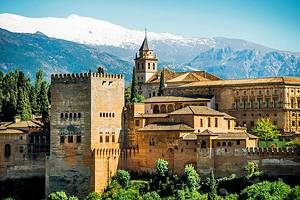
Exploring Andalusia : Once you've explored the top places to visit in Seville, you'll find plenty of other worthwhile destinations in Andalusia . It's only about a 90-minute drive to Córdoba , where you can see the magnificent UNESCO-listed La Mezquita (the Great Mosque) and wander the tangle of lanes in the enchanting Judería (old Jewish quarter), with its white-washed houses and flower-filled patios. Drive about three hours east from Seville to explore the highlights of Granada , including the majestic Alhambra , a UNESCO-listed complex of ornate palaces, a Moorish fortress, and luxuriant gardens.
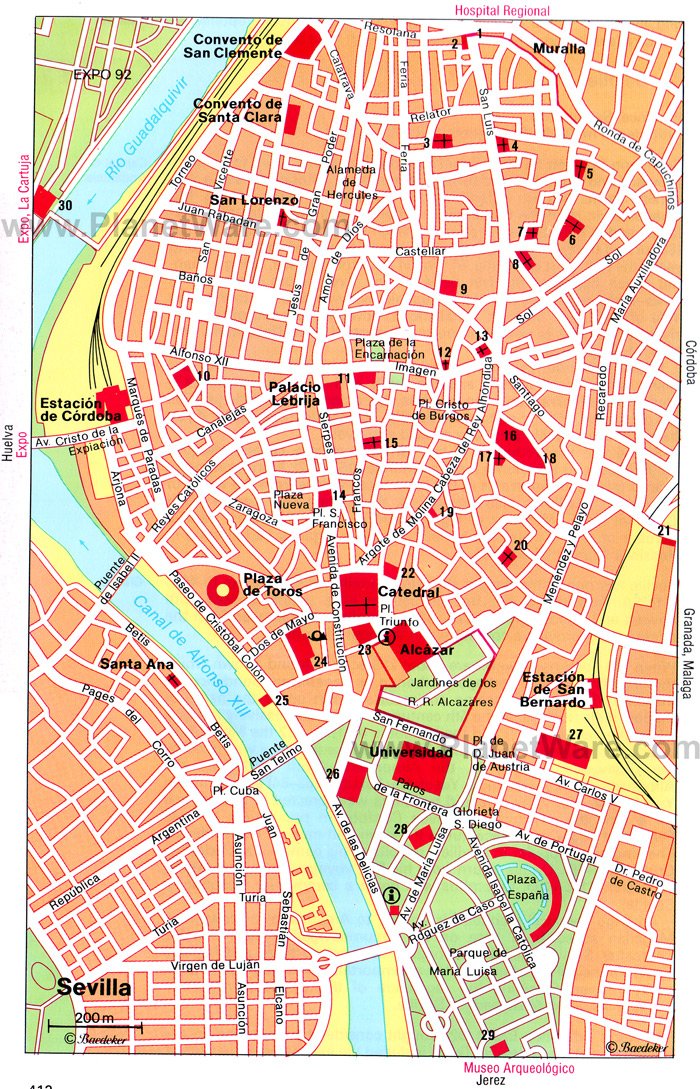
- (1) Puerto Macarena
- (2) San Gil
- (3) Omnium Sanctorum
- (4) Santa Marina
- (5) San Julián
- (6) Convento de Santa Paula
- (7) Santa Isabel
- (8) San Marcos
- (9) Casa de la Dueñas
- (10) Museo de Bellas Artes
- (11) Pabellón Sevillanos Illustres
- (12) San Pedro
- (13) Santa Catalina
- (14) Ayuntamiento
- (15) San Salvador
- (16) Convento de San Leandro
- (17) San lldefonso
- (18) Casa de Pilatos
- (19) Monolitos Romanos,
- (20) Santa Maria la Blanca
- (21) Acueducto
- (22) Palacio Arzobispal
- (23) Casa Lonja (Archivo de Indias)
- (24) Hospital de la Caridad
- (25) Torre del Oro
- (26) Palacio San Telmo
- (27) Estación de Autobuses
- (28) Teatro Lope de Vega
- (29) Museo de Artes y Costumbres Populares nos Illustres
- Alameda de Hércules and Vicinity
- Barrio de Santa Cruz
- Basílica Macarena
- Former Site of EXPO '92
- Museum of Contemporary Art
- Palacio Lebrija
- Plaza de España
- Plaza Nueva
- Plaza San Francisco
- San Lorenzo
- Street of the Snakes

More on Spain

Things to do in Seville: Attractions
Top 25 sevilla sightseeing, tourist attractions & what to do in seville spain.

Top 25 most beautiful Seville tourist attractions, highlights and places of interest. An overview of all the sights, must see landmarks, tourism, things to do and tourist attractions during your visit to Seville. What to do in Sevilla Spain?
- Top 25 Attractions
- Day trips from Seville
- Royal Alcazar
- More Seville sights
Top 25 Seville Tourist Attractions & Landmarks
What are the best things to do in Seville Spain? When on a trip to Seville, you will see a diverse range of highlights , sights and tourist attractions . Such highlights and landmarks include the sightseeing of the historic city centre with Moorish influences, the royal palace Real Alcazar and the large cathedral with the Giralda tower. In addition to these must see landmarks , the famous Plaza de España, the green parks and the delicious tapas make Seville in Andalusia one of the most beautiful cities in Spain. Here are the 25 most visited Seville tourist attractions . What to do in Sevilla?:
More Seville landmarks and monuments
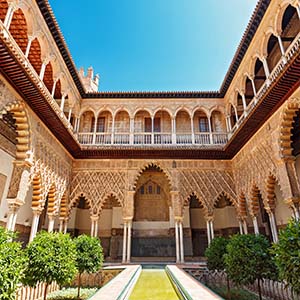
Real Alcazar
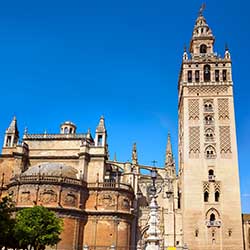
Cathedral & Giralda
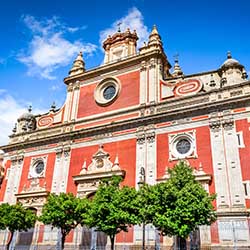
Iglesia del Salvador
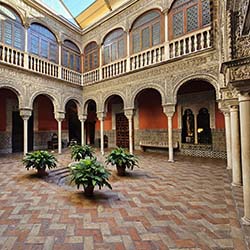
Casa de Salinas
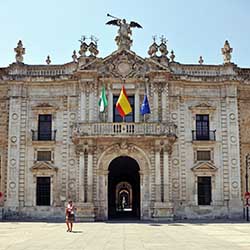
Tobacco Factory
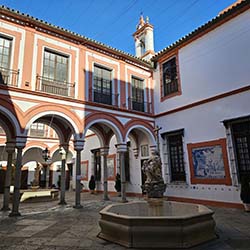
Hospital de la Caridad
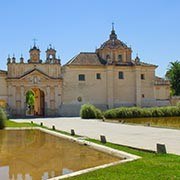
Monastery La Cartuja

Palacio de San Telmo
Visit museums in Seville Spain
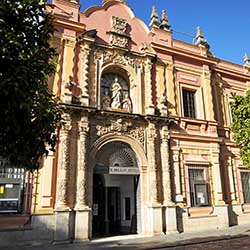
Museo de Bellas Artes
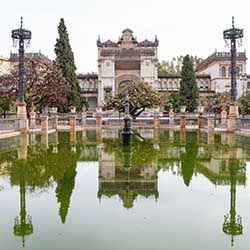
Archaeological Museum
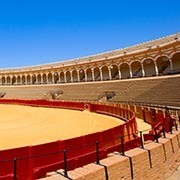
Museum of Bullfighting
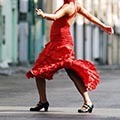
Flamenco Museum
Other Seville sights and tourism
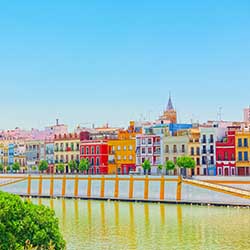
Triana District
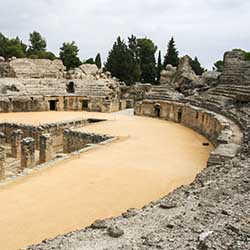
Semana Santa
Select one of the 25 best Seville attractions . Which of these sights and places of interest you want to know more about? Start your trip to the beautiful city of Séville on SevilleCityGuide.com. Read more about Seville sightseeing and best things to do in Seville Spain.
Video: Seville sightseeing
Where are the places to visit in seville.
FAQ Sevilla tourism and places to visit
Three important must see monuments and landmarks stand out from the sights in Seville Spain: definitely visit the Real Alcazar, or the beautiful Moorish palace of Seville. Furthermore, you do not want to miss the cathedral with the Giralda tower and also the famous square Plaza de España. Read more about the most popular Things to do in Seville Spain .
During high season the Royal Palace Real Alcazar often has huge queues because the palace has a visitor limit. We really recommend that you buy your tickets in advance to avoid disappointment. Read more about visits and tickets to the Alcazar de Sevilla .
A number of fun things to see in Seville are: visiting a flamenco show, taking a cruise on the Guadalquivir, taking a bike ride through the different neighborhoods or taking a day trip to the Roman excavations of Itálica. Read more ideas for Seville activities .
Sevilla has a Mediterranean climate with very hot summers. Temperatures in Andalusia regularly rise above 40 degrees Celsius and winters are usually very mild. The months of May, June, September and October are the ideal months to visit Seville.
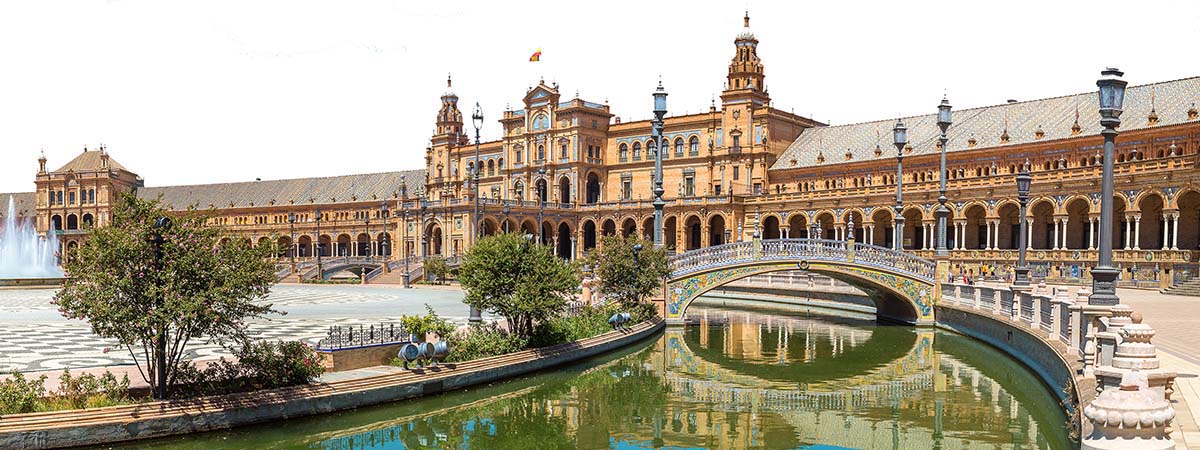
Partnerlinks: What to do in Granada , Tourist attractions Barcelona , Florence sightseeing and Rome tourist attractions
Popular places to visit

Top 25 Things to do in Seville

Alcazar de Sevilla & Tickets

Seville Cathedral
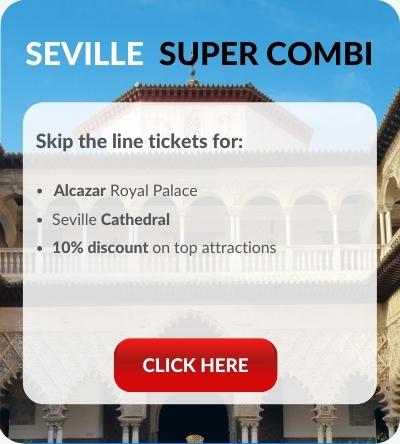

Touropia Travel Experts
Discover the World
23 Top Attractions & Things to Do in Seville
Like every great city in Europe, Seville has its share of must-see attractions, but the capital of Spain’s Andalusia region also boasts that quixotic quality that travelers yearn for the most: atmosphere.
Much of Seville’s charm comes in its narrow streets, lined with colorful buildings, orange trees, bustling tapas bars, and lively flamenco venues. Combined with its fantastic year-round weather, this creates a vibrant and inviting atmosphere that is easy to get swept up in.
See also: Where to Stay in Seville
While the city’s lively mix of Gothic, Mudéjar, Renaissance and Modern architecture is dazzling, it’s the lust for life of the Sevillian people that makes a trip to Seville so unique and memorable.
There’s an irresistible vitality that bathes Spain’s fourth-largest city with a warm and sunny glow. Whether swaying to the rhythmic tapping of a flamenco dancer’s nail-capped shoes or dancing the night away at a modern open-air discotheque, it’s easy to find new and exciting things to do in Seville.
Additionally, its delectable cuisine will delight you with flavors and textures that will elevate your taste buds to new levels. With their legendary hospitality, it’s only a matter of time until the warm, proud and passionate locals embrace you as new family friends in this engaging city.
Map of Seville
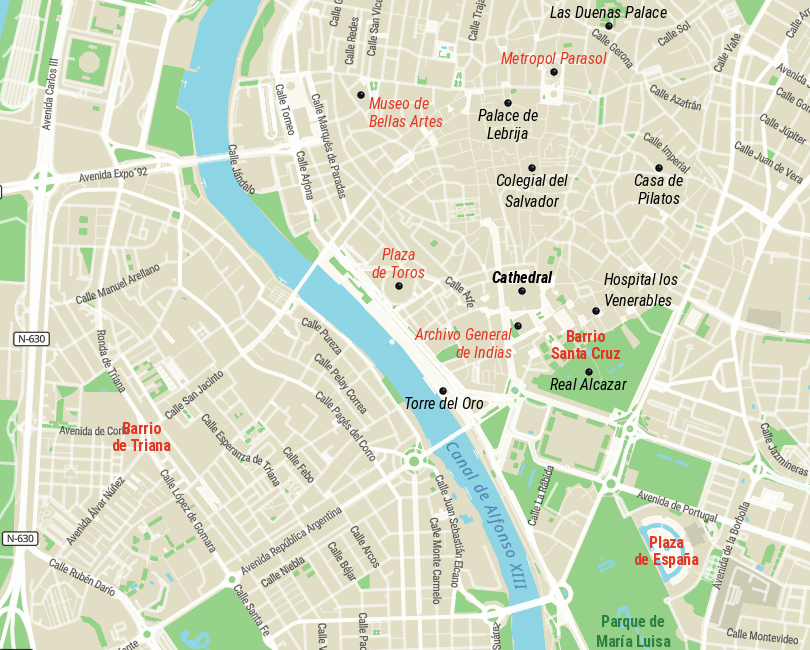
23. Hospital de los Venerables
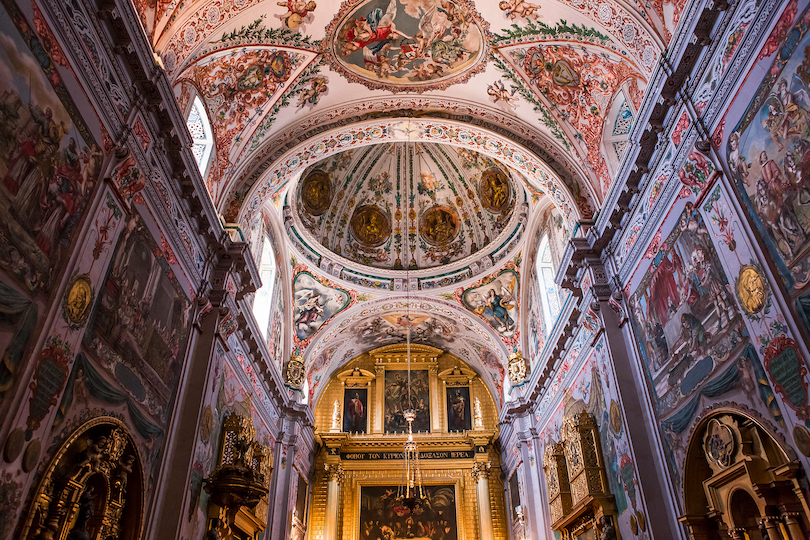
The Hospital de los Venerables is a historic landmark that showcases the city’s rich cultural heritage.
Originally serving as a retirement home for priests, the Baroque-style building dates back to the 17th century. However, today, it is better known for housing the Velázquez Center, a museum dedicated to the works of renowned Spanish painter Diego Velázquez.
It is worth visiting if you enjoy art, as it presents an impressive collection of paintings by Velázquez and other influential artists from the Sevillian school.
Granted, it is not a huge collection per se, but each piece is a bona fide masterpiece. They include an exceptional portrait of Santa Catalina produced by Bartolomé Murillo and the incredible Inmaculada Concepción by Velázquez himself.
22. Palace of the Countess Of Lebrija
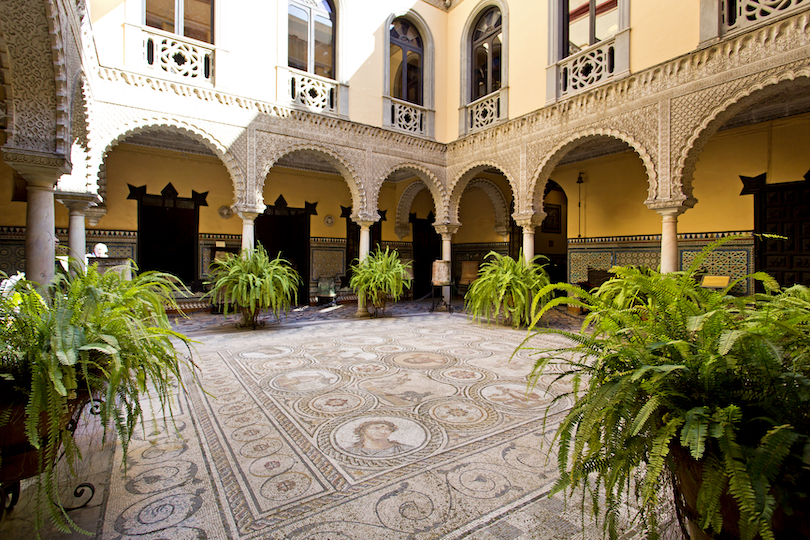
The Palace of the Countess of Lebrija is one of our favorite cultural attractions in Seville. Privately owned, the 16th-century palace immediately impressed us with its Arabic-inspired arches, intricately carved ceilings and quaint courtyard.
The palace showcases a fascinating collection of Roman mosaics, sculptures, exquisite ceramics, and antique furniture that was personally curated by the Countess. However, what we enjoyed most was its paved floors, which some judges consider to be the best in Europe.
The exhibits are set across several rooms, and you can explore the ground floor at your leisure. While an entrance fee is required, it entitles you to a guided tour upstairs of the living quarters with an English- or Spanish-speaking guide. (Unfortunately, no photos are allowed in this section of the tour).
21. Archivo General de Indias
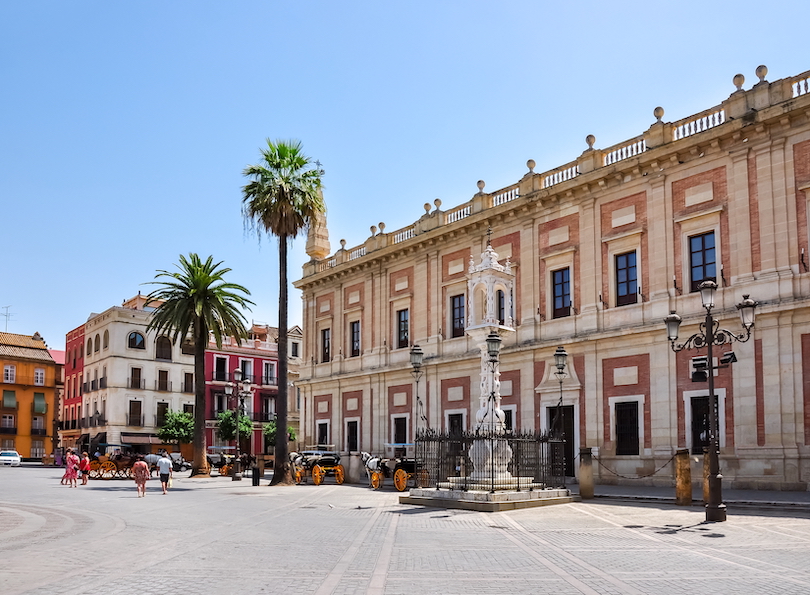
If you are into history, particularly Spanish history, The Archivo General de Indias is somewhere you’ll want to visit.
Located on the Plaza del Triunfo’s western side, within what was once a merchant’s exchange, the archival building incredibly holds more than 10 km of bookshelves!
Much of its extensive collection of documents relates to the Spanish colonies in the Americas and the Philippines. Once there, visitors can delve into the fascinating historical records, including maps, manuscripts, and official correspondence, which offer insights into the era of exploration, conquest, and colonization.
A place for historians and those with curious minds, The Archivo General de Indias serves as a testament to Spain’s significant role in shaping the New World.
20. Las Duenas Palace
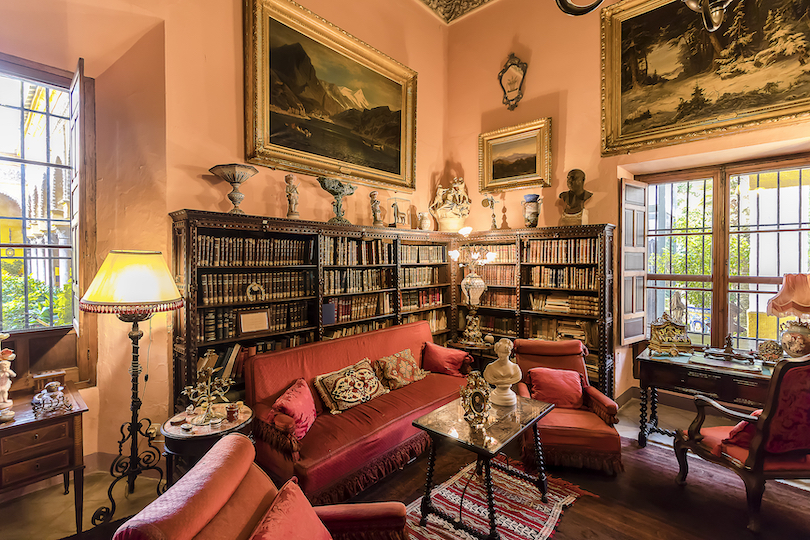
Seville is blessed with many examples of gorgeous architecture, and one of the best of them is the Las Dueñas Palace.
Constructed in the 15th century, the palace is a private residence owned by the House of Alba. It showcases a captivating blend of architectural styles spanning from Gothic to Mudéjar and Renaissance.
A guided tour of the Palace provides a fascinating insight into the city’s aristocratic history. The tour lasts an hour, during which time you will be enchanted by the beautifully manicured gardens, elegant courtyards, stunning chapel and opulent interiors.
The historic Palace is also full of antique furniture, decorative artwork and exquisite paintings, including an incredible piece by Neri di Bicci over 700 years old.
19. See a Flamenco Show
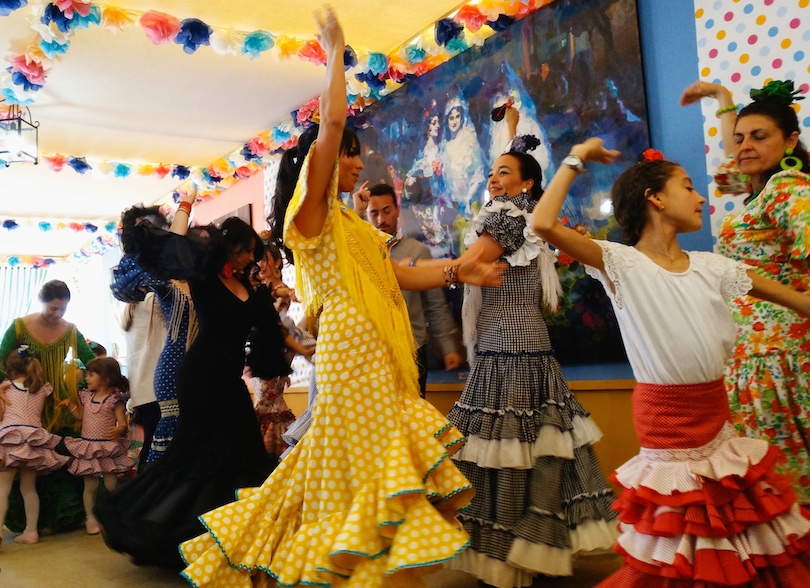
Experiencing a flamenco show in Seville is a captivating and unforgettable cultural immersion.
Seville is the birthplace of flamenco dancing in Spain. So what better thing to do than see a show whilst you are there?
The perfect way to immerse yourself in the local culture, flamenco shows are a sensual and passionate art form that comes alive with music.
Flamenco shows take place all year round and one of the best places to see them is at Tablao El Arenal. They offer a couple of performances every night, each for an hour and a half, including tapas or a full meal.
Alternatively, check out Casa de la Memoria, another famous city destination. If what you see there inspires you to learn some moves, you can also take lessons from them.
18. Isla Magica
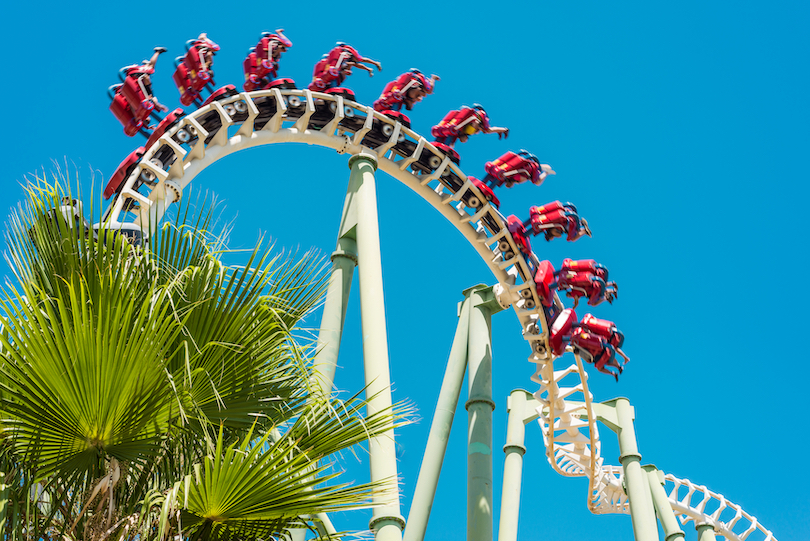
If you visit Seville with kids or are a big kid yourself, you’ll love Isla Magica.
Based on the discoveries Spanish explorers made in the 16th and 17th centuries, this theme park provides a fun and fantastic way to learn about the history of Spain.
Some Spanish settlements it has recreated are Amazonia, Cartagena, Puerto de Indias and the famous lost city of El Dourado.
The park is notable for a large lake which facilitates lots of water activities – perfect for when the Andalusian sun gets too hot. Additionally, it has roller coasters, several other rides, and cinematic and live shows.
The Isla Magica is within easy walking distance of Seville’s historic city center. It also has plenty of cafes and eateries to grab a bite to eat at.
17. Day Trip to Cordoba

If you have time to squeeze a day trip into your itinerary, make it to Cordoba.
Easily reached by a 45-minute train ride from Seville, Cordoba is known for its magnificent Mezquita-Catedral. A stunning UNESCO World Heritage Site that seamlessly blends Islamic and Christian architectural styles.
It also has a beautiful Jewish Quarter, with charming, narrow streets that house quaint courtyards, historic synagogues, and interesting shops.
The Alcázar de los Reyes Cristianos, with its beautiful gardens and Moorish baths, will give you a glimpse of the city’s past. While the stunning Roman Bridge, which spans the Guadalquivir River, provides spectacular cityscape views.
Finally, no trip to Cordoba would be complete without trying its delicious tapas and traditional Andalusian dishes. So indulge in Carrillada de cerdo (pork cheek) and Serranito (grilled meat sandwich).
16. Semana Santa Festival
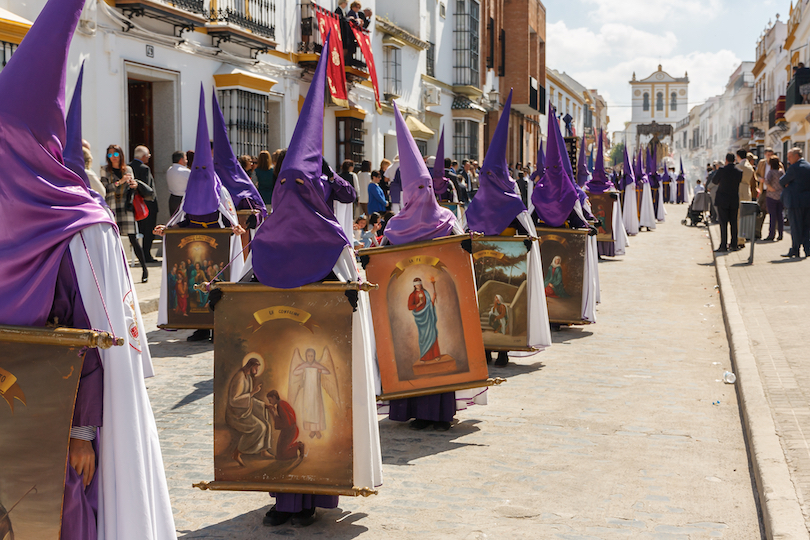
You might want to visit Seville during the Holy Week leading up to Easter because this is when The Semana Santa Festival takes place. This religious festival is one of the most important in Spain, attracting visitors from all four corners of the world.
During this event, the streets of Seville come alive with processions featuring massive floats, called pasos, depicting scenes from the Passion of Christ.
These pasos, carried by bearers known as costaleros, are accompanied by solemn music and followed by penitents dressed in traditional robes. The atmosphere resonates with reverence, emotion, and collective devotion as the processions wind through the narrow streets.
15. Plaza de Toros de la Maestranza
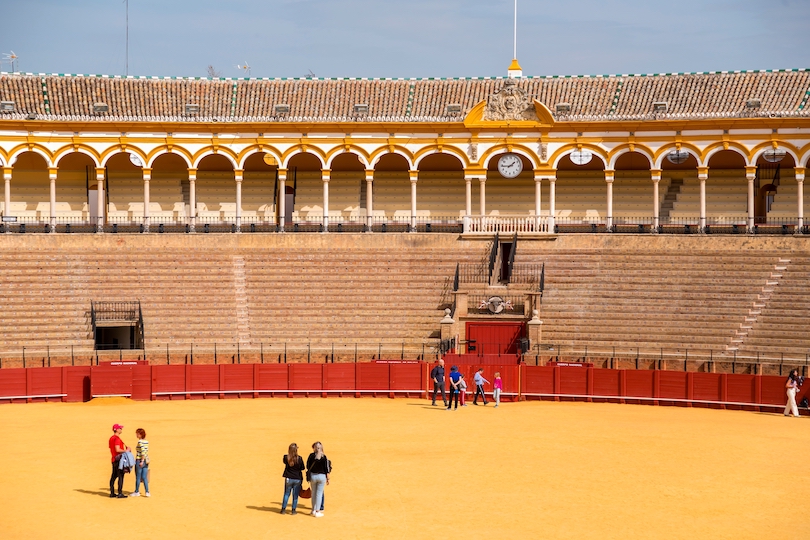
For visitors who are interested in the Spanish tradition of bullfighting, the Plaza de Toros de la Maestranza is a can’t-miss destination. The oldest bullring in Spain, the 14,000-seat arena dates back to 1758, and bullfights are still held here on Sundays from spring to fall.
You don’t need to watch a bullfight, however, to learn more about the tradition. The adjacent museum exhibits artifacts and information about famous bulls and matadors. Tickets include admission to the museum and a guided tour of the ring.
14. Iglesia Colegial del Salvador
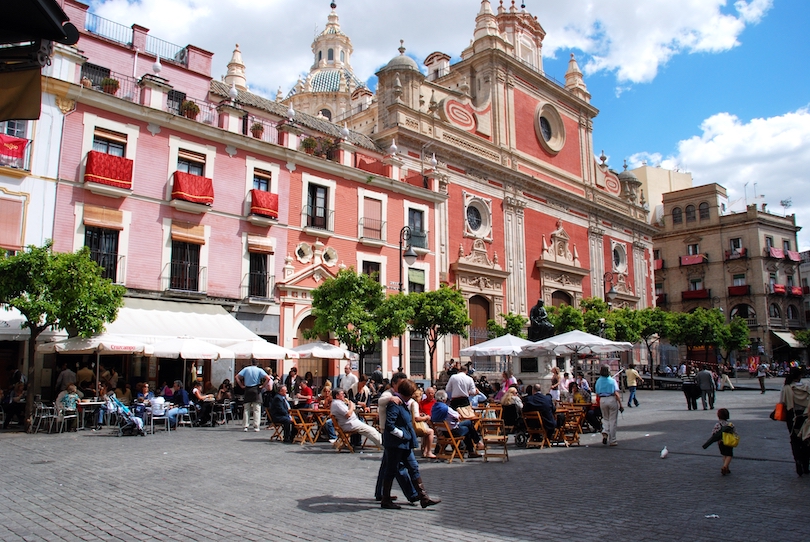
Once a mosque, the Iglesia Colegial del Salvador is now a magnificent church that is a testament to the city’s rich architectural and artistic heritage. This impressive Baroque-style church is the largest in the city, adorned with intricate ornamentation, grandiose facades, and a stunning interior.
Providing you with a deeper appreciation of Seville’s artistic and religious heritage, the church captivates with its soaring ceilings, elaborate altarpieces, and beautifully carved sculptures on its nave.
One of the church’s main highlights is the Chapel of the Holy Christ, which has a striking crucifix. Another is the Chapel of the Virgen del Carmen, known for its exquisite artwork.
However, perhaps the church’s most striking feature is its peaceful ambience. It invites visitors to reflect on and admire the intricate craftsmanship that went into creating this architectural masterpiece.
13. Basilica de la Macarena
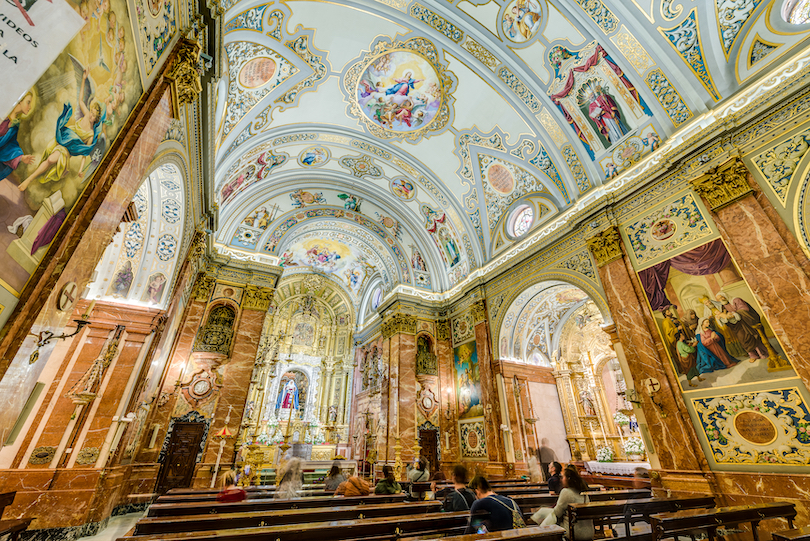
The Basilica de la Macarena is another important religious site in Seville. Dedicated to the Virgen de la Esperanza Macarena, a much-loved Andulasian religious figure, the magnificent basilica boasts a striking facade. Its exterior’s distinguishing white and red colors possess ornate detailing that will captivate you with their intricacy.
Once inside, you’ll be impressed by its spectacular stained glass windows, stunning sculptures and beautiful architecture. But what steals the show is the chapel which features an incredible image of the Virgen de la Macarena. Devotees regularly pay their respects to it and seek spiritual guidance and solace.
Due to its popularity, The Basilica de la Macarena does get very busy. So it is best to come here in the hour either side of it opening and closing.
12. Itálica Ruins
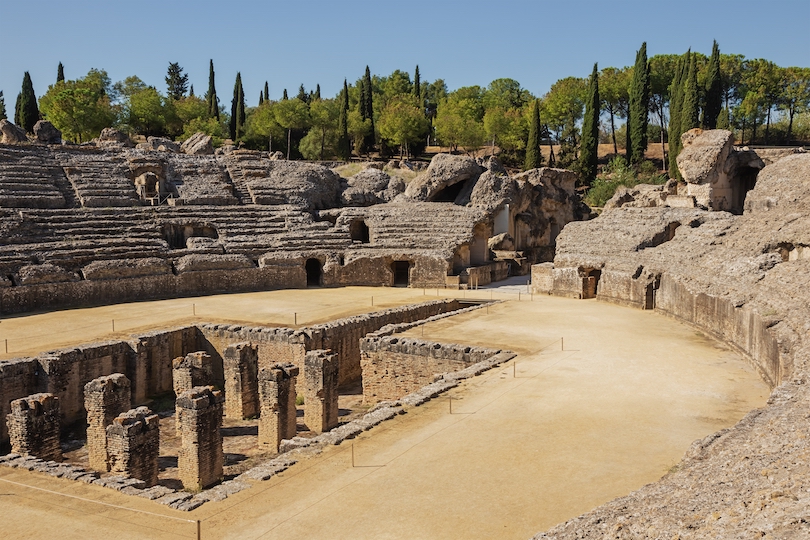
The Itálica Ruins are probably one of Seville’s biggest drawcards. You’ll need to hop on a bus at Plaza de Armas to get to them. But once there, you will have arrived at the birthplace of two of the most significant Roman Emperors – Hadrian and Trajan.
The Roman city was founded in 206 BC and is now an archaeological site of great historical importance. It features the well-preserved remnants of a grand amphitheater, which at the time was one of the largest in the Roman Empire.
As you walk through the ruins, you’ll see impressive mosaics, columns, and the remains of several other homes and buildings. All of which provide a glimpse into the daily life of its Roman inhabitants. The site also houses a small museum where artifacts and sculptures found during excavations are displayed.
11. Museo De Bellas Artes
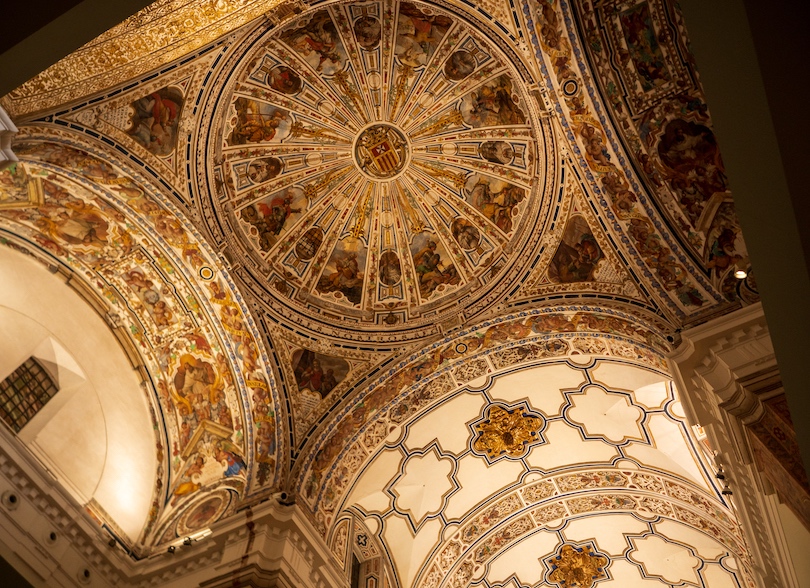
Also known as the Museum of Fine Arts, The Museo de Bellas Artes, is somewhere all art lovers should visit. Housed within the former Merced convent, the museum accommodates a remarkable collection of several centuries of artwork.
It showcases various styles, from historical and religious paintings to sculptures and decorative arts. They include masterpieces by renowned Spanish artists, including Velázquez, Murillo, and Zurbarán. The museum incorporates spacious galleries and beautifully restored interiors, creating a serene atmosphere regardless of how busy it is.
Some of its most notable works are in its chapel, where the artworks reside in a space with a stunning painted ceiling and an impressive dome.
Situated within easy walking distance of Seville’s town center, the building also has a series of peaceful courtyards where you can sit and reflect on what you have seen.
10. Barrio de Triana
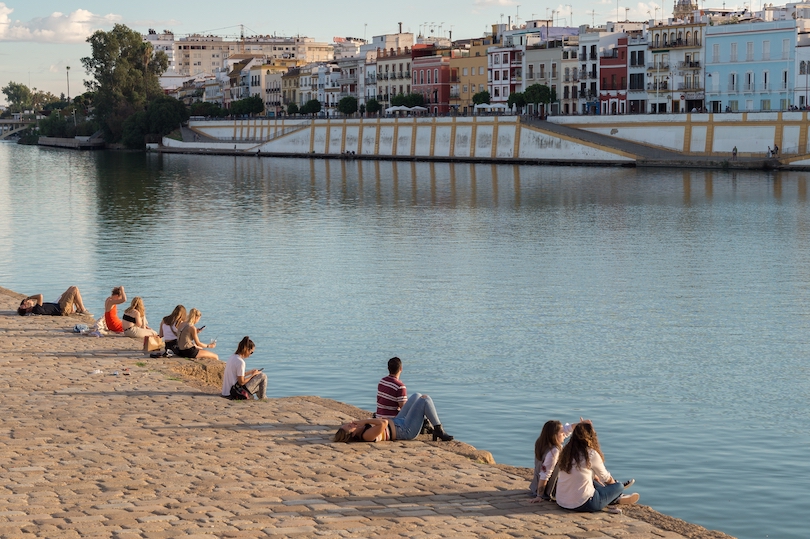
While there is plenty to see and do in Seville’s main town center, make sure you take the time to cross over the Guadalquivir River. There, you’ll be able to visit the vibrant and historic neighborhood of the Barrio de Triana.
The district resides on the river’s west bank. It is renowned for its distinctive character, epitomised by its brightly colored houses. Strolling through its charming streets, you’ll get to see them close up and venture into traditional ceramic workshops, lively markets, and bustling tapas bars.
Triana is also known for its strong ties to flamenco dancing. So it is another excellent place to catch an authentic flamenco performance. The neighborhood is also famous for its delicious seafood and vibrant nightlife, with many fabulous restaurants and bars.
9. Torre del Oro
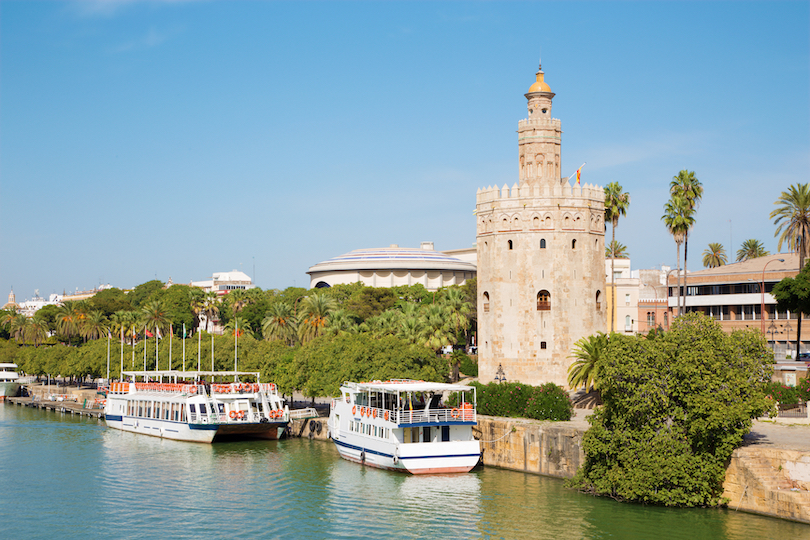
No other structure in Seville better explains the role that the Guadalquivir River played during Spain’s colonial period than Torre del Oro, the Golden Tower. Seville owed much of its success in maritime trade to the navigable river, which offered ships more protection than a traditional European port.
For centuries, a heavy chain was strung across the river from the tower to protect the city from seafaring invaders. Built in the early 1200s, the watchtower’s name comes from the golden glow that the reflection of its building materials casts on the river.
Today, the tower is home to a maritime museum that outlines the river’s importance throughout Seville’s history. Visitors can enjoy views of waterway and city from a rooftop viewing platform.
8. Parque de María Luisa
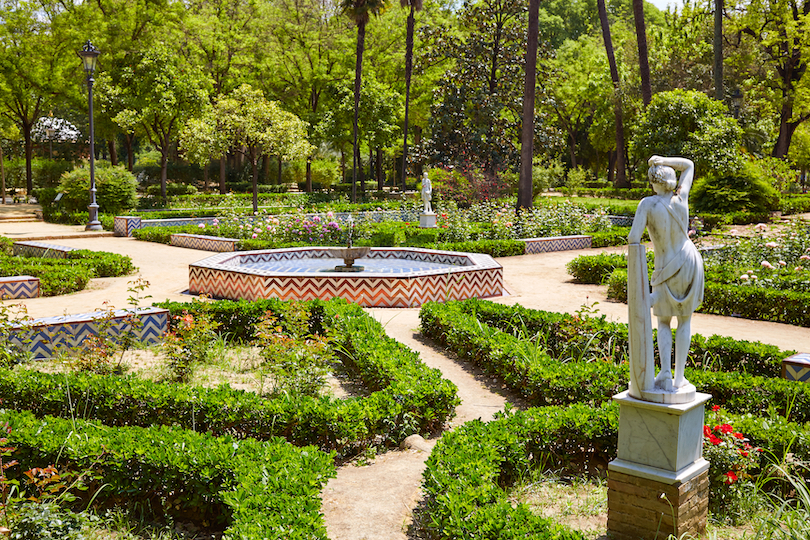
Seville can be a bustling city at times. So when you need an escape into serenity, head to the Parque de María Luisa.
The park is the city’s primary green area, parallel to the Guadalquivir River. It is an expansive green oasis renowned for its beautiful gardens, tranquil ponds, and grand boulevards lined with lush trees. Within it are several winding pathways to stroll along, ponds with bridges to cross and shaded benches to sit. You can also rent a rowboat to navigate the tranquil waters of its central lake.
In the park, there are several notable monuments and architectural landmarks, including the Plaza de España. There is also plenty of space to sunbathe or enjoy an al fresco picnic in several of its scenic areas.
7. Metropol Parasol
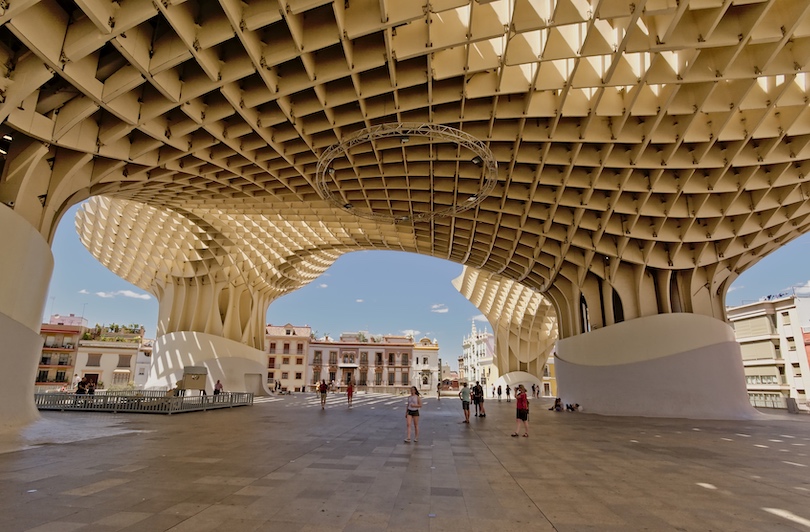
Located at La Encarnacion square in Seville’s Old City district, the newly completed Metropol Parasol is described as the largest wooden structure in the world. Designed by German architect Jurgen Mayer-Hermann, the building features six gigantic umbrella-shaped structures made of birch wood imported from Finland.
Nicknamed Las Setas de la Encarnacion, or Incarnacion’s Mushrooms, the modern design has spurred almost as much controversy as the building’s exorbitant price tag. Delays and changes in building methods doubled the estimated cost of 50 million euros. The structure is home to a marketplace, an antiquarium, a restaurant and an open air plaza.
6. Casa de Pilatos
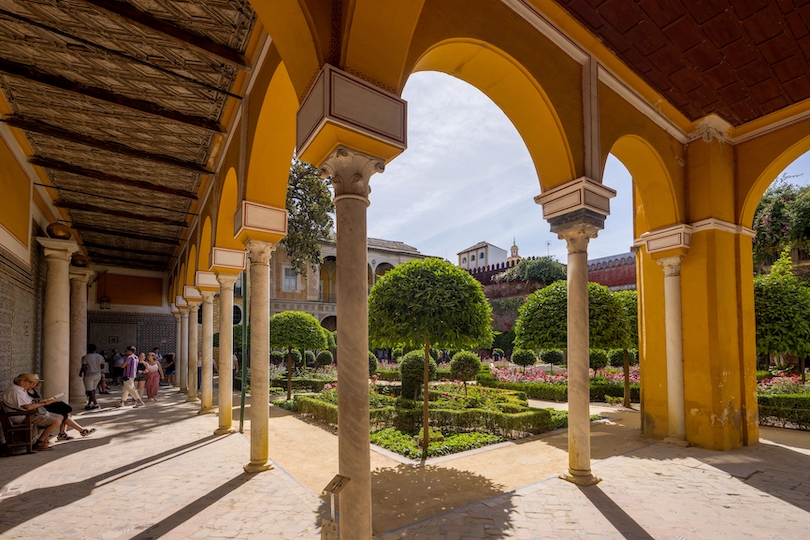
Located next to the Plaza de Pilatos, the Caso de Pilatos is considered a premier example of an Andalusian palace. Designed by architect Genoese Antonio Maria Aprile in 1529, the “Pilate’s House” was so named in reference to the original owner’s son, Fadrique Enriquez de Rivera, who made a pilgrimage to Jerusalem in 1519.
Although the building is privately owned by the Medinaceli family, it’s open to the public for guided tours much of the year. Standout features include a series of bullfight paintings by Francisco Goya, a 16th-century marble gate and a grand staircase ornamented with a Mudéjar-style honeycomb ceiling.
5. Plaza de Espana
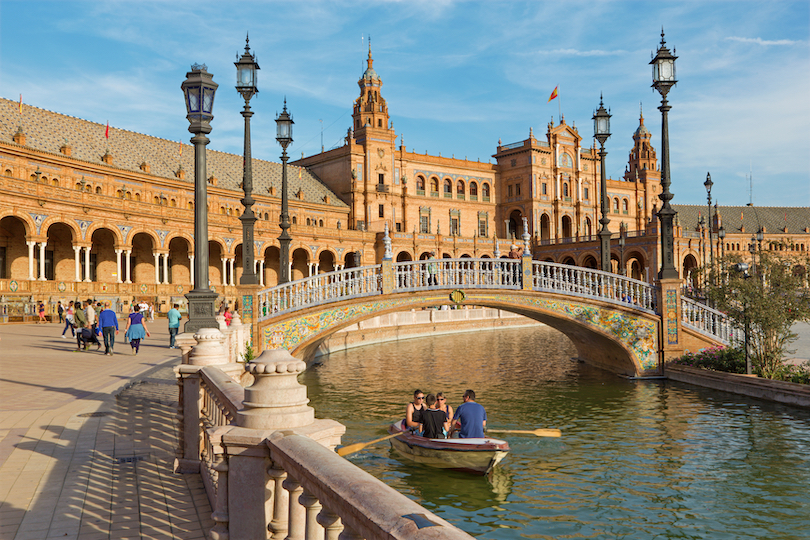
If there is one place you must visit in Seville, it is The Plaza de España. Found at the Parque de María Luisa, the magnificent square perfectly embodies the grandeur and beauty of the city. Built for the Ibero-American Exposition of 1929, it features a marvelous combination of Renaissance and Moorish influences.
The plaza has a semicircular design and comprises colorful ceramic tiles, ornate Venetian-inspired bridges, canals and a centerpiece fountain. Visitors can explore the plaza’s expansive walkways, each representing a different Spanish province, and admire the intricate ceramic work depicting historical scenes and landmarks.
A popular gathering place for locals, it is a lovely destination for an afternoon stroll, a romantic boat ride down the canal, or a horse-drawn carriage ride through the square.
4. Barrio Santa Cruz
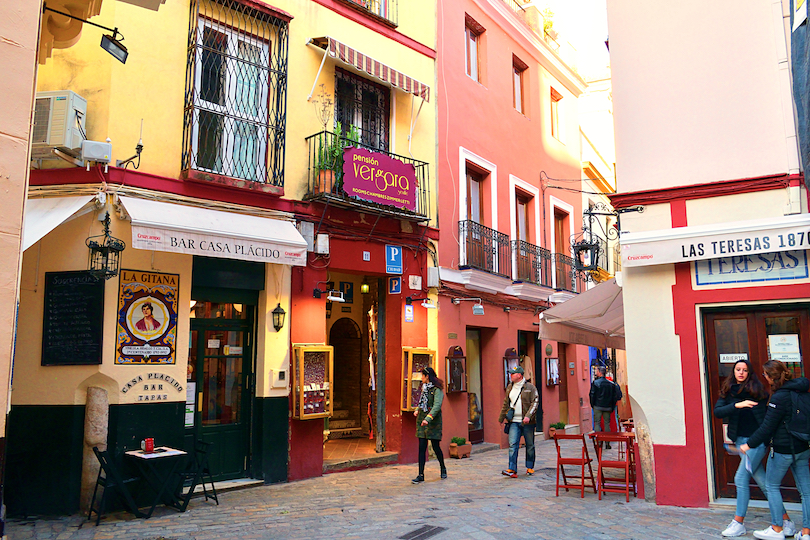
Located to the east of the Old City, the Barrio Santa Cruz is bordered by the Guadalquivir River. The neighborhood was Seville’s Jewish quarter until the late 1300s, when synagogues were closed, homes were confiscated and thousands of Jewish people were either killed or forced to convert to Christianity.
A neighborhood of narrow, cobbled alleys and streets, the barrio is filled with orange trees, colorfully tiled patios and small-scale plazas as well as a wide array of tapas bars and restaurants. Closed to vehicle traffic, the neighborhood is perfect for visitors who want to experience the ambience of a medieval Spanish city.
3. Real Alcazar
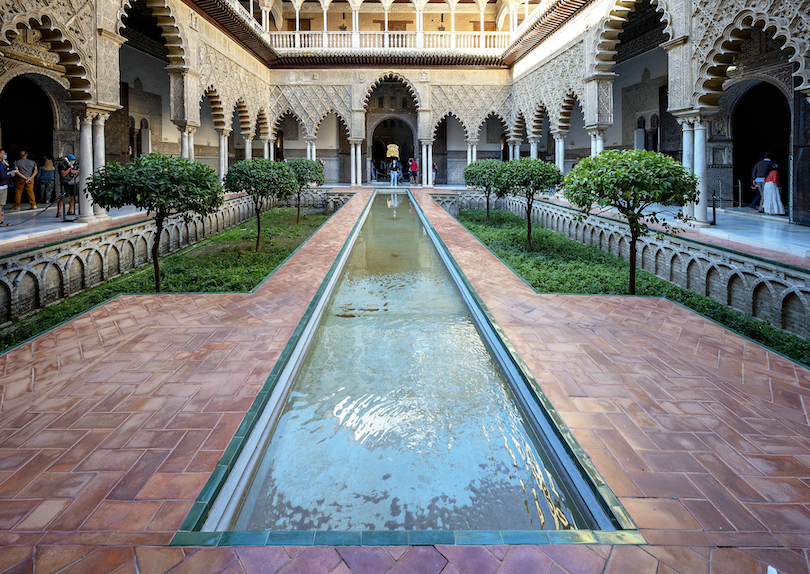
Still used today by Spain’s Royal family on state occasions, the Alcazar complex of royal palaces, patios and gardens has undergone many transformations over its more than one-thousand-year history.
In the 11th century, Muslim Moors constructed a palace on the site of a 10th-century fort, which was converted to a Gothic-style structure in the 13th century. One hundred years later, King Pedro hired Moorish craftsmen to rebuild and expand the palace in the Mudéjar style.
From the starry design of the domed ceiling in the Salón de Embajadores (Ambassadors’ Hall) to the delicate arches and plasterwork of the Patio de las Doncellas (Patio of Maidens), the Palacio de Don Pedro is considered one of the top tourist attractions in Seville.
2. La Giralda
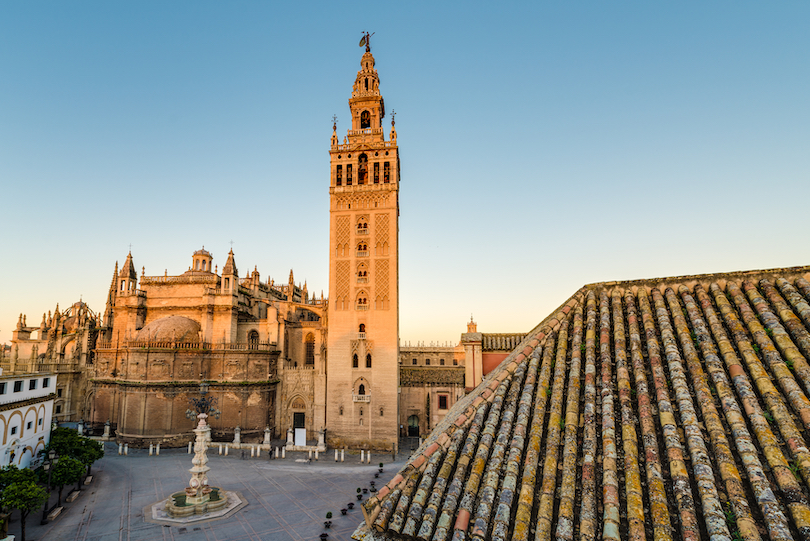
The Giralda is the only remaining structure of the 12th-century mosque torn down during the construction of the Seville Cathedral. Moors built the minaret with a series of ramps so that guards could ride to the top on horseback.
Today, the 35 ramps make it easy for visitors to ascend to the summit to enjoy panoramic views of the city below. The bell tower is capped with a bronze weathervane called El Giraldillo, which is a symbol that represents the triumph of faith.
The entrance to the tower is located in the cathedral’s northeastern corner.
1. Seville Cathedral
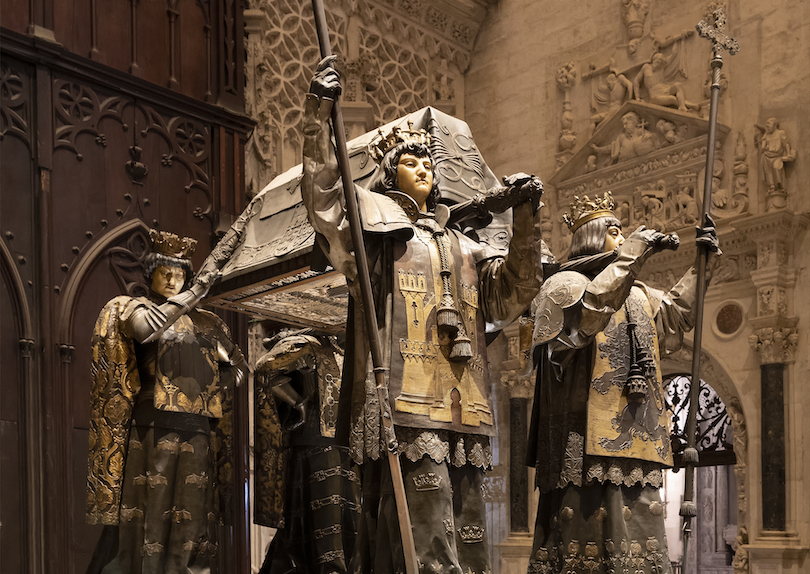
Built on the site of a grand Almohad Mosque, Seville’s medieval cathedral was built to demonstrate Seville’s power and wealth after the Reconquista.
At the time of its completion in the 16th century, it supplanted the Hagia Sophia as the largest cathedral in the world. It is still the third-largest church in Europe, and the biggest by volume.
The mammoth Gothic structure features an altarpiece depicting the life of Jesus that includes more than 1,000 figures covered in gold leaf. The cathedral’s artistic treasures include Pedro de Campaña’s Descent from the Cross, Francisco de Zurbarán’s Santa Teresa and Bartolomé Esteban Murillo’s masterpiece, La Inmaculada. Within the church’s transept lies the tomb of Christopher Columbus.
Share this post:
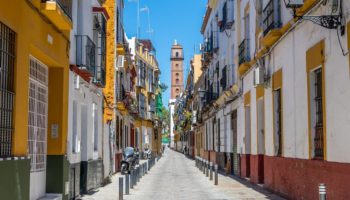
Where to Stay in Seville: Best Neighborhoods & Hotels
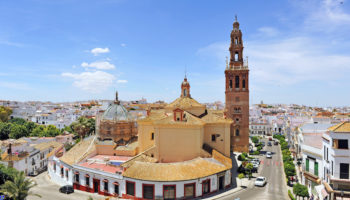
7 Best Day Trips from Seville
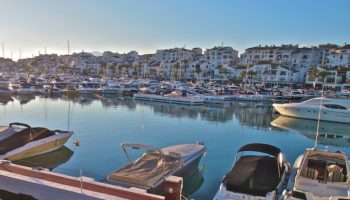
10 Top Destinations in Southern Spain
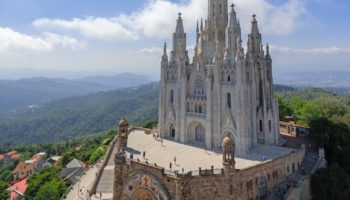
14 Most Amazing Churches in Spain
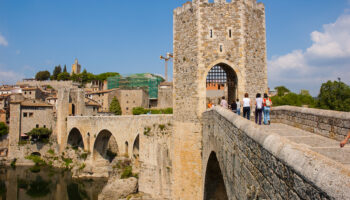
19 Best Places to Visit in Catalonia, Spain
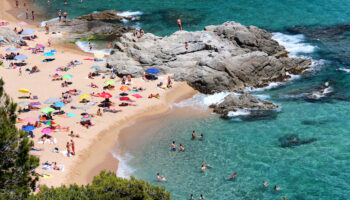
20 Best Beaches in Spain to Visit This Summer
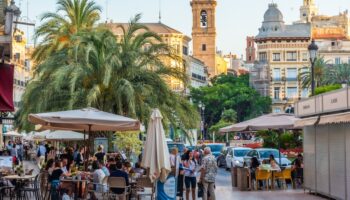
27 Top Attractions & Things to do in Valencia
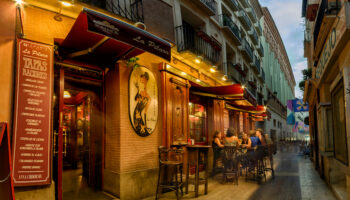
18 Best Things to do in Zaragoza, Spain
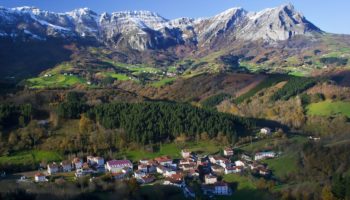
17 Most Beautiful Regions of Spain
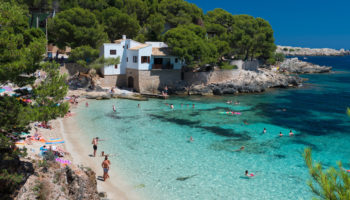
Where to Stay in Mallorca: Best Towns & Hotels
Reader interactions.
February 5, 2015 at 4:48 am
Seville is the wonderland in Spain. I am planning to visit Seville during Easter holidays 2015 with my family
Leave a Reply Cancel reply
Your email address will not be published. Required fields are marked *
This site uses Akismet to reduce spam. Learn how your comment data is processed .
Seville Travel Guide
Courtesy of Westend61 | Getty Images

18 Best Things to Do in Seville, Spain
Seville is famous for its enormous UNESCO-listed Catedral and soaring La Giralda tower, but there are tons more must-visit places where the city's rich history shines. Stroll along the Guadalquivir River for scenic views, or walk through the old,
- All Things To Do

Royal Alcázar of Seville Royal Alcázar of Seville
U.S. News Insider Tip: There is a cafe in the Alcazar Gardens – it’s a delightful spot to grab a snack while the peacocks strut around by your table. The food is overpriced, predictably, but it’s worth stopping for a coffee or beer. – Fiona Flores Watson
The Spanish monarchy doesn't quite boast the worldwide notoriety of the British monarchy, but royalty is royalty, right? This palace was built over seven centuries, from Moorish times to the Renaissance, and it still occasionally hosts the royal family when they visit Seville. In fact, the Alcazar is the oldest royal palace still in use in Europe. "Game of Thrones" fans may also recognize the palace as it was featured in the series.

Parque de María Luisa Parque de María Luisa free
If you're in search of green space, you won't be disappointed – Seville's got plenty. But the most notable of the city's parks is Parque de María Luisa, located next to the Plaza de España . This park, originally built as private grounds, was remodelled for the 1929 World's Fair and has remained one of Seville's most popular sites since.
You can take a stroll, ride a bicycle, rent a rowboat or hop on a horse-drawn carriage ride through the gardens designed by French landscape architect Jean-Claude Nicolas Forestier. Along with several stunning tile-covered bridges, you'll also find several notable buildings and museums within the park. The Costurero de la Reina (or the Queen's Sewing Room), a 19th century castle-like structure and former sewing retreat for the young wife of Spain's King Alfonso XII, is now a tourist information office. The Pabellón Mudéjar is home to the Museum of Art and Popular Customs of Sevilla. And the Pabellón del Renacimiento houses the Archeological Museum of Seville.

Catedral de Sevilla and La Giralda (Seville Cathedral) Catedral de Sevilla and La Giralda (Seville Cathedral)
The largest Gothic cathedral in the world, the Catedral de Sevilla, sits in the heart of the city on Avenida de la Constitución and invites travelers from around the world to admire its impressive architecture. Built over the duration of the 15th century, the cathedral has a multitude of chapels and sits on the site of a former mosque. The vastness of the cathedral and tower impresses visitors, and upon entering, many said they were stunned by the building's cavernous interiors. Christopher Columbus' remains can be found inside the above-ground bronze tomb on display inside the cathedral. Once you've finished touring the cathedral's interior, make your way to the Patio de Los Naranjos – an outdoor courtyard filled with aromatic orange trees.
La Giralda – the adjacent tower and, until recently, the tallest landmark in Seville – is one of the few remains of the site's original mosque, built by the 12th-century Berber-Muslim Almohad dynasty. Climb the minaret's nearly 40 ramps to the very top and take in sweeping views of the city.

Popular Tours

Cathedral, Alcazar and Giralda Guided Tour with Priority Tickets
(654 reviews)
from $ 54.27

Alcazar and Cathedral of Seville Tour with Skip the Line Tickets
(2306 reviews)
from $ 59.71

Alhambra Palace and Albaicin Tour with Skip the Line Tickets from Seville
(634 reviews)
from $ 151.88

Plaza de España Plaza de España free
Originally built for Seville's Ibero-American Expo at the 1929 World's Fair, the Plaza de España offers one of the most picturesque panoramas in the city.
The 540,000-square-foot Plaza de España includes a giant, semicircular neo-Moorish building (spanning more than half of the site's perimeter) and an expansive plaza with a canal, a central fountain and four footbridges. Architect Aníbal González built the site to highlight Spain's technological and artistic achievements for the world. The detailed artwork built into the Plaza de España's design helps it stand out as an architectural tour de force.

Barrio Santa Cruz Barrio Santa Cruz free
U.S. News Insider Tip: You can see visible remains of the city’s medieval Jewish community – stone tombs from the original Jewish cemetery – in unlikely locations: two underground car parks, namely Cano y Cueto next to Jardines de Murillo, and Avenida Roma at Puerta Jerez. – Fiona Flores Watson
Navigating your way through winding footpaths and narrow streets of a centuries-old neighborhood is captivating for any adventurous traveler. Even among Europe's many picturesque neighborhoods, Barrio Santa Cruz stands out for its centuries of history and its abundance of charming restaurants and shops, not to mention the orange-tree-covered plazas awaiting pedestrians around each turn.

Metropol Parasol (Setas de Sevilla) Metropol Parasol (Setas de Sevilla) free
If you're anywhere near Plaza de la Encarnación (in the northwest corner of El Centro), the Metropol Parasol is impossible to miss. Its towering presence, consisting of six wooden mushroom-like shapes standing around 90 feet tall, was constructed in 2011, making it the newest major attraction in the city and purportedly the largest wooden structure in the world. Locals fondly refer to the lattice structure as "Las Setas" or "The Mushrooms" given its quirky shape.
The architectural wonder serves as a gathering place and features a food market with fresh produce and take-away stalls, restaurants, an archeological museum, winding rooftop walkways and an open-air public square.

Basílica de la Macarena Basílica de la Macarena free
A Catholic temple situated in the Macarena neighborhood, this relatively new religious site (built in the 1940s) wows visitors the moment they enter. From the outside, the white and golden-yellow church may seem small, but its intricate interiors are something to admire. Frescoes adorn the walls and ceiling, while gold accents provide a shimmering aesthetic. Some visitors even said they enjoyed this basilica more than the city's massive cathedral and said it's worth a quick stop.
Many reviewers said their favorite aspect of the church is the glowing golden altar, which holds the Virgin of Hope or La Virgin de la Esperanza Macarena – a famous 17th-century statue of a weeping Virgin Mary that holds great importance in the city's Semana Santa celebrations. There is also a small museum behind the altar that showcases the two floats on which Mary and Jesus ride in the Semana Santa Holy Friday Madrugada (early hours) procession each year.

See a flamenco show See a flamenco show
Flamenco shows can be found all over the city, as the traditional dance is a key part of Andalusian culture. Watching a flamenco show in Seville is a must, but the quality of the shows varies by location, and you may get caught overpaying at a tourist trap.
For a top-notch performance in a classic theater setting, visit El Palacio Andaluz . The venue hosts a large cast of dancers who perform traditional flamenco twice per night; each performance lasts about an hour and a half with refreshments, or 50 minutes for flamenco only. While this venue is located outside the city center, previous visitors say the attentive service, engaging show and high-quality music make El Palacio Andaluz worth the quick taxi ride. Tickets are available for purchase online and start at 26 euros (about $28) for adults and 13 euros (about $14) for kids ages 7 to 14.

White Villages and Ronda Day Tour from Seville
(1311 reviews)
from $ 85.76

Alhambra and Nasrid Palaces Skip the Line Entrance from Seville
(1048 reviews)
from $ 150.90

Gibraltar Rock Tour from Seville
(384 reviews)
from $ 129.19

Museo de Bellas Artes (Museum of Fine Arts) Museo de Bellas Artes (Museum of Fine Arts)
Seville has a rich history that is well-represented in its sites and monuments, yet one of the best ways to uncover the city's past is through its extensive collection of artwork.
Founded in 1835, Seville's Museo de Bellas Artes – which occupies a former 17th-century monastery building centered around three tiled patios – houses pieces dating from the Middle Ages through the 20th century. The galleries include works by some of Spain's most notable artists, such as Bartolomé Esteban Murillo and Francisco de Zurbarán, as well other notable European artists like Jan Brueghel l'Ancien and Cornelis de Vos, among others.

Casa de Pilatos Casa de Pilatos
Heavily influenced by the Italian Renaissance, this sumptuous palace was built for the governors of Andalucia on land confiscated in the Inquisition, between the 15th and 16th centuries. It has one of Seville’s most impressive colonnaded Mudéjar courtyards, adorned with Roman statues. Fans of the typical azulejo ceramic tiles will love the vibrant wall-to-wall color with 150 different designs; the ceilings are magnificently decorated, too. The palace’s timeless feel has drawn a number of filmmakers: “Lawrence of Arabia,” “Kingdom of Heaven,” and “Knight and Day” were shot here. Once the city’s largest private residence, Pilate’s House was named following an ancestor’s pilgrimage to the Holy Land. Like many such grand residences in Seville, the first floor was used in the summer, as it enjoyed shade and the tiles had a cooling effect, while the second floor was used in winter.
Past visitors raved about the tile collection and the tranquil gardens, calling the palace a pleasant alternative if you're hoping to avoid the crowds of the Royal Alcázar . Others were fascinated by the interesting mix of architectural styles, which reflect the amendments to the buildings over the centuries. Reviewers called the audio guide excellent.

Lebrija Palace Lebrija Palace
Tucked away in one of the quieter shopping streets of El Centro district, this small palace contains the art collection of renowned, self-taught archaeologist Doña Regla Manjón Mergelina, the Countess of Lebrija.
Though the palace dates back to the 16th century, it's admired today for the restorations overseen by the countess in the early 20th century. She restored the building using exquisite tiles and coffered wooden ceilings salvaged from convents and palaces, and filled it with beautiful pieces, such as a Roman mosaic floor (taken from Itálica, a Roman city outside Seville), and sculpture and pottery from various civilizations. There is an eclectic mix of decor and pieces spread across two floors, including paintings by Van Dyck and a Sorolla portrait of the countess herself; upstairs you can see the private rooms where she lived. You can easily tack a visit here onto a morning’s shopping or exploring the city center.

Palacio de las Dueñas Palacio de las Dueñas
Palacio de las Dueñas was built between the 15th and 16th centuries as a home for the noble Pineda family, and today is owned by the House of Alba.
It's home to large gardens, lemon trees, ceramic tiles, antique furniture and intricate archways. Filled with flowers and bright colors, the palace is an ideal place to spend a sunny Seville afternoon, say past visitors.

Iglesia Colegial del Salvador Iglesia Colegial del Salvador
Many visitors stumble upon the Iglesia Colegial del Salvador either out of luck or because admission to the church is included in their ticket package to the more famous Catedral de Sevilla . But however they end up there, they're always glad they did.
The red-hued Roman Catholic Church overlooks the Plaza del Salvador (a five minutes’ walk from the cathedral) and is the city’s second-largest church. Built on the site of a former mosque, the church was rebuilt into its current design in the 17th century, but still preserves some of its Moorish architecture and original arcaded patio. It was designed to be full of light, and boasts intricate stained-glass windows with bright colors. Its extravagant gold altarpieces are a particular highlight for past visitors.

Caminito del Rey Trekking from Seville
(132 reviews)
from $ 107.48

Alcazar & Cathedral of Seville Exclusive Group, max. 8 travelers
(68 reviews)
from $ 89.02

Seville Private Walking Tour with Alcazar & Cathedral Tickets
(240 reviews)
from $ 225.81

Palacio Bucarelli Palacio Bucarelli
Unlike Seville’s other palaces, this one is off the beaten path, in the San Lorenzo neighborhood northwest of El Centro. The latest of such illustrious attractions to open, in summer 2023, this palace is still occupied by three generations of the same family that has owned it for 14 generations.
The original Bucarellis arrived from Florence in the 17th century – Seville’s Golden Age – and were successful merchants trading spices, silk and precious metals in the New World. Subsequent scions of the family were viceroys and governors, as well as bull and horse breeders – you can see many portraits and learn about the impressive history in the highly informative audio guide. The self-guided tour includes the stables, chapel, sculpture studio, summer salons, and garden. If you choose the ticket that includes the second floor (which is highly recommended by past visitors), you can see the family’s own dining room, drawing room, and even the bedroom of the Countess of Santa Coloma, the current title.

Ramón Sánchez-Pizjuán Stadium Ramón Sánchez-Pizjuán Stadium
Home to Sevilla FC, one of Seville's two football (or soccer) clubs, Ramón Sánchez-Pizjuán stadium offers an exciting European fútbol experience. Since its opening in 1958, the stadium has hosted a handful of World Cup and European Cup tournaments. Soccer games at the stadium – which has the capacity to seat 45,500 people – are full of energy thanks to the enthusiasm of Seville's fans.
Ticket prices for games vary based on the opponent, the day of the week and the location of your seat. (Games against cross-city rivals Real Betis, and powerhouse fútbol clubs like Real Madrid and FC Barcelona attract a lot of fans, so tickets will cost more). You can purchase tickets online or at the stadium box office. But getting a good price won't be too stressful, as travelers note that the ticket sellers are very helpful when it comes to finding the best affordable seats. Plus, all the seats in the stadium get a clear view of the action, according to recent visitors.

Torre del Oro Torre del Oro
Standing nearly 120 feet tall along the Guadalquivir River, the Torre del Oro (Golden Tower) is one of Seville's most recognizable landmarks.
The Guadalquivir River once served as the main waterway in southern Spain, and Seville was Spain’s primary port for many centuries. Naturally, a port with that much influence needed protection from ships trying to enter the claimed territory of the Almohad Dynasty (a 12th-century Muslim Caliphate that once ruled northern Africa and southern Spain). The 12-sided Torre del Oro – situated on the bank of the Guadalquivir – was once linked by a large chain to its sister structure across the river to stop ships from sailing into the port.

Isla Mágica Isla Mágica
OK, so you didn't come all the way to Europe to visit an amusement park. But when there's one nearby, it might just be the perfect way to avoid history and culture overload – especially if you have little ones in tow. Let loose at Isla Mágica, Seville's nearly 90-acre theme park that's suitable for all ages. The park is divided into six 16th- and 17th-century Spanish colonial-themed areas, which feature rides like the Iguazu log flume and the Jaguar roller coaster. You'll also find plenty of shops, shows and restaurants at the park. A small water park dubbed Agua Mágica is the perfect place to escape the heat of the summer.
Previous visitors recommended arriving early and exploring the popular rides before the park gets too crowded. Some also say the park is great for young kids, but lacks attractions for older visitors. Many reviewers said the park was a great value, especially when compared to the cost of theme park tickets in the U.S.

Plaza de Toros de la Real Maestranza Plaza de Toros de la Real Maestranza
The Plaza de Toros de la Real Maestranza is Seville's famous bullfighting ring. Built in the 18th century, the circular ring is notable for its Baroque façade.
In addition to being a historic landmark within the city, it's also considered one of Spain's largest and most important bullfighting arenas, with the capacity to seat 13,000 spectators (it's known for hosting the largest bullfighting festival in the world). Bullfighting has faced a lot of criticism for its animal bloodshed, but many Sevillanos think of the sport as an art form integral to their culture. The bullring's on-site museum is a worthwhile option for those who prefer to experience the beauty of the ring without watching an actual fight.

Private Chefchaouen Full Day Trip From Tangier
(24 reviews)
from $ 141.12

Granada Day Trip: Alhambra & Nazaries Palaces from Seville
(139 reviews)
from $ 161.76

White Villages and Ronda Day Trip from Seville
(116 reviews)
from $ 92.28
Things to Do in Seville FAQs
Explore more of seville.

Best Hotels

When To Visit
If you make a purchase from our site, we may earn a commission. This does not affect the quality or independence of our editorial content.
Recommended
The 50 Best Hotels in the USA 2024
Christina Maggitas February 6, 2024

The 32 Most Famous Landmarks in the World
Gwen Pratesi|Timothy J. Forster February 1, 2024

9 Top All-Inclusive Resorts in Florida for 2024
Gwen Pratesi|Amanda Norcross January 5, 2024

24 Top All-Inclusive Resorts in the U.S. for 2024
Erin Evans January 4, 2024

26 Top Adults-Only All-Inclusive Resorts for 2024
Zach Watson December 28, 2023

Solo Vacations: The 36 Best Places to Travel Alone in 2024
Lyn Mettler|Erin Vasta December 22, 2023

26 Cheap Beach Vacations for Travelers on a Budget
Kyle McCarthy|Sharael Kolberg December 4, 2023

The 50 Most Beautiful White Sand Beaches in the World
Holly Johnson December 1, 2023

The 26 Best Zoos in the U.S.
Rachael Hood November 16, 2023

44 Cheap Tropical Vacations That Feel Expensive
Holly Johnson|Alissa Grisler November 10, 2023

Must-see attractions in Seville
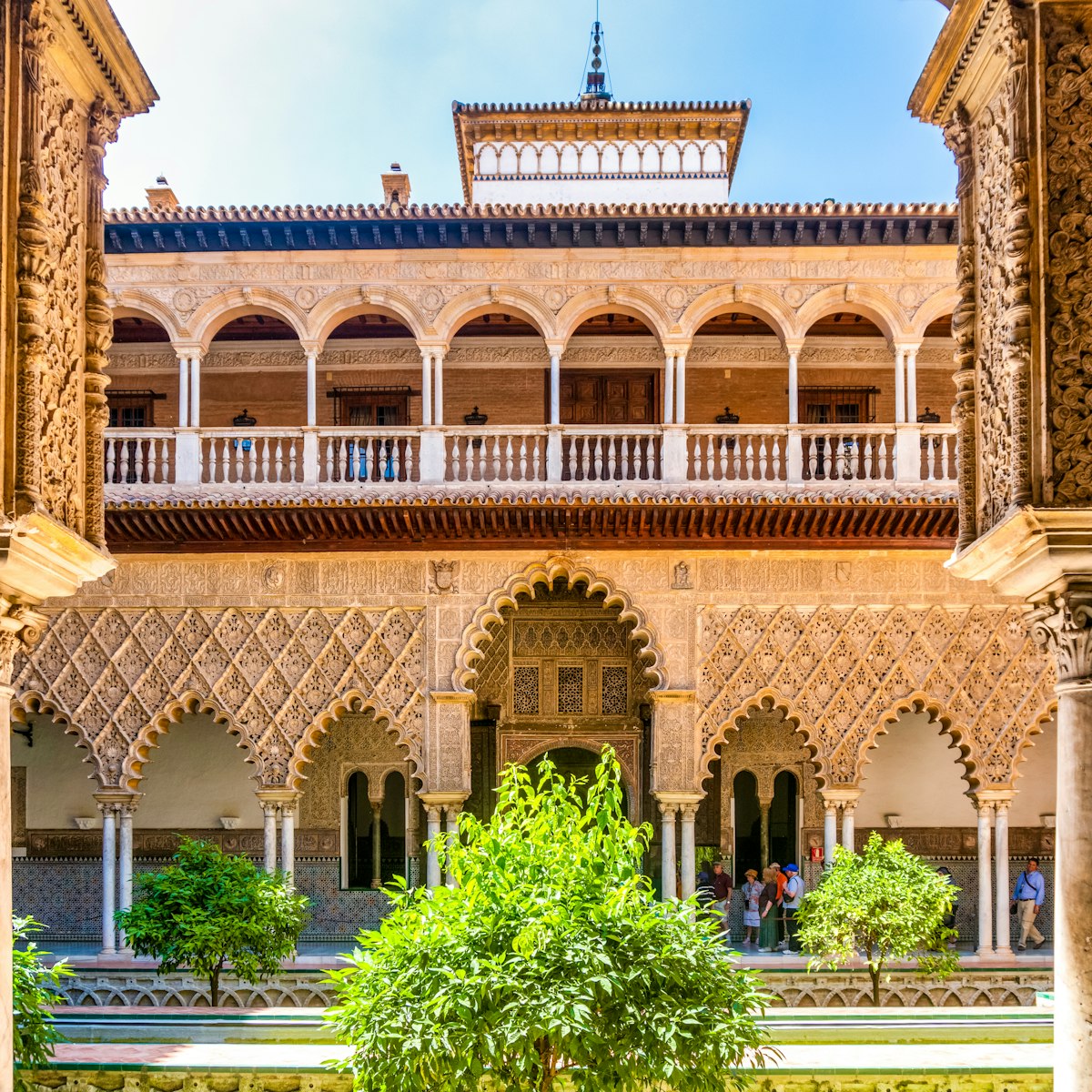
Real Alcázar
Catedral & Barrio de Santa Cruz
A magnificent marriage of Christian and Mudéjar architecture, Seville’s royal palace complex is a breathtaking spectacle. The site, which was originally…
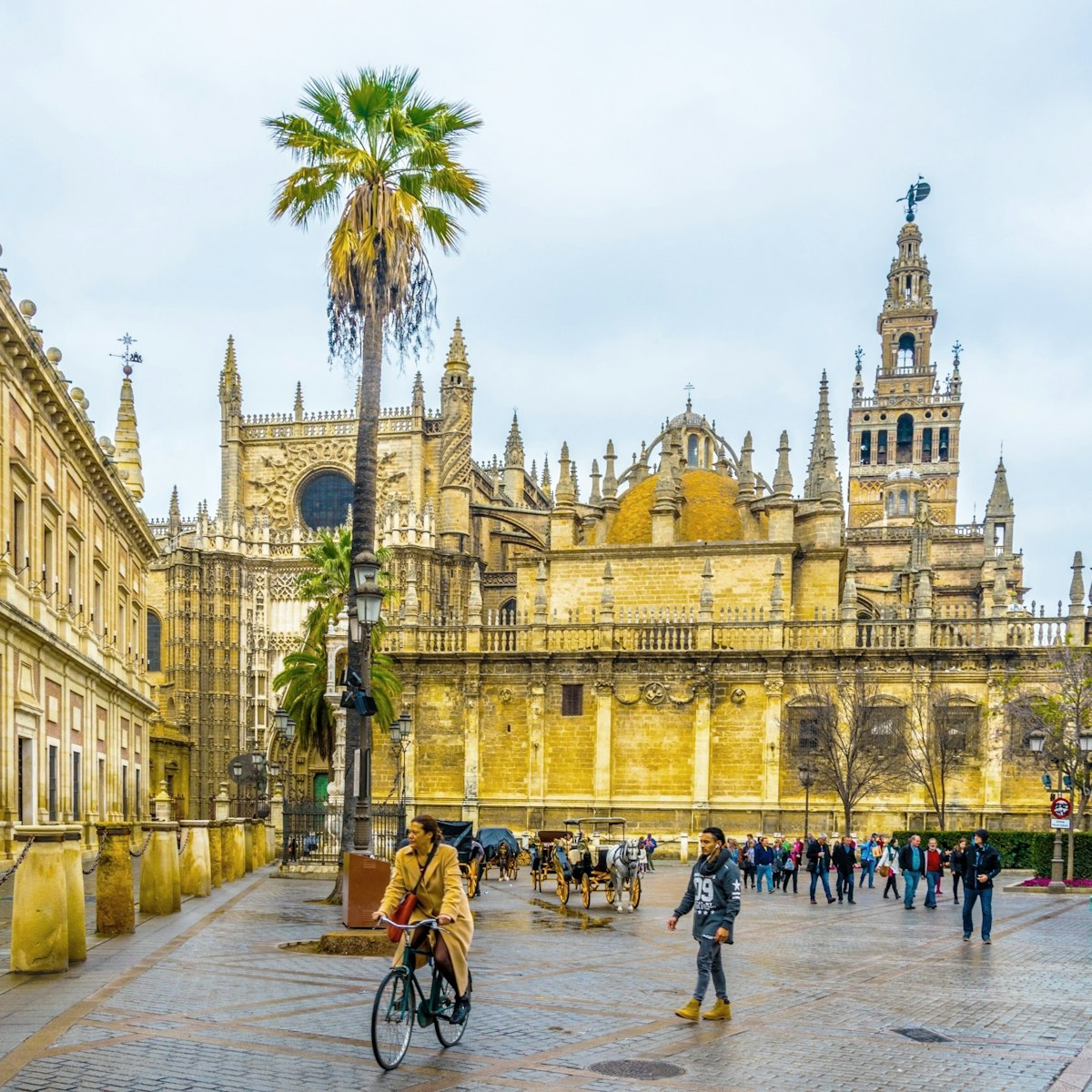
Catedral & Giralda
Seville’s showpiece church is awe-inspiring in its scale and majesty. The world’s largest Gothic cathedral, it was built between 1434 and 1517 over the…
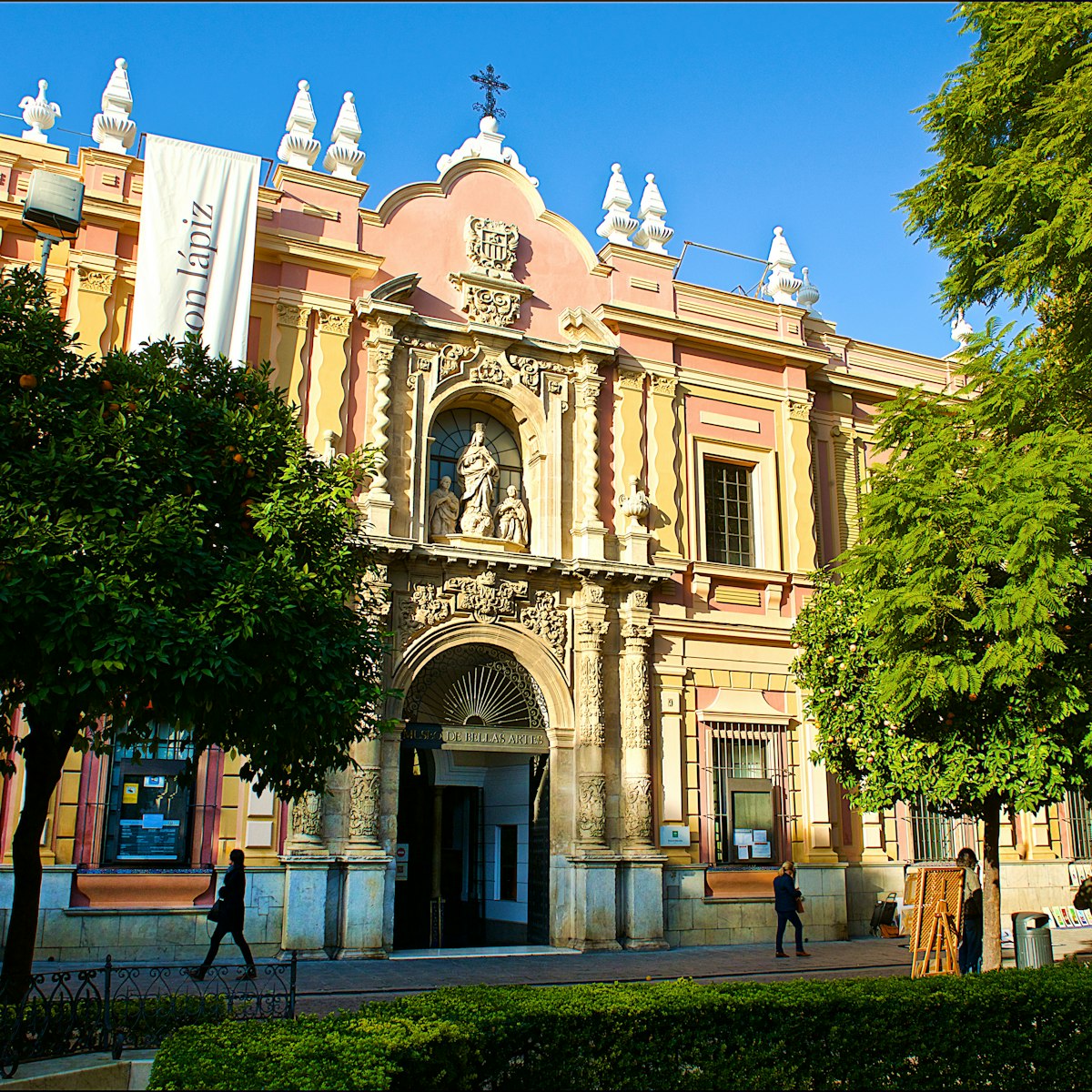
Museo de Bellas Artes
El Centro & El Arenal
Housed in a grand Mannerist palace, the former Convento de la Merced, the Museo de Bellas Artes is one of Spain's premier art museums. Its collection of…
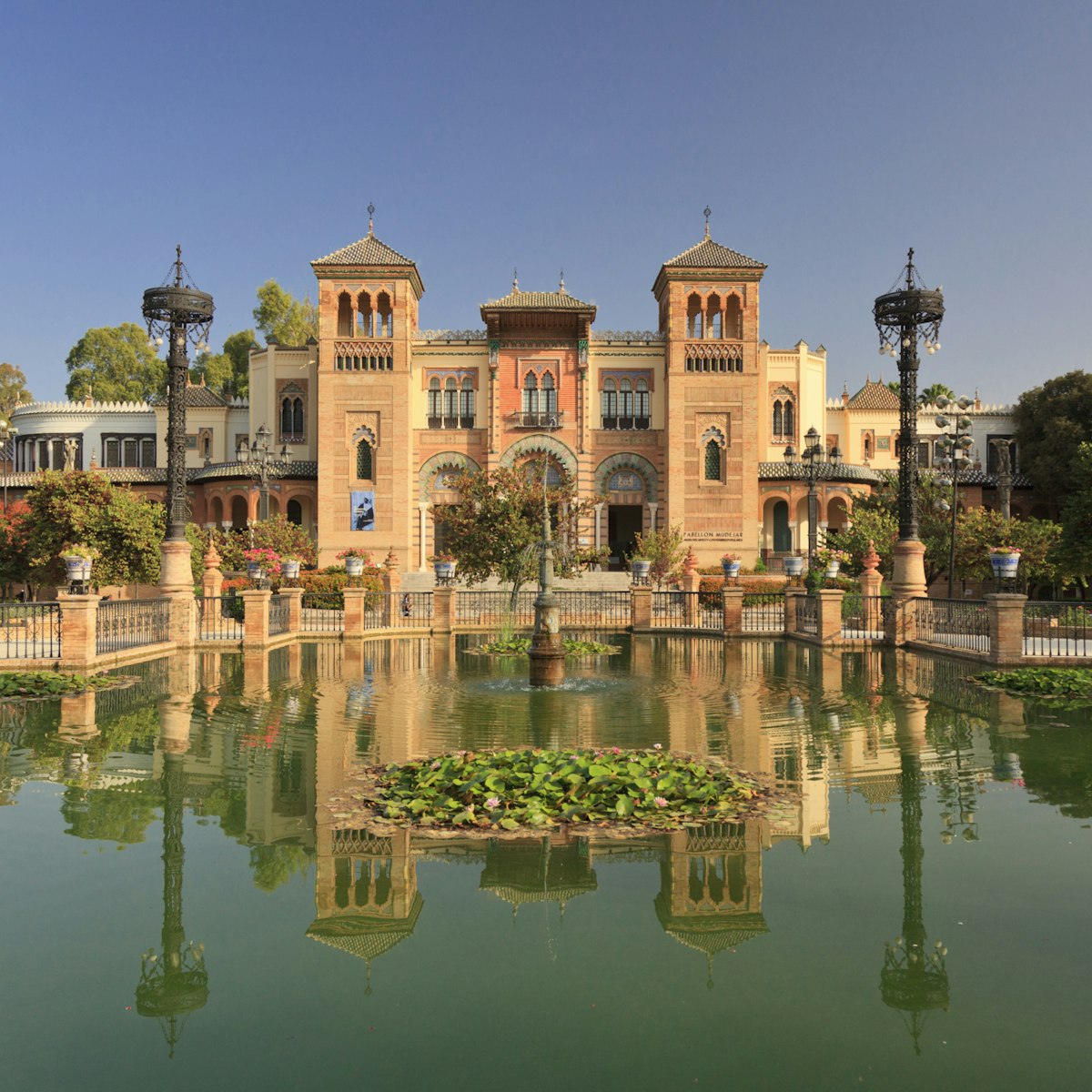
Parque de María Luisa
Parque de María Luisa & South of Centre
A glorious oasis of green, the 34-hectare Parque de María Luisa is the perfect place to escape the noise and heat of the city, with duck ponds, landscaped…
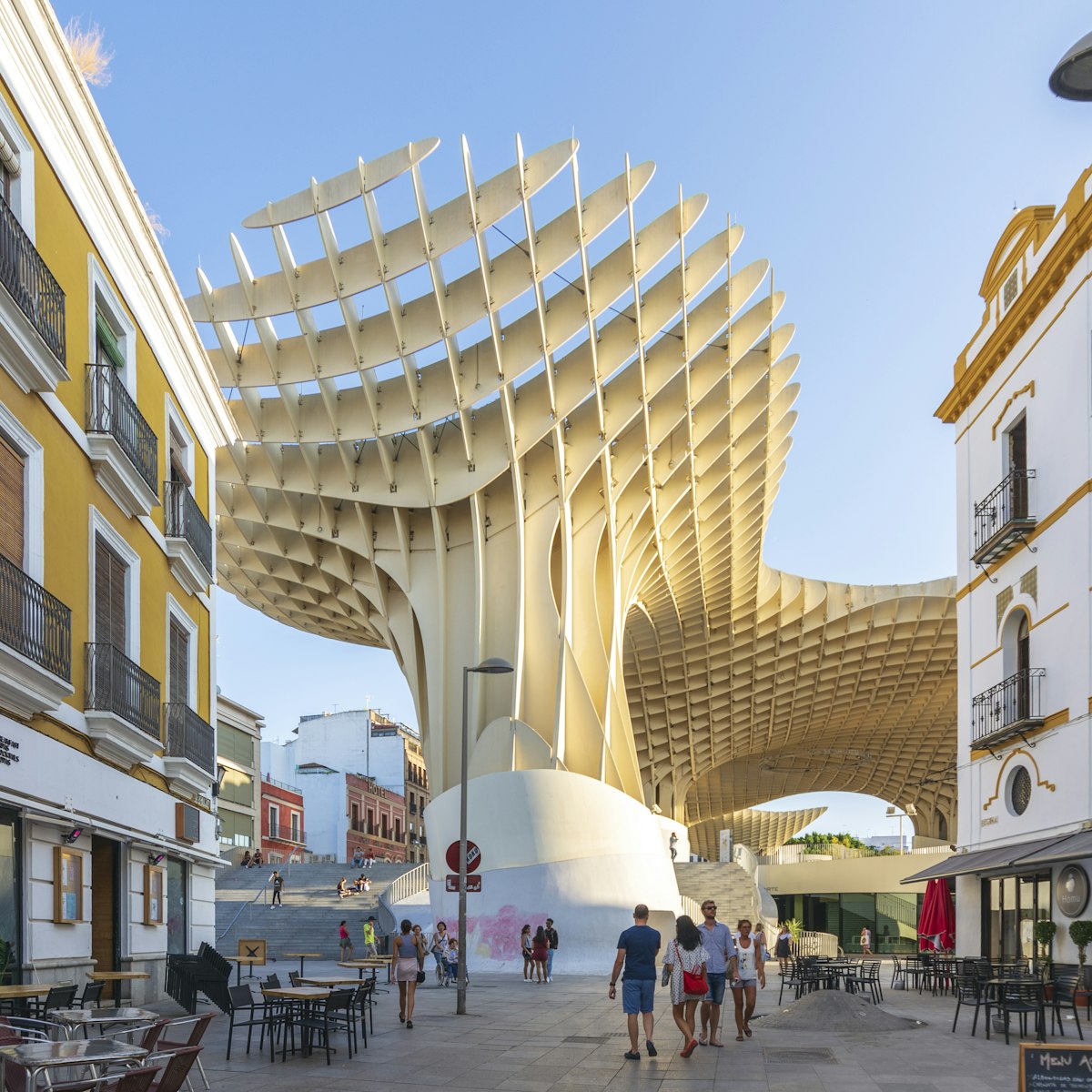
Metropol Parasol
La Macarena & Alameda de Hércules
The Metropol Parasol, known locally as Las Setas (The Mushrooms), is one of Seville's iconic modern landmarks. Built in 2011 to a design by German…
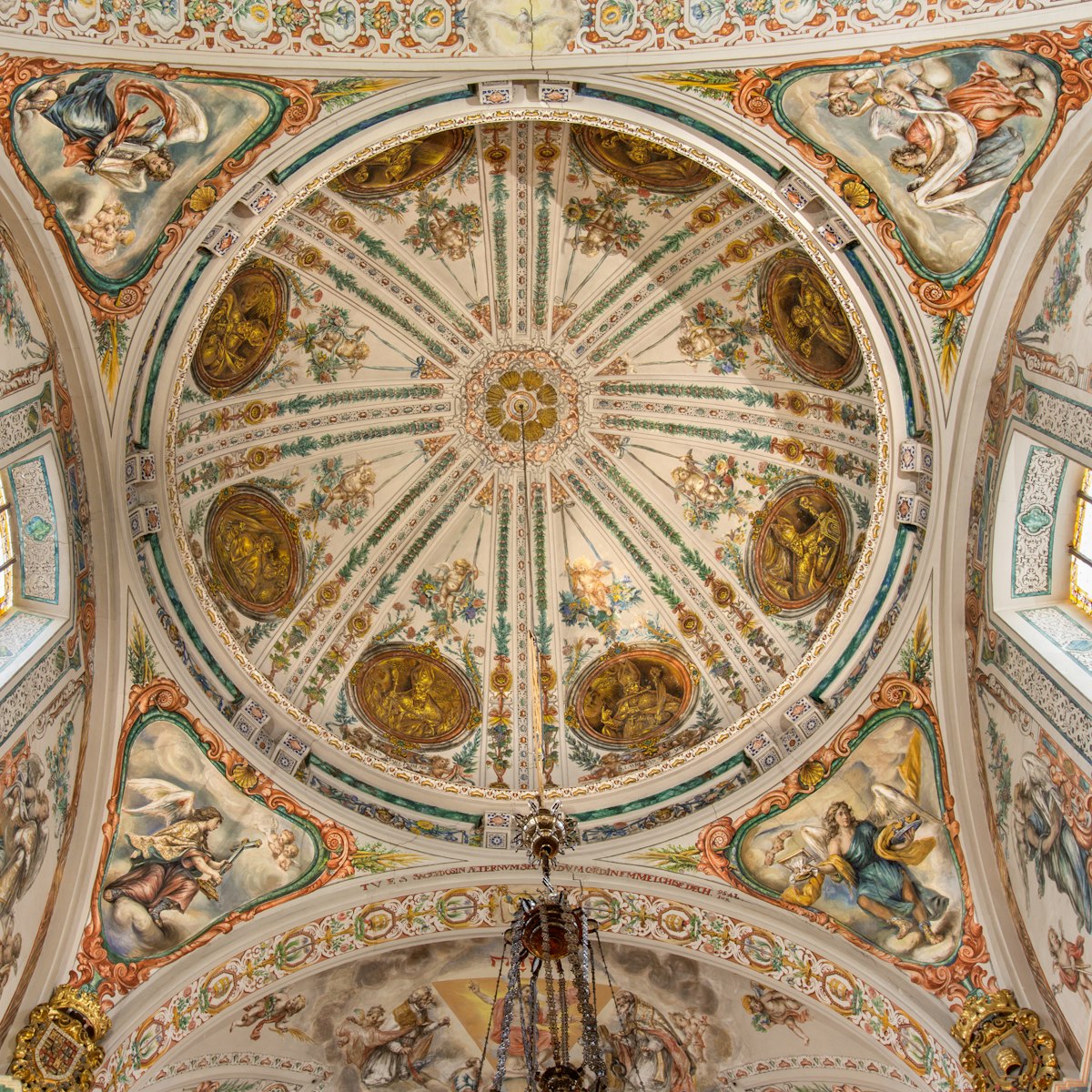
Hospital de los Venerables Sacerdotes
This gem of a museum, housed in a former hospice for priests, is one of Seville’s most rewarding. The artistic highlight is the Focus-Abengoa Foundation’s…
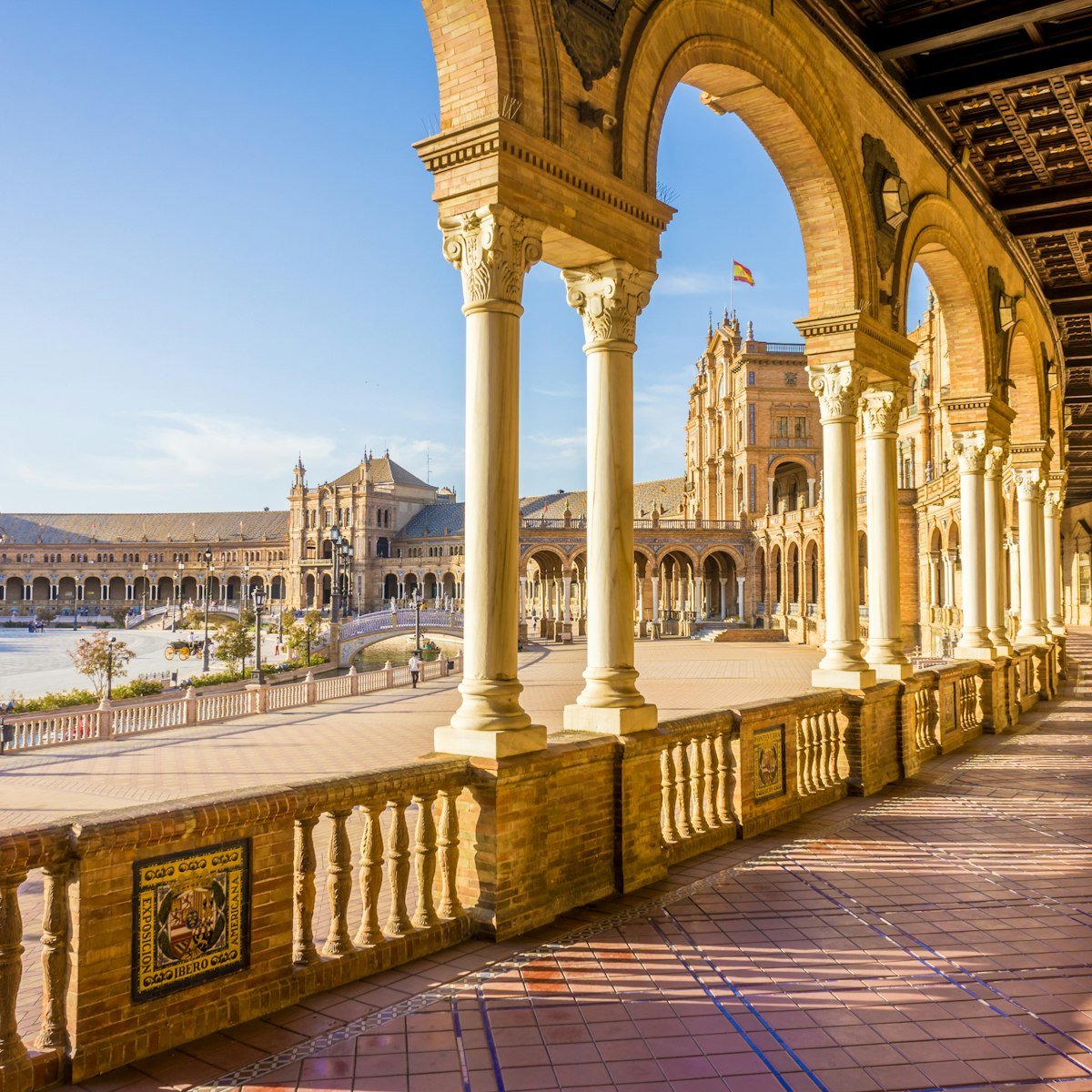
Plaza de España
This bombastic plaza, designed by architect Aníbal González in the Parque de María Luisa, was the most extravagant of the building projects completed for…
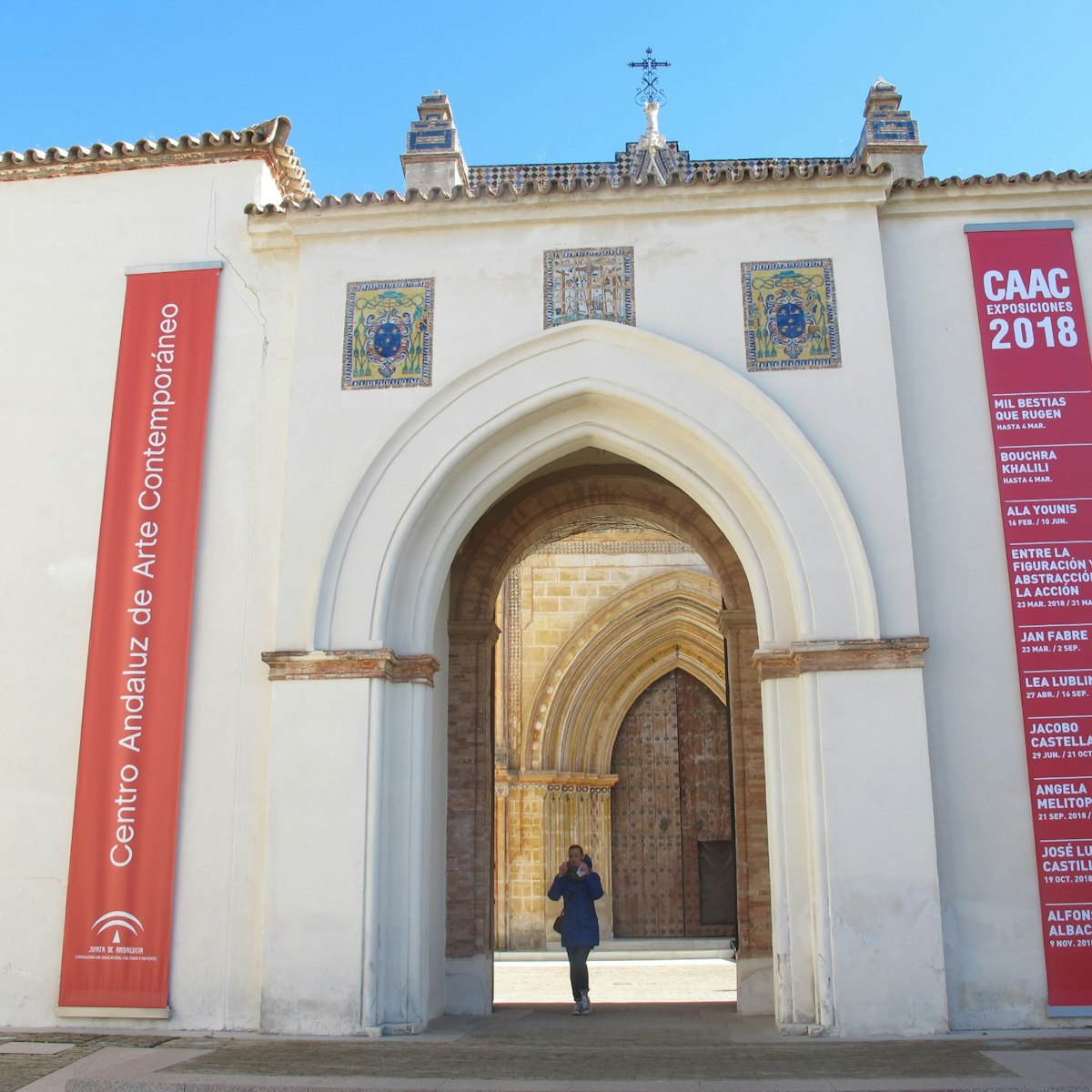
Centro Andaluz de Arte Contemporáneo
Contemporary art goes hand in hand with 15th-century architecture at the Centro Andaluz de Arte Contemporáneo. The centre, sensitively housed in the…
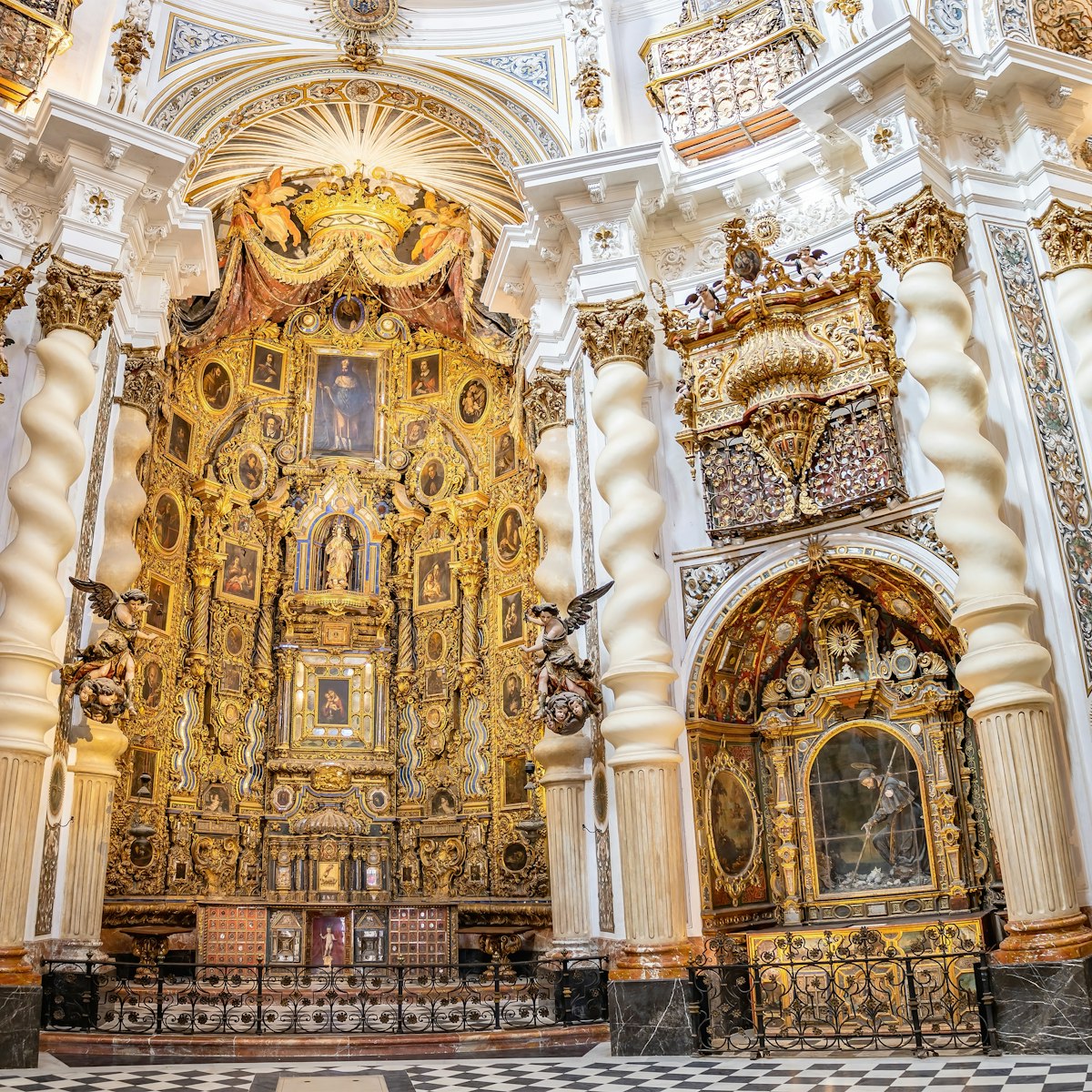
Iglesia de San Luis de los Franceses
The finest example of baroque architecture in Seville, this imposing (and deconsecrated) 18th-century church is a former Jesuit novitiate dedicated to…
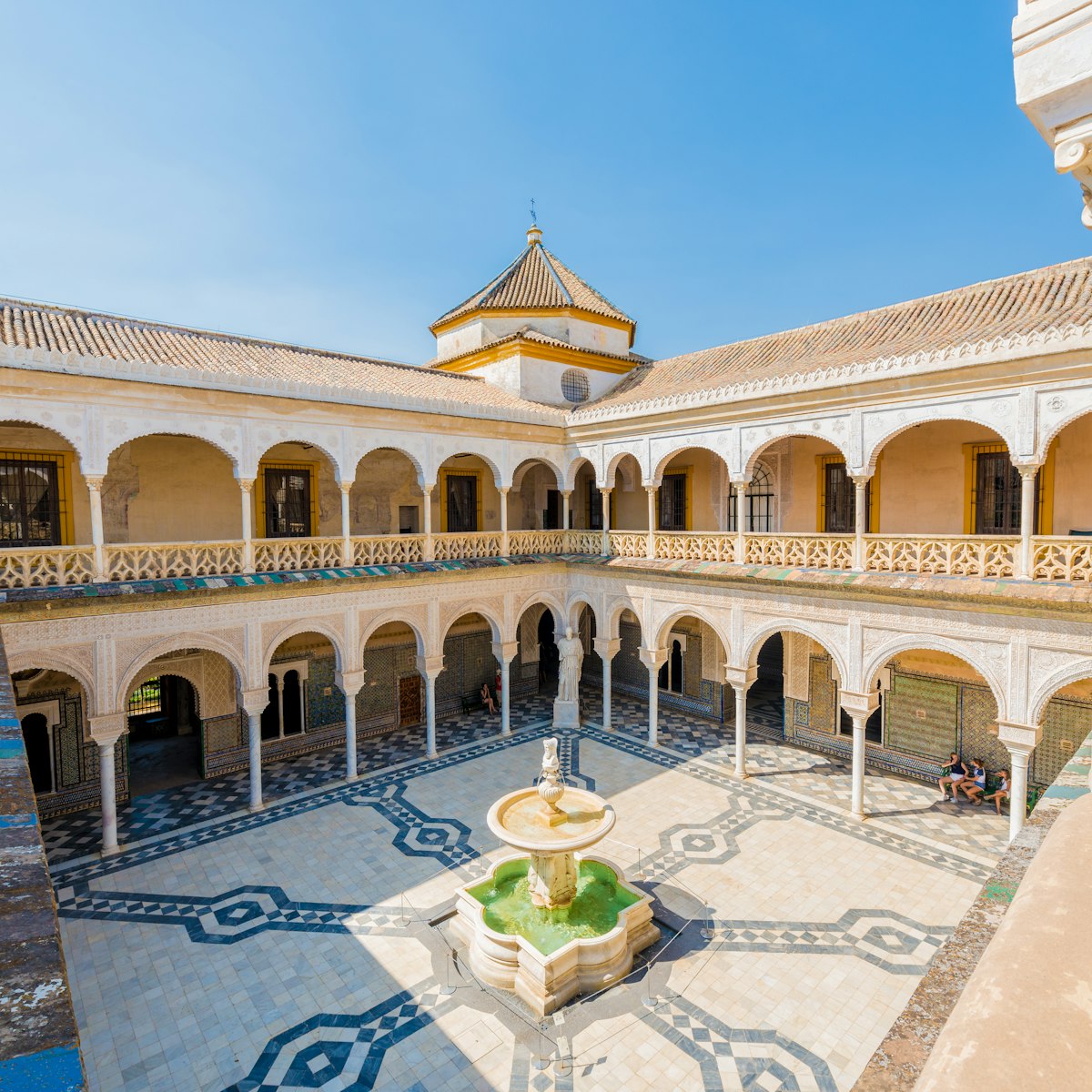
Casa de Pilatos
The haunting Casa de Pilatos, which is still occupied by the ducal Medinaceli family, is one of the city’s most glorious mansions. Originally dating to…
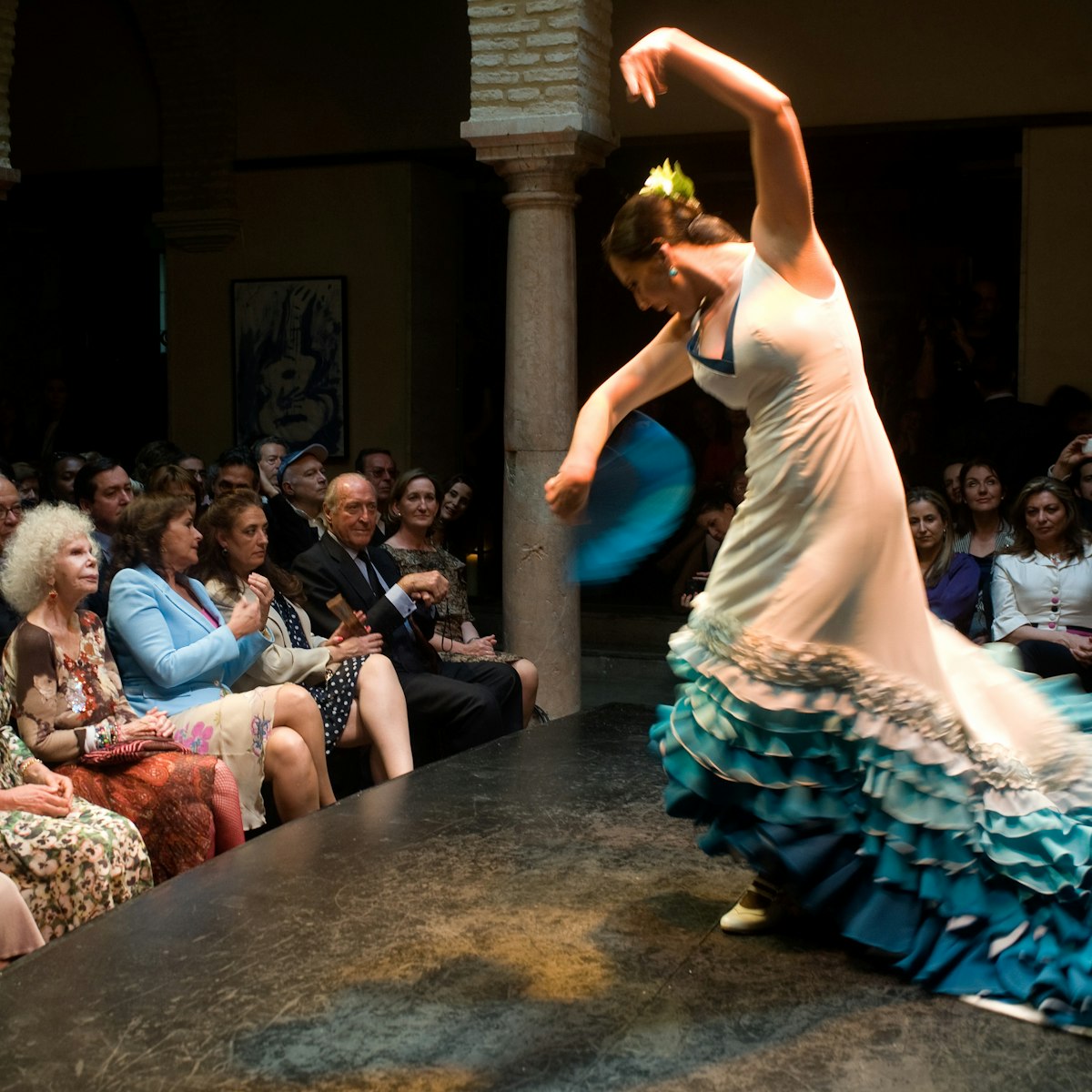
Museo del Baile Flamenco
The brainchild of sevillana flamenco dancer Cristina Hoyos, this museum illustrates the dance with interactive displays, paintings, displays of period…
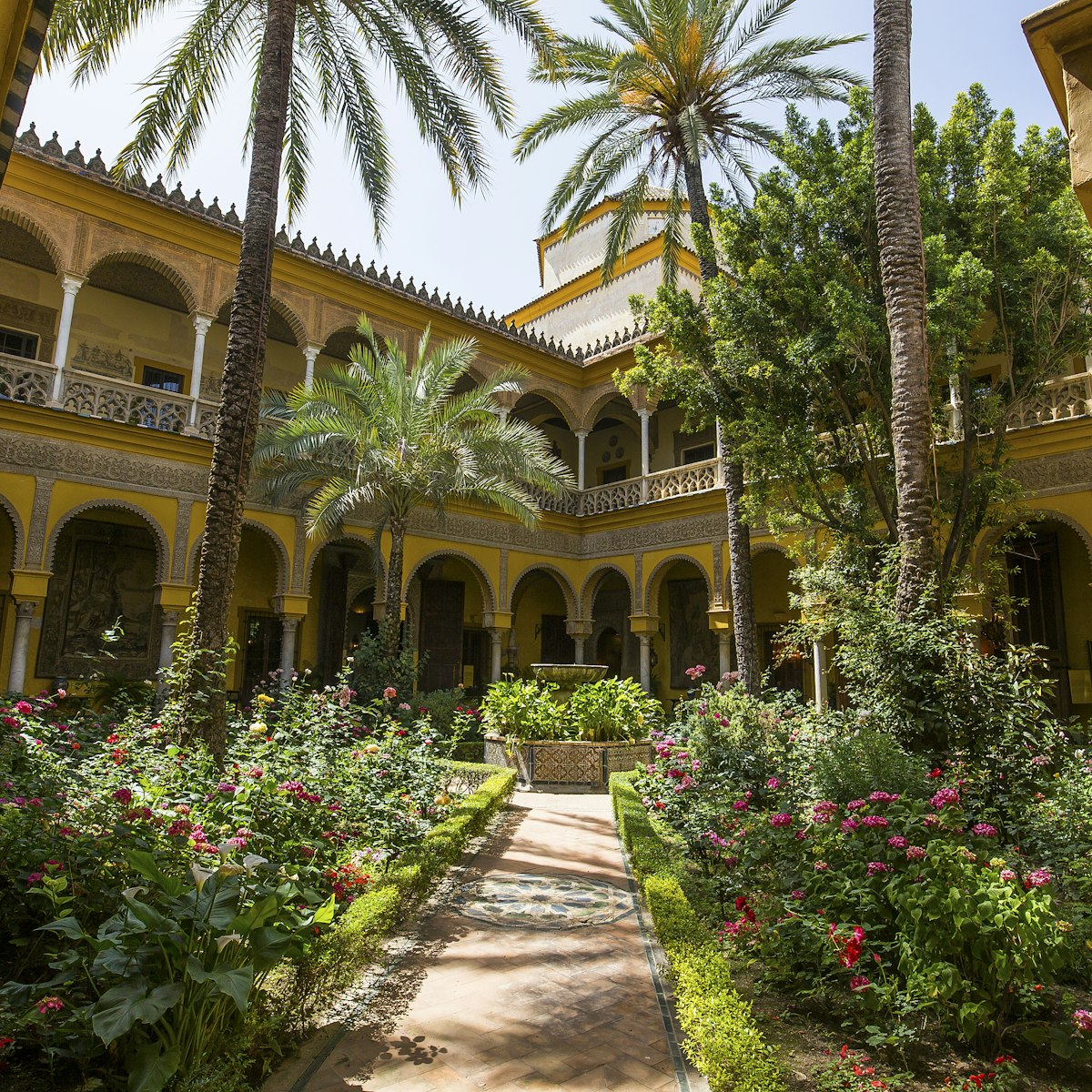
Palacio de Las Dueñas
This gorgeous 15th-century palace was the favourite home of the late Duchess de Alba, one of Spain’s most prominent aristocrats. Renaissance in design, it…

Iglesia Colegial del Divino Salvador
Overlooking Plaza del Salvador, this baroque church was built between 1674 and 1712 on the site of Muslim Ishbiliya's main mosque. Its Mannerist red-brick…
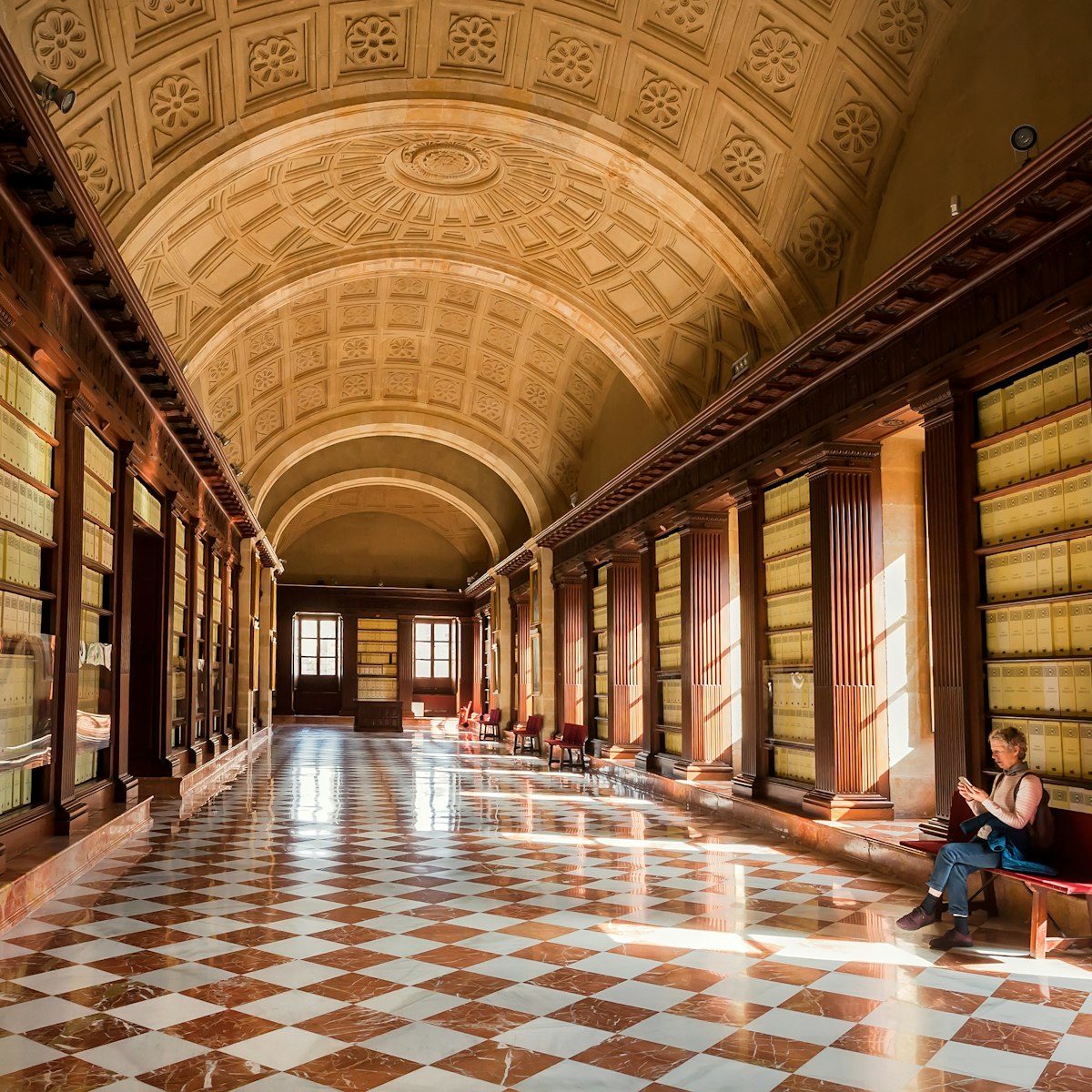
Archivo General de Indias
Occupying a former merchant's exchange on the western side of Plaza del Triunfo, the Archivo General de Indias provides fascinating insight into Spain's…
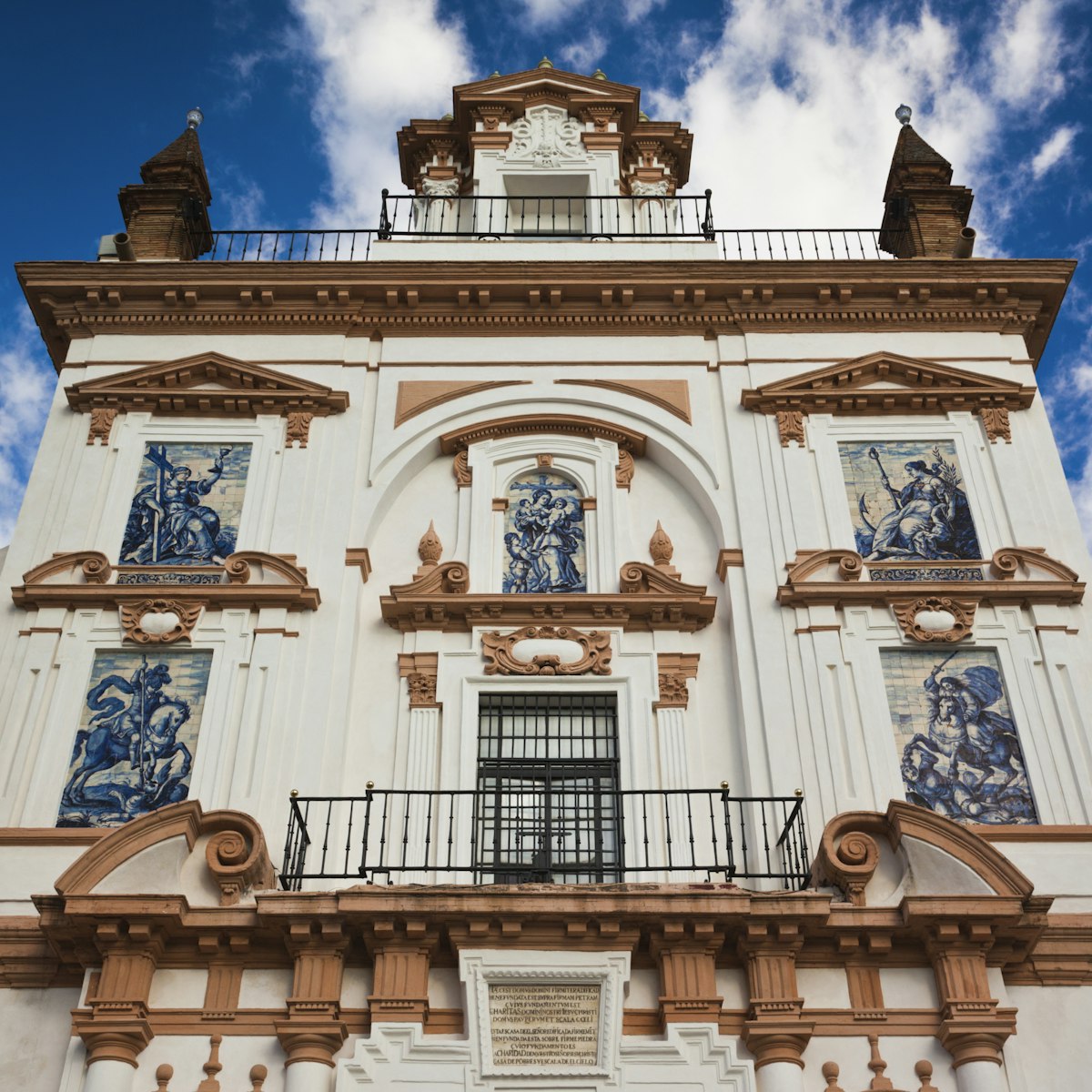
Hospital de la Caridad
The Hospital de la Caridad, a sturdy building one block east of the river, was established in the late 17th century as a hospice for the poor and elderly…
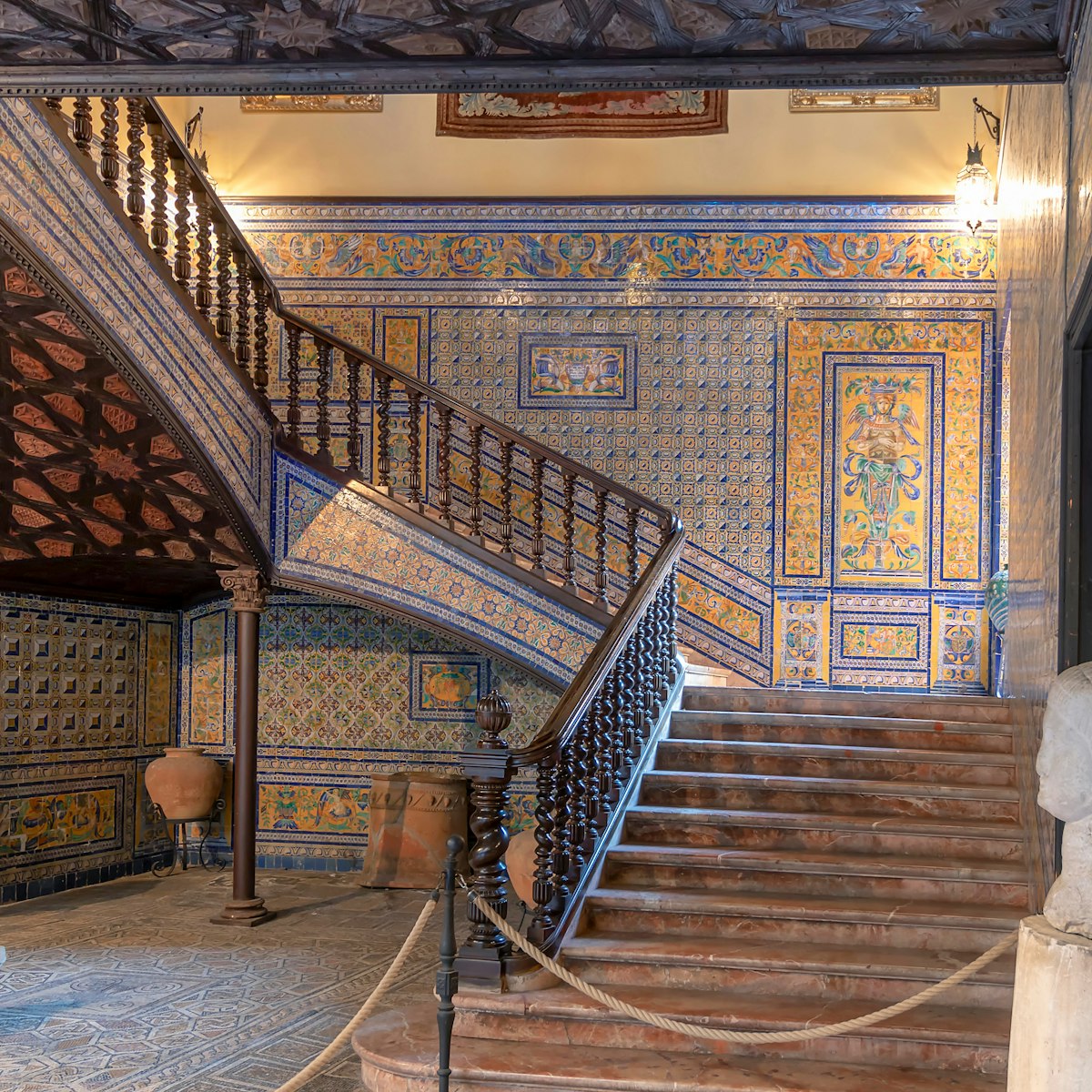
Palacio de la Condesa de Lebrija
This aristocratic 16th-century mansion, set around a beautiful Renaissance-Mudéjar courtyard, boasts an eclectic look that blends a range of decorative…

Basílica de La Macarena
This 20th-century neo-baroque basilica is home to Seville’s most revered religious treasure, the Virgen de la Esperanza Macarena (Macarena Virgin of Hope)…
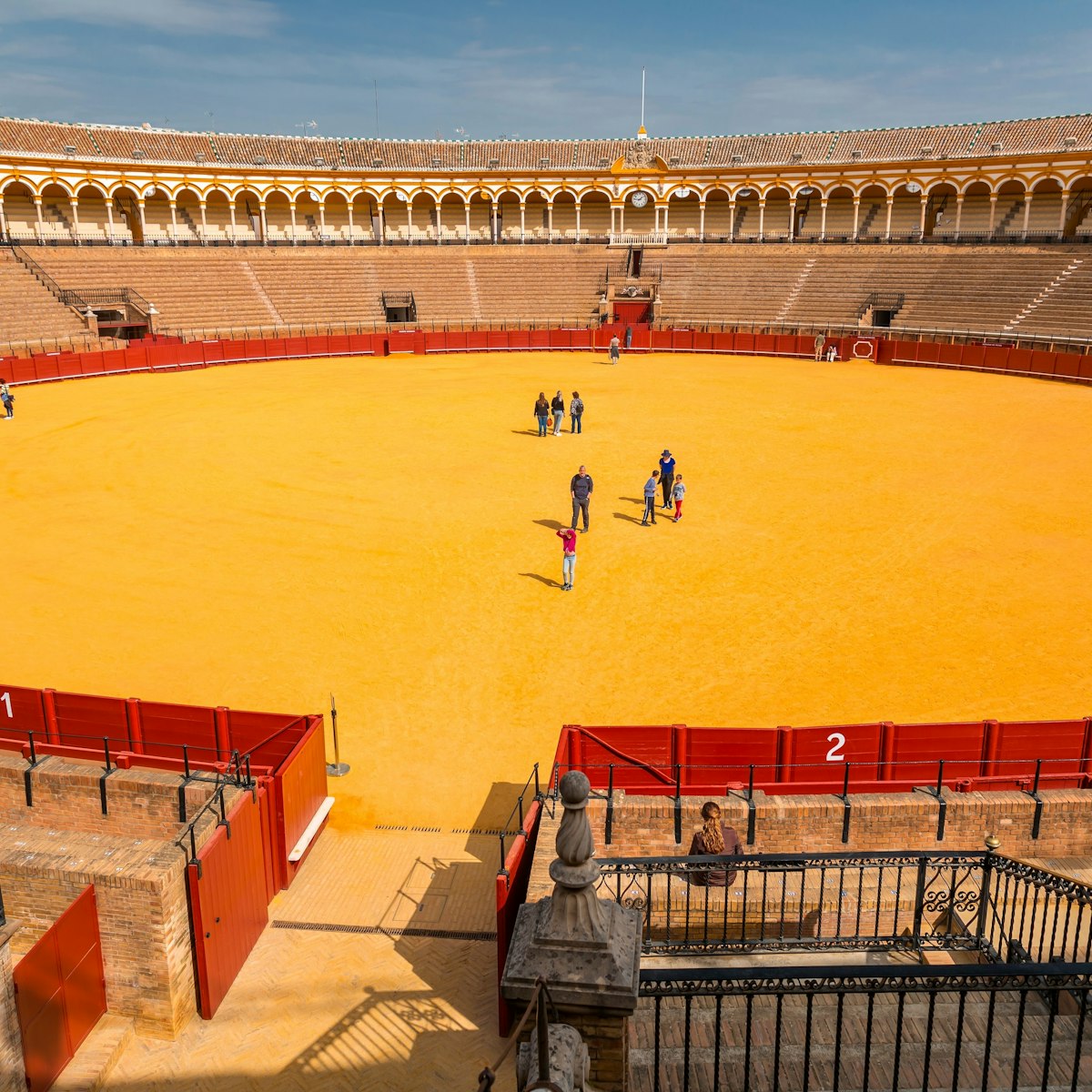
Plaza de Toros de la Real Maestranza
In the world of bullfighting, Seville’s white and yellow-trimmed bullring is the equivalent of football's Old Trafford or Camp Nou

Torre del Oro
This distinctive tower, one of Seville’s signature landmarks, has been guarding the Río Guadalquivir since the 13th century. The original dodecagonal…

Castillo de San Jorge
Adjacent to the Puente de Isabel II, the Castillo de San Jorge is steeped in notoriety: it was here that the infamous Spanish Inquisition had its…
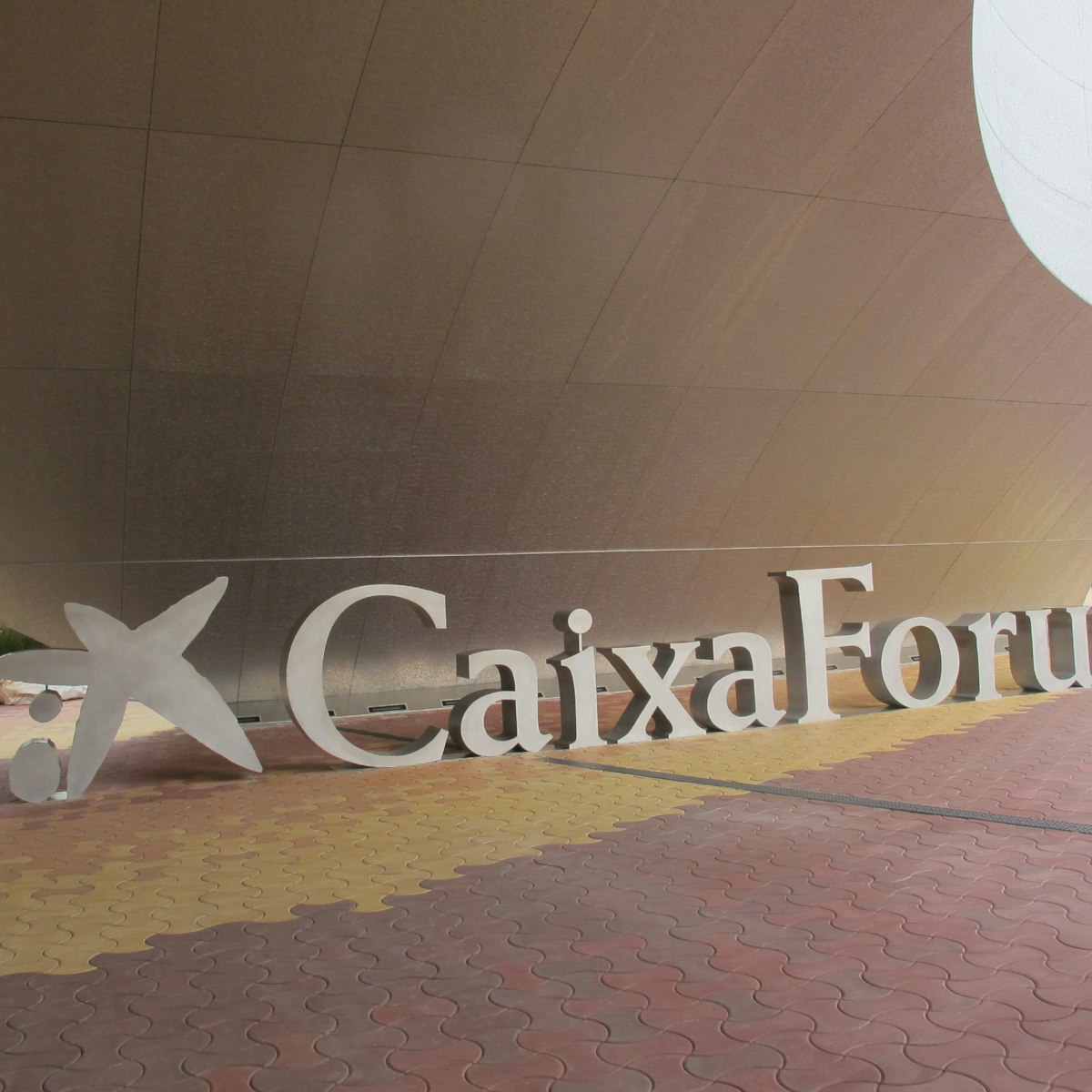
CaixaForum Sevilla
CaixaForum Sevilla is an underground (literally) cultural centre that opened in March 2017. Situated on the Isla de la Cartuja, it's home to two temporary…
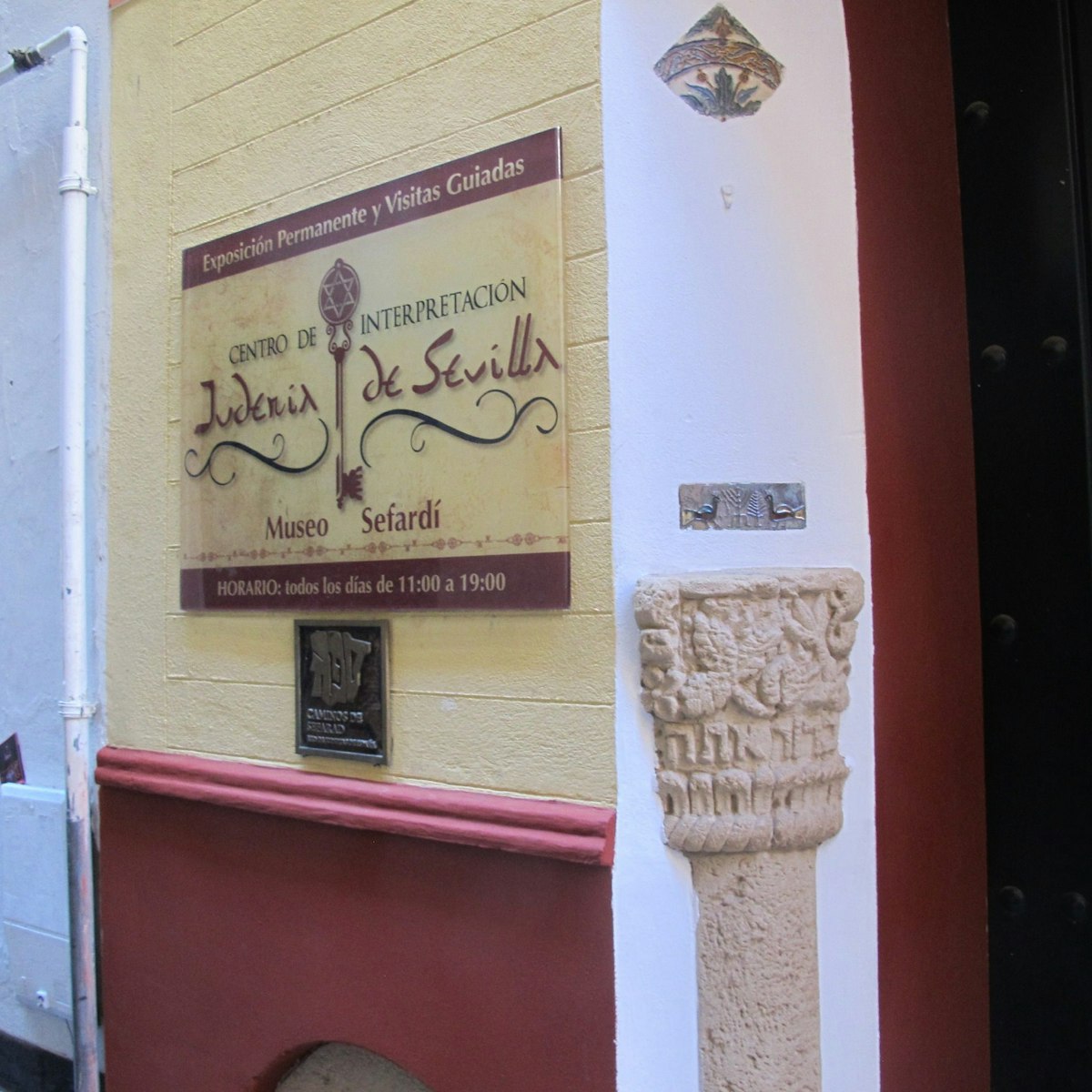
Centro de Interpretación Judería de Sevilla
Dedicated to Seville's Jewish history, this small, poignant museum occupies an old Sephardic house in Santa Cruz , the one-time Jewish neighbourhood that…
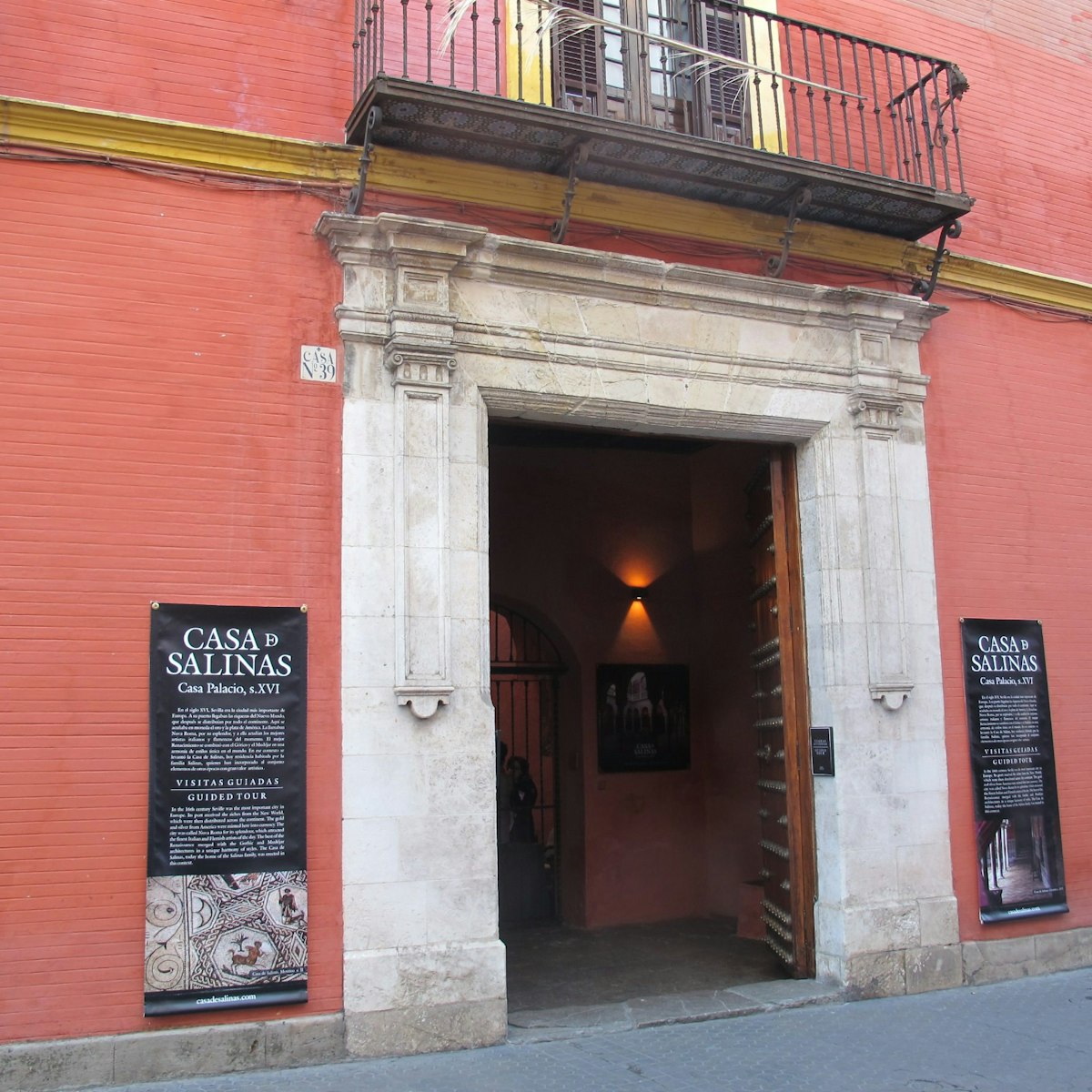
Casa de Salinas
Built during Seville's 16th-century golden age, this Santa Cruz mansion is like a micro-version of the Alcázar, just without the queues. And like several…
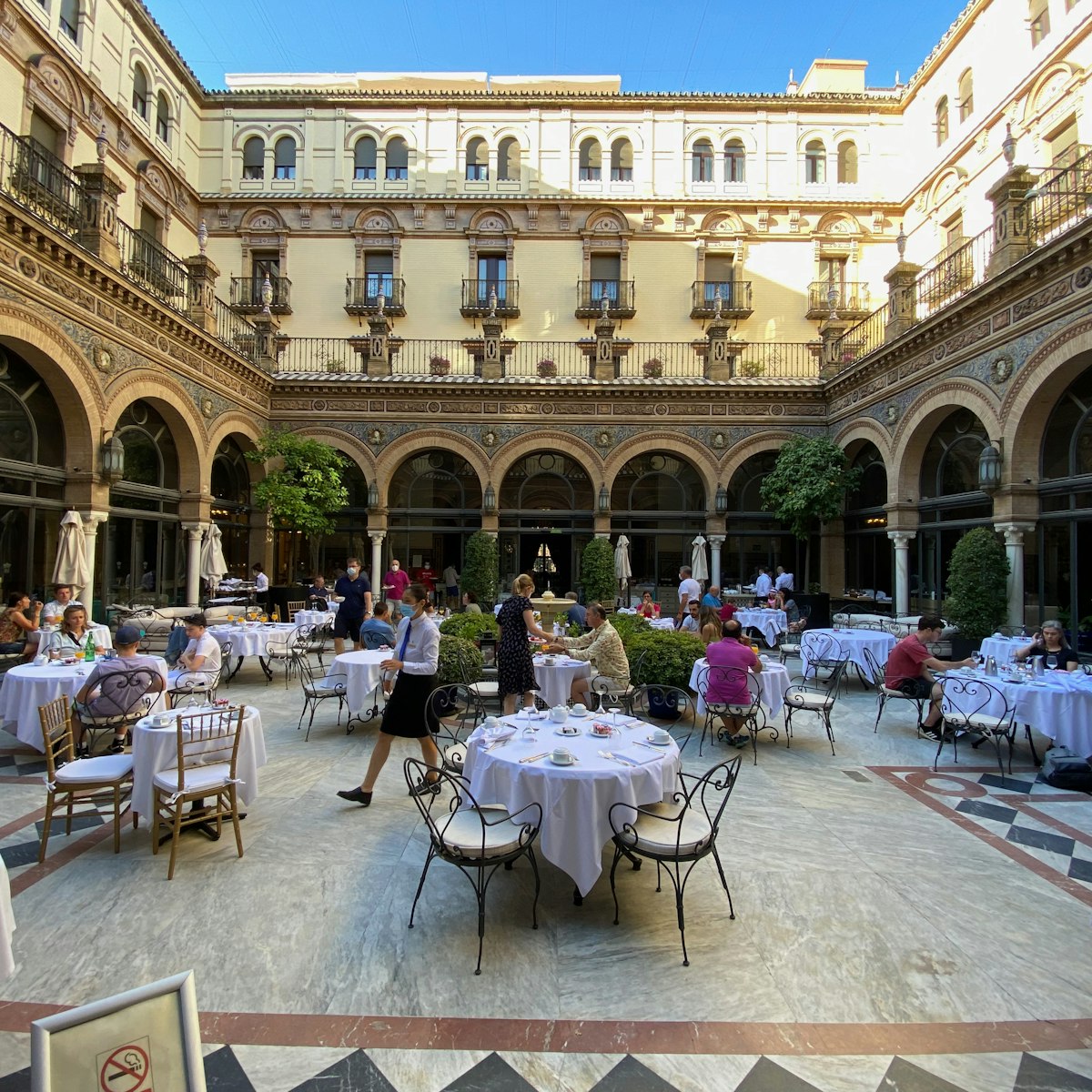
Hotel Alfonso XIII
As much a local landmark as an accommodation option, this striking, only-in-Seville hotel – conceived as the most luxurious in Europe when it was built in…
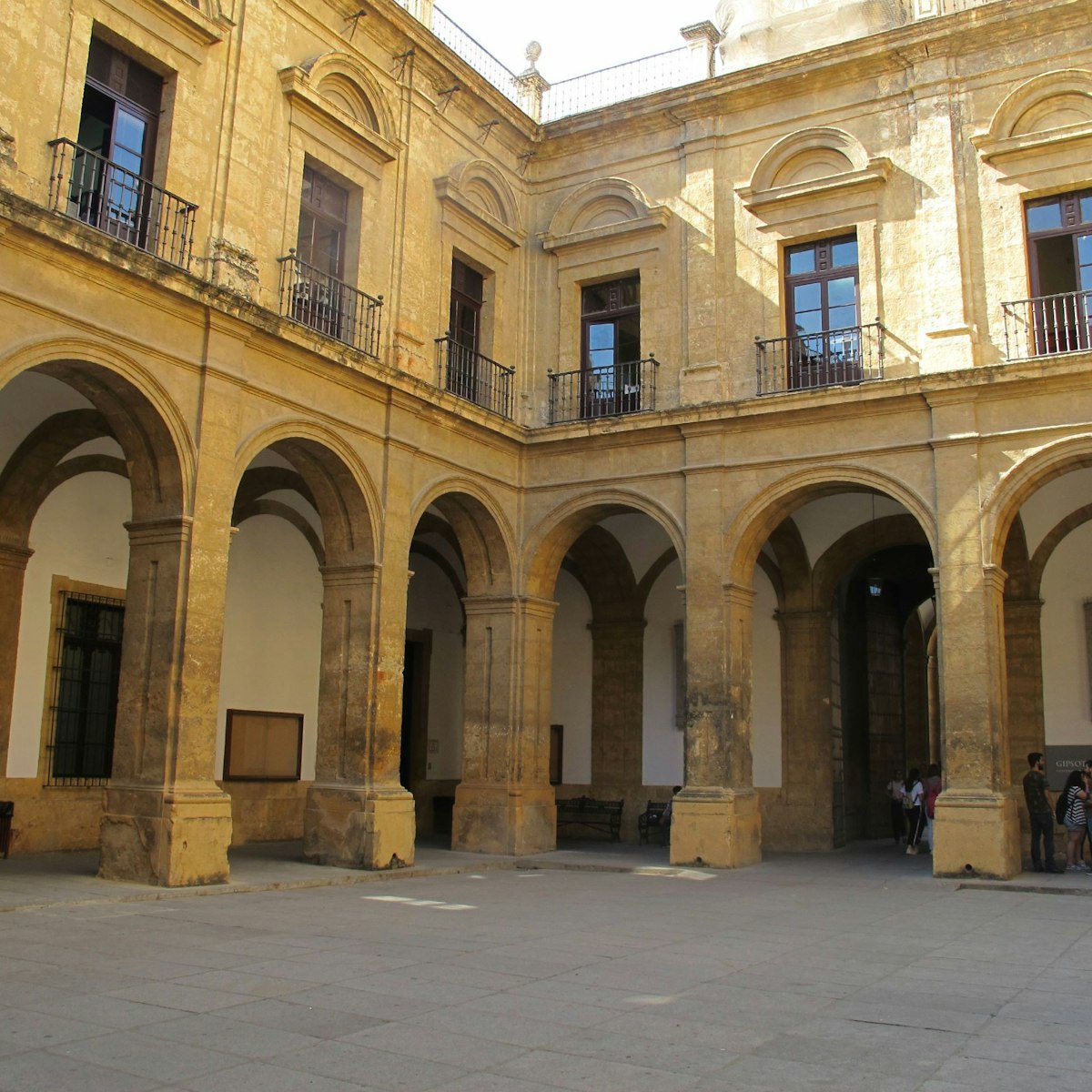
Antigua Fábrica de Tabacos
Now home to the University of Seville, this massive former tobacco factory – workplace of Bizet’s fictional heroine, Carmen – was built in the 18th…
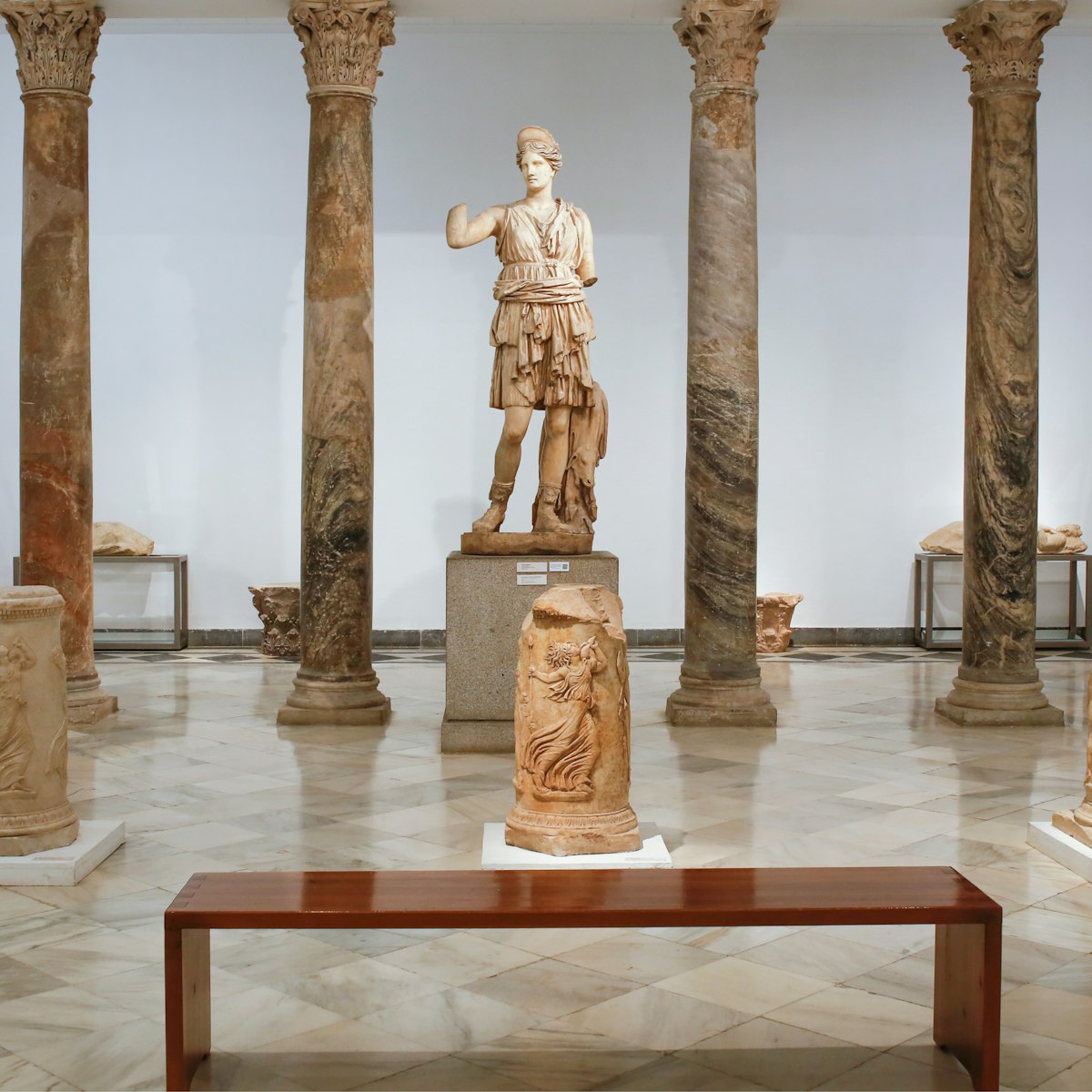
Museo Arqueológico
Seville's archaeology museum, housed in a grandiose, neo-Renaissance palace at the southern end of the Parque de María Luisa, is a wonderful, oft…

Capilla de San José
For a blast of full-on baroque glitz, pop into this small church hidden away on a side street between Calles Sierpes and Tetuán. Behind its 18th-century…
Iglesia de Santa Ana
Known as the Cathedral of Triana, the 13th-century Iglesia de Santa Ana was the first church built in Seville after the 1248 Reconquista. Architecturally,…
Casa Fabiola – Donación Mariano Bellver
Donated to the city by the Bilbaoan art collector Mariano Bellver, and displayed in a Sevillan mansion in Santa Cruz barrio (district), this collection of…
Alameda de Hércules
Flanked by bars, cafes and restaurants, this tree-lined plaza is a hugely popular hangout, frequented by families, tourists and students. It's also the…
Museo Casa de la Ciencia
Housed in the Peruvian Pavilion from the 1929 Expo, complete with carved condors and llamas, this excellent, hands-on science museum has several permanent…
Ayuntamiento
Sandwiched between Plaza de San Francisco and Plaza Nueva is Seville's striking city hall, the Ayuntamiento. In its original form, the building dates to…
Isla Mágica
This Disney-does-Spanish-colonial amusement park provides an action-packed day out for kids and thrill seekers with an array of white-knuckle rides, shows…
Parroquia de Santa María Magdalena
Behind a fairly unobtrusive exterior, this historic late 17th-century church opens to reveal an enormous baroque interior capped by an octagonal cupola…
Centro Cerámica Triana
Housed in a former tile factory, this small museum provides a fascinating introduction to Triana and its industrial past. Exhibits, which include brick…
Plaza del Salvador
This plaza, a popular early evening drinking hang-out, was once the forum of the ancient Roman city of Hispalis. It's dominated by the Iglesia Colegial…
Calle Sierpes
Pedestrianised Calle Sierpes, heading north from Plaza de San Francisco, and the parallel Calle Tetuán/Velázquez form the heart of Seville's main shopping…
Plaza de San Francisco
Plaza de San Francisco has been Seville's main public square since the 16th century. Forming its western flank is the city's historic city hall, the…
Torre Mirador
Originally built as an observation tower for the 1992 Expo, the 50m-high Torre Schindler is now part of the Pabellón de la Navegación museum. Elevators…
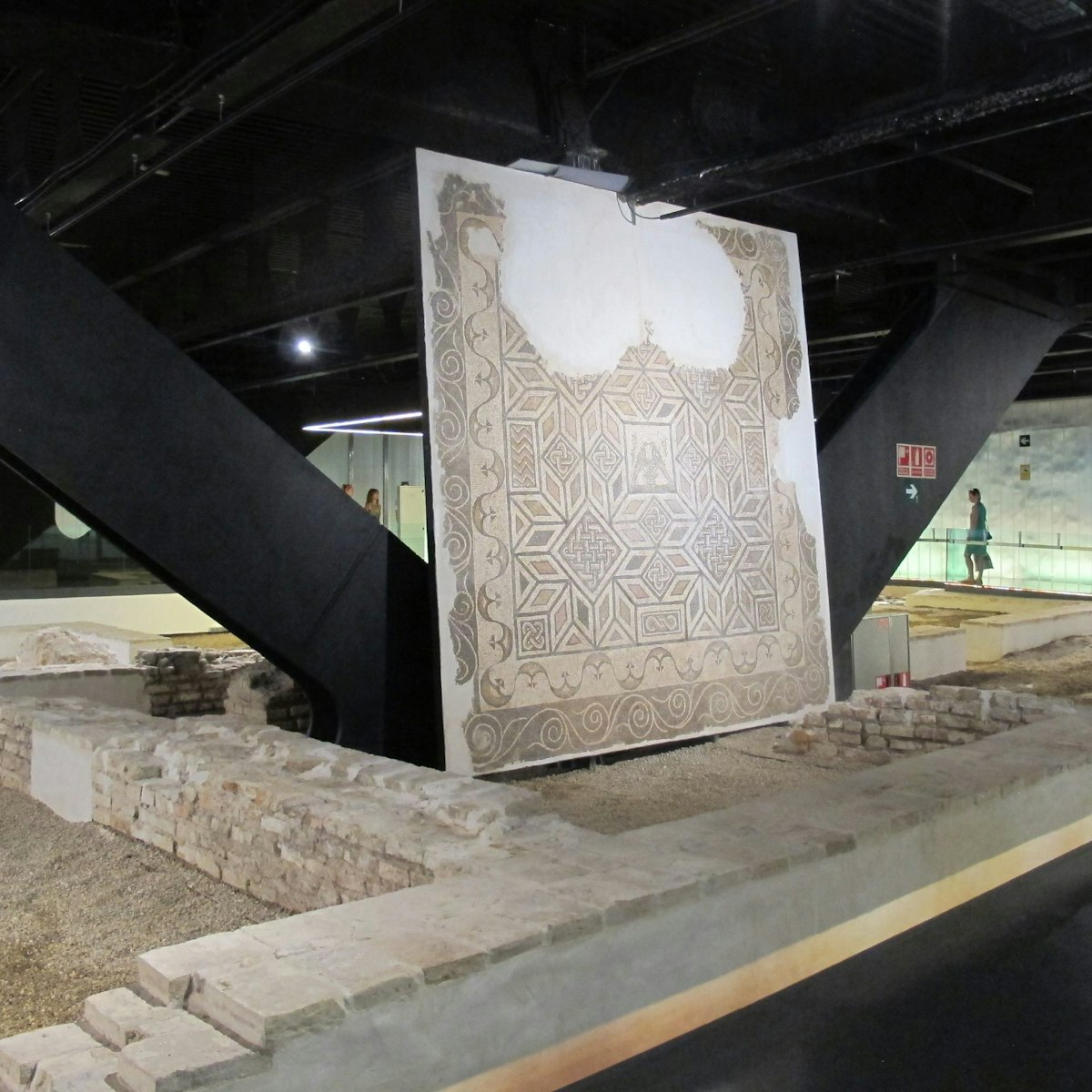
Museo Antiquarium
Housed in the basement of the Metropol Parasol, this small museum showcases the ancient finds that were unearthed during excavation of the plaza. Raised…
- Travel to Spain Landmarks
10 Iconic Landmarks in Seville and Must-Visit Attractions

Win a FREE Trip to Spain!
Exciting Announcement! For the first time, we're thrilled to offer exclusive trips to the heart of Spain - an experience like no other. This isn't your typical tourist journey; it's a unique opportunity to immerse yourself in authentic Spanish culture, alongside real locals and our passionate team.
But there's more! Simply by requesting information about this amazing trip, you'll be entered into a special draw to win a Fully Paid Trip to Spain for Two. And that's not all - everyone who inquires will receive an exclusive bonus gift, valued at $500, available only now.
Click Here ↑ to Request Information & Enter the Draw!
Seville is a destination that steals your heart as soon as you arrive. It preserves the country’s most famous traditions, such as flamenco, cheerful people, and picturesque landscapes, receiving multiple visitors yearly.
It is also home to an attractive mix of Moorish, Christian, and Jewish architecture and history. In this article, I bring you the best landmarks worth visiting if you come to Seville and the main sights and attractions you can’t miss for an unforgettable experience.
Among the most outstanding and emblematic places are the historic city center with Moorish influences, palaces, cathedrals, towers, parks, and many other vital visits you should plan to visit.
Get ready to immerse in the Sevillian culture!
If you are also looking for itineraries, we have created 11 itineraries for you to travel Spain! Click to get a planned trip (all free)!
- 1 Day in Spain
- 2 Days in Spain
- 3 Days in Spain
- 4 Days in Spain
- 5 Days in Spain
- 6 Days in Spain
- 7 Days in Spain
- 8 Days in Spain
- 10 Days in Spain
- 2 Weeks in Spain
Table of Contents ▼ ▶
1. Royal Alcázar of Seville
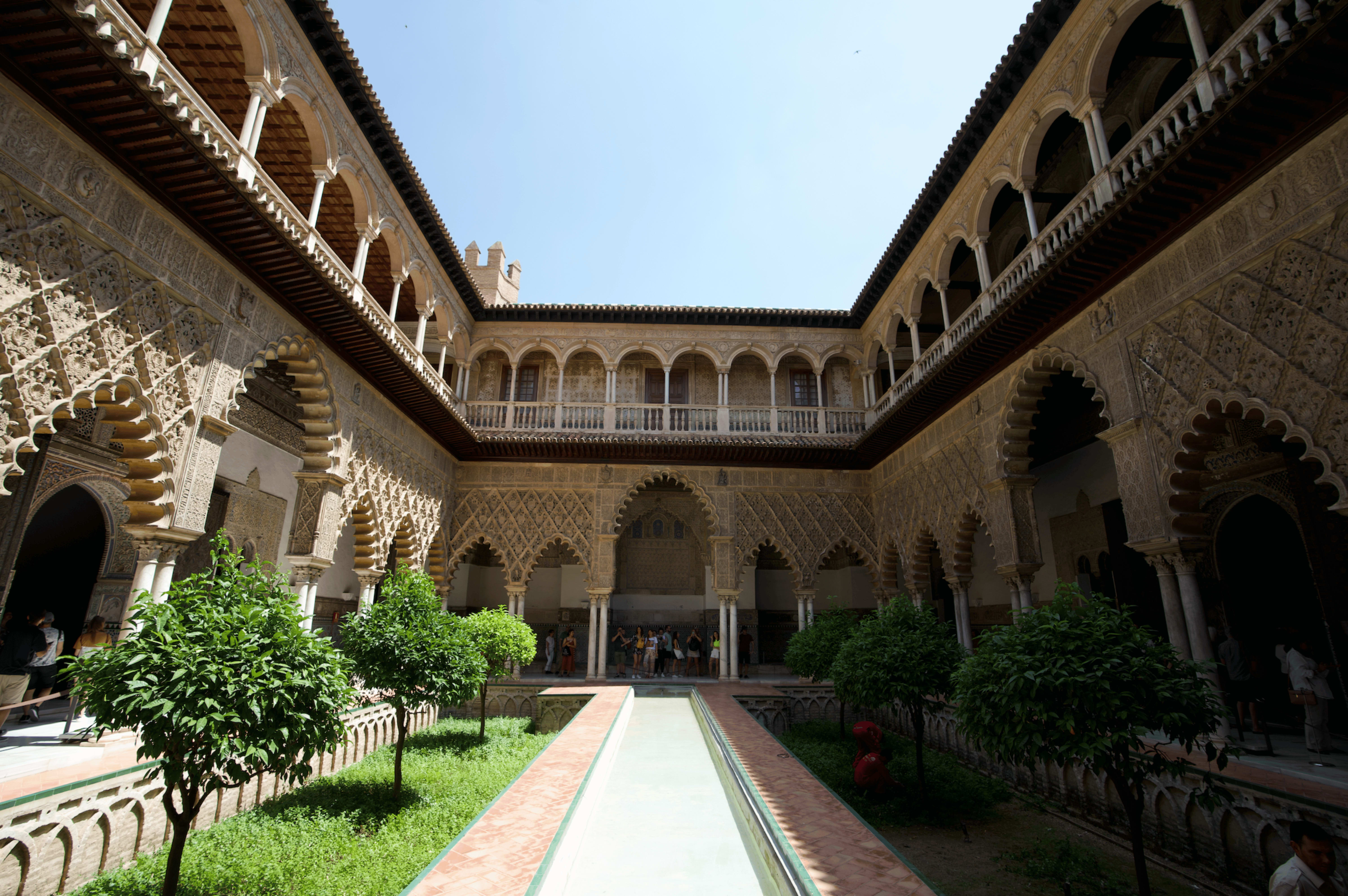
📍Patio de Banderas, s/n, 41004 Sevilla
The Alcázar of Seville comprises the entire history of Seville for more than a thousand years. It is one of the oldest royal palaces in use in the world and was built on ancient Roman and Visigothic buildings in 913 as a royal residence and defensive construction.
It was declared a World Heritage Site by Unesco since it is a fantastic setting to appreciate the mix of culture, architectural sites, and beautiful gardens.
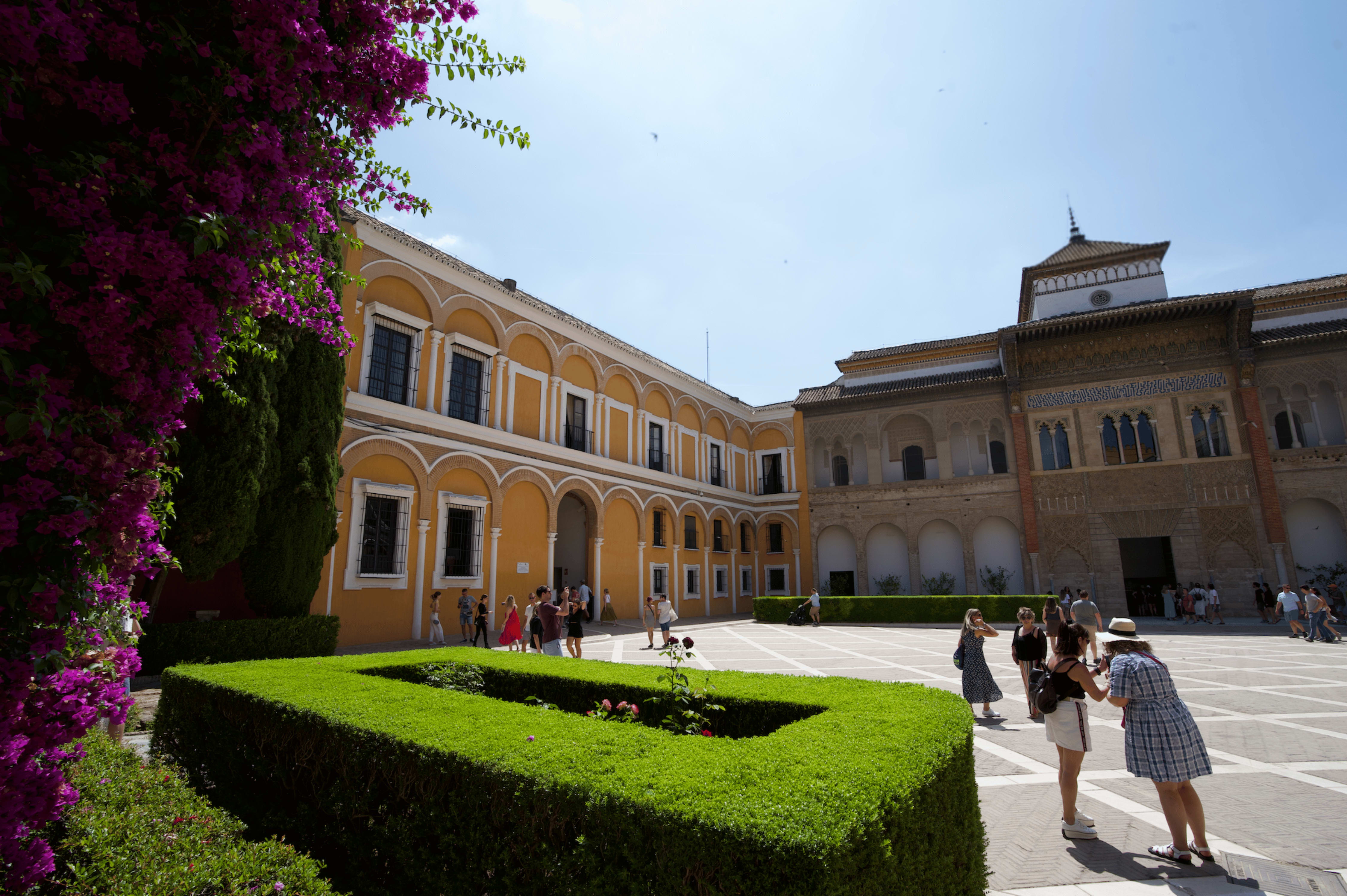
In case you didn’t know, Muslim Spain refers to a period in history when Spain depended on Muslims from 711 to 1492.
This way, the Alcázar brings together elements of Muslim, Gothic, Renaissance, Baroque, and Romantic art, as well as some of the best examples of the Mudéjar style , a product of the mixture of Islamic cultures, including Christianity.
The visit lasts at least 2 hours , although it is advisable to reserve about 3 hours. The best time to go is first in the morning to avoid queues. Be there 30 minutes before opening (see below) and purchase in advance the tickets online. This way, you’ll save lots of time. Especially if you’re on a tight itinerary.
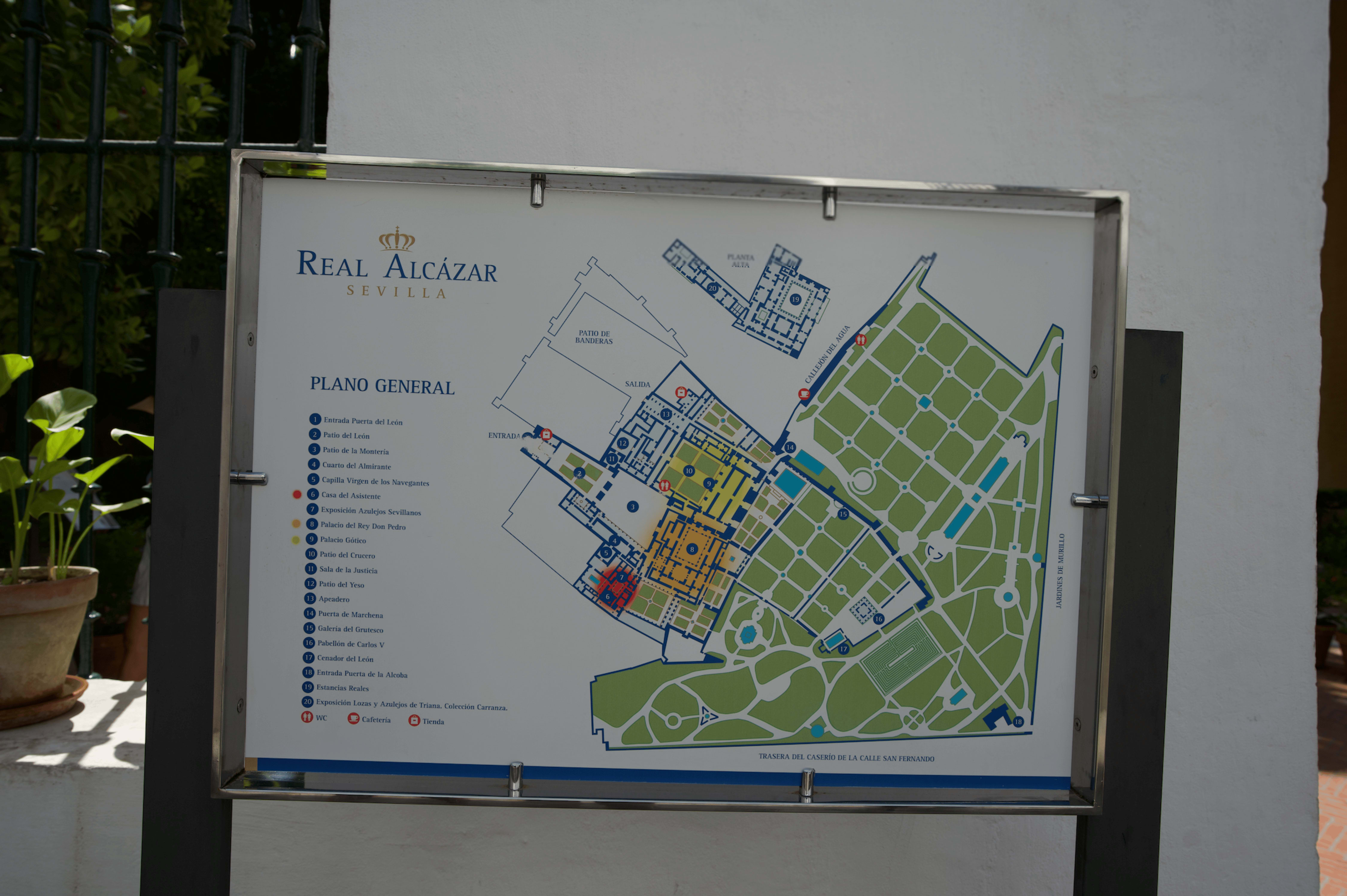
A must-visit landmark to appreciate what I am telling you firsthand. In this fortress, kings, nobles, and notable characters have lived and shaped the history of Seville and Spain!
📅 Opening Times: From 9:30 am to 5:00 pm.
🎟️ Entrance Fees:
- General admission to the ground floor: €13.50
- Admission to the ground floor for EU citizens, seniors over 65 years old, students from 14 to 30 years, or holders of the European Youth Card: €6.00 (valid identification must be presented at the ticket office)
- Admission to visit the Royal Bedroom: €5.50
- Admission for disabled persons, children younger than 13 years old, and residents of the city of Seville: Free (valid identification must be presented at the ticket office)
The entrance is free on Monday afternoons!
👉🏻 Official Website
2. Catedral de Sevilla
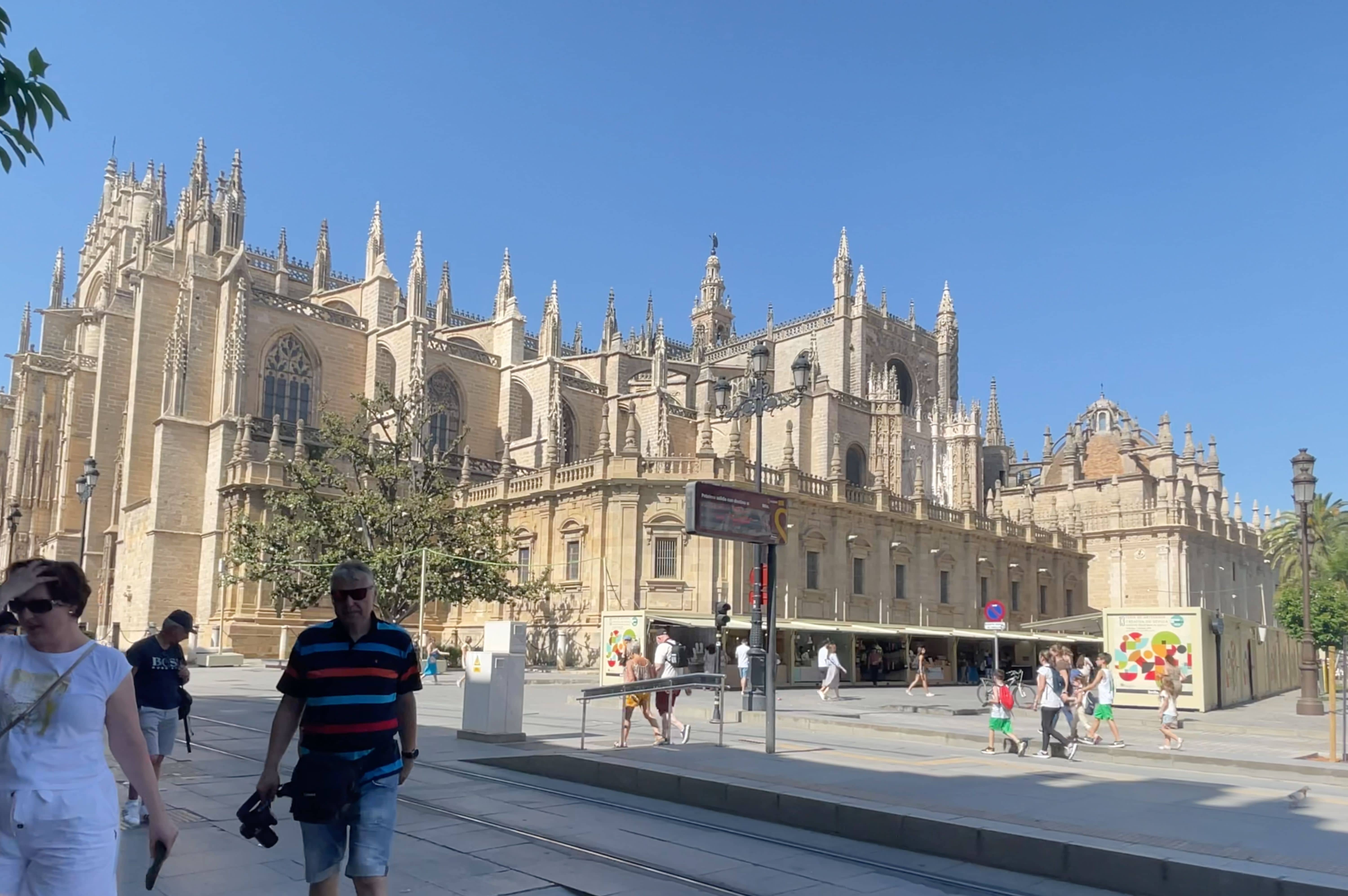
📍Av. de la Constitución, s/n, 41004 Sevilla
The iconic Catedral de Sevilla is the world’s largest Gothic temple and the third in size after St. Peter’s Basilica in the Vatican in Rome and St. Paul’s in London.
It is one of the city’s most tourist points and receives more than millions of visitors annually. In other words, thousands of people walk through its doors daily to experience this incredible historical landmark. It was declared a World Heritage Site by UNESCO in 1987.
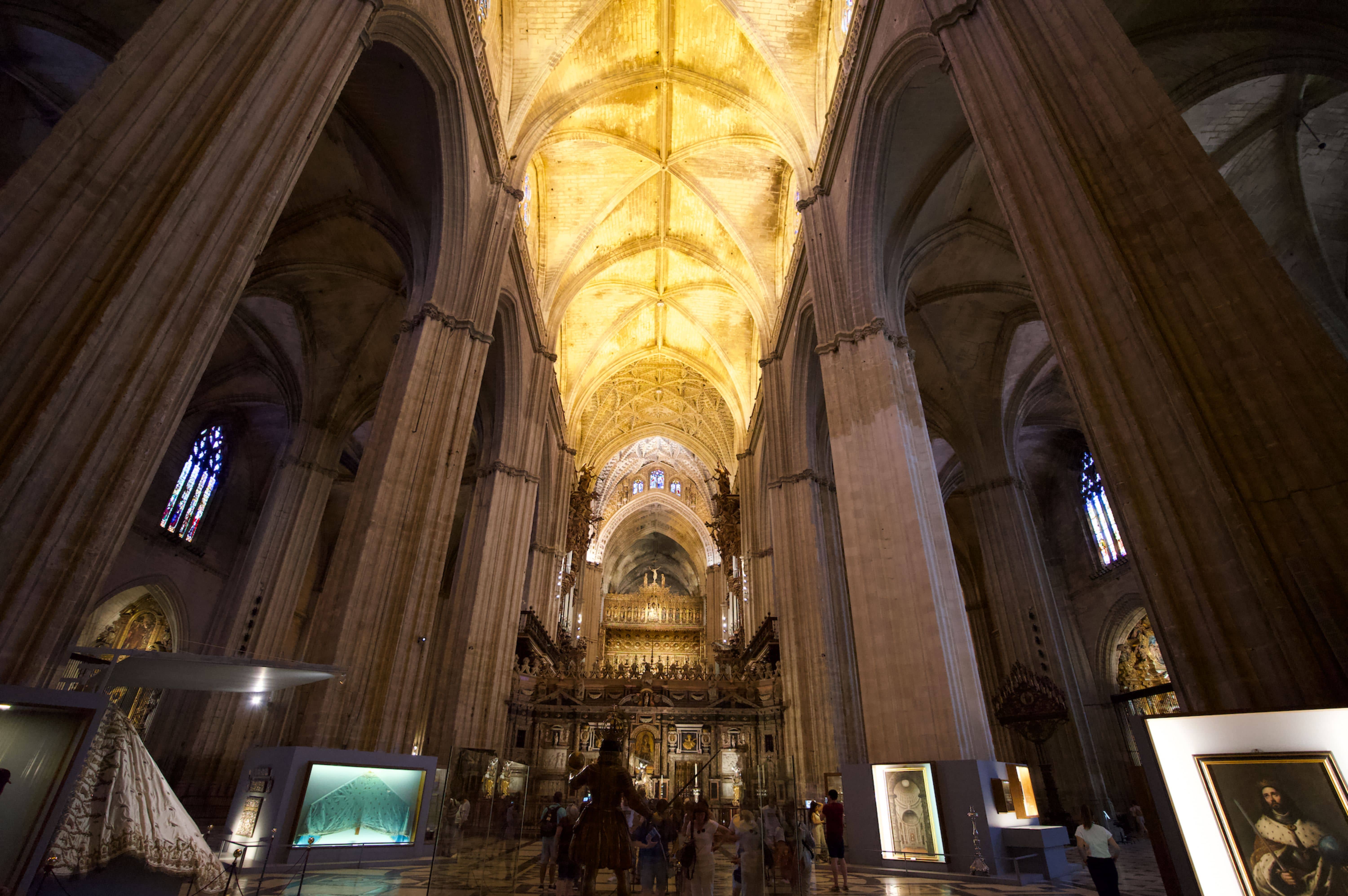
Since the conquest of Seville in 1248, the old Almohad mosque was used as a cathedral. Its construction began in 1403 after the demolition of the Muslim building. Its works date back to the 16th century when the dome was closed in 1507.
The current one is the work of Gil de Hontañón after the collapse of the first in 1511.
Write this down because you won’t want to miss these sights inside the Cathedral:
- The Giralda.
- The Chapter House.
- The Greater Sacristy.
- The Main Altar.
- The Patio de los Naranjos (which is not free to enter).
- The tomb of Christopher Columbus, who discovered America.
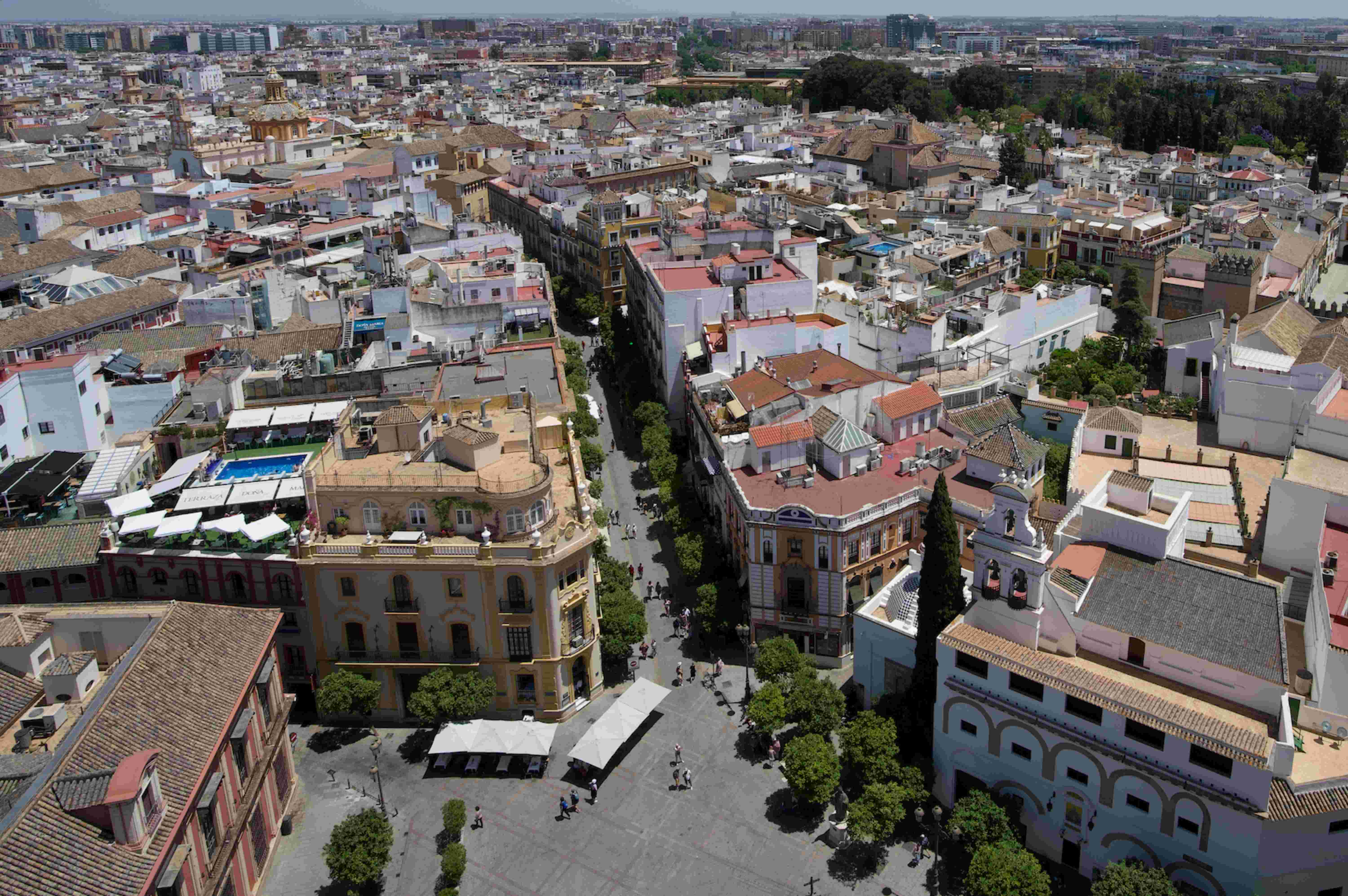
Also, it is essential to highlight that the Seville Cathedral is the scene of numerous traditions throughout the year . Some of the best-known are the Dance of the Sixes, Saint Ferdinand’s Day, the Virgin of the Kings, and the famous Corpus Christi! To read more about Holidays in Seville, see the following article:
List of Public Holidays in Mallorca (2023 and 2024 calendar)
📅 Opening Times:
- From 11:00 am to 15:30 pm on Mondays.
- From 11:00 am to 5:00 pm: Tuesday to Saturday.
- From 2:30 pm to 6:00 pm on Sundays.
- Closed on: January 1, January 6, and December 25.
- Reduced hours: from 11:00 am to 1:00 pm on January 5 and December 24 and 31.
- Regular Tickets: 8 €(including audio guide)
- Guided Tour: 15 €
- Reduced ticket: 5 € ( pensioners and groups 10+)
- Students and Cultural Associations: 4€
- <18 years old: 2.50 €
Free: Mondays, 15:30 to 19:30, for children under 7.
3. Plaza de España
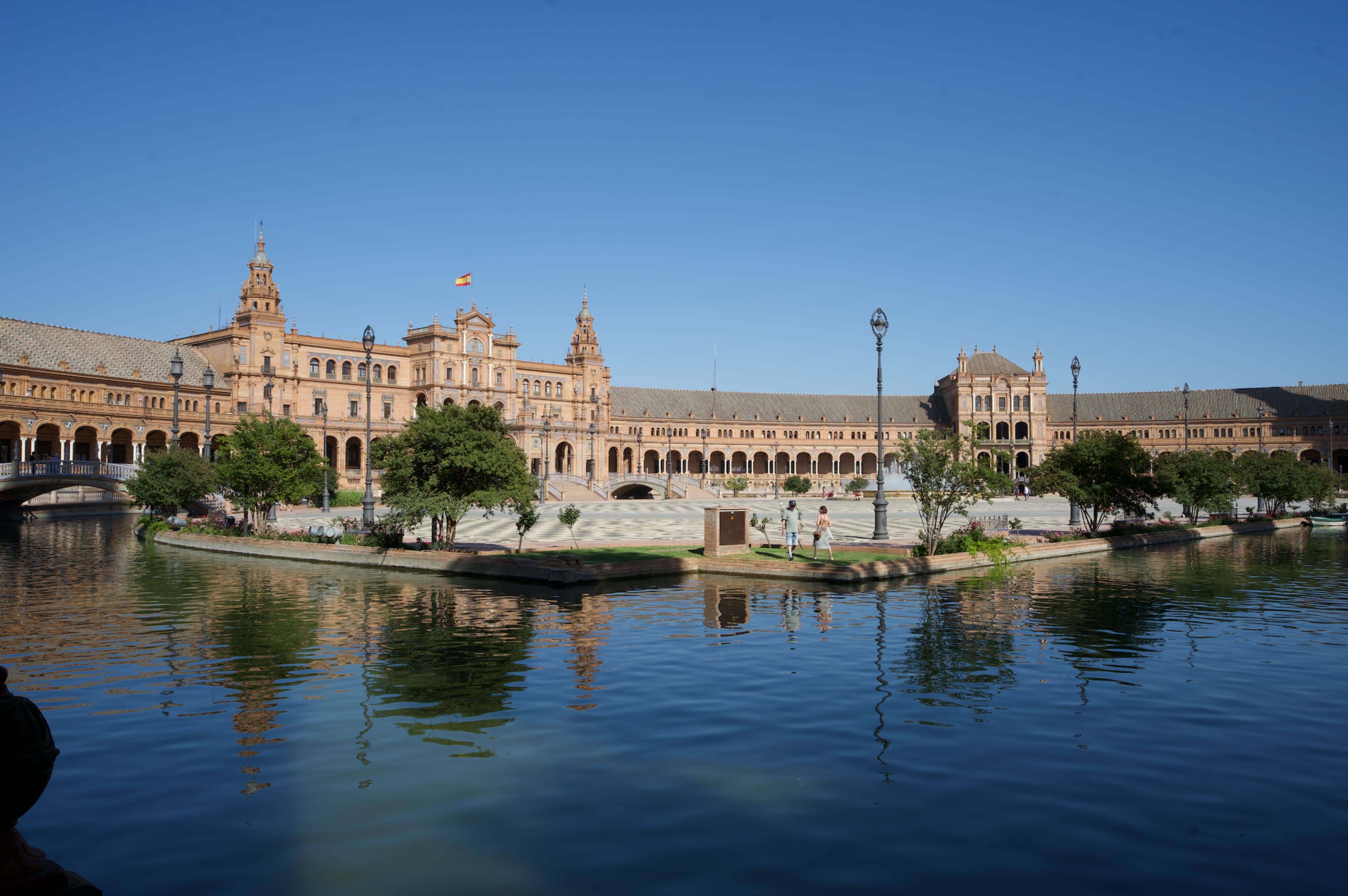
📍Plaza de España, s/n. 41013 Sevilla
If you’re in Seville, you can’t miss visiting the spectacular Plaza de España, among the most important squares in Spain and an authentic jewel of regionalist architecture designed by Aníbal González.
The square was built for the Ibero-American exhibition of 1929 , inaugurated by His Majesty King Alfonso XIII.
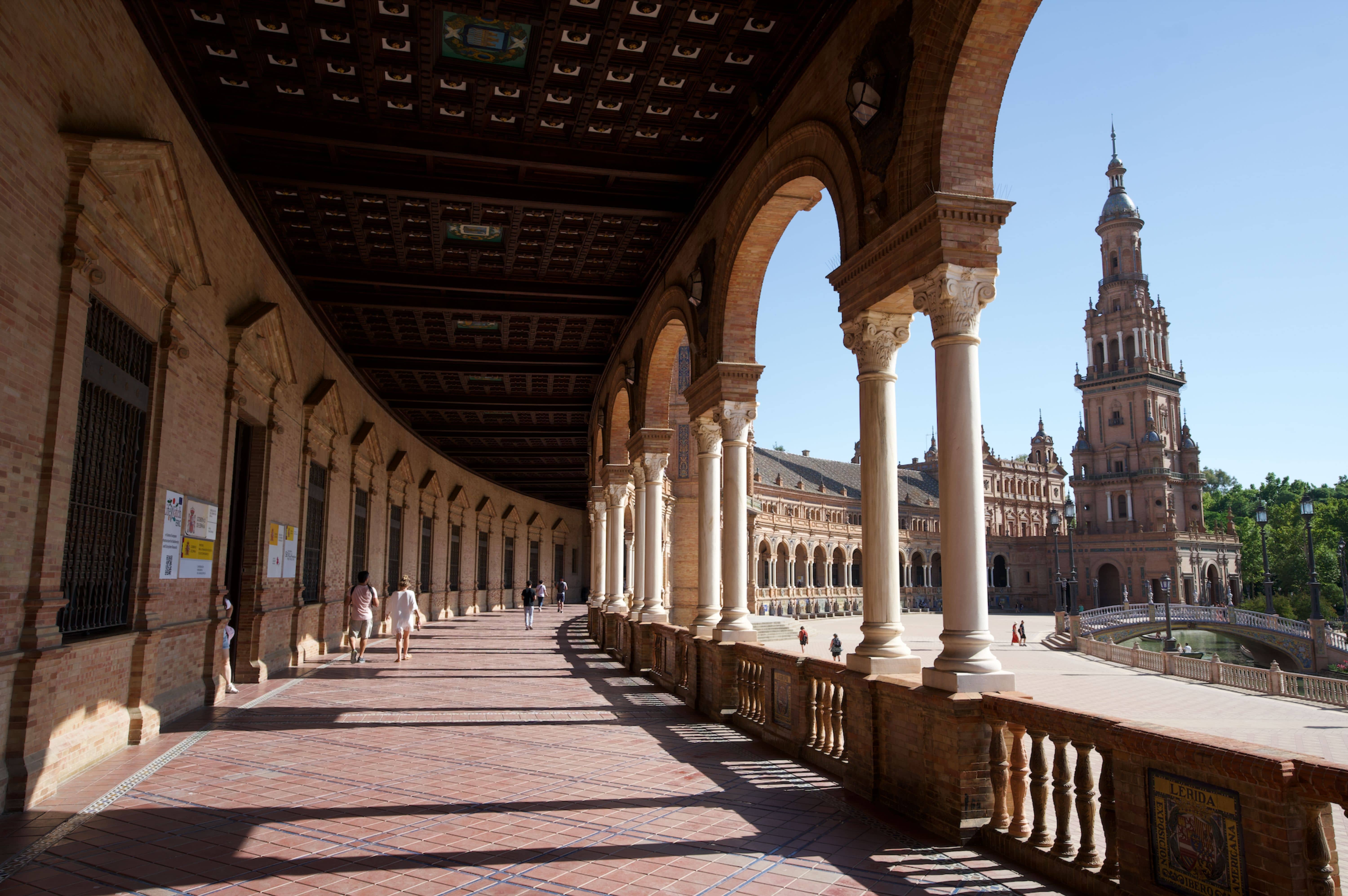
It has a beautiful Renaissance style mixed with the typical elements of the city and a Baroque touch in its towers.
It is a large square of 170 meters in diameter with a semi-elliptical shape, symbolizing Spain’s hug to its former American territories. Also, it looks out over the Guadalquivir River as a route toward America.
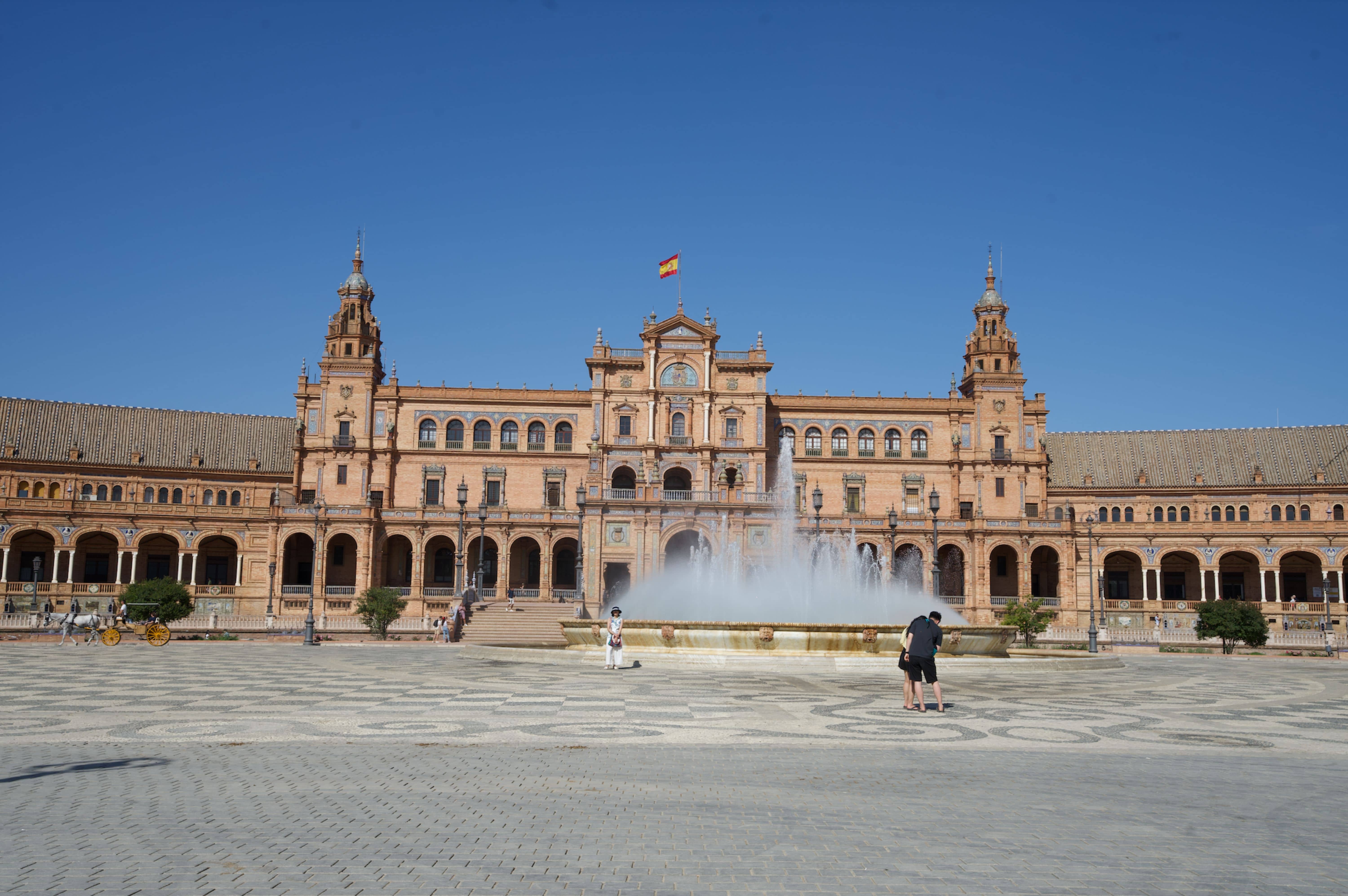
Walking through the Plaza is a delight since each corner is unique. You’ll get lost in every detail while admiring the contrasts between the water and the stone.
In addition to exploring the square on foot, renting a small boat to row through the canal is also possible, as taking a romantic horse-drawn carriage ride. (which is a must, by the way!)
The central building celebrates Spain as a whole since a ll the provinces of Spain are represented on its benches and on its walls. Moreover, access to the building is via four bridges that cross the canal, representing one of the four ancient kingdoms of Spain: León, Castilla, Aragón, and Navarra.
📅 Opening Times: Free Access
🎟️ Entrance Fees: Free Access
4. Setas de Sevilla
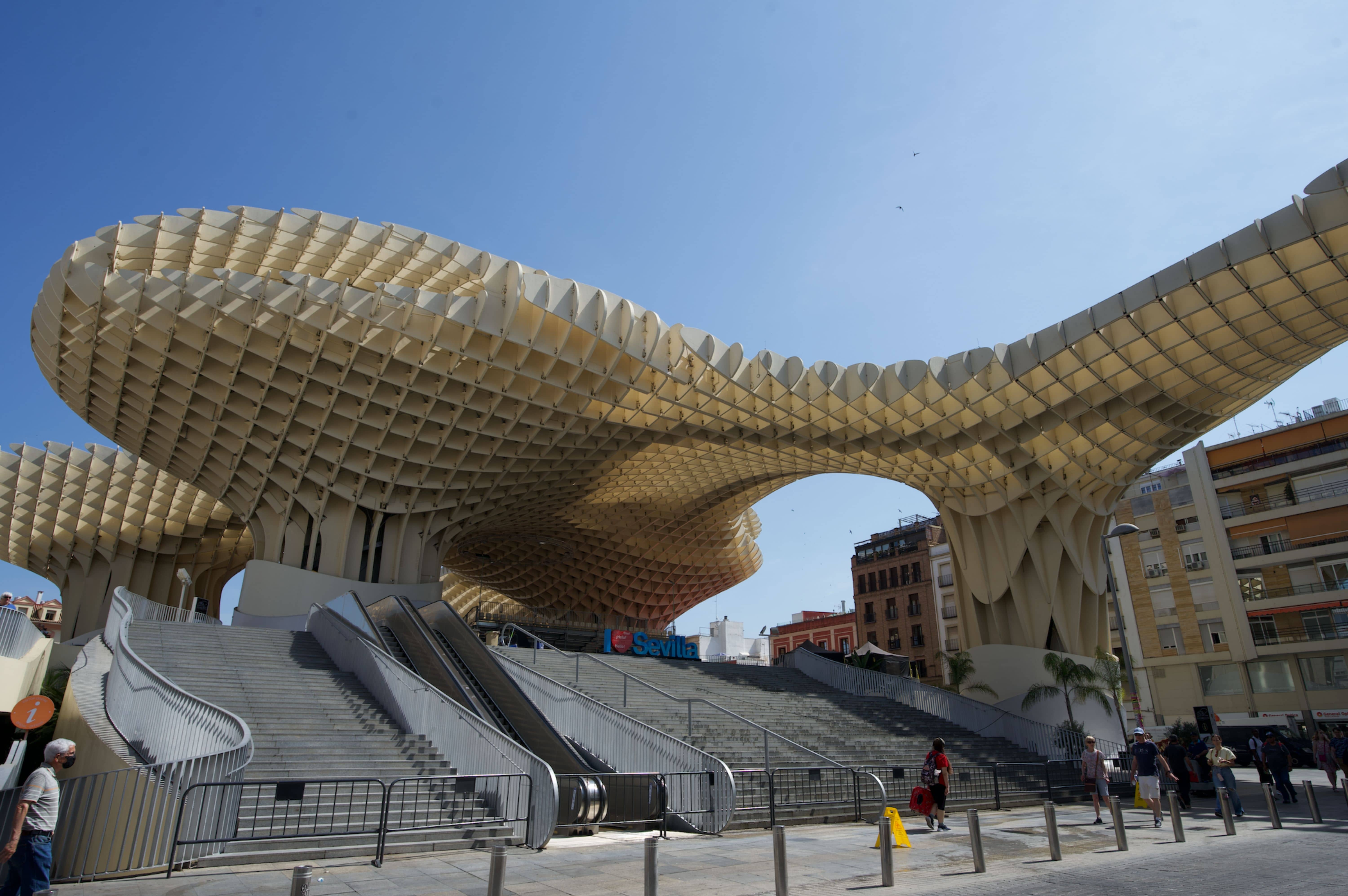
📍Pl. de la Encarnación, s/n, 41003 Sevilla
Giant mushrooms in the middle of Seville? Yes. In case you think you’ve seen it all, you haven’t.
The Metropol Parasol , or Las Setas de la Encarnación, is an incredible wooden structure with 2 concrete columns in the central Plaza de la Encarnación.
The famous structure consists of six parasols in the shape of giant mushrooms. Its design was inspired by the vaults of Seville Cathedral and the ficus trees in the nearby Plaza del Cristo de Burgos.
It is the largest wooden structure in the world! It is 150 meters long by 70 meters wide and almost 30 meters high.
Its construction was carried out by the architect Jürgen Mayer to renovate the Plaza de la Encarnación and its deteriorated market. Today, it is one of the most central places in Seville.
Las Setas has 5 levels:
- On the first level is the Antiquarium or Archaeological Museum.
- The second level has a market , bars, and restaurants to grab drinks or snacks.
- On the third level is a raised plaza where the six parasols structure is located.
- On the fourth level, you’ll see the beginning of the catwalk visit , a small bar, and an event area.
- On the last level is the fantastic viewpoint with breathtaking Seville views.
Go at sunset to appreciate the natural beauty of the city.
- Winter hours (November to March): Monday to Sunday from 9:30 am to 12:00 am. The last access is half an hour before closing.
- Summer hours (from April to October): Monday to Sunday from 9:30 am to 12:30 pm. The last access is half an hour before closing.
- Adults: €15 (US$16.50).
- Students and over 65s: €11 (US$12.10)
- Children under 5 years: Free admission
- Entrance tickets for “ El Mirador ” in the daytime: € 5
- Entrance tickets for “ El Mirador ” in the evening: € 10
- You can also do a Virtual Reality Tour at Metropol Parasol.
5. Casa de Pilatos
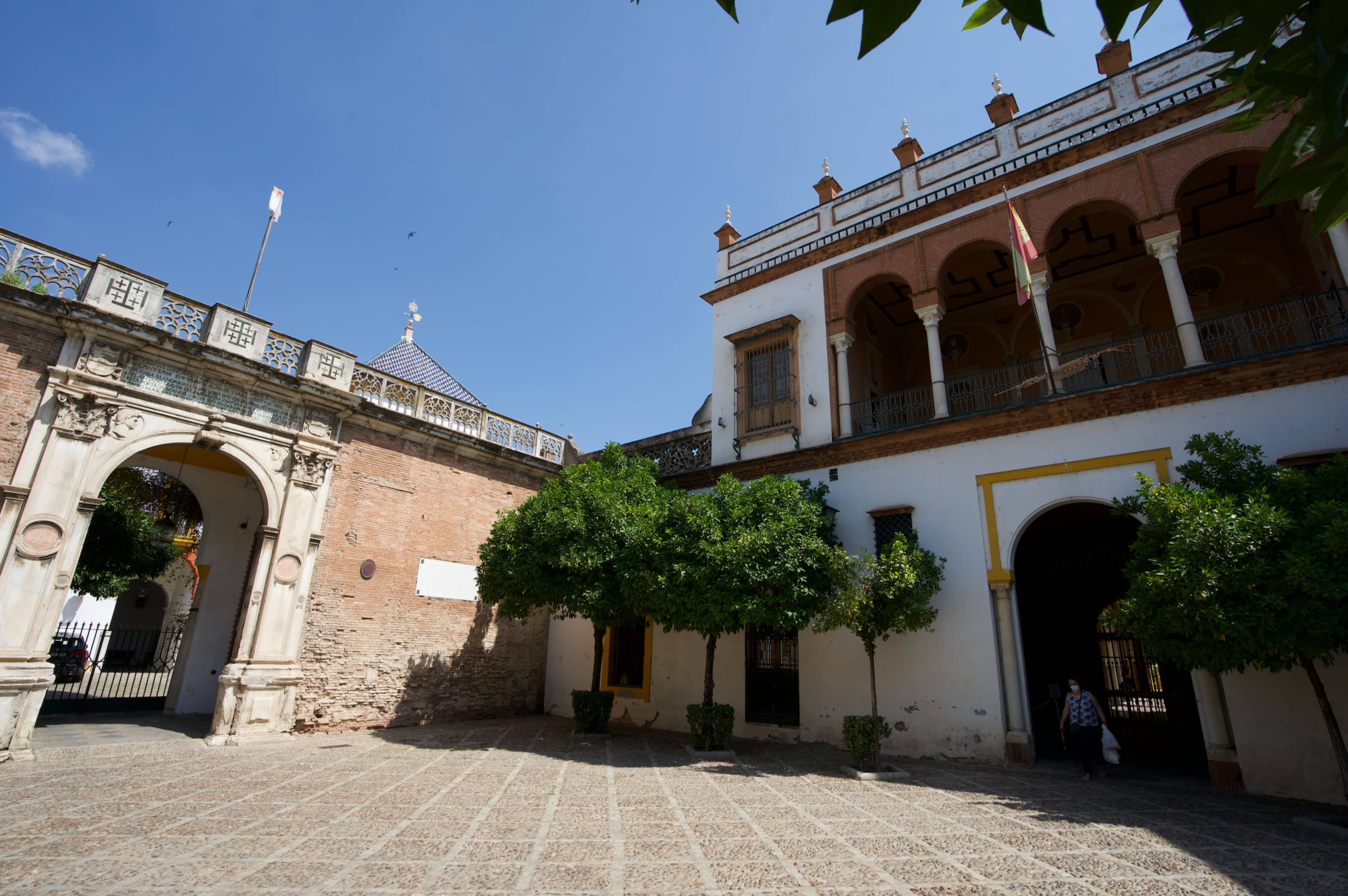
The Casa de Pilatos is a beautiful Italian Renaissance-Mudéjar style palace with romantic elements, considered the best Andalusian noble building.
This visit is a fantastic example of 16th-century Sevillian architecture thanks to its Roman collection, artistic legacy, and marvelous architecture, which are the keys to this palace.
The collection of wall tiles is one of the best in the world, and it houses many statues and artifacts from the Roman Empire.
The place got named after Pontius Pilate, which they tried to emulate.
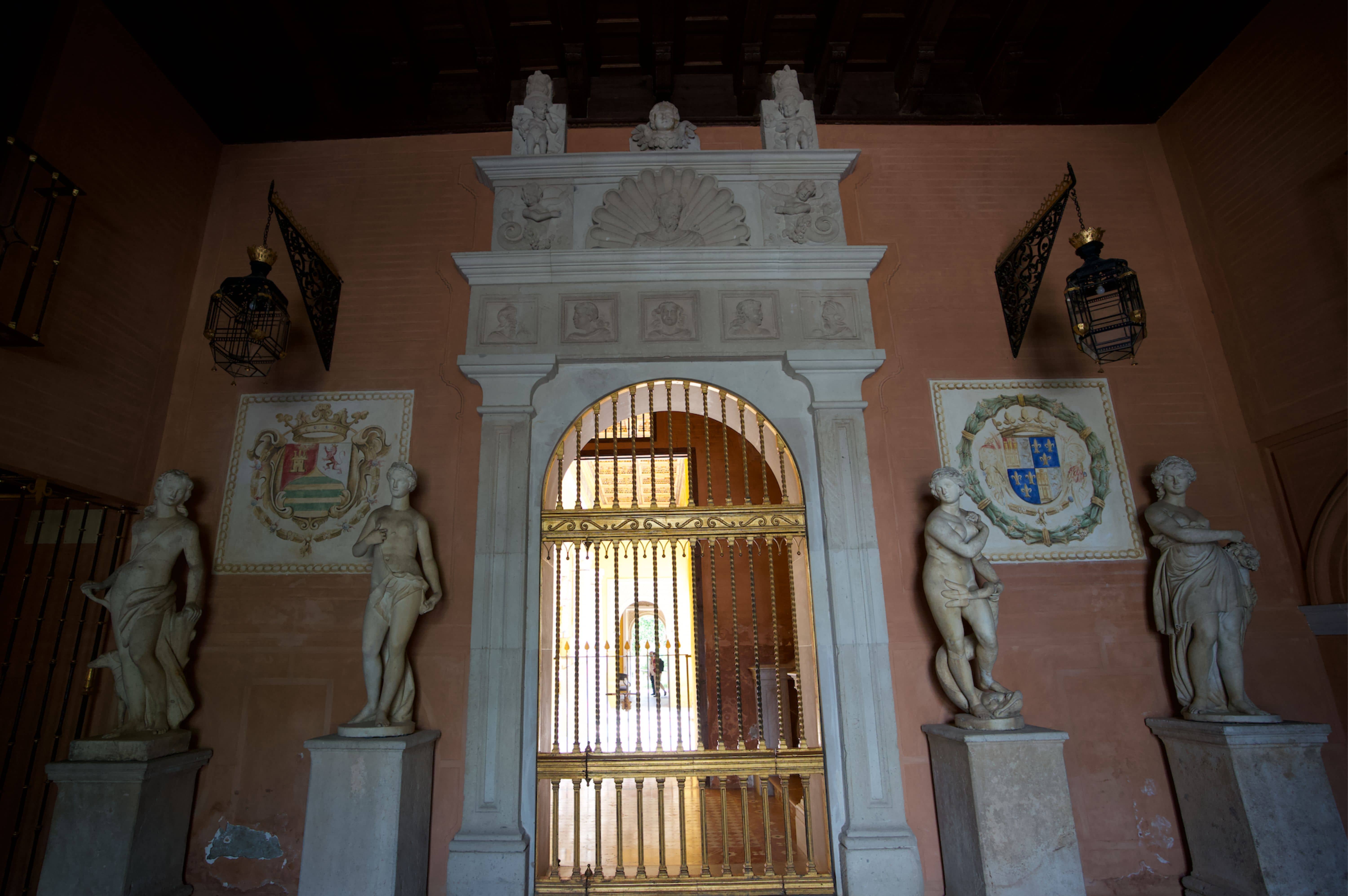
First, Casa de Pilatos was the residence of the Dukes of Medinaceli and the headquarters of the Casa Ducal de Medinaceli Foundation, dedicated to managing a historical-artistic heritage dispersed throughout all the autonomous communities of Spain.
Then it became part of the patrimony of the Dukes of Medinaceli in the 17th century through the Marqueses of Alcalá de la Alameda.
Make sure you download the audio guide, and be prepared to spend at least a couple of hours there and book your visit to the upper floor in advance. It is only possible to get there with a prior reservation.
📅 Opening Times: From 9:00 am - 6:00 pm.
- Complete Visit: €12 (free audio guide)
- Ground floor only: €10
- Admission is free on Mondays from 3:00 pm to 7:00 pm.
6. La Giralda
The Giralda is the emblematic bell tower of the Sevilla Cathedral. It consists of two different but perfectly unified pieces, a perfect example of the mix of cultures existing in the city.
It is about 318 ft. high overall and rises between the Puerta de Oriente and the Puerta de los Palos.
It was once the minaret of a mosque. It was used to sing and call people to prayer. However, nowadays, you hear church bells calling people to Catholic mass.
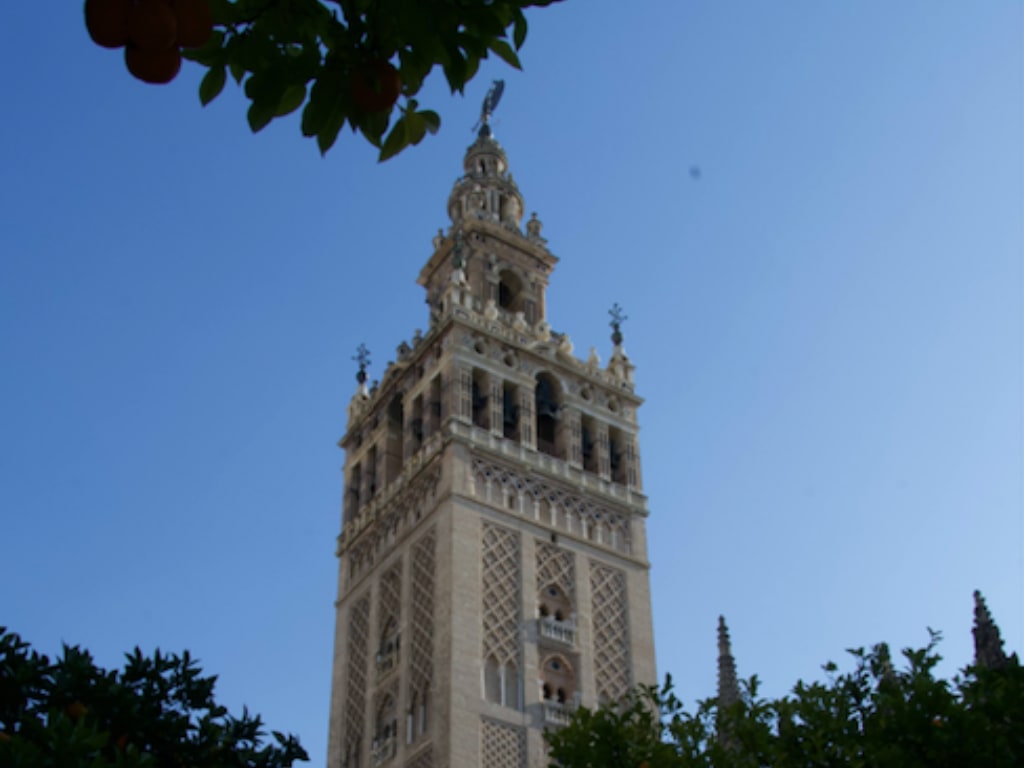
This tower represents the Muslim control in Seville, the Catholic Reconquest, the Inquisition, and the Renaissance.
The word “ Giralda ” comes from the Arabic “ jug ,” which means “bell.” Because the tower was initially decorated by the Muslims with a figure of a bell called “ Giraldillo .”
Therefore, the Giraldillo represents the triumph of the Christian faith and is depicted as a robed woman with a palm in one hand and a shield in the other, which serves as a weather vane.
This 16th-century sculpture has presided over the Giralda since 1568.
La Giralda has inspired many works of art and even very similar monuments, making anyone quickly recognize it, even if they have never been to Seville. 📅 Opening Times:
From September to June:
- Monday: 11:00 am to 3:30 pm.
- Tuesday - Saturday: 11:00 - 17:00.
- Sunday: 14:30 - 18:00.
July and August:
- Monday: 9:30 am to 3:30 pm.
- Tuesday - Saturday: 9:30 am to 4:00 pm.
- Sunday: 14:30 pm to 6:00 pm.
- Adults: 8 € (includes visiting the Church of Salvador).
- Reduced price: 3€ (students <26 years old, retirees).
- Free for natives and residents of Seville and the province, the unemployed, disabled, and a companion, <16 years of age, accompanied, and authorized groups.
- Free Mondays from 16:30 – 18:00
7. Plaza de toros de la Real Maestranza

📍P.º de Cristóbal Colón, 12, 41001 Sevilla
The remarkable Plaza de Toros de la Real Maestranza is the oldest bullring in Spain . It makes an exciting homage to Spain’s long-standing tradition of bullfighting.

Moreover, it is the headquarters of one of the most recognized bullfighting festivities in the world! Which takes place during the famous Seville April Fair , one of Seville’s most international and popular festivals.
Seville Fair Guide for non-locals. Must-read before you go!
The tour is complemented by a visit to the Exhibition Hall-Museum, with an exhibition of oil paintings from the 18th, 19th, and 20th centuries and a selection of bullfighting prints that belong to the collection of the Real Maestranza, one of the most important in the world.
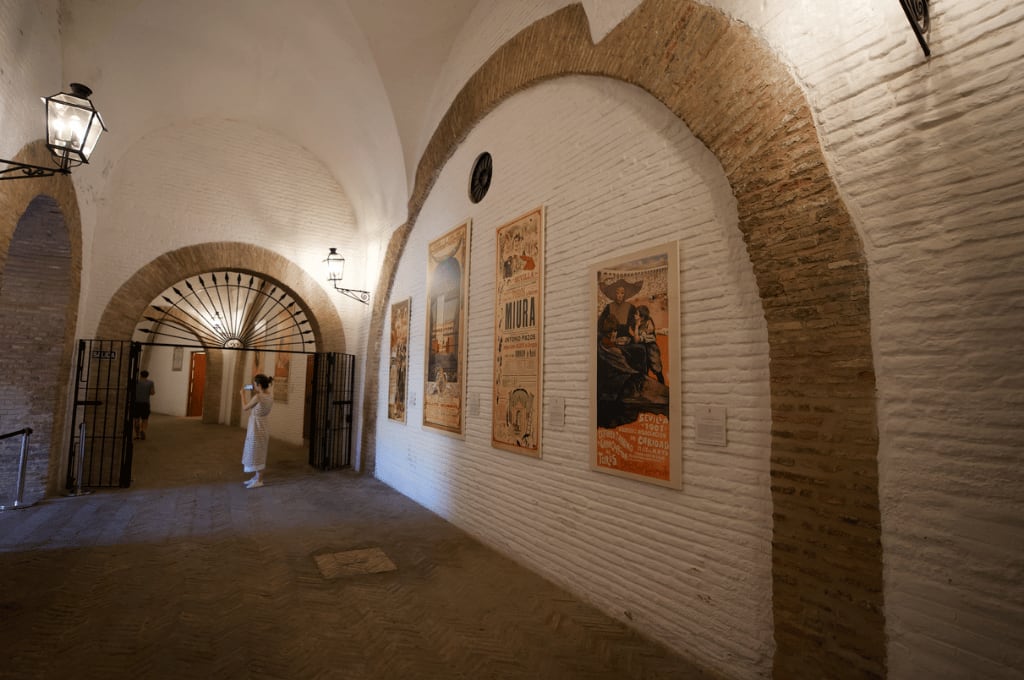
You can see Goya’s paintings on display. They have old event posters and costumes from famous Spanish matadors!
To learn more about this tradition, read the following articles:
What Is Bullfighting? Origin, Purpose, and Top Festivities in Spain Is bullfighting legal in Spain? Never-ending Legal, Moral Debate 31 Cultural and Interesting Facts About Bullfighting in Spain
Regardless of one’s opinion or interest in bullfighting, spending up to an hour in the Plaza de Toros is fun and enriching.
Moreover, if you’re curious about visiting a bullring without watching an actual bullfight, this is the perfect way to experience it.
You can do the tour at your own pace. There is a QR code that links you to the audioguide.
Every day: 9:30 am to 8:15 pm
Bullfight days: 9:30 am to 3:00 pm
- General ticket: €10
- Students < 26 years old, children between 12 and 16 years old, and retirees: €6
- Children from 7 to 11 years old: €3.50
- Free: < 6 years old and Wednesday from 3:30 pm to 7:00 pm (limited capacity)
8. Palacio San Telmo
📍 P.º de Roma, 41013 Sevilla
To know the origin of The Palace of San Telmo, we have to go back to 1682, when it was built. It was first a Seminary College of the University of Seafarers.
In 1849 it became the residence of the Duke and Duchess of Montpensier , who finished the north tower and built the main entrance, the east wing, and the ballroom.
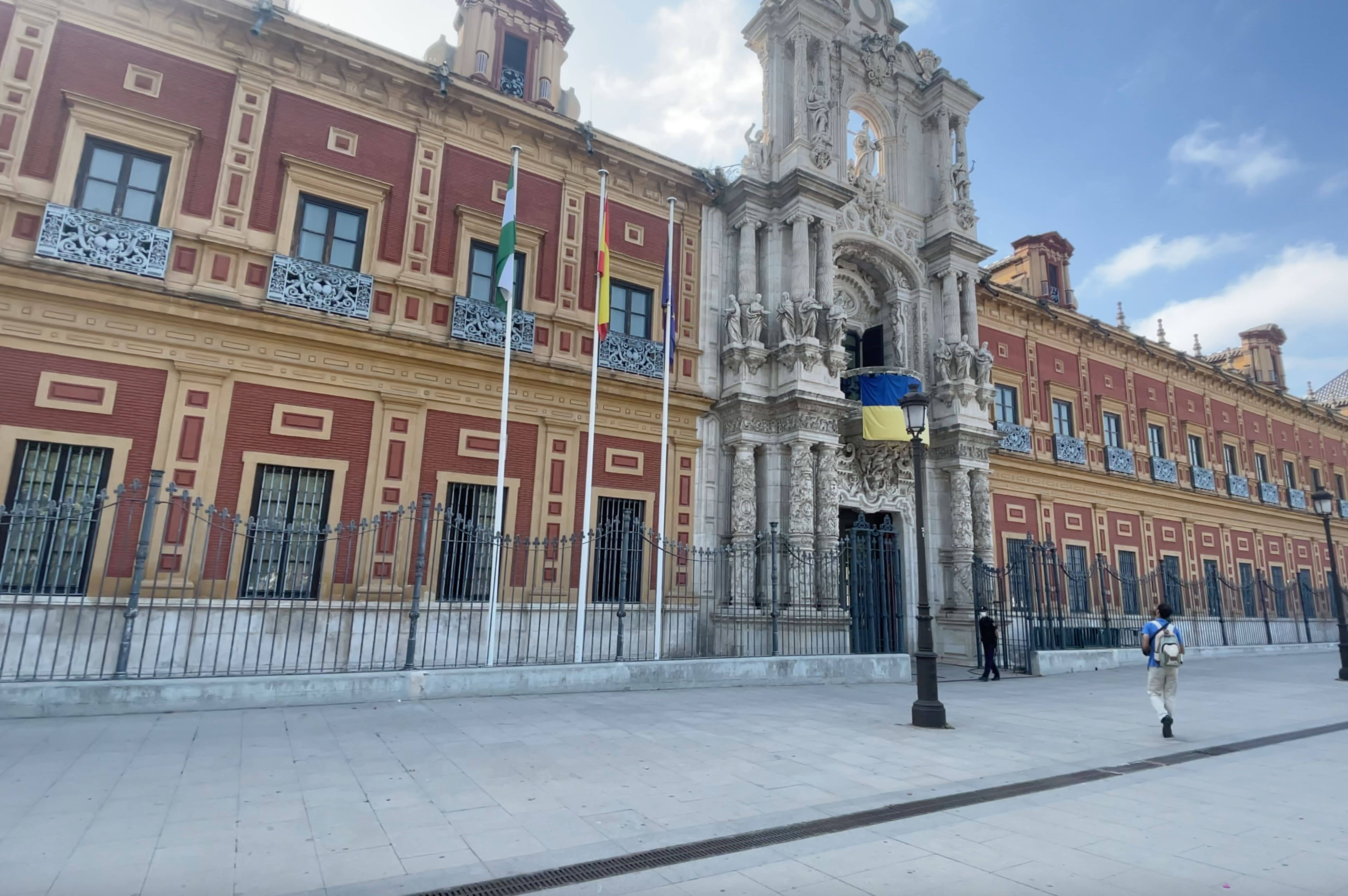
The walls are covered with paintings brought from the Palace of Vista Alegre. The impressive ceilings of the ballroom are decorated by Rafael Tejeo.
This is one of the most beautiful buildings in the city of Seville. It has a rectangular floor plan with four towers and a large central courtyard.
It is essential to highlight its 18th-century facade , by Leonardo de Figueroa, and its side facade with sculptures dedicated to the famous people of Seville.
The palace had a telegraph, and even its own pier to access the Guadalquivir and some Versailles-style gardens that would later become the Maria Luisa Park.
And the Chapel represents a jewel of Andalusian and Spanish art.
Maria Luisa Fernanda, on her death in 1897, donated the palace to the archbishopric. In 1901 it became a diocesan seminary.
Since 1989 it has belonged to the Junta de Andalucía, which, after rehabilitating several areas and regaining its status as a palace.
- Monday to Thursday: 9:00 am to 9:00 pm.
- Fridays: 9:00am to 3:00 pm.
9. Puente de Triana
📍 Isabel II Bridge, 30, 41010, Seville
Declared a National Historic Monument in 1976, the Isabel II Bridge, better known as the Triana Bridge, spans the Guadalquivir River to connect the city’s heart with the charming neighborhood of Triana.
It was not until 1852 that they inaugurated the bridge 1852. Before the construction of the Triana Bridge, there was the Puente de Barcas (Bridge of Boats) to cross the Triana neighborhood.
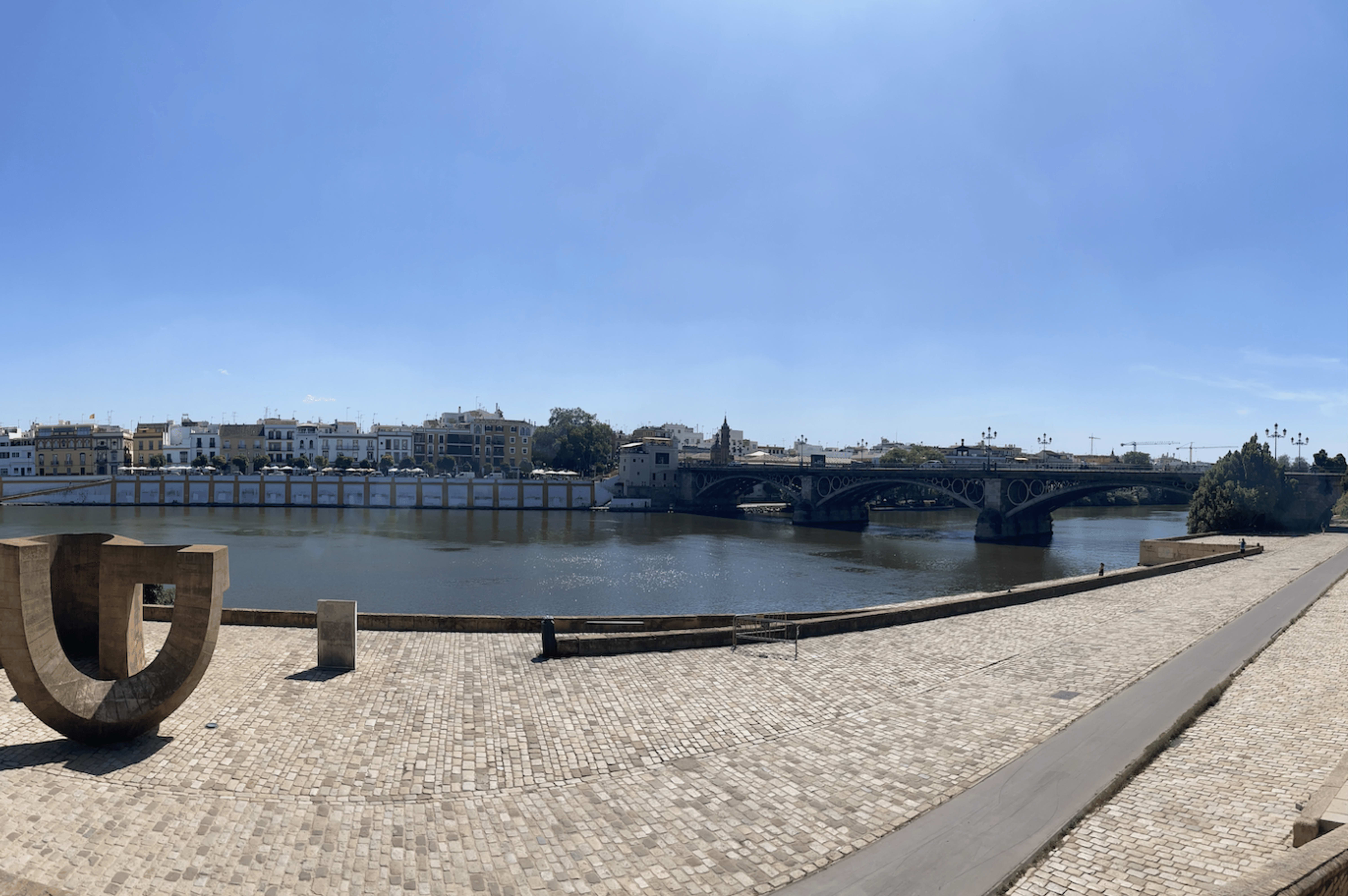
The Puente de Barcas was a precarious crossing because it was strongly affected by the river’s floods, so the challenge of building a permanent and resistant bridge was posed.
Triana Bridge took place during the reign of Isabel II. Therefore, its official name is Isabel II due to this monarch. Its construction was inspired by the Carrousel Bridge over the Seine River in Paris.
Nowadays, the Triana Bridge is currently the oldest iron bridge in Spain as well as one of the symbols of the city and one of its most outstanding attractions.
📅 Opening Times: All Day
10. Maria Luisa Park
📍 Paseo de las Delicias , 41013, Sevilla
Maria Luisa Park is the city’s lung. It is the most beautiful park in Seville and one of the most beautiful parks in Spain.
These incredible gardens were donated in 1893 by the Duchess of Montpellier , the Infanta Maria Luisa Fernanda de Bourbon, which is why they gave this name to the park.
Until that moment, they belonged to the private gardens of the Palace of San Telmo. After a significant reform in 1914, they became available to everyone.
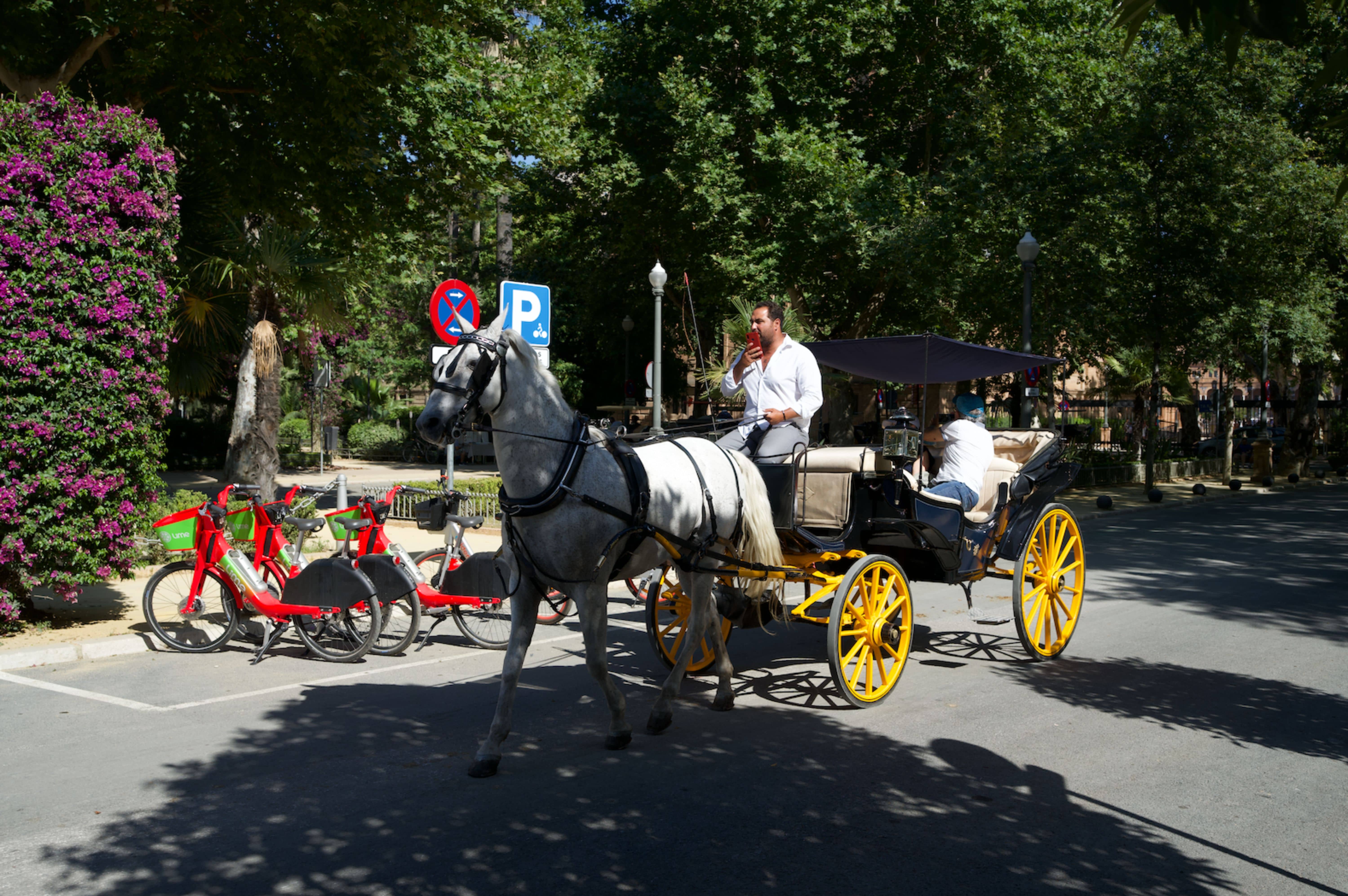
The reform was carried out respecting the original layout of the gardens of the Infanta and the numerous walks across in various traffic circles where we can find fountains and statues .
If I were you, I would take a guided tour around the park because it has very curious corners that may go unnoticed if you go alone.
It is a real open-air museum worth visiting , knowing each traffic circle and its different fountains and statues we will find in our walk.
The main highlights include the Quintero Brothers, Gustavo Adolfo Becquer, and Infanta Maria Luisa. Together they form a beautiful ensemble that will amaze you.
📅 Opening Times:
- Winter hours: 8:00 am to 10:00 pm
- Summer hours: 8:00 am to 12:00 pm
🎟️ Entrance Fees: Free
👉🏻 Official Website
As you can see, these landmarks make up the list of the most exciting attractions to visit in Seville. But there are many more! For a more extensive list of museums and iconic places to visit, check out this post:
Seville Museums: 9 Must-Visit Palaces and Art Galleries
Hope this list was helpful! Don’t hesitate to contact us for any further help. We’ll be happy to read you!
READ NEXT: How to Get Around Seville + 3 Tips I Wish Someone Told Me!
Rating: No ratings yet. Leave a comment!

You might also like...
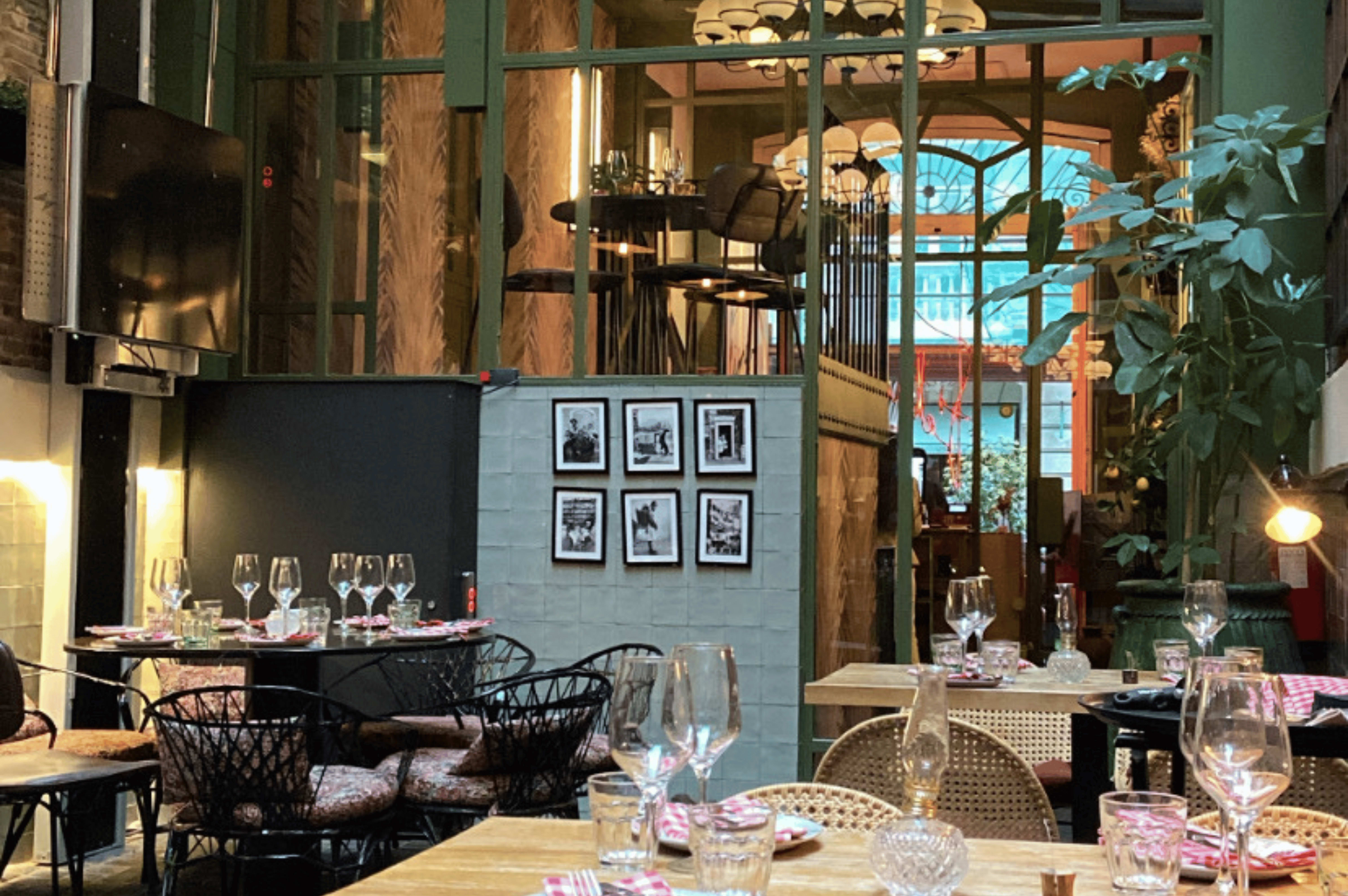
The 19 Best Restaurants in Seville: A Food Lover's Guide!
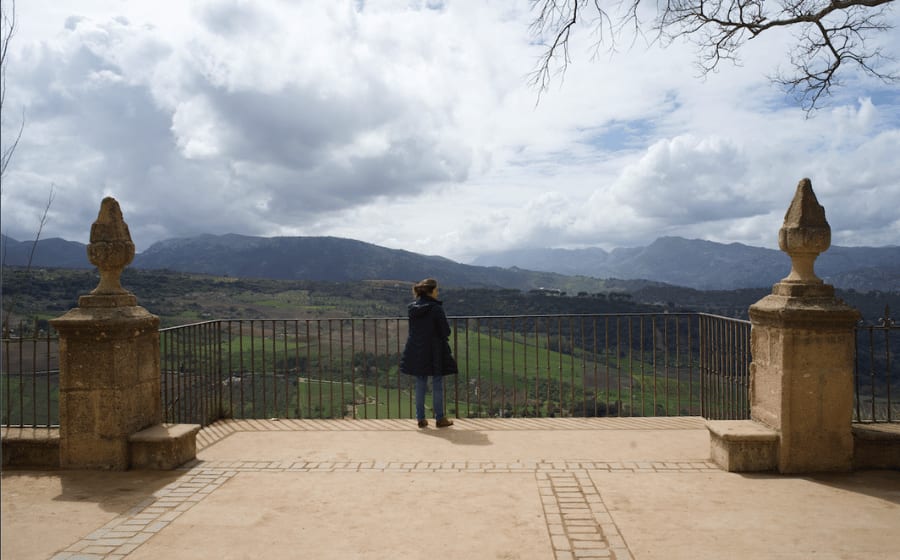
Seville Towns: 11 Seville's Charming Towns to Explore on Your Trip!
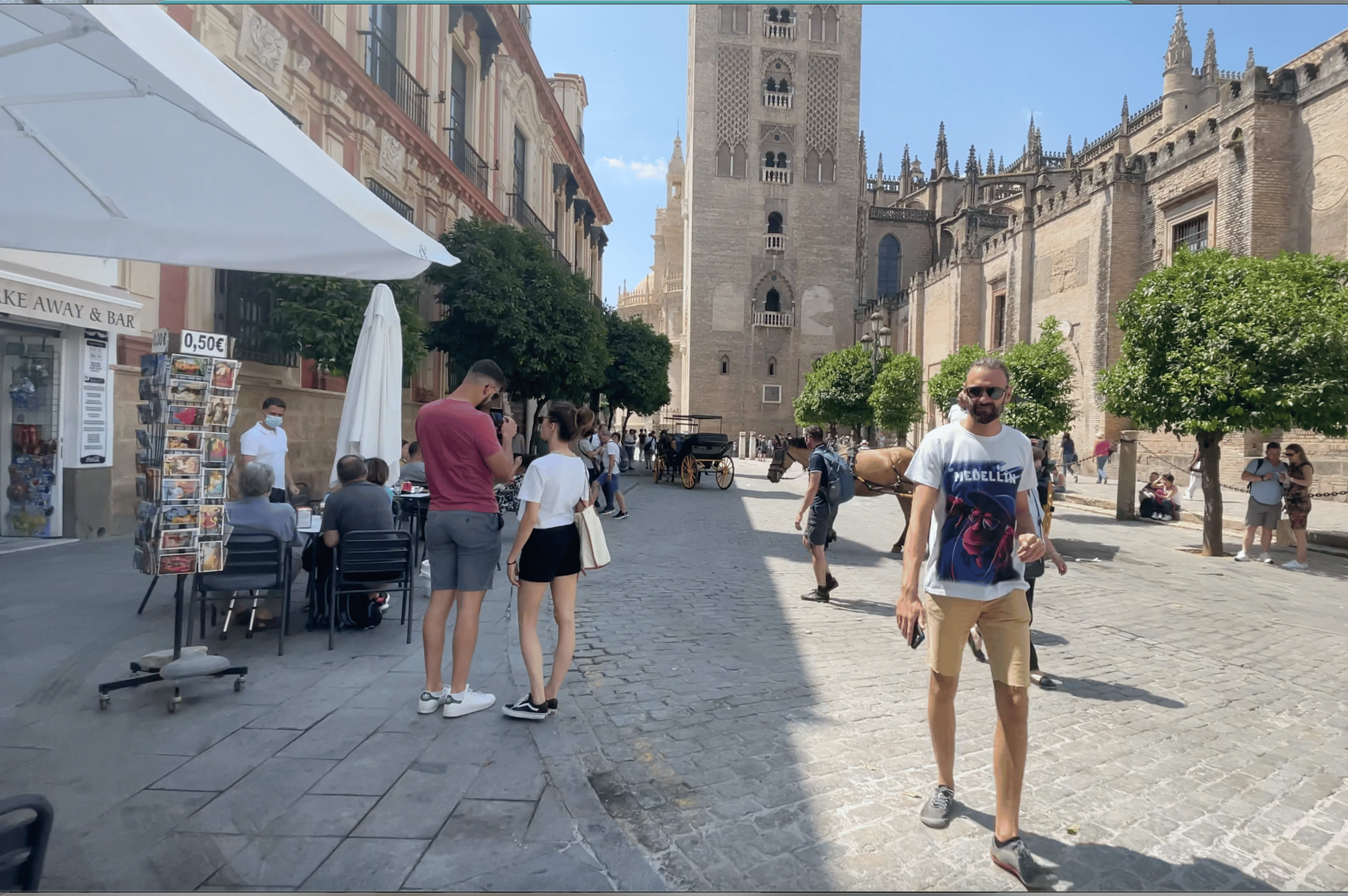
Seville Budget Travel: 7 Money-Saving Tips & Tricks!
Email address (optional), star rating (optional).
Be the first to comment!

Millions of people como to Spain every month! But many never get to experience the SENSATIONAL SPAIN!!
We're both born and raised Spaniards and our goal is to give you all the resources to plan a perfect trip to Spain.
Take a look! 👇
FYI! Some affiliate links may be sprinkled throughout the post. We'll receive a small commission when you purchase from our links (at no extra cost to you), which will help us keep creating content.
Join the waitlist
I'm about to release my City Guides for Madrid, Barcelona, Sevilla and Mallorca.
They're going to have everything you need to plan the perfect trip. From hotels and transport, to restaurants, attractions, activities, & a lot (A LOT!) of tips & tricks.
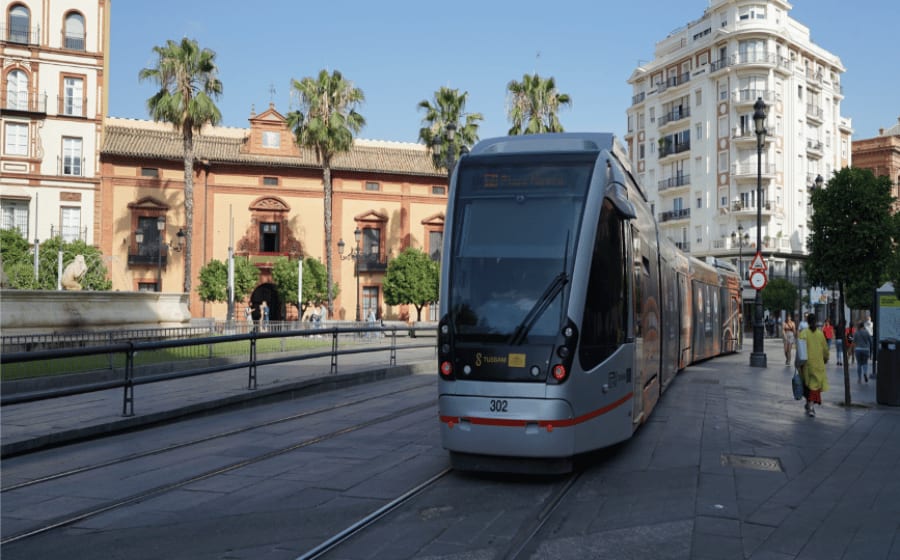
How to Get Around Seville + 3 Tips I Wish Someone Told Me!

What do Spanish People Think of Americans?

What Song Are You Listening To? MADRID

What is the Best Show to Learn Spanish?

Things People Should NEVER do Dating in Spain

Can Foreigners Adapt To The Spanish Lifestyle?

10 Seville Tourist Attractions [An Unusual Tour!]
By Author Paulina
Posted on Published: August 31, 2022 - Last updated: November 11, 2022
Seville is intoxicating , from the moment you arrive. There’s a palpable sense of rich cultural heritage and beauty attached to the city, the result of centuries of architectural evolution, a fusion of cultures, and shifts in political power.
With every historical treasure that you visit in Seville, a sense of wonder follows.
Seville in Andalucia must be seen on foot. With so many winding medieval side streets, palace walls decorated with colorful tiles, and peaceful garden walks, there’s always something new to discover.
On my way through Seville, I illustrated these top 10 Seville tourist attractions.
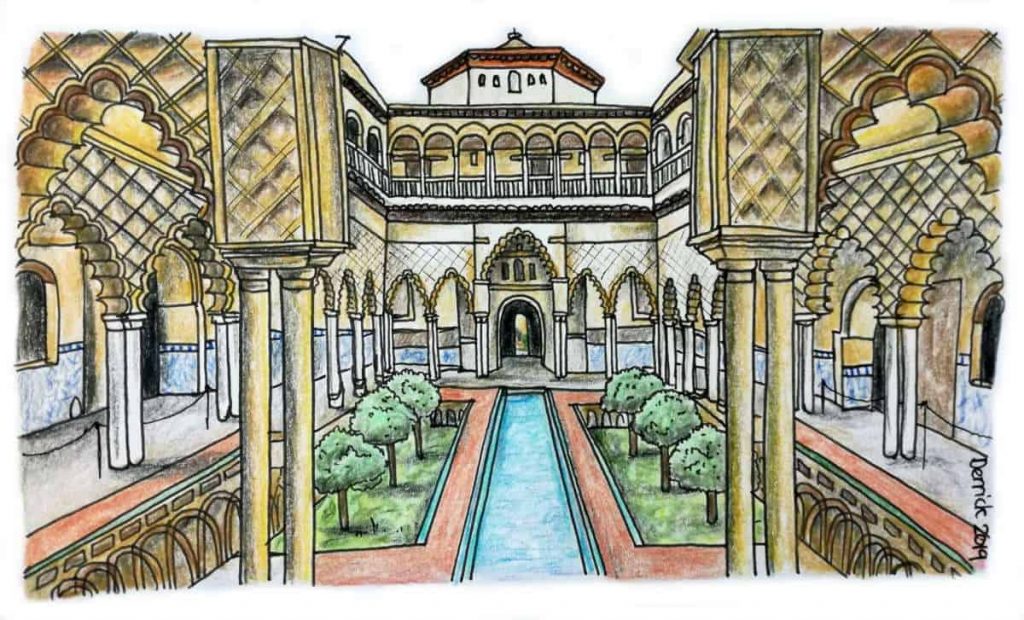
What’s more, many of the city’s most famous sights are right next to each other.
You can’t leave Seville without considering some of the best day trips from Seville.
Under perfect blue skies and glorious Spanish sunshine, Seville is a photographer’s (or a traveling urban sketcher’s ) dream.
And at the end of the day, look forward to delicious tapas and a cold beer on a warm night. I ideally recommend spending 3 days in Seville , since it allows you to fully know the city.
But where to start, for first-timers? Here is my top 10 list of things to do in Seville and top Seville tourist attractions.
1. Admire the Catedral de Sevilla
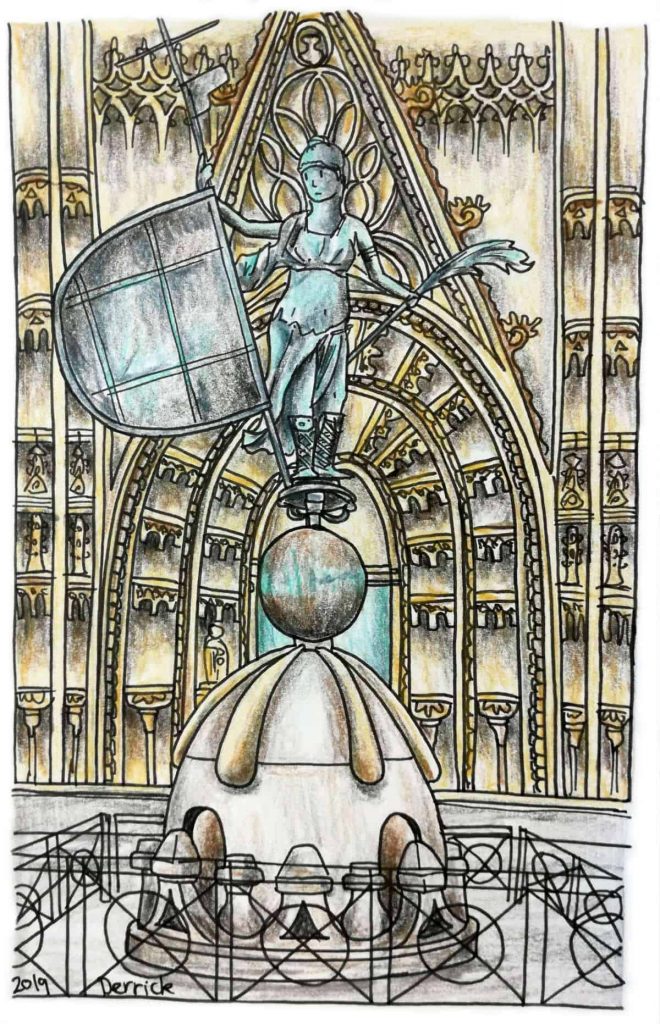
Seville’s most conspicuous architectural delight is the Catedral de Sevilla . Impossible to miss, the world’s largest gothic cathedral occupies a space in the heart of the old city.
Take the time to study the exterior, and you’ll get lost in the exquisite details of the flying buttresses, carved railings, and arched windows.
Inside, high ceilings and polished floors are lit by sunlight streaming through large glass windows.
Taking detailed craftsmanship to the next level is the 20-meter high Retablo Mayor , half a century of gilded wooden reliefs designed by Flemish craftsman Pierre Dancart. Moving to the interior courtyard, a small grove of orange trees is planted.
The mausoleum of Christopher Columbus is located within the Seville Cathedral as well.
The sepulcher shows four coffin-bearers, the statues representing the four kingdoms of Castile, León, Navarre, and Aragon. If you only have 1 day in Seville, this is a must!
Book skip-the-line tickets for the cathedral and Giralda
2. Climb to the top of La Giralda
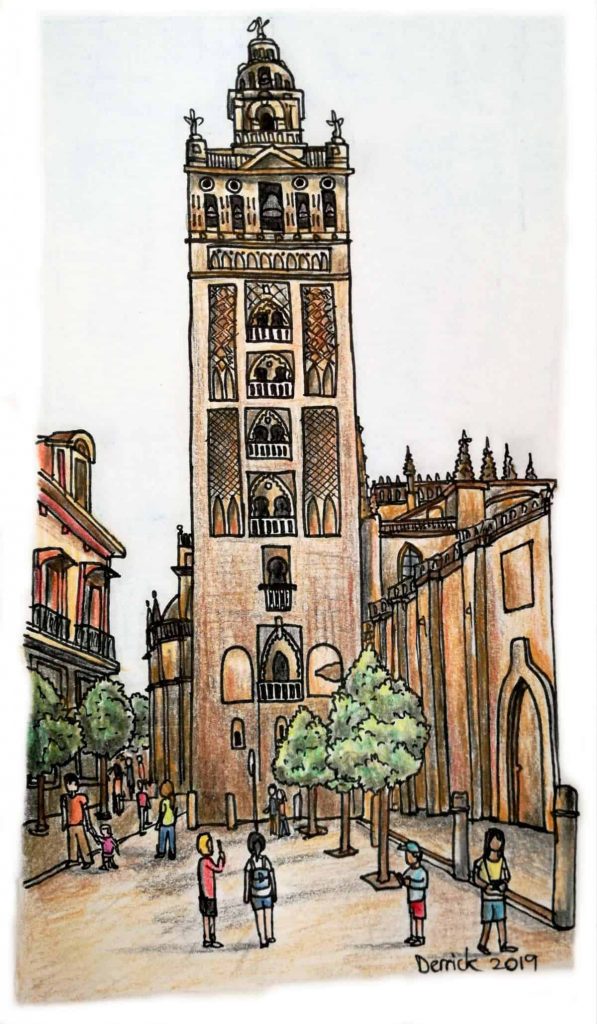
The Giralda, the landmark bell tower rising from the Catedral de Sevilla, contrasts pleasingly against the cathedral’s ornate design with its straight edges and perfectly geometric form.
The tower is cut into two fascinating styles that illustrate Seville’s history. The bottom portion is what remains of a Moorish minaret.
In 1248, when the city was retaken from the Moors by the Christians, the main part of the mosque was left to ruin, and after the construction of the Cathedral, a bell tower was added to the top of La Giralda.
Interior ramps leading to the top of the minaret were designed to allow a horse and rider to make their way to the top.
Whether you have a horse or not, visitors can climb the ramp for an excellent view of the city. From the Giralda you should walk through the prettiest streets of Seville in Barrio Santa Cruz.
It is one of the top Seville tourist attractions you must see.
Book a fast track to the cathedral and Giralda
3. The magnificent Real Alcazar of Seville
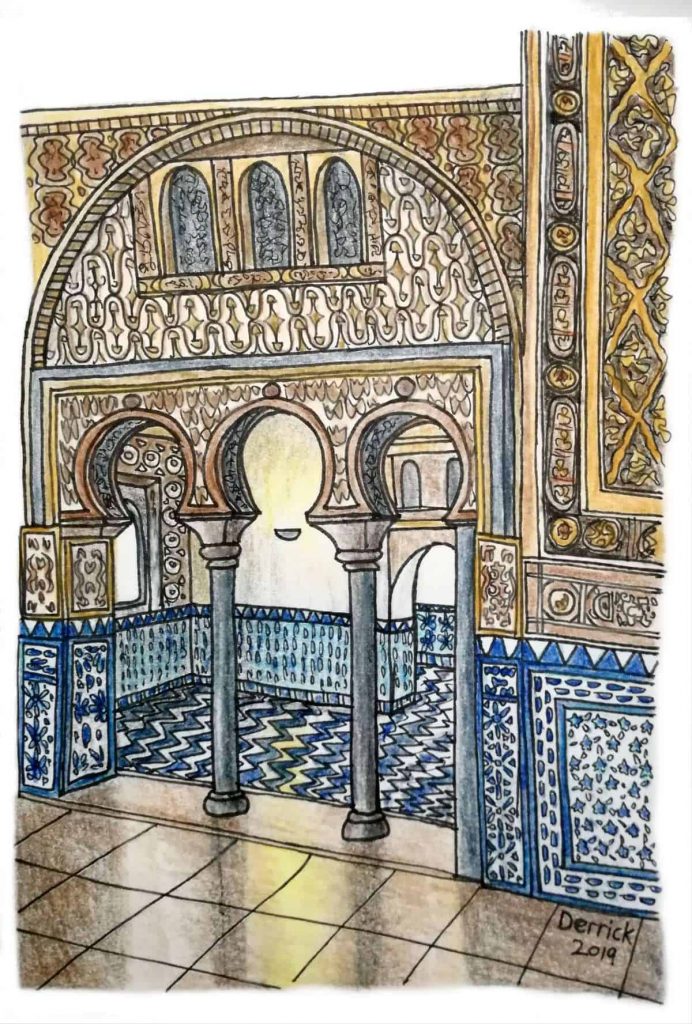
The Alcázar, a royal palace, is the city’s cultural centerpiece ; a hybrid of Moorish and Christian Castilian architecture and design known as Mudéjar . It’s one of the best Seville architecture you must see.
The palace spreads out over a large area; a labyrinth of courtyards, great halls, carefully arranged gardens, and stunning tiled artworks. It is one of the top things to do in Andalucia.
Anyone who’s seen the water gardens in Game of Thrones knows the lovely cutaway arches and still waters of the Patio de las Doncellas, the Alcázar’s most celebrated courtyard.
Taking the time to wander around, one finds Moorish influence pervading in the intricate arabesques crawling up the walls and meeting in grand, domed ceilings.
Meanwhile, large chambers demonstrate Spanish design in wall-sized tapestries, and coloured tile arrangements.
One can spend a whole afternoon exploring the sprawling grounds , discovering secret courtyards with whispering fountains, underground bathing pools, and rustling palm trees lining the palace walls.
More than anything else in Sevilla, the Alcázar is one of the best museums in Seville that you must visit.
Book your fast track to the Alcazar
4. Wander the galleries at the Plaza de España
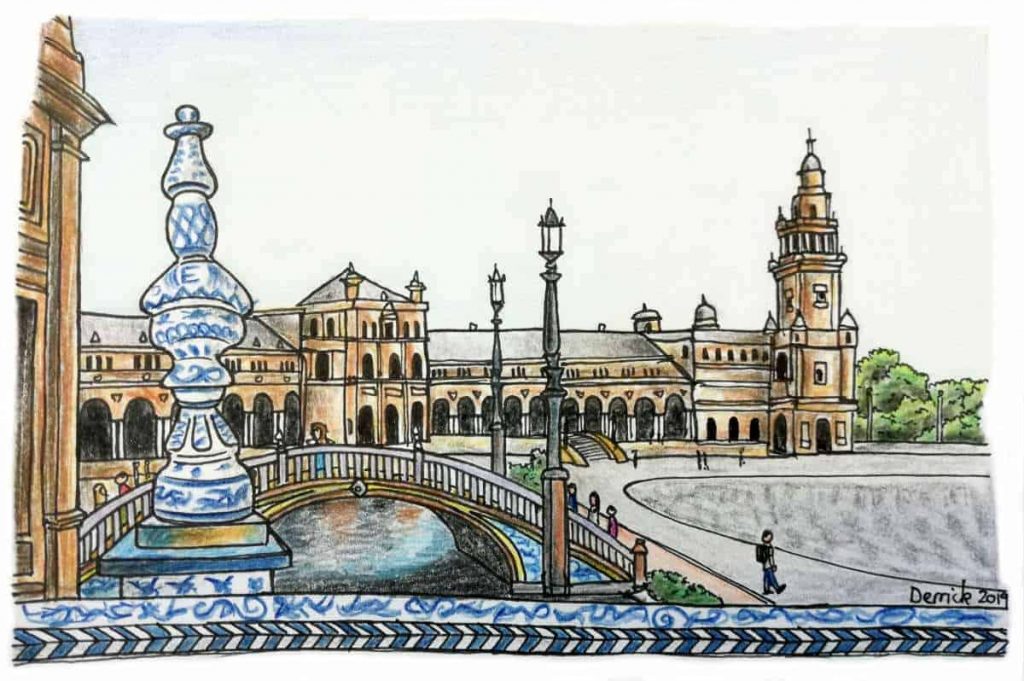
South of the city center is the Plaza de España. The Plaza is a wide, sweeping semi-circle ringed by elegant buildings , columns, and steps linked by tiled walking galleries.
Continuing the theme of famous film locations, the Plaza de España was used for a Naboo scene in 2002’s Star Wars: Attack of the Clones.
The central plaza is home to a huge, lively fountain and a semi-circular canal spanned by four arching bridges. Boat rides are available for those who want to sit down and enjoy the view.
There are a number of interplaying design styles at work here; renaissance revival, Moorish elements, and Spanish architecture.
5. Walk the banks of the Guadalquivir to the Torre del Oro
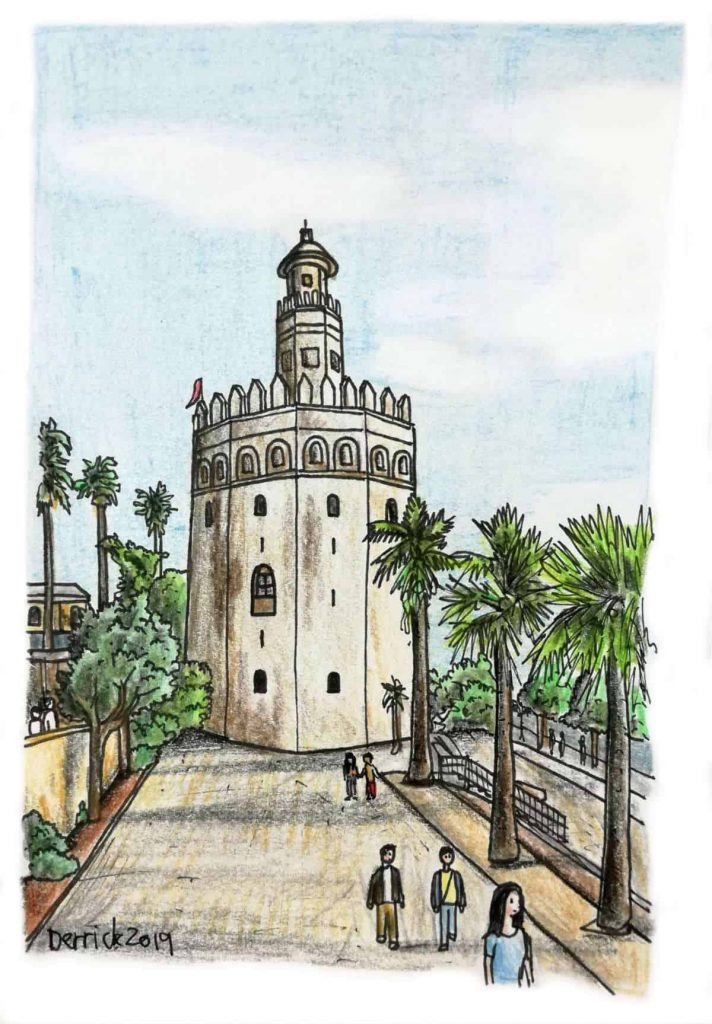
The Guadalquivir, the slow-moving river running through the city, has paved banks which is wonderful for aimless walking when the weather is nice.
Look to the other side of the river, and you’ll see the multi-colored facades of Triana, another charming old quarter of Seville.
As you move south, you’ll notice the Torre del Oro appear in view. Resembling a great circular keep, complete with crenellations and fluttering flags, it was originally constructed as a Moorish watchtower in the thirteenth century.
From here you can start your walk along the Guadalquivir river.
Book here your bicycle tour Seville
6. Get lost in the streets of Barrio Santa Cruz
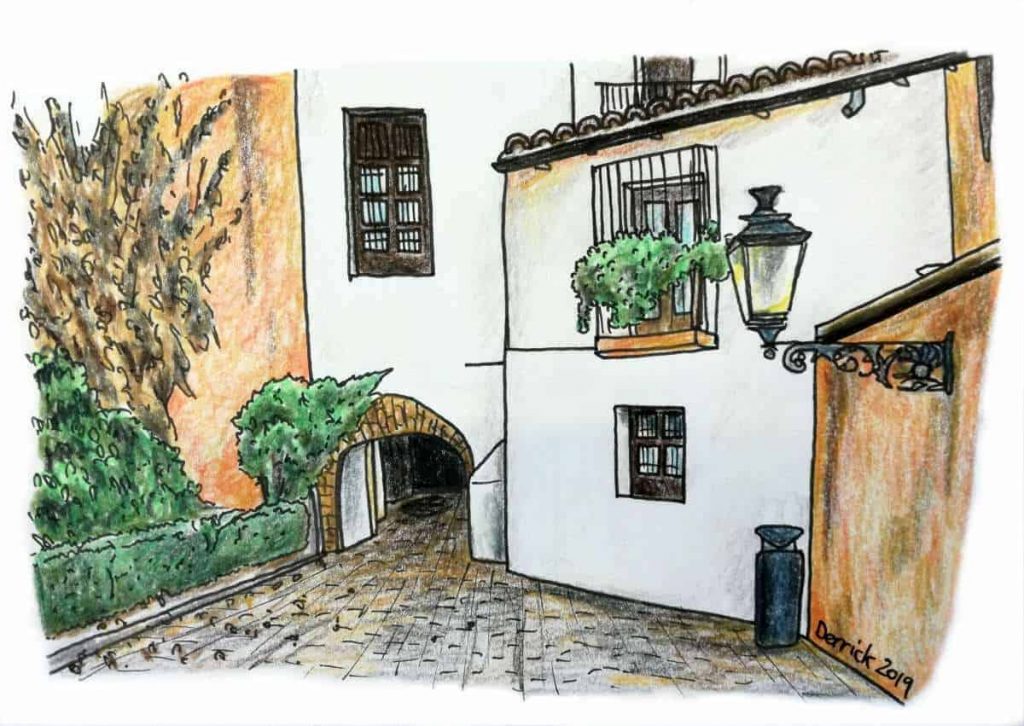
If you want to see cute, charming Spanish streets – and I’m talking jaw-dropping levels of charm here – start wandering around Santa Cruz, the old Jewish quarter.
Many people enter Santa Cruz just next to the Real Alcázar, bordering the great palace walls.
There are several tourist trap restaurants and souvenir shops here, but keep on meandering in any random direction and you’ll experience a transformation.
Geometric brickwork and smoothed-off cobblestones roll out underfoot, bushy green trees paint shady designs on the road, and lovely stucco houses compete for attention in muted shades of pale red, sun yellow, and powder blue.
Occasionally, a café comes up to greet you, a great place to sip a cappuccino under an umbrella and ponder the flower beds sprouting out of red-painted windowsills.
Turn a corner and you’ll see crookback alleys so close that the houses above you have fused together.
And just when you think you’re so lost you’ll never get out, you’ll notice a palm tree popping up to remind you that the Alcázar gardens are nearby.
In Santa Cruz, you’ll find some of the best tapas in Seville , and restaurants hosting Seville flamenco shows.
If you visit during Semana Santa, you’ll spot many of the emblematic processions of Holy Week. It is one of the best free things to do in Seville.
Book here your Tapas t o u r in Seville
7. Sit down for a lazy breakfast, Seville style
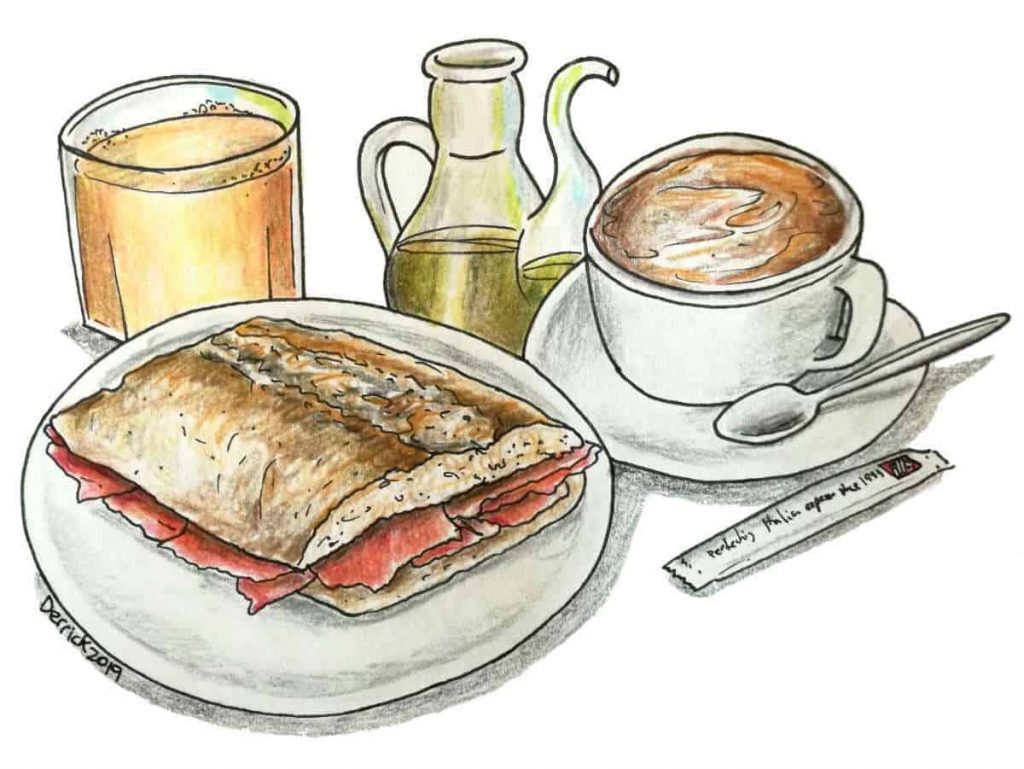
Sleep in, wake up late and find a local cafe – one with quiet outdoor seating is a good start.
Many cafes will serve the Seville-style breakfast, which is usually a crunchy toasted piece of bread, topped with chopped tomato or Spanish ham, and served with coffee and orange juice.
Olive oil (always on the table, of course) is drizzled over the tostada to make this breakfast more unhealthy, but much more delicious. Wonderful!
Read: Where to eat the best breakfast in Seville , Where to eat in Seville ,
8. The Metropol Parasol
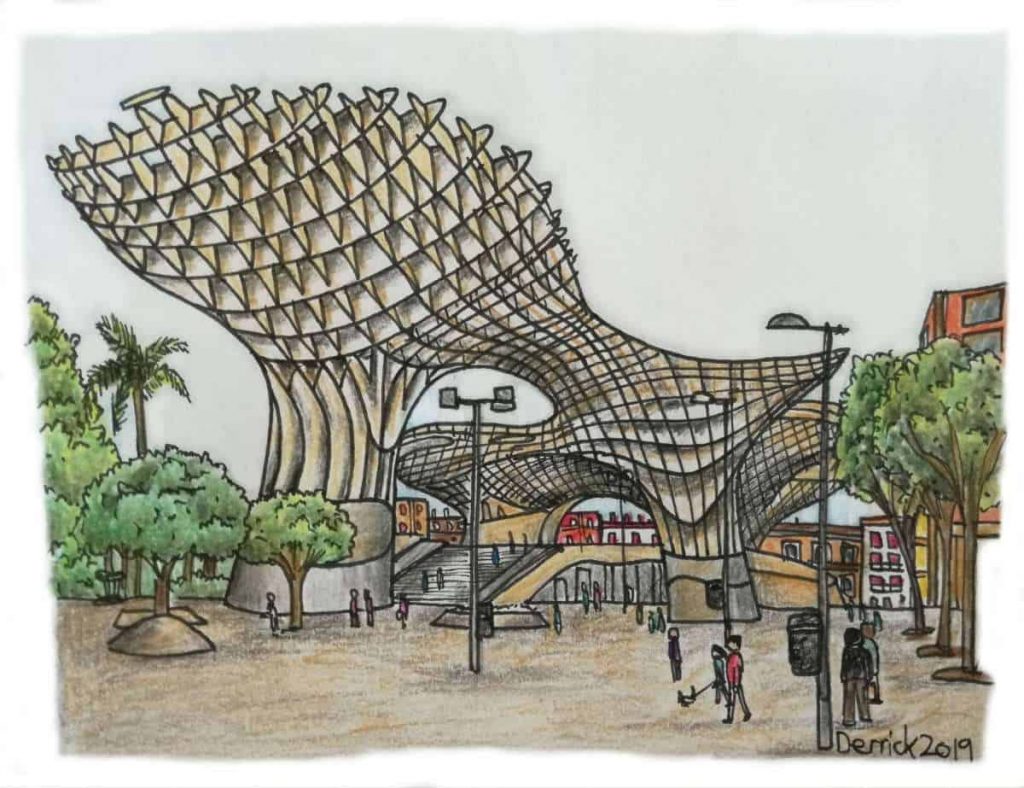
Stunning modern architecture? Horrible eyesore? Is it a big waffle, or a mushroom, or maybe it’s a giant 3-D wooden model set ? Whatever you may think of Jürgen Mayer’s 26-metre high construction, it’s certainly worth checking out.
The sweeping latticework spread across six ‘mushrooms’ is one of the largest wooden structures in the world, and the flowing organic shape creates curious shadows and optical effects.
A small fee allows you to climb the Metropol Parasol, and follow the winding aerial walkways to enjoy amazing views of Seville in every direction.
It’s usually quiet, so you’ll have the chance to take some crazy photographs by yourself.
For history buffs, the Antiquarium museum is located beneath the Metropol Parasol, with preserved Roman ruins.
9. Eat where the locals eat at Alameda de Hércules
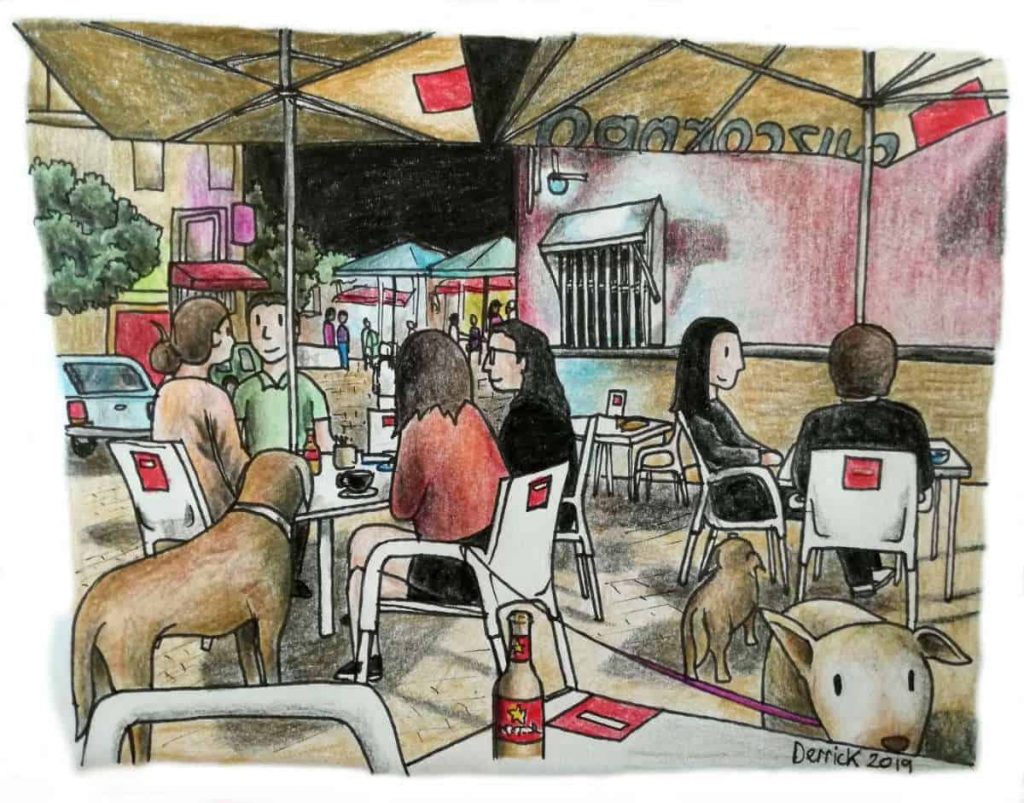
Paella can be found around every corner in the old quarter, and many hungry visitors look no further than these restaurants. But in order to find some of the best tapas in Seville , head over to the Alameda de Hércules in the nearby suburb of Macarena.
Part avenue, part public square; this broad, leafy, pedestrian-only street is lined by lively restaurants and clusters of diners enjoying pleasant Spanish nights on the terrace.
Locals come to catch up over cold beers and bring their dogs along to mingle. Order a patatas bravas and barbequed prawns, and soak in the Seville evening.
If you are wondering what to eat in Spain , then get yourself a tapa of boquerones in vinagre or a refreshing horchata .
Book here your food tour in Seville
10. Relax in the Parque Maria Luisa, Seville’s most beautiful park
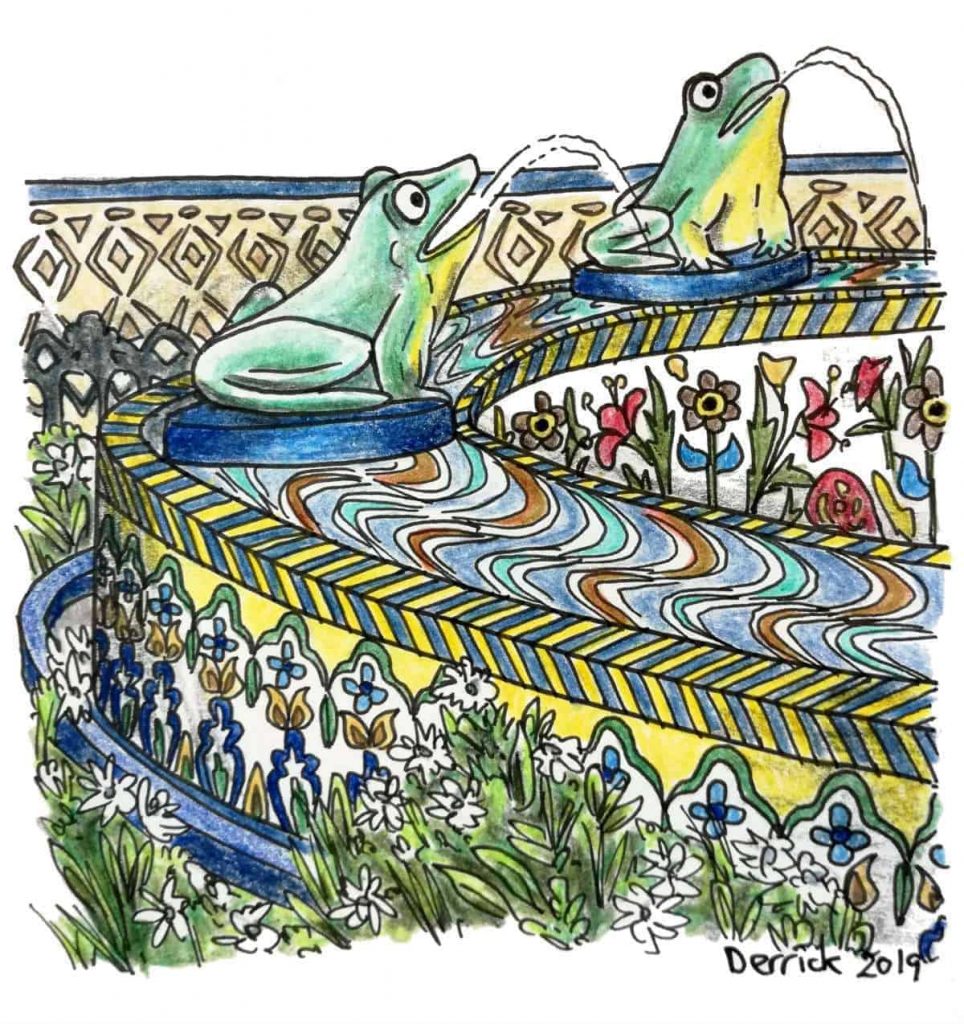
When you’re finished enjoying the Plaza de España, take the time to escape the city and enjoy the tranquility of the Parque María Luisa.
It was built for the great exposition. Soaring palms, great elm trees, and rustling pines provide shade to the many walking paths through the park.
Don’t forget to check out the small pavilion overlooking the duck pond. The constructions are a major point of interest in Seville.
It is one of the prettiest Seville tourist attractions for people that want to escape the heat.
More about Seville, Spain
- Best hiking trails near Seville
- 20 Best Tapas Restaurants in Seville
- 15 Best Hotels with Pool in Seville
- 14 Best Flamenco Shows in Seville
- 20 Best Holiday Villas in Seville
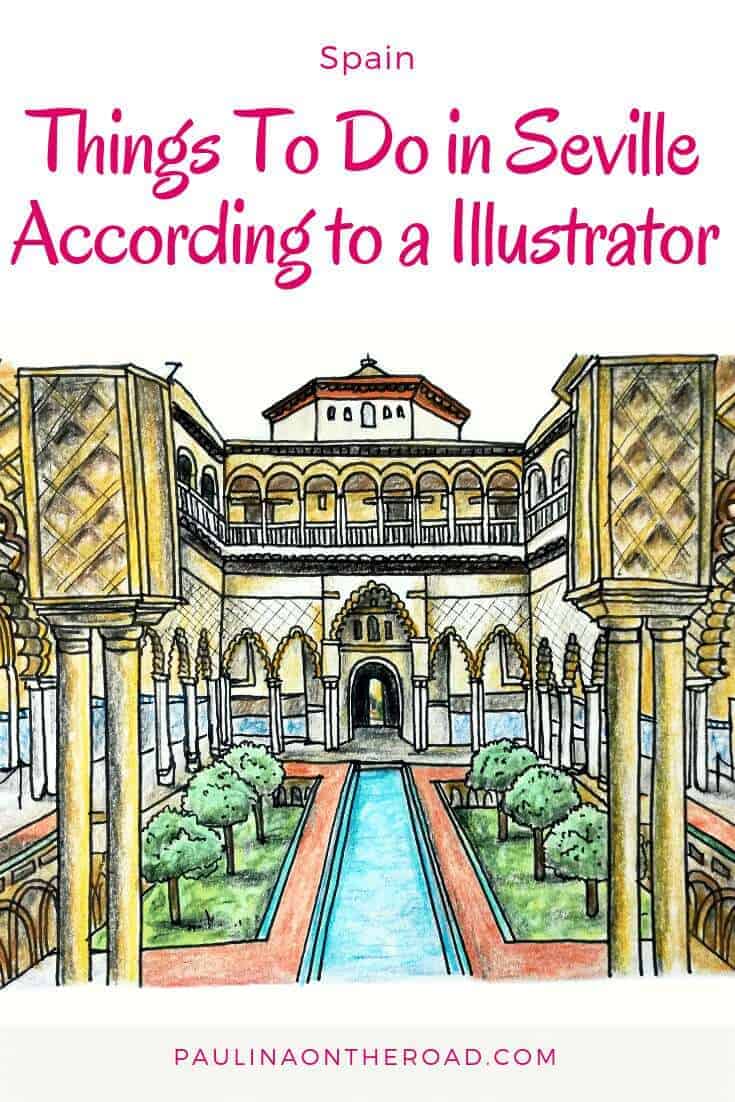
About the author
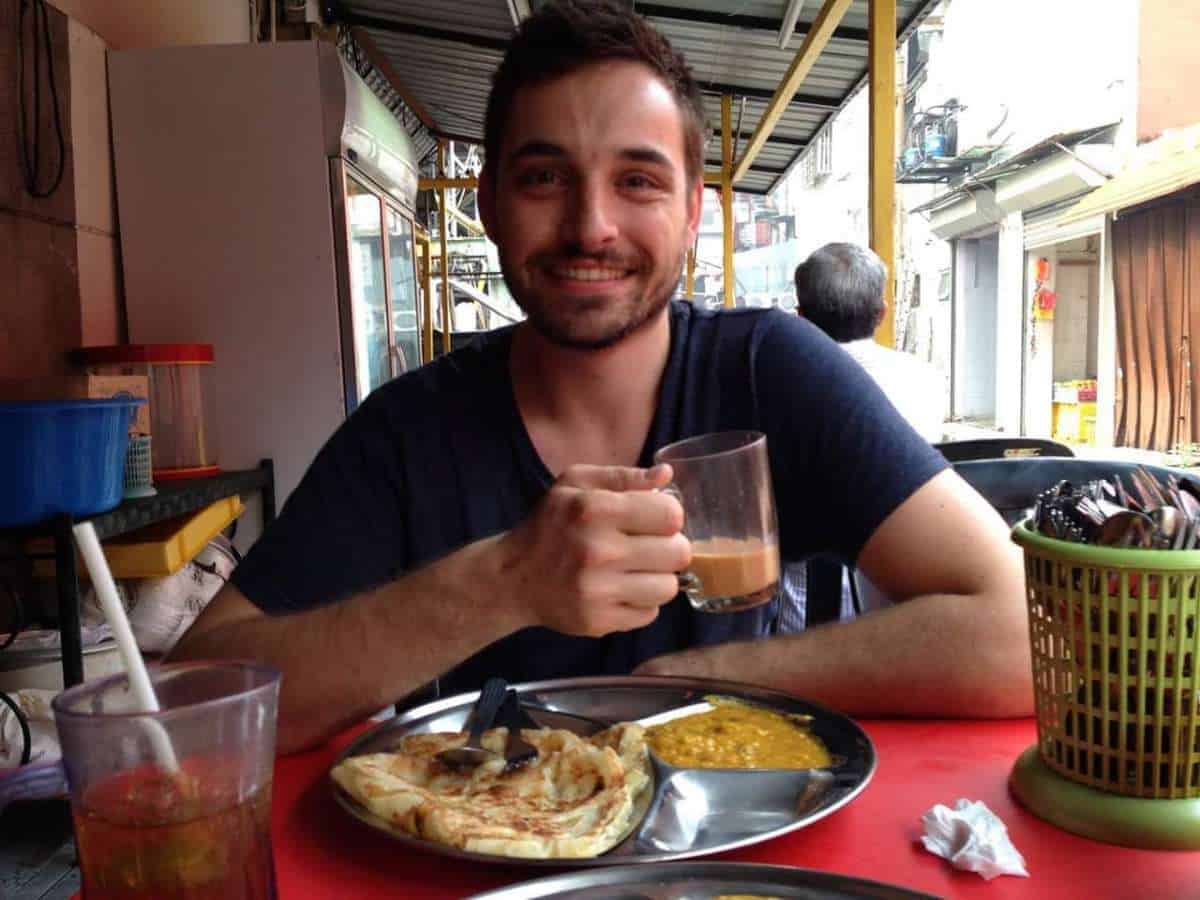
Derrick is a 32-year-old living in Melbourne, Australia. With plenty of family in Europe and an insatiable travel bug that won’t go away, there’s always a good reason to travel somewhere new! When he’s not traveling, he’s illustrating past adventures in his sketchbook, and experiencing all the challenges of being a new dad.
Don’t forget to check out his blog StickyMangoRice .
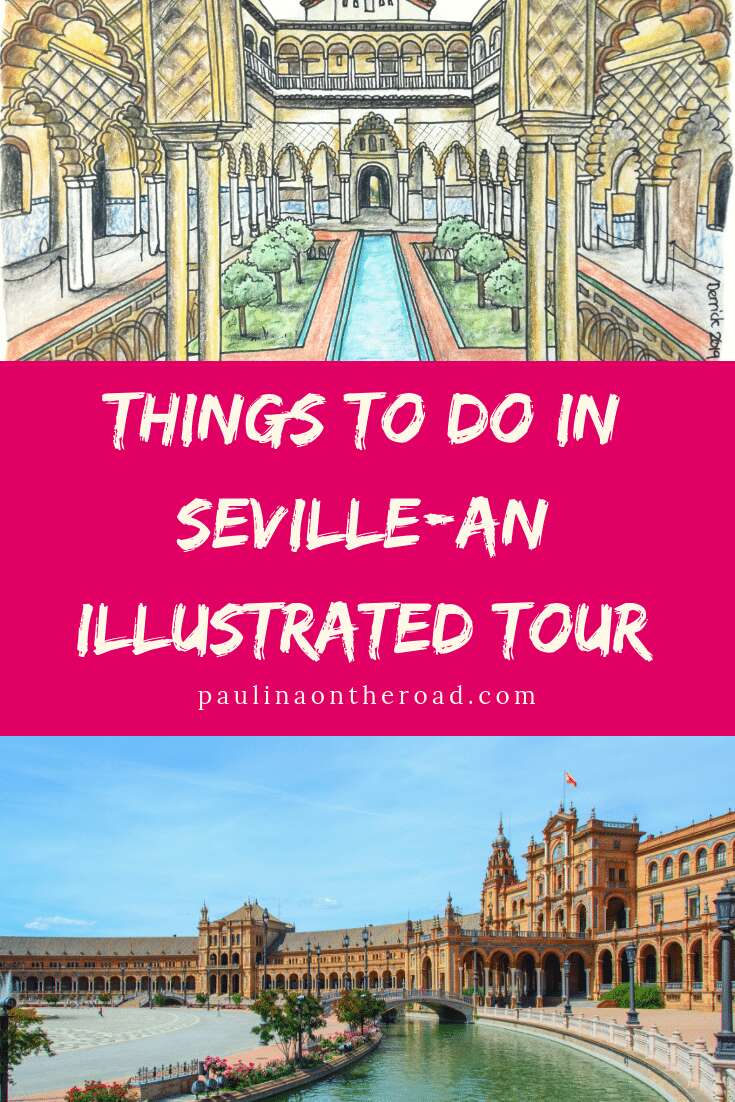
Hola, I’m Paulina! Together with my team, we are passionate about Southern Spain. Here we share all you need to know for great times in Southern Spain with the best places to visit, stay and, of course, the best food to eat.
Let’s dive in and explore Southern Spain’s outdoors, food and culture con pasión!

15 best things to do in Seville (with tourist map)
Written by Maartje
Seville is one of the most popular city trip destinations in Spain and all of Europe and we can absolutely understand this. The stunning city in Andalusia combines a wonderful climate – with pleasant temperatures even in winter – with yoone of the largest historic cities centers in the world. It is simply impossible to get bored during a city trip to Seville and all historic sights and beautiful monuments will keep you entertained for days. So what are the best things to do in Seville? Read this blog to learn about the most beautiful sights of Seville, including practical tips and a Seville tourist map.
Did you know: Seville has its own international airport and you can easily find affordable flights to Seville ?

Why Seville is definitely worth a visit
The rich architecture and history.
Seville is known for its charming alleys, city walls, flamenco theatres, arches, churches, squares, monuments, palaces and more churches. A city usually has its sight concentrated around a cathedral, central square or castle, but Seville is different. There is not just small section with historic buildings. The splendor of Seville seems to never stop! The city has one of the largest historical centers in the world and there is so much to see and admire.
The reason for this is the rich history of Seville. Rich in the sense of money, but also rich in the sense of culture. From the Visigoths to the
From the Visigoths to the Romans to the Islamic Moors to the Christian monarchs, they all left their mark and created one of the most beautiful cities in Europe. The Islamic Moors in particular have enriched Seville into the monumental city it still is today. The architecture of the Moors from North Africa was unprecedentedly refined, developed and large-scale. Over a period of more than five hundred years, Seville was built up with the most beautiful buildings and many of them are still there today.
The unique Mudajar architectural style
The Moorish buildings were so beautiful that when the Moors were expelled and Seville became part of a Christian kingdom, the architecture has been preserved. To erase the Moorish influences, the buildings were Christianized. So old mosques were decorated with Christian saints and reused as churches. The result is a special architectural style that you only find in Spain – and sporadically in Portugal. The Mudejar style is a beautiful combination of Muslim and Christian architecture , and Seville is arguably the best place to admire it.
Later in history, architects were still impressed by the Mudejar style. This inspired them to introduce the Neo-Mudejar style in Seville. In the 1920s and 1930s, the old Mudjar style was reintroduced, but with a contemporary twist. Famous highlights like it Plaza de Espana and the Hotel Alfons XIII are good examples of this unique reincarnation of the old Moorish and Christian architecture.
The most important commercial city of colonial Spain
But before we jump from the Moors to the 1930s, it is worth mentioning Seville’s wealth as a colonial trading city . The river port of Seville was the most important in Spain and the exclusive place where all ships returned from the Spanish colonies. They brought tobacco and other precious merchandise, so Seville prospered. This resulted in a golden age with impressive monuments and a large expansion of the historic city center. Seville lost its special position when the Spanish ships became too large to reach the city by the river. The most important colonial port was moved to Cadíz, conveniently located on the coast.
So why is Seville worth a visit? Its rich history translates into an old city full of monuments, creating one of the largest Old Towns in the world. Add to that a pleasant Spanish atmosphere and a wonderfully warm climate and you understand why the city should be on your bucket list.

The neighborhoods of Seville: where to stay?
If you are looking for accommodation in Seville, it is good to first choose which neighborhood you’d like to stay. The old center of Seville is large and although all sights are within walking distance, the different neighborhoods offer a different atmospheric.
The best neighborhoods in Seville’s city center are:
- Centro with the iconic Metropol Parasol and the major shopping streets
- Barrio de Santa Cruz, also called the Jewish Quarter, with the Real Alcázar and the Cathedral
- Barrio del Arenal with the Hospital de Carridad and the Torre del Oro
- Barrio San Vicente with great restaurants and hip hotspots
- Maria Luisa Park with the famous Plaza de España
- Barrio de la Macarena packed with churches and also the Palacio de las Dueñas
- Barrio de la Triana, a working-class neighborhood on the other side of the river, where flamenco once originated
We recommend to stay in either Centro, Santa Cruz, Arenal or San Vicente . These districts are most centrally located between the sights, so you’ll get to stay right between the beautiful highlights of Seville. Santa Cruz is often praised as the best neighborhood in Seville and we can agree to that. The narrow alleys, squares with orange trees and beautiful vistas make this the most charming part of the city. Yet the other neighborhoods we mentioned are so close to it and they also have a lot of that charming atmosphere that we would just as well choose Centro, Arenal or San Vicente. As Santa Cruz is very popular, most hotels are quite pricey and the other areas offer more affordable places to stay in Seville.
Hotels or hostels in Seville we can recommend:
- Hotel Amadeus & La Musica for a small-scale hotel in a picturesque alley with stylish design rooms.
- Hotel Alfonso XIII for those who have a big budget and want to sleep in one of the most famous and luxurious hotels in the city.
- Hostal Sierpes for a budget-friendly family hotel in a seventeenth-century monument surrounding a patio.
- Adriano Boutique Hotel with classic boutique rooms in the heart of Santa Cruz.

How to get around Seville
On foot around seville.
The historic center with the famous highlights of Seville is quite large. Yet you can reach everything very well on foot , if you’re fit and don’t mind running your pedometer overtime. Make sure to map out a convenient route, so that the distances remain manageable.
Tip: do you want to explore the old town on a free tour of Seville with a guide? There are several free walking tours available and we can highly recommend them. You simply pay the guide afterwards what you believe the tour was worth.
By bike or electric scooter
If you want to cover the distances more easily, using the local bicycle or electric scooter system is a good option. The city center has many safe and seperate bike lanes , making it easy to cruise around. You can rent a bike for a day at several places. But you can also use Sevici , the self-service bike rental system you’ll find all over the old town.
Tip: if you want to see as much of Seville as possible in a short time, a guided bike tour is highly recommended.
You will also see many electric scooters and steps in the old town. Would you also like to tour the city on an electric scooter or scooter? Then look for the electric steps from Voi and mint green scooters from Yego. You can easily and fairly cheaply rent them via an app .
Not recommended: horse carriages
You will probably also see horse-drawn carriages everywhere in the old center to ride tourists around during a romantic trip along all the beautiful highlights. That sounds very idyllic, but we wouldn’t recommend you to do it.
We don’t like the use of animals as tourist attractions . We believe that’s not what animals are meant for and we have noticed many times that the animals working in tourism aren’t treated well. Even if it seems that the animals have a good life, you just can’t determine this as a tourist and we would simply choose not to opt for a horse carriage.
If you like being driven around old Seville, you could opt for the Hop-On Hop-Off Buses . These are included in the Sevilla Pass, as is the entrance ticket to the Royal Palace and the Cathedral.

Our Seville tourist map
What to do in Seville: 10 must-see highlights
#1 plaza de espana.
The most beautiful square in Seville and most impressive landmark is the Plaza de España, or: the Square of Spain. As a Star Wars enthusiast, this square may look familiar to you. It actually appeared in Star Wars Episode II. But even without having seen this film, you have probably seen photos of this beautiful square. It is no less than 160 meters wide and has spectacularly beautiful architecture !
It was built in 1929, when Sevilla hosted the World Expo . The world exhibitions usually leave many spectacular marks in the cities hosting them, like the Eiffel Tower in Paris and the Atomium in Brussels. That is exactly what the Plaza de España is for Seville.
The square is shaped like a semicircle. An open form was deliberately chosen to give visitors a warm welcome in this new symbol for Spain . A colonnade and beautiful buildings were erected along the edge of that semicircle, where government offices are now located. One of our top tips for Seville is the viewpoint over the square. The facade protrudes slightly in two places. At those places, you can take the stairs up to have look over the square from the balustrade.
Along the edge of the square all provinces of Spain are represented in alphabetical order in a tile tableau with a seat, where people often sit on sunny days. Another way Spain is represented in the square is in the four bridges. The country was once divided in four kingdoms – León, Castilla, Aragon and Navarre – and the four bridges each symbolize a kingdom. The bridges cross a canal and there are small tourist boats to enjoy the square from the water.

#2 The Royal Palace: Real Alcázar de Sevilla
Seville has the oldest royal palace in the world that is still used in that function. There may be older palaces, but they are no longer used by the royal family like that of Seville. When the Spanish King and his family are in Seville, they are allowed to stay in their palace and the palace is closed to visitors. The gardens are still open though and because of this lack of privacy the royal family usually chooses to stay in the prestigious Alfons III Hotel. Nevertheless, the people of Seville are proud to boast of their palace as the oldest royal palace in the world that is still in use .
Aside from that extra significance as a real royal palace, the Real Alcázar is one of the most beautiful structures in all of Spain. It is a unparalleled piece of architecture in which Moorish and European influences are intertwined, a typical example of the Mudajar architectural style. The palace complex is made of mosaic, arches, domes, passages, carvings and more beautiful details. The unique architecture will keep your eye entertained for hours.
Don’t miss the gardens of the Royal Palace. They are huge and just as beautiful as the palace. Game of Thrones fans should recognise the gardens from the many scenes that were shot here. The gardens have been used as a film set for the fictional Game of Thrones area of Dorne. The impressive Baths of Lady María de Padilla with that beautiful vaulted ceiling? That was where the Sand Snakes forged their plots.
You can buy tickets for the Real Alcázar on the spot, but then you will have to queue twice. First at the ticket office and then once again at the entrance. You shouldn’t be surprised if tickets are already sold out, as we unfortunately experienced when we wanted to visit the palace the first time. And that was even in the low season during the winter months. We recommend you to book your tickets online af the official palace website in advance. Are you traveling on a strict travel budget? Then we have the perfect tip for Seville: entrance to the Real Alcázar is free each Monday at the end of the day. Beware that you need an online ticket for this free entry as well – for which you pay a € 1 administration fee per person – and those are already sold out well in advance. Entry to the Real Alcázar is included in the Sevilla Pass.

#3 The Cathedral and Giralda Tower
The Catedral de Santa María de la Sede is one of the largest churches in the world. Only St. Peter’s in Rome and St. Paul’s in London are bigger. The monument is on the UNESCO World Heritage List and is one of the city’s best-known tourist attractions. The history of the cathedral began when Seville was part of the Moorish Empire and the Muslims built their mosque at this exact location. After the city was conquered by the Christians from the Moors, the mosque was reused as a cathedral. Christian elements were added, creating a unique mix that we now call the Mudajar architectural style.
The literal pinnacle of the cathedral is the Giralda , the bell tower of 104 meters high. You can see this tower from almost every street in the old town. Does it remind you of a minaret? That might be right, as that’s what the tower was originally. The Moorish influences are still clearly recognizable in the square tower, but supplemented with Christian saints and other Christian references. One of those later additions is the Giraldillo, the Christian statue on top of the bell tower that can turn with the wind like a weather vane. The tower has been preserved over the centuries. The Moors were known for their phenomenal architecture. Even when parts of the city were destroyed by earthquakes, the Giralda survived.
The Moors also built a clever piece of art inside the Giralda. The first part of the towers consists of ramps instead of stairs. This way visitors could easily get up on a donkey. Nowadays you don’t have that luxury and you will just have to climb all the way up to the top. The beautiful view of the old city is well worth the effort though. It is still prohibited to build anything higher in the old town than the Giralda, so you can see all of Seville from the top.
Admission to the Cathedral and Giralda Tower is included in the Seville Pass. You can get tickets at the Cathedral, but if you want to skip the line, buy your tickets online in advance.

#4 Metropol Parasol: Setas de Sevilla
In a city where historic buildings and monuments fill every street, the Metropol Parasol is a surprising building. It is the largest wooden construction in the world with dimensions spanning the entire square. The design consists of six umbrellas that are connected to each other. It is also called the Setas de Sevilla by locals: the mushrooms of Seville.
Construction work for a parking garage once took place at the square. As centuries-old remains from Roman and Moorish times were found, the project was halted. Only many years later a new attempt was made to redevelop the square. There was a design contest and the impressive wooden creation we know now was the winning design. The building was completed in 2011, after which it quickly became one of the city’s famous tourist attractions.
You can simply walk on the elevated square, under the umbrellas and admire the beautiful structure from below. But if you want to see more of the Metropol Parasol, you can walk on top of it as well! Go into the cellar – where those Roman and Moorish excavations can also be seen – and buy a ticket there for a walk at the top . A walking path has been laid out over the umbrellas with a beautiful view of the artwork itself and of course the city.

#5 The Jewish Quarter: Barrio de Santa Cruz
The most beautiful neighborhood of the historic center is Barrio de Santa Cruz, the historic Jewish quarter. It has two of Seville’s biggest tourist attractions, the Real Alcázar and the Cathedral, surrounded by a maze of streets and alleys .
Wandering through this neighborhood is one of the best things to do in Seville. It has many narrow alleys, cobbled streets and small squares with orange trees or historic churches with colorful facades. Marvel at the picturesque vistas and beautiful buildings and just get lost . Barrio de Santa Cruz has many restaurants with sunny terraces, so this is also the perfect place for an authentic lunch while watching the people strolling past the terraces.
You inevitably end up at the imposing city walls of the Royal Palace. The Jardines de Murillo gardens also run along the walls, where you can see huge trees and enjoy some shade and tranquility.

#6 Parque de Maria Luisa
The Maria Luisa Park is the green lungs of Seville . It is a dizzyingly large park that runs along the Guadalquivir River. You’ll find it just south of most attractions and right next to Plaza de España.
The park is named after Maria Luisa, the Spanish princess who donated the parks to the public. Until then, the park was part of the private gardens of the Palacio de San Telmo . The park got a major transformation when Seville hosted the World Exhibition. The Plaza de España was built on the edge of the park and several pavilions were built in and around the park. The remnants of the World Exhibition are still some of the most beautiful buildings in Seville.
Make sure to visit Plaza de America , named after the American pavilion that was built here. It is a beautiful square with equally beautiful buildings, of which the Museum of Popular Arts and Traditions is the most impressive. It is built in a Neo-Mudajar style, a modern version of Moorish-Christian architecture from centuries earlier.
We also recommend you just relax in the green park by making a long walk. There are ponds, statues, fountains, gazebos, small monuments, larger pavilions, benches, ancient trees, wide avenues and narrow paths. The park is the perfect place to feel far away from the busy city and enjoy nature.

#7 Real Fabrica de Tabacos
This beautiful building in the old town of Seville was once a tobacco factory . At a time when mostly men had work, this was one of the main employers for women in the city. Women, with smaller hands and greater precision, were said to be the perfect workers for rolling tobacco.
Because tobacco was still a very exotic and also precious commodity at that time, the ladies were checked daily to prevent them from taking their work home. The tobacco factory even had its own chapel to immediately do penance for these kinds of sins and a own prison to cool down for a while. Not for too long of course, as the factory had to keep running and every pair of hands missing meant less production. The Real Fábrica de Tabacos was even surrounded by a ditch , making sure the precious goods were well protected like a medieval fortress. The canal is now empty and even trees grow in it, but you still have to cross it to visit the old factory.
The impressive monument is now home to the university . There are several university buildings in the city, but this is the most important and the most beautiful one. It is open to the public, so be sure to take a moment to visit the inside as well.

#8 Hotel Alfonso XIII
The World’s Expo in Seville has left more traces in the city than just the famous Plaza de España. In order to accommodate all those visitors, a monumental hotel was also built: the Hotel Alfonso XIII . It was already one of the most luxurious hotels in the world then and it still is. The property was built in Neo-Mudajar style , a modern version of Moorish-Christian architecture centuries earlier. Interestingly enough, the building looks extravagant and beautifully luxurious, though cheaper materials such as bricks and plaster were used for construction.
Inside the hotel has kept the glory of past times. The marble floors and huge banquet halls with chandeliers still exude wealth and luxury. Named after the king who then ruled Spain, it is still a place of royal allure today. Although the royal family of Spain can use their own royal palace in Seville, they usually prefer Hotel Alfonso XIII. Other famous guests include Prince Charles and his then wife Diana, as well as stars such as Angelina Jolie and Madonna.
Would you like to visit the hotel yourself? Certainly do! A night at Hotel Alfonso XIII is not cheap , but you’ll stay in the most beautiful and famous hotel in Seville. If that is a bit above your budget, it is good to know that you can also enjoy a cup of coffee in the hotel restaurant without being a hotel guest. We just asked the lady at the reception if we could take a look and that was no problem as well.

#9 Archivo de Indias
Located right next to the cathedral and the Royal Palace, the Archivo de Indias was the place for trade. The city was once the main trading center for overseas and colonial trade, so the wealth was endless. Seville needed a commercial building fitting that wealth and this monumental building was erected to house the overseas and colonial trade. This created a triangle on the central square between politics (palace), religion (cathedral) and economy (commercial building).
When Seville became less important as a commercial city, this building became superfluous. Fortunately it has been beautifully preserved. It’s now a archive for colonial documents , like maps and mission reports. Exhibitions are also often organized.
When we visited Seville, there was a large exhibition dedicated to the local trading history, showing maps, historical paintings and replicas of ships. Unfortunately, the exhibition itself was only signed in Spanish, but the entrance was free and allowed us to take a look at the inside of the Archivo de Indias.

#10 Hospital de la Caridad
One of the hidden gems of Seville is the Hospital de la Caridad, located in the Arenal district. It was the headquarters of the Christian brotherhood Hermandad de la Caridad and the hospital where the sick and homeless were cared for. Such a holy place also needed a church to honor God and that became one of the most beautiful baroque churches in town .
When the wealthy philanthropist Miguel de Mañara became the head of the Order of the Brothers in 1662, he decided to found the hospital. Until that time, the Order of the Brothers was mainly concerned with assisting and later burying those sentenced to death, collecting corpses after floods and such gruesome jobs. But with the arrival of this wealthy benefactor, the living could also count on the support of the Order of the Brothers. A homeless center, a hospital and the Hospital de la Caridad with its beautiful baroque church were built.
The church was completed in 1670 and is now the main reason to visit this landmark. When you enter the Hospital de la Caridad, you will first pass through the old hospital next to the church. You will cross a beautiful courtyard with historic Delft blue tile tableaus . But the Baroque church itself is the highlight. The church has a beautiful but simple classical facade from the outside, but the interior is very exuberant.
The church is beautifully decorated inside. Although it’s not very big, it certainly makes an impression! The plasterwork with decorations from wall to ceiling and a lavish golden altar immediately catch the eye. But the real eye-catchers are the paintings of the famous Spanish painter Murillo . He made six paintings about mercy for the Baroque church. Four of them were stolen during a war in 1810 and were scattered around the world. They are now in museums in London, Ottawa, Washington and St. Petersburg. Replicas therefore hang in their place, making the church looks as it was once intended. Because of this only two works of Murille are original. Which ones? The lower one on the left wall – Saint John with a sick man – and the lower one on the right wall – Saint Elisabeth healing a sick person – are still in their original place.
Tickets are €8 and audio tours €1. But every Monday at the end of the day, you can visit the Hospital de la Caridad for free .

#11 Torre del Oro
The Torre del Oro is one of the great icons of Seville. This massive tower stands on the Guadalquivir River bank. The lower, dodecagonal part of the tower was built as early as the thirteenth century, so back in Moorish times. It was part of the city walls that protected the old city. The central part is dodecagonal and was added in the fourteenth century. The round spire dates from 1760.
Why it is called the Torre del Oro – or Golden Tower – is not entirely clear. It could refer to the gold that entered the city at this location once via the river, or to the city’s golden times as a colonial trading port. But it is also said that the tower is built of a material that contains straw, giving the tower once a golden glow in the sunlight.
The tower now houses a maritime museum. Tickets are only €3, but you can visit the museum for free on Mondays. From the top you have a beautiful view over the river, bridges and the working-class district of Triana on the other side. Do you also want to see the silver little sister of the Golden Tower? The Torre de la Plata is located nearby in a somewhat less impressive location – next to a parking lot – not far from the Torre del Oro. The two towers were once connected by a city wall.

#12 Plaza de Cabildo
One of the hidden gems of Seville is right next to the famous cathedral: the Plaza de Cabildo. This square has the shape of a half oval and is completely surrounded by buildings and part of the old city wall. You can get to the square via three passages under the apartment building, one of which is opposite the official but unused main entrance to the cathedral.
Along the Plaza de Cabildo is a part of the historic city wall, in front of which is a fountain. But it is the buildings that make this square so special. It consists of a gallery with marble columns, and above it three floors, two of which have balconies. It is a beautiful structure of marble, simple white plaster and colorful frescoes . The frescoes are located between and above the columns, but also at the very top under the eaves. So don’t forget to look up when you walk across the square.
The gallery now houses shops, but it is mainly an oasis of calm in the busy center of the city. Except on Sundays, because then the Plaza de Cabildo hosts an antique market where you can buy coins, stamps, historical medals and other antique items.

#13 Palacio de las Dueñas
We usually prefer not to include a highlight that we have not visited ourselves, but we have heard so much good about this Seville attraction that we do not want to leave it out of this list. Unlike, for example, the Royal Palace, in the Palacio de las Dueñas still has furnished period rooms and an impressive art collection.
The palace is owned by the House of Alba , a noble family with a long lineage. You might have heard of the Duchess of Alba , an extraordinary Spanish socialite who was often in the tabloids for her striking outrages and in the Guinness Book of Records as the person with the most noble titles. She married a much younger man in the family palace at the age of 85, something even the Spanish king spoke out against.
The beautiful palace is one of the oldest city palaces in Seville. It was built at the end of the fifteenth century. The architectural style is a remarkable mix of Mudajar, Gothic and Renaissance. It has a number of colonnaded courtyards with exotic plants and fountains. Many of the rooms are decorated, making the palace really come to life. A unique part of the palace is its art collection with many antique tapestries, but also a large collection of historical football posters.
Tip: if you’re still not bored of the Seville palaces after visiting the Real Alcázar and Palacio de las Dueñas, there is one more gem to visit. The Casa de Pilatos is also said to be a beautiful city palace with a similar architecture to the Palacio de las Dueñas.

#14 A free walking tour
Do you want to visit as many highlights of Seville as possible in one go? And learn more about the history, legends and best places to visit in Seville? Then join a free walking tour as we did. We are big fans of this concept and have joined these types of city walks with a local guide all over the world.
You can find many different tours in Seville only. You’ll have to register in advance, so the guides know what to expect from the group size. After gathering at a convenient starting point, the local guide will lead you along the most beautiful Seville sights. The guided tour is free, although you are supposed to pay a tip at the end, depending on what you can spare and what you think the tour was worth. Big tourist destinations like Seville have several tours at several times, so you’ll always find one that fits your travel plans.
Our guide took us to most of the big sights, while telling us anecdotes and stories about Seville and his history, some of which ended up in this blog as well. A tour is a fun way to see a lot of the city in two to three hours. So especially if you are in Seville for a short city trip and don’t have much time, this is a very efficient way to explore the city .

#15 Restaurants in Seville
As one of the biggest tourist destinations in Spain, Seville offers many great restaurants, tapas bars, coffee spots and hotspots. The neighborhoods of the old center have many lovely squares with terraces, where you can enjoy a drink and some tapas . The historic neighborhood of Barrio de Santa Cruz is the perfect place for this.
We can also recommend you to visit the Seville mercados , the local covered markets. There are many of them in the city and locals use them for grocery shopping or having a quick lunch. Mercado de Triana is the most famous and one of the oldest markets in the city. It has stands with vegetables, fruit, fish and meat and is used by locals to buy their groceries. It is one of the best places to visit in the Triana district. Another recommendation is the Mercado Lonja del Barranco, which is a more trendy counterpart to the Triana market. It is a modern food court with a bar, where mainly the young locals come. A third recommendation is the Mercado de Feria, where you have a fish market as well as trendy bars and places where locals come for their lunch.
Are you looking for the hip hotspots of Seville ? Filo is a nice but very small lunch spot for mainly healthy food. Large salad bowls and fine sandwiches are on the menu. For a well-priced breakfast, we recommend Almazen Café. It is also a popular spot for digital nomads, as the wifi is good and the juices are tasty. If you’re looking for another digital nomad spot, then you should definitely visit Caótica. This bookstore coffee spot is full of people working on their laptops. La Cacharreria is a popular spot for lunch. This is the perfect place for pancakes, avocado toast and bagels. Speaking of pancakes: we also really liked La Mala. This fine brunch spot is very cozy and is located in a cozy street, where you can also get a table at their terrace.
As a coffee lover, Sebastiaan has tried all of the best coffee spots in Seville . Strangely enough, the best specialty coffee spots in the city are not hip hotspots with stylish interiors and cozy corners and seats, but white and simple bars where people simply come for excellent coffee. Great options are Hispalis Café, Virgin Coffee, Jester, Parceria Café and Borbotea Coffee Lab. Borbotea was the only good coffee bar with a cozy interior that makes you want to stay and enjoy your coffee inside.

Best things to do outside Seville: the best day trips near Seville
#1 the western village of el rocío.
The picturesque El Rocio is known as a pilgrimage destination , but only at Pentecost when the city is overrun by thousands of visitors. The rest of the year, the small town is a lot quieter and visitors come mainly to taste the unique western atmosphere.
El Rocío is like a western movie set, where you would expect to see a cowboy on horseback riding by. The white houses, dusty dirt roads, locals on horseback and historic porches in front of the houses seem to belong in the wild west. It’s like a time machine bringing you to the old days of the wild west. The town is designed for horses and horse-drawn carriages. The horses and covered wagons now seem to be mainly used for tourists, but the town still clearly shows how this was once the standard. The many large squares with grass fields in the center show where the horses used to graze. And do you notice those wooden beams in front of all the houses? They were used to tie the reins of your horse.
Tip: from Seville you can book a guided day tour to El Rocío during which you also visit the lovely Matalascañas beach.

#2 Doñana National Park
Southwest of Seville is the Doñana National Park, which is also well worth a visit. The park is a gigantic swamp area with special flora and fauna , such as flamingos and deer that we both spotted in the park. There are also rare lynxes in the park, but it is very hard to see on of them.
You can enjoy beautiful hikes in the park. You can walk the Camino de Moguer, where you explore a beautiful part of the park. Other scenic hiking trails start from the three visitor centers in the park. These are mainly short walks, varying from more than 2 kilometers (from the visitor center of La Rocina) to 7 kilometers (from the visitor center in the white palace Palacio del Alcebrón).
Tip: from Seville you can book a 4×4 tour in Doñana , where you explore the park in a rugged 4WD car.

#3 Picturesque Carmona
Only a fifteen-minute drive from Seville is the cozy village of Carmona, one of the hidden gems of Andalusia . For centuries, this strategic hilltop site has been inhabited, conquered from enemies and developed with the most beautiful structures. From the Carthaginians to the Romans and from the Moors to the Christians, they all left their mark on this beautiful town.
When visiting Carmona you will probably enter the historic center through one of the two gates at the old city walls. Especially the Puerta de Sevilla is very impressive to see. From this city gate, the Alcazar palace is hard to miss. The old palace is located on top of this city gate and was once a Roman fortress to defend the city. Be sure to visit the Santa Maria Church, which was once a mosque before it was reused as a catholic church. You can still recognize the old minaret in the church tower, just like the Giralda tower of the Cathedral of Seville.
If you have enough time, we also recommend a stop at the Roman necropolis just outside the city. This necropolis dates from the second to fourth centuries BC. You can still see the remains of a system of corridors, an amphitheatre and a crematorium. Admission is free for EU residents.
Tip: from Seville you can visit Carmona with a guided tour , including a visit to the Roman necropolis.

#4 The Roman Ruins of Itálica
Just north of Seville, you can visit the ancient ruins of the Roman city of Itálica, which is one of the best-known day trips from Seville. It was one of the first Roman cities in nowadays Spain and therefore one of the more important places for the Romans. Did you know that the Roman Emperors Trajan and probably also his successor Hadrian were born in Itálica?
The archaeological park is located in the village of Santiponce, under which part of the Roman ruins are still buried. Only part of it has been excavated, but even that is impressively large. You can see the remains of an amphitheatre, temples, bathhouses, aqueducts, houses and temples. Particularly impressive are the mosaics in the old houses .
The amphitheater is especially a great place to visit for Game of Thrones fans. Some key scenes from Season 7 were filmed here, in which the remaining competitors for the throne of Westeros gathered in the dragon pit to discuss what to do about the white walkers. The archaeological park is free to visit for EU residents.
Tip: from Seville you can visit Itálica with a guide , also stopping at the medieval monastery of San Isidoro del Campo.
Save this pin for later:

Related Entries
Southern spain road trip itinerary: best places to visit on your andalusia road trip.

10 best things to do in Avilés, Spain

21 best places to go for a 21st birthday

10 best things to do in Granada in Spain

Must-Visit Attractions in Seville, Spain

Seville, Spain , has something for everyone. From its great Moorish and Catholic monuments to its historic bullring, and from great tapas bars to enchanting old neighbourhoods and giant wooden mushrooms, these are the top attractions for you to seek out while you’re in the Andalusian capital.
See the best of Seville on our small-group four-day Mini Trip – besides exploring the city’s top sights, you’ll also visit nearby Cadiz and Jerez.
1. Royal Alcazar Palace
Building, Cathedral, Historical Landmark

2. Cathedral
Cathedral, Mosque

Become a Culture Tripper!
Sign up to our newsletter to save up to 500$ on our unique trips..
See privacy policy .
All that remains of Seville’s great mosque is part of its minaret, which is now the cathedral’s Giralda bell tower, another of Seville’s key architectural attractions. The minaret, which was built during the Almohad period, was originally topped with giant copper globes, but these fell off in an earthquake in 1365. The ruling conquistadors , perhaps interpreting their removal as a hint from the universe, decided to replace them with a Christian cross and bell tower. Except for the final section, which features stairs, the route to the top (for stunning views) is via ramps – supposedly so it can be reached by horseback, although it’s unclear whether this means you have to buy two tickets or just one.
3. Casa de Pilatos

4. Bullring
Building, Museum, Sports Center

5. Torre de Oro

6. Plaza España
Building, Memorial

7. Maria Luisa Park
Botanical Garden, Museum, Park

8. Archivo de Indias

9. Restaurant Al Aljibe
Restaurant, Market, European
Al Aljibe is one of the best tapas bars on the Alameda de Hercules , Seville’s trendiest and most popular nightspot. The restaurant boasts a romantic and secluded first-floor terrace overlooking the Alameda, as well as an exclusive rooftop patio with just a few tables. Bear in mind that only full plates – or raciones – are served on the rooftop seating area, although ordering bigger portions of Aljibe’s incredible food won’t be a problem. Customers rave about the ox burger, the fried cod with vegetables and the duck and brandy paté. Inside, there is seating spread over two floors, but it’s always worth reserving a table, especially in the evenings. Aljibe’s location and food have made it one of the most popular high-class tapas places in town.
Triana is Seville’s former Gypsy quarter and one of the city’s most distinctive attractions. From its pretty, myth-laden streets have come some of the most influential bullfighters of the last couple of centuries, including the legendary Juan Belmonte, one of the greatest matadors in the history of bullfighting. Its colourful, quaint streets are lined with old-style tapas bars, the walls of which are often plastered with faded bullfighting posters, photos of flamenco artists and weeping Virgin Marys. It is also known for its locally made ceramics, which adorn the walls of its old, whitewashed houses, and one of Seville’s best and most lively markets , the Mercado de Triana .

10. Bar Bodega Santa Cruz
Bar, Spanish, Mediterranean, Tapas, Wine, Beer, Cocktails, Pub Grub

This lively tavern is one of the best in central Seville and is a great place to start your exploration of the romantic, intriguing neighbourhood of Santa Cruz. Owing to the scarcity of outside seating, it always seems as if a spontaneous street party is going on outside, with eaters and drinkers taking over the pavement in front of the bar. The food and drink offering is traditional, with a range of wines and sherries available, as well as excellent tapas at about €2 a pop. It’s particularly good for an early evening stop-off, when the atmosphere is joyfully chaotic.
Surrounding the central plaza on which Seville’s mighty cathedral squats is the charming old Jewish neighbourhood of Santa Cruz , one of Andalusia’s most iconic barrios. This was the neighbourhood into which Ferdinand III confined the city’s Jewish population when he took the city from the Moors in 1248; nowadays, it’s the heart of historic Seville and the first place many tourists head to. In this maze of narrow cobbled streets and achingly romantic squares are to be found some of the city’s best tapas bars and flamenco joints , but just to wander around Santa Cruz (almost certainly getting lost, if it’s your first time) is an experience in itself.

11. Bar La Bodega
Bar, Spanish, Tapas, Wine, Beer, Cocktails, Pub Grub

Slightly surly service is the price to pay for enjoying sweet wines, sherry and tapas in this local institution. La Bodega is well established on the tourist route in Santa Cruz but Sevillanos love it too, piling in in huge groups from about 2pm for lunch and about 9pm for dinner. These are the best times to head to La Bodega for a glass of the signature manzanilla (old barrels are scattered around the place) and a plate of their excellent tapas , either crammed in amongst Sevillanos at the bar or, if you’re lucky, at one of the tables.
12. Romeo and Juliet Balcony

Feria de Abril
The Feria de Abril , Seville’s legendary fiesta, takes place two weeks after Easter and is one of Andalusia’s biggest fairs. This week-long party has left its humble 19th -century cattle-market beginnings long behind, and its sanded fairground – or recinto – now hosts over 1,000 individual marquees, or casetas , every year. Run by local charities, businesses and collectives, these casetas are where the locals dance and drink until the small hours of the morning, every night for a week. Although the vast majority of the marquees are private and require an invitation for entry, there are several public casetas which are just as much fun. If you’re planning a visit to Seville in spring, make sure you plan it to coincide with this annual extravaganza.
13. Las Setas
Building, Cathedral

14. Cafe-Bar Los Alcazares

Situated underneath the vast canopies of Seville’s Setas on the popular Plaza de la Encarnación is Los Alcazares, one of the best tapas joints in central Seville. From its small, traditional bar room or outside terrace you can watch life unfold on the busy plaza while sipping on a cold beer or sweet manzanilla. Alcazares is popular with tourists, but the old-fashioned décor (think bullfighting and fiesta posters) and its popularity with nearby office workers who stop in for a quick tapas and beer at lunchtime mean it doesn’t feel touristy.
Explore more of Andalucia on our four-day Mini Trip to Málaga and Granada – or head north to Bilbao for a four-day foodie tour of the Basque Country . If you’re after a city break, join our four-day Mini Trip to Barcelona and discover the best art and architecture in the city.

KEEN TO EXPLORE THE WORLD?
Connect with like-minded people on our premium trips curated by local insiders and with care for the world
Since you are here, we would like to share our vision for the future of travel - and the direction Culture Trip is moving in.
Culture Trip launched in 2011 with a simple yet passionate mission: to inspire people to go beyond their boundaries and experience what makes a place, its people and its culture special and meaningful — and this is still in our DNA today. We are proud that, for more than a decade, millions like you have trusted our award-winning recommendations by people who deeply understand what makes certain places and communities so special.
Increasingly we believe the world needs more meaningful, real-life connections between curious travellers keen to explore the world in a more responsible way. That is why we have intensively curated a collection of premium small-group trips as an invitation to meet and connect with new, like-minded people for once-in-a-lifetime experiences in three categories: Culture Trips, Rail Trips and Private Trips. Our Trips are suitable for both solo travelers, couples and friends who want to explore the world together.
Culture Trips are deeply immersive 5 to 16 days itineraries, that combine authentic local experiences, exciting activities and 4-5* accommodation to look forward to at the end of each day. Our Rail Trips are our most planet-friendly itineraries that invite you to take the scenic route, relax whilst getting under the skin of a destination. Our Private Trips are fully tailored itineraries, curated by our Travel Experts specifically for you, your friends or your family.
We know that many of you worry about the environmental impact of travel and are looking for ways of expanding horizons in ways that do minimal harm - and may even bring benefits. We are committed to go as far as possible in curating our trips with care for the planet. That is why all of our trips are flightless in destination, fully carbon offset - and we have ambitious plans to be net zero in the very near future.

Places to Stay
The best family-friendly hotels to book in seville, spain.

The Best Luxury Hotels to Book in Seville, Spain

Where to Stay in Seville, Spain, for a Local Experience

The Best Boutique Hotels in Seville

The Best Hotels with Pools in Seville

The Best Spa Hotels in Seville


See & Do
The most beautiful gardens in seville, spain.

The Best Beaches in and Around Seville, Spain

The Best Day Trips From Seville, Spain

Unusual Things to Do in Seville, Spain

Must-Visit Museums in Seville, Spain

Historical Monuments in Seville, Spain
Culture trip spring sale, save up to $1,100 on our unique small-group trips limited spots..

- Post ID: 1327809
- Sponsored? No
- View Payload
Join Me On A Mouthwatering Adventure: Exploring Delectable Destinations Across the Globe

Gastro Travelogue

The Ultimate Guide to Seville: Top 17 things to do in Seville Spain
Planning a trip to Seville and wondering what the best things to do in this vibrant city are? Well, you’ve come to the right place! Whether you’re a history buff, a foodie, or simply in search of some authentic Spanish culture, Seville has something for everyone.
Seville is located on the Guadalquivir River and boasts one of the largest historic centres in Europe It is also without a doubt one of the most beautiful towns in Spain .
There are so many things to do in Seville, some of which came as a total surprise to me, and I was delighted that a happy accident had brought us there.
From exploring the stunning Alcázar palace or taking a leisurely stroll along the Guadalquivir River, to indulging in mouthwatering tapas and immersing yourself in flamenco performances , this charming Andalusian gem promises an unforgettable experience. So grab your walking shoes and get ready to discover the best that Seville has to offer – let’s dive in!
You could easily spend a week exploring the attractions in Seville but we only had 3 days to work out what to do in Seville so it was an action-packed couple of days.
Gastrotravelogue uses affiliate links. When you click on an affiliate link and purchase a product or service I will receive a small commission. Please note that this does not cost you anything extra.
Useful information about Seville
Where is seville.
The Province of Seville (Spanish: Sevilla ) is a province of southern Spain and is in the southwest of Spain. The area is also called Andalusia and Seville is the capital.
Why visit Seville?
Seville is rich in history, culture, architecture, UNESCO World Heritage sites and delicious food. It is a great place to base yourself to explore the picturesque Andalucía region of Spain.
Weather in Seville Spain
Like anywhere, when the weather is good the city is just so much more enjoyable and Seville is a year-round destination. However, the temperatures in Seville can skyrocket which makes wandering through the Seville streets hot and thirsty work.
Much of the city shuts down in August, like Paris , as locals go on holiday to escape the searing heat.
March to May or late September and October is the best weather in Seville In the early part of the year, the tourist rush hasn’t hit the city and generally, you can find good deals on accommodation as well.
How to get around Seville
We found that Seville was an easy city to explore on foot. There is also a good public transport system that is efficient and easy to use and will get you to most of what you must see in Seville. If you are short on time you can use the hop on hop off bus that will get you where you need to be. If you are planning a romantic stay in Seville then you can include a carriage ride and your driver will be your tour guide for the trip. This is one of the lovely Seville unique experiences you can enjoy,
Recommended: Hop-On Hop-Off City Sightseeing Bus and Horse-Drawn Carriage Ride Through Seville
Things to do in Seville Spain
Many of the important sites are in the historic centre which is closed to traffic. They are also quite close together so with a bit of planning you can easily enjoy Seville’s top attractions
If you only limited time to see the Seville sights then I suggest targeting numbers one to five to see the highlights of Seville
1. Explore the Real Alcázar of Seville
You should begin your day by visiting the Real (Royal) Alcázar which is also a UNESCO World Heritage Site and also one of the top attractions in Seville . If you are a Game of Thrones fan then you will instantly recognise it as one of the locations used for filming scenes with the Water Gardens of Dorne.
The palace was built in the 14 th century on the site of a Moorish fort from the 10 th century for King Peter of Castile

What to see at the Real Alcázar of Seville
This really depends on how much time you have available as there is so much to see, but here are some of the things that you should not miss. Information is limited once you are inside so unless you have an audio guide it is a good idea to take a guidebook with you. Booking a guided tour will make a huge difference to the experience.
You should also book your ticket in advance as they limit the number of people who can visit as they do at La Sagrada Familia in Barcelona. This also means that you can skip the queue and save valuable time.
- Puerta de Léon
- The courtyard of the maidens or the Patio de las Doncellas
- The ornate Ambassadors Reception Room
- The Alcazar Gardens
- Upper Royal Apartments at the Alcazar – Still home to the Spanish Royal Family when they visit Seville.
The Real Alcázar is one of the attractions in Seville Spain that you should not miss.
What is the best time to visit the Real Alcázar in Seville
Try to avoid weekends and holidays as these are some of the busiest times for visiting the palace. Early in the morning is probably the best time to visit the Real Alcáz as it gets very busy from around 11h00.
Alcazar Seville hours
- Opening hours from October to March: Monday to Sunday, 09:30 to 17:00.
- Opening hours from April to September: Monday to Sunday, 09:30 to 19:00.
- Closed on 1 st and 6 th January, Good Friday and 25 th December.
Pro Tip: Bring your passport or another photo ID: You can be asked to show it for entry.
Recommended : Seville: Cathedral, Giralda, and Royal Alcázar Guided Tour

2. Visit the Seville Cathedral
After visiting the Real Alcázar you won’t have far to walk to your next stop, the Cathedral, another UNESCO World Heritage Site, just across the square. Would you believe that it is the third-largest church in the world?
The Seville Cathedral is a must-visit attraction in Seville, known for its rich history. After the Christians conquered Seville in 1248, they transformed the Almohad mosque into the city’s cathedral. Following the Reconquista, Seville flourished as a prominent trading hub. In July 1401, to showcase the city’s prosperity, Seville’s leaders made a bold decision to construct an extraordinary cathedral on the same site.
The cathedral was completed in 1517 although much of the detailed interior was finished during the 20th century. At the time it replaced the Hagia Sophia , in Istanbul, which was the largest church in the world. There are a whopping number of 80 chapels to see as well as the tomb of Christopher Columbus.
The Seville Cathedral is one of three sites that are listed as Seville’s UNESCO World Heritage Site. The others are the Royal Alcazar of Seville and the General Archive of the Indies.
Recommended: Skip the line tickets to avoid the queues for the Cathedral, Giralda, and Royal Alcázar Guided Tour OR Seville Cathedral and Giralda: Skip-the-Line Ticket
Pro Tip: Remember that you are visiting a church so dress appropriately. The rule is to have your shoulders and knees covered then you won’t be refused entry.

3. Climb the Giralda Bell Tower
The bell tower is in the original minaret of the Great Mosque of Almohad. It was used for the call to prayer during the Moorish rule. Once you have finished your visit to the cathedral make your way to the entrance of the bell tower to begin your climb. This is one of the main places to see in Seville because the view is amazing.
The climb is nothing like the tight spiral stairs in Florence, Italy when you visit the bell tower but rather is a series of 35 ramps so it’s easier to make your way to the top There are also some very steep stairs at the end of the climb.
If you like local legends and a bit of the history of Seville then you can imagine, as you climb, the Sultan ascending the ramps, on horseback to admire the views. I am sure that it happened from time to time and there is proof somewhere, but I just like the story.
Do you know what Giralda means? Girar translates as to turn in Spanish, so Giralda means she who turns and actually refers to the weather vane on the top of the tower. How’s that for one of the fun facts about Seville ?
Of course, you will have some of the best views in Seville. Entry to La Giralda is included in the ticket to the Seville Cathedral.

4. Explore the Plaza de España
This is one of the best sights in Seville that you must not miss. We were blown away by it and went back a couple of times during our stay. There is so much intricate detail and the light on the building was almost golden towards sunset.
The monument was built in 1928 for the Ibero-American Exposition that took place in 1929. Take special note of the painted tiles (azulejos) which are typical of Seville. They tell a Spanish story about the food of the region and famous landmarks in Spain. There is one for one for each of the 48 provinces of Spain.
The impressive Vicente Traver fountain occupies pride of place in the centre of the plaza.
If you are there during the day when the buildings are open the poke you head into at least one of them to see the grand interiors.
The curved buildings, canals and fountains will captivate you. Take time to enjoy the plaza and people watch, or hire a small boat and cruise the waterway for a different way to experience one of the t op Seville tourist attractions.
You may also recognise the plaza from the movies Lawrence of Arabia and Star Wars: Episode II – Attack of the Clones.
Top Tip: If you just have one day to go sightseeing in Seville then you should head over to Plaza de Espana as the sun starts to set
Recommended : Have some fun and book a Professional Photoshoot at Plaza de España . it’s inexpensive and a great way of getting some really good photos and memories at one of the top Seville landmarks.

5. Take a stroll in the Maria Luisa Park
The Plaza d’España is on the edge of this lovely park so it makes sense to spend some time strolling through it. When we were there the trees were laden with oranges and the perfume of the flowers wafted gently across the still air.
This is the largest green space in Seville and was established in the 1500s but was redone in 1911 into the form it still is today. It is filled with interesting features, tiles, fountains, a pavilion and broad avenues lined with palm trees. If you like gardening then you will notice a huge variety of interesting plants and trees collected from around the world.
If you want to go for a run or take the kids somewhere to burn off some energy, then this is the place to do it. While you walk in the park look out for the Fountain of the Lions, the tiled Fountain of the Frogs, and the Estanque de los Lotos, a pool with water lilies.

6. Real Maestranza Bull Ring and Bullfighting Museum
I mention this in passing only because I know that some people might find it interesting, but it is not something that I agree with even though I accept that it is an important part of Andalusian culture. The museum is housed inside the baroque ring built in 1749.

7. Explore la Triana
La Triana is a neighbourhood across the river. It has a great vibe, especially in the evenings. It has a different feel from the rest of Seville. I hesitate to call it a village, but that is how it felt to me. It felt more local and less touristy. I would even go as far as calling it one of the most beautiful places in Seville.
As you wander through Triana’s narrow streets, you’ll stumble upon numerous pottery workshops that have been passed down through generations. Watching skilled artisans expertly moulding and shaping clay into beautiful works of art is a mesmerizing experience that gives you a glimpse into the neighbourhood’s cultural heritage.
Triana is also known for its mouthwatering gastronomy. With tapas bars lining every corner, it’s impossible not to fall in love with the local cuisine. Sipping an icy cold Cruzcampo while munching tapas and walking from a bar, to a restaurant, to another bar passing the night away, is a perfect way to end a day in Seville.
Don’t be surprised if you stumble upon impromptu street performances of Flamenco dancing or find yourself in one of the many intimate Flamenco bars where talented musicians and dancers captivate audiences.
The easiest way to get there is to cross the Puente de Triana Bridge, where you will also have some nice views of the river and its banks.

8. Visit the local markets
By now you know that this is always one of the first things that I do. There are 2 fabulous markets in Seville that are easy to get to. The first, The Mercado Lonja del Barranco is just across the bridge as you arrive in La Triana. There is a vast array of delicious food as well as a couple of little restaurants along the edge of it.
The guide on the food tour we did tipped us off about this market and it was one of the best things to do in Seville for me. The second market to visit is easy as well as it is under the mushroom bridge, Las Setas.

9. Castillo San Jorge: inquisition museum Seville
This museum is easy to miss and when we visited there were only 2 other people there. It is in Tirana right next to the entrance to the market, on the right-hand side as you come from Seville. It has a simple glass door and a few steps to go down to get to the site, which is actually under the market itself.
The museum is the remains of the Castillo San Jorge where the Spanish Inquisition was held from 1481 to 1785. It offers a fascinating look at one of the most notorious chapters in Spanish history.
As of July 2023 this museum is temporarily closed. We will update this information when the situation changes, but check at one of the Seville tourist information offices before planning a visit.

10. Climb to the top of the Torre del Oro
One of the top Seville landmarks is the Torre del Oro, or Golden Tower, on the banks of the Guadalquivir River next to the Maestranza bullring. The tower was built in 1220 as a military watchtower.
How did it get the name Tower of Gold? There are a number of stories but the most popular one is because of the golden reflection it cast in the river.
The twelve-sided base of the original tower was built in the 12th century as a military watchtower. It is in an ideal location to watch the comings and goings of the river traffic. Ships unloaded their cargo here when Seville was an important trading port. Part of the tower was also used as a prison.
The Tower of Gold is 36m (about 118 feet) tall. There are 91 stairs to the top for beautiful views over the river and the city.
If you are wandering around the old town in Seville at night be sure to detour to see the Torre del Oro which is beautifully lit up.

11. Join a food tour
If you are wondering what to see in Seville then join a food tour ? We spent a morning exploring the old town Seville with Devour Tours which was an incredible way to experience some of the best food in Seville.
Not only do you get to enjoy the must try food in Seville , but you also get to see Seville attractions that you otherwise might have missed. The guides are also more than happy to help you with any queries that you may have about the best places to see in Seville.
Recommended: Tapas, Taverns and History Tour
12. Sip some sherry
The Jerez wine region is about 90 km away and the home of sherry. Cold Manzanilla sherry is a popular drink with the locals, especially in summer. Sherry is available everywhere, but if you want to enjoy it in a historic setting head to Casa Morales (Calle García de Vinuesa, 11) one of the oldest bars in the city.
Recommended: Jerez, Cádiz and Andalusian HorsesFrom Seville – Taste the sherry wines of Spain and learn how Andalusian horses dance on a day trip from Seville . Go to Jerez de la Frontera to visit a sherry bodega and equestrian school. You will also have some free time to explore one of Europe’s oldest cities in Cádiz.

What to do in Seville at night
13. flamenco in seville.
Attending a flamenco show is high on the bucket list for many visitors to Spain. It is one of the main Seville things to do. Flamenco dance is an important part of the culture in Seville and Andalusia and one of the best ways to experience it is to go to one of the numerous shows.
There is also a Museum of Flamenco that you can visit to learn more about it. Arrive early if you can and grab seats near the front so that you can see the involved footwork of the flamenco dance.
Best flamenco show Seville
Recommended: Flamenco Show with Optional Flamenco Museum Ticket , Museum of Flamenco Dance Admission Ticket and the popular Casa de la Memoria Flamenco Show in the historic part of Seville.
Have you ever wanted to learn how to dance the flamenco? Well, this is the ideal place to fulfil your dream! It is certainly one of the fun things to do in Seville. You will learn the basic flamenco body positions for arms, hands and foot movements and how to dance a flamenco routine. A bonus is that children under 8 are free. This is a beginner’s class so there is no need to feel embarrassed.
Recommended: Flamenco Dance Lesson w/ Optional Costume

14. Catch a sunset and the spectacular views of Seville at Metropol Parasol ( Las Setas )
This is a relatively new feature on the Seville Landscape that was completed in 2011. It was a controversial project during the building mostly because of the exorbitant amount of money it cost to complete the structure. It is one of those landmarks in Seville that you will either love or hate at first sight. It is different and I rather like it.
Make your way to the Plaza de la Encarnación to admire the mushroom (setas) shapes which is free to visit. To gain entrance to the top level it will cost you 3 euros, but you will also get a free drink while you watch the sunset and enjoy views of the Seville sights. This was one of the fun things to do in Sevilla that I really enjoyed.
Recommended: Las Setas Guided Tour & Optional City Tour – Benefit from skip-the-line access, a guided tour, the immersive “Feeling Seville”, a nighttime light show,
15. Eat some tapas, then eat some more!
There are supposed to be over 3 000 tapas bars in Seville. Of course, I have no way of knowing if that is correct, but take my word for it, wherever you turn in Seville you will find traditional Seville dishes worth trying.
An evening food tour is always a fun way to have dinner. It is a great way to taste some of the best tapas in Seville and learn more about Andalucía.
The variety of tapas in Seville is mindboggling even to a seasoned foodie like myself. Everything looks, smells and sounds so delicious. Here are a few of my favourite tapas in Seville to get you started!
- Carrillada – A delicious braised beef cheek stew that just melts in your mouth.
- Espinacas con Garbanzos – spinach, chickpeas and garlicky heaven
- Salmorejo – I fell in love with this creamy version of gazpacho. Don’t be surprised when you taste it, it is meant to be served cold.
- Jamón Iberico – the finest quality Spanish ham
- Caracoles – Only available in May and June a delicious snack to accompany a drink. Oh, did I forget to mention that they are snails? They are served in a spicy broth and you use a toothpick to get them out of the shells. If you see then you have to try them! They are delicious.
Recommended: Seville Tapas Crawl – Enjoy some of the must try food in Seville away from the tourist traps. OR 3 hour Guided Tapas Tour in the Triana Neighborhood

16. Cooking Classes
I always enjoy doing a cooking class when I visit a new city like learning to make paella in Barcelona. There are so many regional specialities and you also get to meet local people who can point you in the right direction and some of the best non-touristy food in town.
These are some of the best cooking classes in Seville you might like.
- Spanish Cooking Class with Dinner – Learn to make an authentic paella for your main course and a light dessert of lemon sorbet
- 3.5-Hour Spanish Cooking Class & Triana Market Tour – I love tours like this. You can learn so much and in this class, you learn to make one of my favourite dishes, Salmorejo (chilled tomato soup). This is a really popular tour so be sure to book early.
- Andalusian Tapas Class – Learn to make the taps they eat in Seville. It is the perfect class to impress your friends with the local knowledge that you have gained on your travels
17. Go on a river cruise
One of the best things to do in Seville is to go on a river cruise along the Guadalquivir River. Not only does it provide a unique way to explore the city, but it also offers breathtaking views of some iconic landmarks in Seville.
It is also a great way to relax while you watch the world go by.
Recommended: Guadalquivir River Cruise and 1 Hour Guadalquivir River Sightseeing Eco Cruise
Where to stay in Seville
These are my top picks for where to stay in Seville

Hotel Alfonso XIII – A luxury collection hotel
It doesn’t get more central than this or more luxurious either. The main tourist attractions in Seville are all about a 5 -10-minute walk. Treat yourself to a stay at the opulent Moorish-inspired hotel and experience the charm and sights of Seville that surround you on the doorstep.
- To book, check prices or availability for Hotel Alfonso XIII
The best boutique hotels in Seville

Hotel Rey Alfonso X is classy, modern and elegant. It has a swimming pool to use in the hot summer months and is centrally located, close to the Seville cathedral. All the main attractions in Seville are on your doorstep.
- To book, check prices or availability for Hotel Rey Alfonso X

Palacio Pinello was once a palace built in the 16 th century and is about 200 meters away from the cathedral. It is luxurious with terracotta floor tiles, high ceilings, and gorgeous woodwork. Why not live like royalty for a few days?
- To book, check prices or availability for Palacio Pinello
Best hostels in Seville
There are loads of inexpensive places to stay in Seville. Check out these hostels in Seville and budget accomodation for your stay.

Sevilla Kitsch Hostel Art is not far from the Real Alcázar. It is a creative space, fun, modern and vibrant as the name suggests. You can choose from a traditional dormitory, most of which have their own bathrooms, or a private double room. Book early as it fills up quickly.
- To book, check prices or availability for Sevilla Kitsch Hostel Art

La Banda Rooftop Hostel Seville not only has awesome views of the city but is the best place to stay if you want to party the night away. Some dorms also have a private bathroom so when you book send a request if it is an important feature for your comfort.
- To book, check prices or availability for La Banda Rooftop Hostel
Seville has something for everyone. If you are planning a trip to Spain be sure to include a visit to Seville in your Spain Itinerary.
MORE TO READ
- Seville – A delicious Seville food tour with Devour
- Barcelona – How to buy Sagrada Familia tickets the easy way
- London – Unique things to do in London that you never knew existed
- Food and Drink
- Other destinations
NEED A REMINDER? PIN IT!

As a foodie and traveller, let me share with you my passion for exploring new destinations and discovering their culinary delights. Food plays a big part in my travels, and I believe that it is a great way to learn about a destination's culture and history. With my first-hand travel tips and destination guides, I hope to inspire others to embark on their own adventures and create unforgettable experiences
Similar Posts

21 Really good reasons to visit Croatia this year

From Sachertorte to Schönbrunn: What to do in Vienna

See The Best Sights In Maputo In A Day

Learning to make pasta from scratch at a cooking class in Florence

Things to do in Agra when you visit the Taj Mahal

The best food tour in London is a Secret
Privacy overview.

20 amazing things to do in Seville
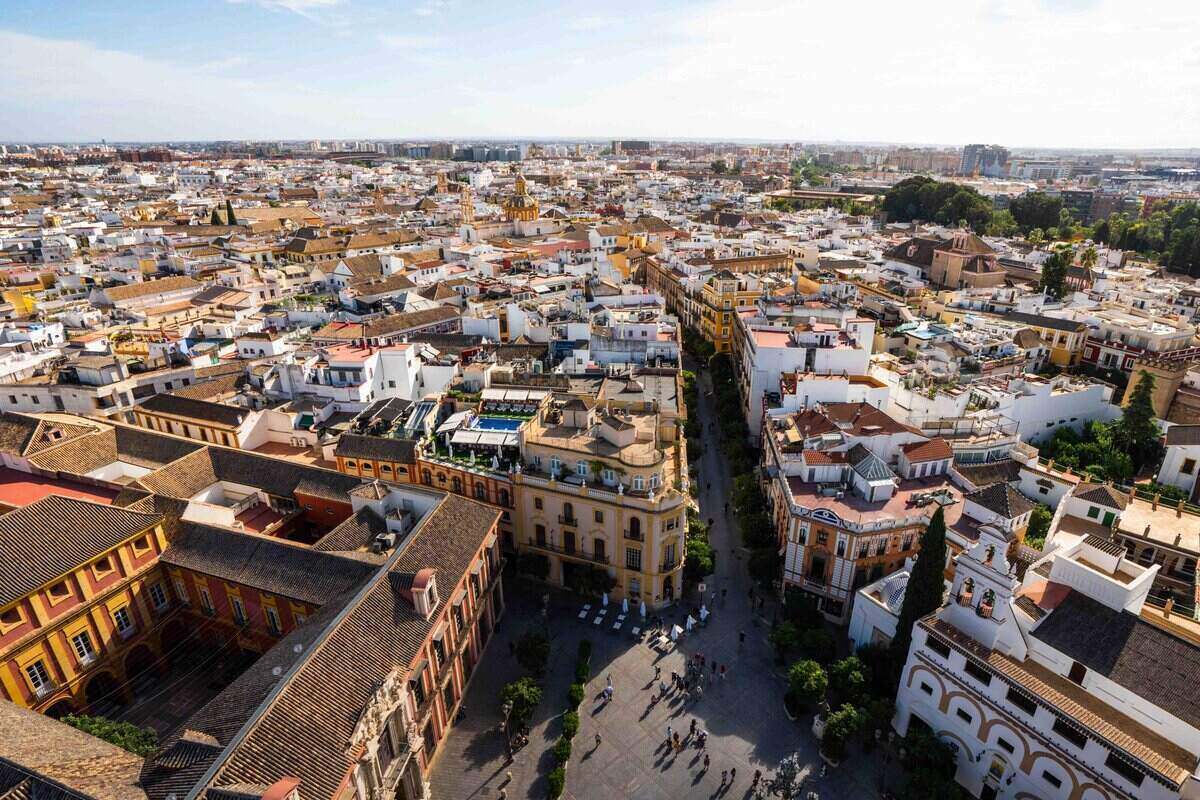
Explore the heart of southern Spain on your next European city break with a trip to stunning Seville; it’s a city I completely fell in love with when I first visited. It’s a vibrant city filled with activity and beauty, and there are plenty of enthralling things to do in Seville.
From its majestic cathedrals and bustling riverfronts to the lively outdoor markets and cobblestone streets winding through colourful neighbourhoods, I know you’re going to love it too.
Take some time to soak up the vibrant atmosphere in Plaza de España, sample delicious tapas at local eateries, or treat yourself to a flamenco performance!
I’ve combined my incredible experiences of visiting the city with some local recommendations to bring you my handpicked selection of the best things to do in Seville.
No matter what you choose to do, I’m sure you’ll have the most wonderful time unearthing the hidden gems and beautiful corners of this city.
Whether you’re here for the culture and cuisine or the parks and palaces, here is my pick of the best things to do in Seville.
Author Bio: Jessie Moore
Jessie Moore is a luxury travel expert with years of experience travelling the world to find the best destinations, hotels and adventures.
1. Real Alcázar
Opening times:
- 29th October – 31st March: Monday to Sunday, 09:30 to 17:00
- 1st April – 28th October: Monday to Sunday, 09:30 to 19:00
Prices:
- General admission: €13.50
- General admission for 65+, students & European Youth Card: €6.00
- General admission for disabled persons and under 13s: Free
- Admission to Royal Bedroom: €5.50
Tickets: Book here
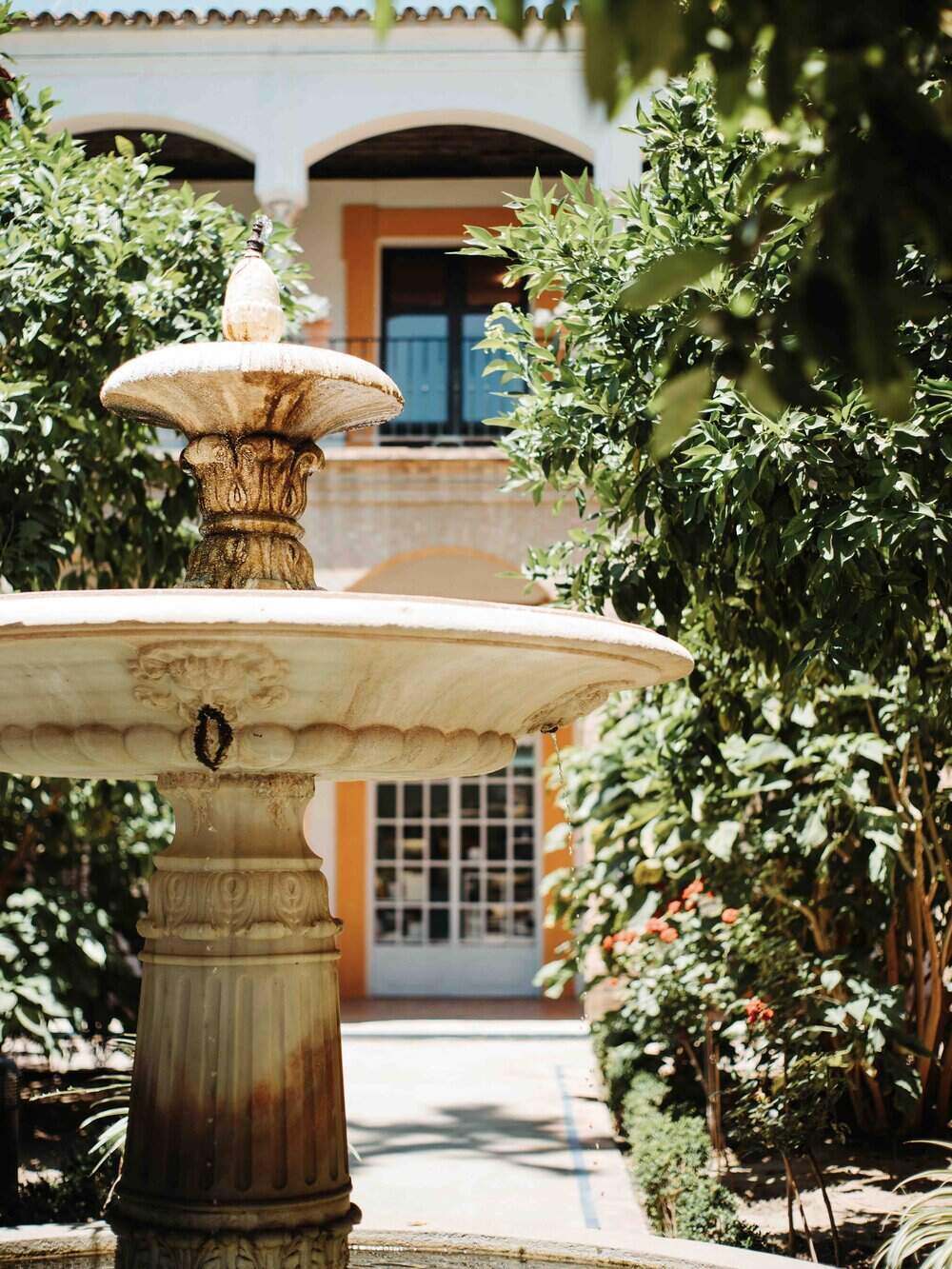
One of the most iconic attractions in Seville is the Real Alcázar de Sevilla, or the Royal Palace of Seville – and believe me when I say that it is truly spectacular.
It is a stunning spectacle of Mudéjar architecture that combines influences from Moorish and Christian culture.
The site has gone through many iterations over the centuries. I always feel that visiting the Real Alcázar is like embarking on a journey through time, where you can uncover insights into the rich history of this part of the world.
The palace itself is breathtaking to behold and has understandably earned its place as a UNESCO World Heritage site.
From the beautifully manicured gardens and courtyards to the priceless artefacts within its walls, every detail is worth noting.
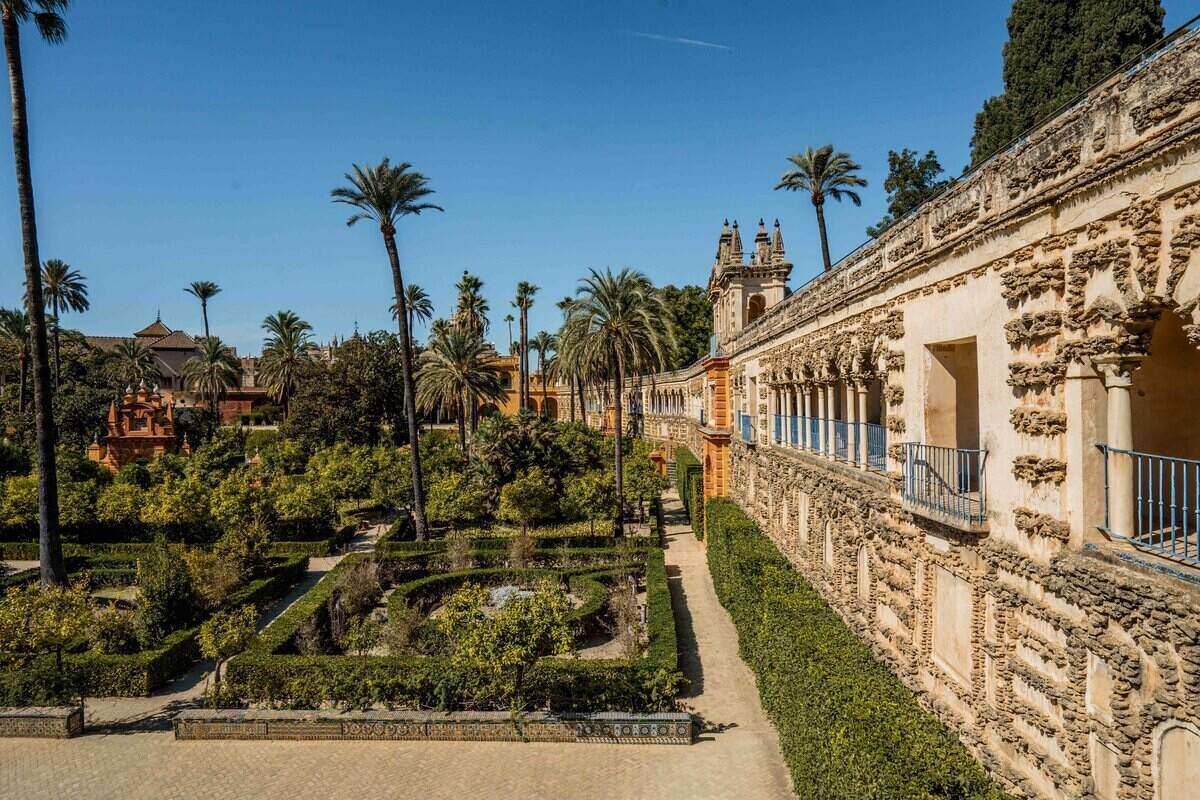
I’d recommend allowing three hours for your visit as there is a lot to explore. Don’t miss the gardens – for me, these were they highlight, as they are utterly magnificent and of pretty epic proportions. You need to allow time to get a little lost in the hedge maze too!
Make sure you book an entry ticket in advance to avoid the long queues.
Insider travel tip: The Real Alcázar is one of the most visited attractions in Spain – let alone Seville. So if you want to avoid jostling elbows with fellow tourists or to snap people-free photos, I advise aiming to arrive when it opens at 09:30.
2. Plaza de España
- 1st November – 31st March: Monday to Sunday, 08:00 to 22:00
- 1st April – 30th October: Monday to Sunday, 08:00 to 00:00
Prices: Free entry
Tickets: Not needed
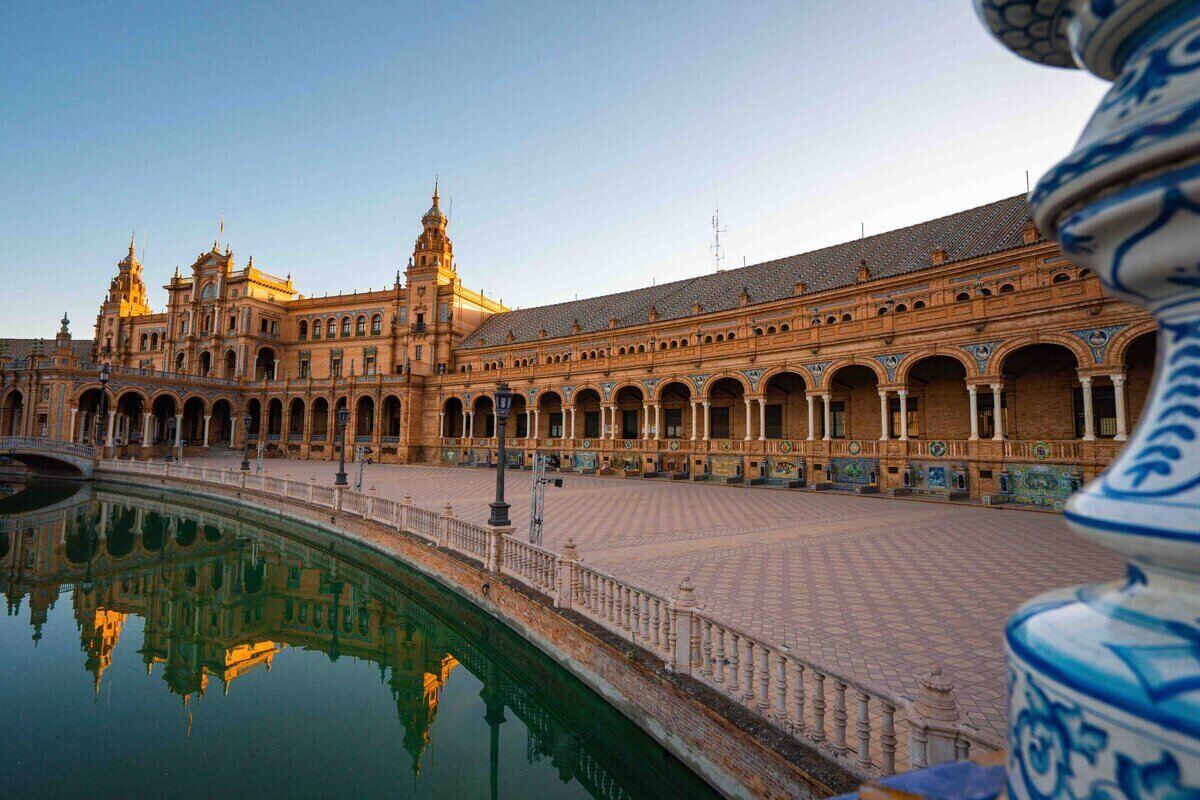
Located in the María Luisa Park, the wonderfully grandiose Plaza de España is an iconic monument in Seville.
The recognisable semi-circular structure may be over the top, but believe me when I say that it is undoubtedly breathtaking and indisputably memorable.
Soaring towers meet intricate tilework, peaceful canals meet beautiful bridges, and a spectacular fountain stands at the heart of it all.
Stories painted onto the tiles bring to life the history of Spain across the different provinces.
To really enhance the enchanting atmosphere, I think that one of the best things to do in Seville is to hire a rowing boat and saunter along the canal at Plaza de Espańa. It costs €6 for a 35 minute ride.
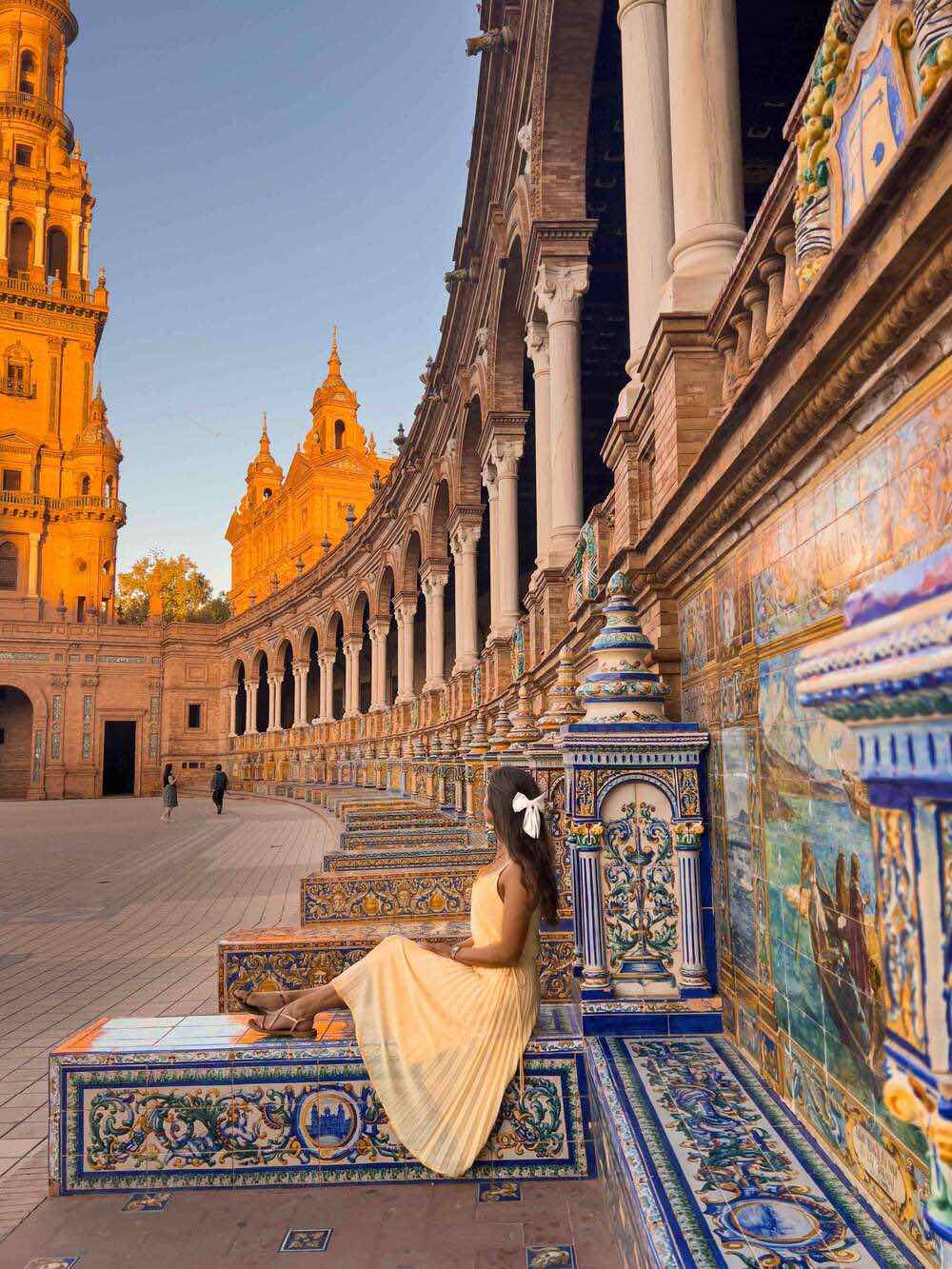
Insider travel tip: The Plaza de España is a great place to catch a free flamenco show. Talented performers regularly take to the floor as wide-eyed visitors watch on.
You can of course give some euros at the end of the performance to show your appreciation. But I’d recommend it as a great way to catch some flamenco if you don’t have time to see a show.
3. Catedral de Sevilla
- Monday to Saturday: 10:45 to 19:30
- Sundays: 14:30 to 19:30
- General admission: €12.00
- Students and 65+: €7.00
- Children under 14: Free
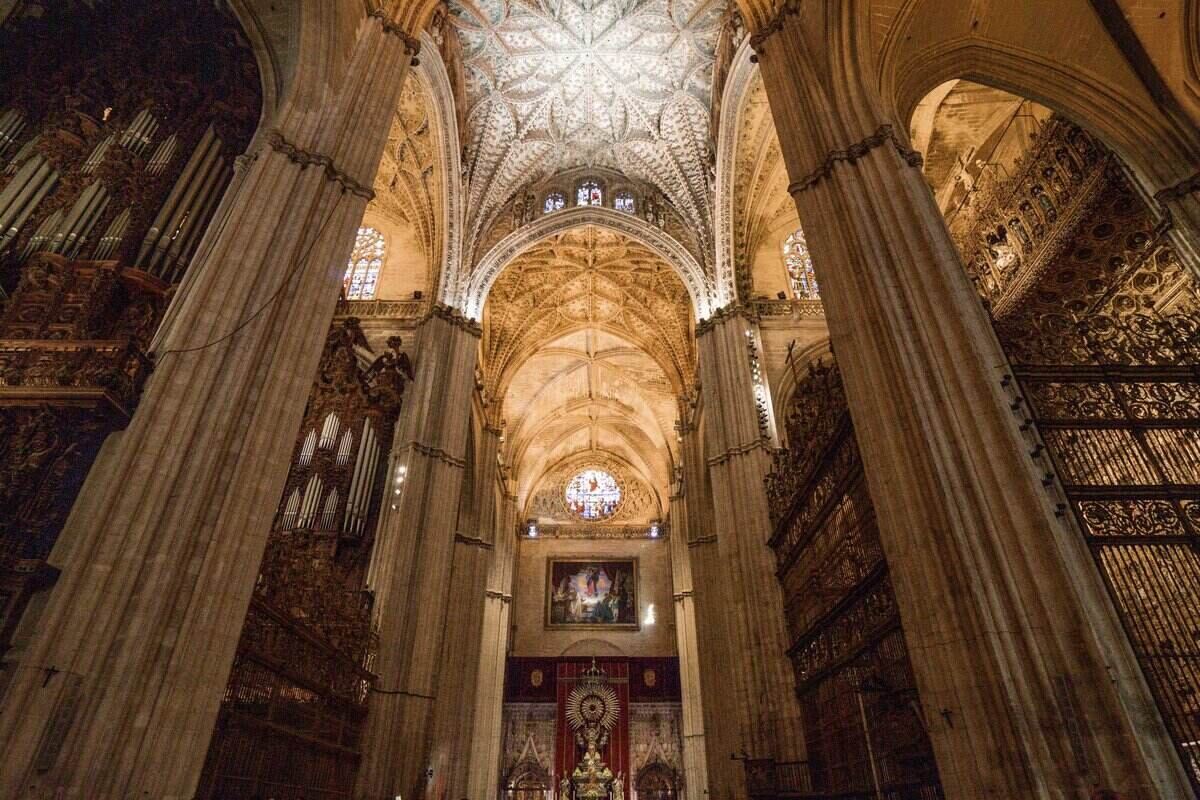
Stepping into the Seville Cathedral is a breathtaking experience; I don’t think anything quite prepares you for the sheer scale of it!
The towering pillars, intricately designed sculptures, and grand organ standing before you create a sense of utter magnificence.
Seville Cathedral is a prime example of Gothic-style architecture, harking back to its origin in the 13th century.
Standing as one of the largest cathedrals in the world – seriously, it’s huge – it’s been a symbol of faith and beauty for centuries.
It was originally constructed on the site of Seville’s former grand mosque, with some of its original Moorish elements still visible.
Its incredible size has made it an imposing part of the city’s skyline, with five different naves joined by four massive bell towers.
The cathedral has weathered wars, natural disasters and clashes between faiths, but remains standing today – telling stories through its ornate decorations that are sure to capture anyone’s imagination.
Insider travel tip: If you want to immerse yourself in the incredible history of Seville Cathedral, I recommend booking a guided tour . Otherwise, make sure you pick up an audio guide at the entrance.
4. Giralda Tower
- Monday to Saturday: 10:45 to 17:00
- Sundays: 14:30 to 18:00
- General admission: €9.00
- Students & 65+: €4.00
- Audio guide: €3.00
- Optional visit to roofs and stained glass windows: €12.00

Towering at over 300 feet above the city, the Giralda Tower provides sweeping views across the entire skyline. In my opinion, climbing to the top of this iconic monument is undoubtedly one of the best things to do in Seville.
Dating back to 1184, the Giralda Tower has been witness to an incredible history. From its inception as an Almohad Islamic tower through its transformation into a bell tower with artwork by master goldsmiths and artisans.
This stunning brick tower is renowned not only for its size but also for its Moorish architecture, complete with eight decorative spires and a large bronze bell.
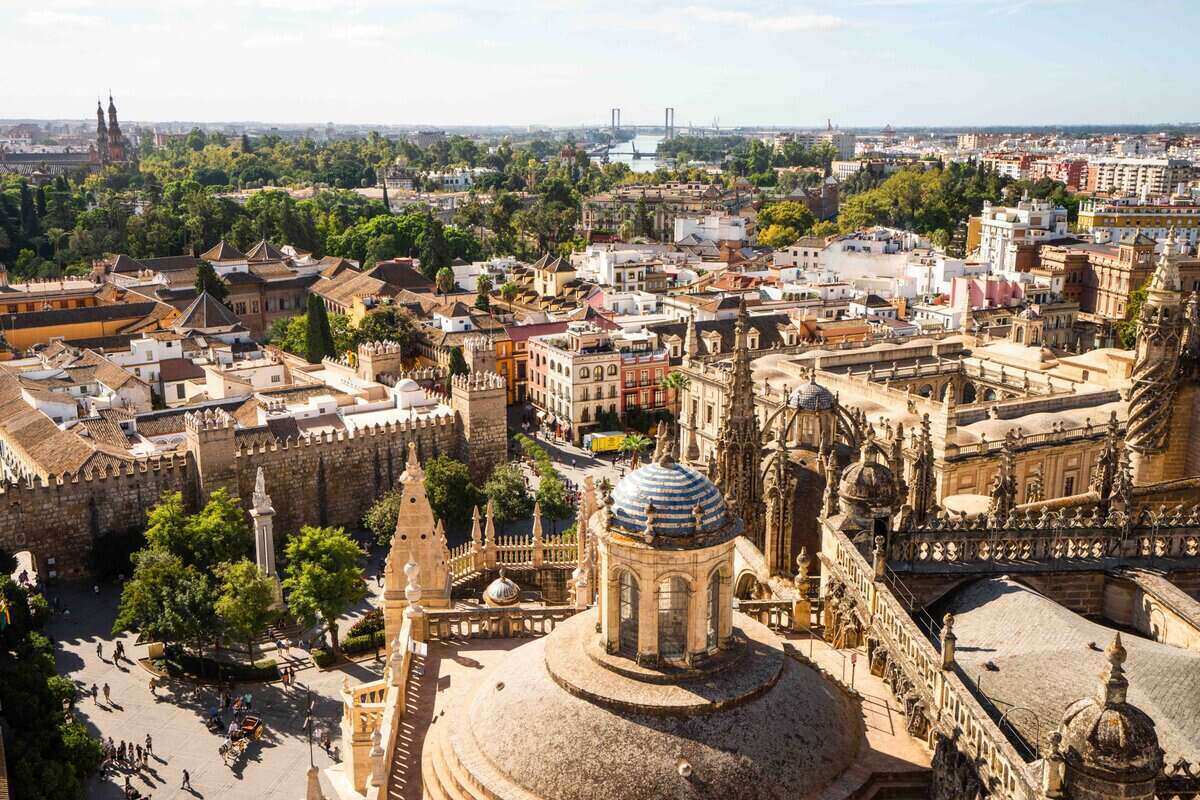
Note that you don’t need to worry about climbing endless steps to reach the top. Instead, there are 35 sloping ramps which take you up to the viewing platform (which I was very relieved to find!).
Insider travel tip: Many tickets for Seville Cathedral include entry to the Giralda Tower. So I’d recommend checking before you buy, as you can save money by booking a Seville Cathedral and Giralda Skip-the-Line Ticket .
5. Metropol Parasol (Seta de Sevilla)
- November to March: Monday to Sunday, 09:30 to 00:00
- April to October: Monday to Sunday, 09:30 to 00:30
- Daytime entry: €5.00
- Sunset entry: €8.00
- Night entry: €10.00
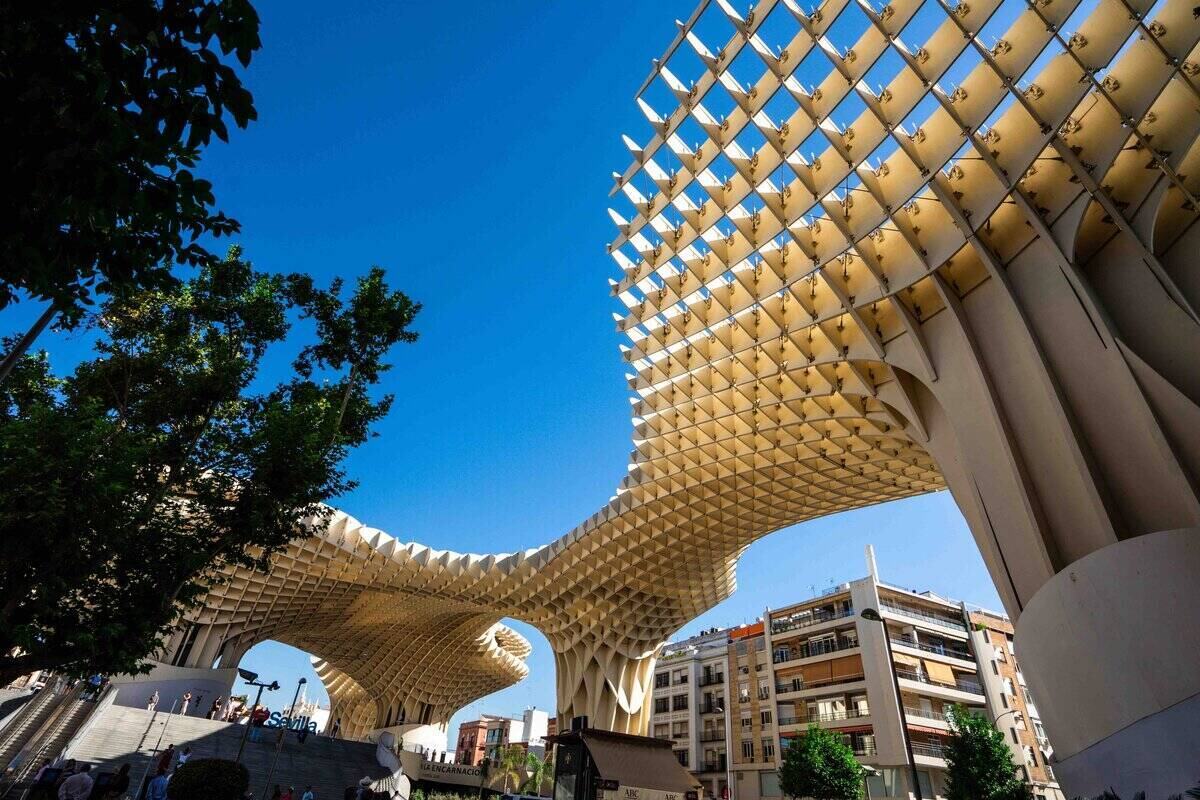
The Metropol Parasol, or Seta de Sevilla, is one of the largest wooden structures in the world.
Aesthetically speaking, I don’t think it’s to everyone’s taste and it somewhat divides opinions. One thing’s for sure though – it’s one of the best places to see the sunset in Seville.
The innovative architecture of this wooden mushroom-shaped structure combines with its distinct Spanish revival style to create a remarkable sight of both beauty and function.
Originally built as a centrepiece of Plaza de la Encarnación, it has multiple levels that grant visitors breathtaking viewpoints across the city.
You’ll often find that live music drifts into the air from La Boutique del Sonido rooftop bar for a charming experience.
Insider travel tip: I’d recommend visiting the Metropol Parasol at either sunset or at night. After dark, the structure is lit up with changing colours for a spectacular display.
6. Flamenco Show
Duration:
- From £19 per person, dependent on venue
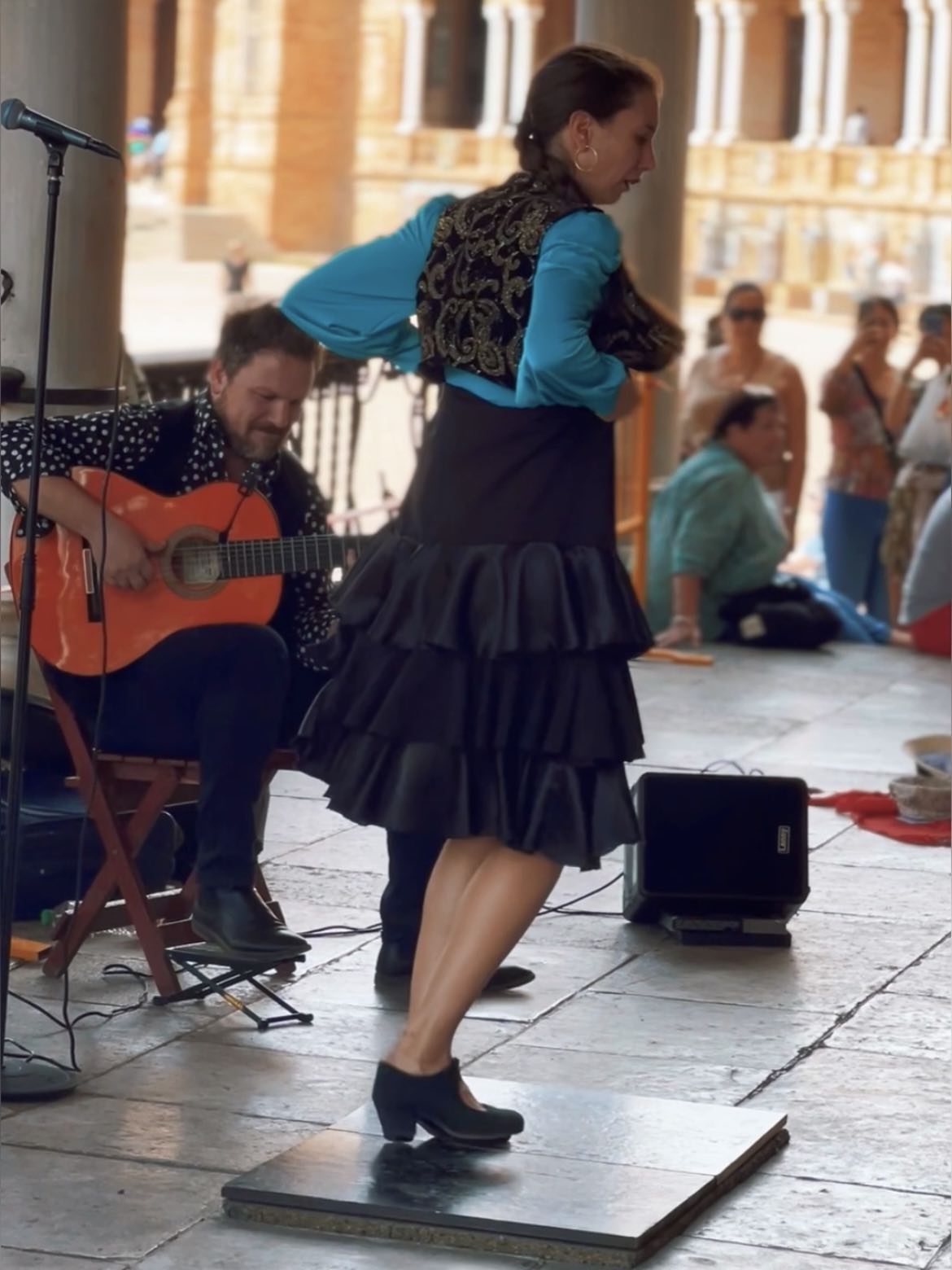
Undoubtedly one of the best things to do in Seville is to see a dazzling Flamenco show. The passion and emotion that radiates from the performers, musicians, and singers is nothing short of remarkable.
From the captivating rhythms of guitars and castanets to the vigorous movements of dance steps echoing through the theatre, I have no doubt that you’ll be left mesmerised.
For an inspiring performance, I’d recommend heading to Casa de la Memoria . It’s a theatre that has earned its nickname ‘the temple of flamenco’ due to its impressive performances and authentically decorated stage.
Triana Tablao Flamenco and Tablao El Arenal Flamenco are two other magical shows where the local musicians and dancers captivate with their fiery performances.
With many quaint tapas bars lining the areas near these theatres, there’s no better place to have a full cultural Seville experience.
Good to know: If you don’t have time to see a show, I recommend keeping a look out for impromptu flamenco performances in the streets of Seville.
These artists are usually rising stars and offer free improvised flamenco shows near popular tourist spots. Donations are of course welcome.
7. Semana Santa Festival
- 2023: 2nd – 9th April
- 2024: 24th – 31st March
- 2025: 13th – 20th April
Prices: Free to experience
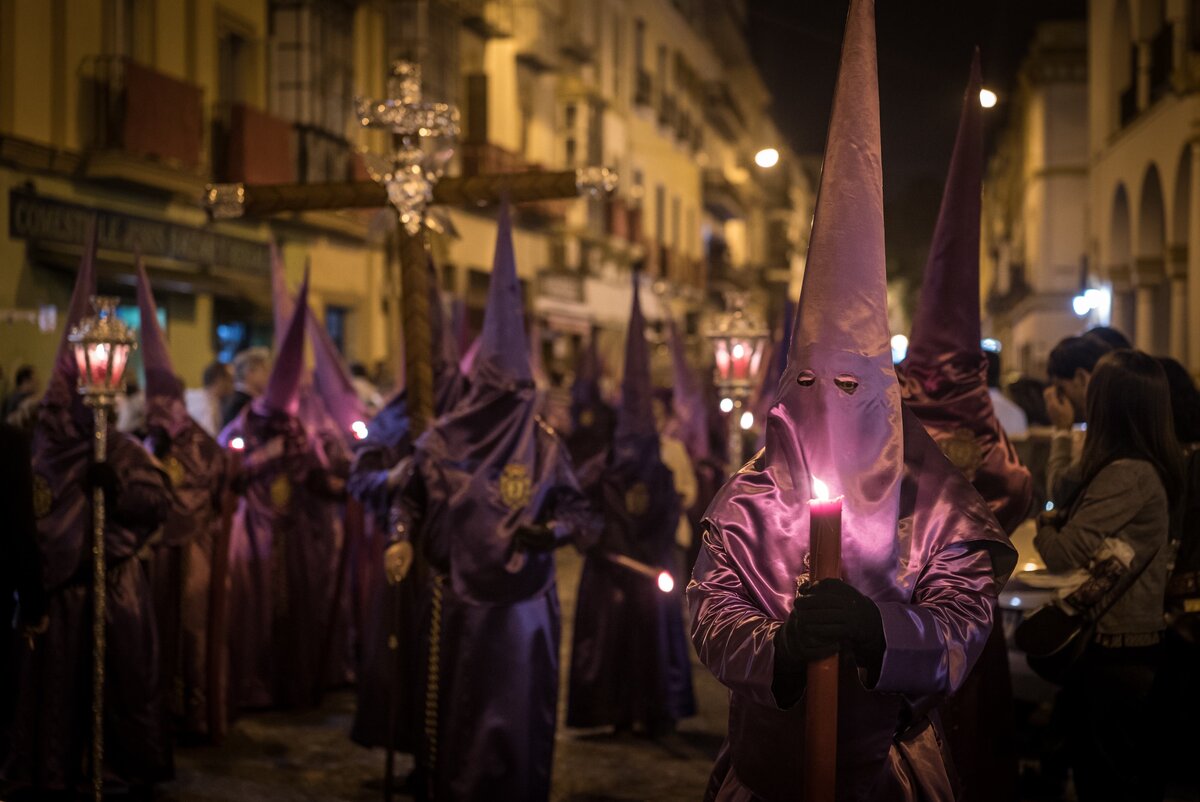
If you’re visiting Seville over the Easter period, you may be lucky enough to catch the Semana Santa Festival (Holy Week) in Seville.
The streets come alive with religious processions, complete with magnificently decorated floats, singers and elaborate costumes.
The ancient tradition, which dates back to the Middle Ages, started as a way for the Catholic Church to portray Christ’s resurrection story in a way that was easy to understand for all.
It draws visitors from around the world and, at times, it almost seems like you’re taking a step back in time!
Although the Semana Santa celebrations take place all over Spain, Seville offers one of the most renowned processions of them all.
So if you time it right, experiencing this unique festival is one of the best things to do in Seville.
Insider travel tip: With Seville’s Semana Santa celebrations being some of the most flamboyant and extravagant in Spain, visiting during the Holy Week will not be a peaceful affair.
While it’s an incredible experience, I’d recommend bearing this in mind if you were hoping for a more relaxing time in the city.
8. Museum of Arts and Popular Customs
- Tuesday to Saturday: 09:00 to 21:00
- Sunday & Holidays: 09:00 to 15:00
- Closed on Mondays
- Free for EU Citizens and children
Tickets: Pay on arrival
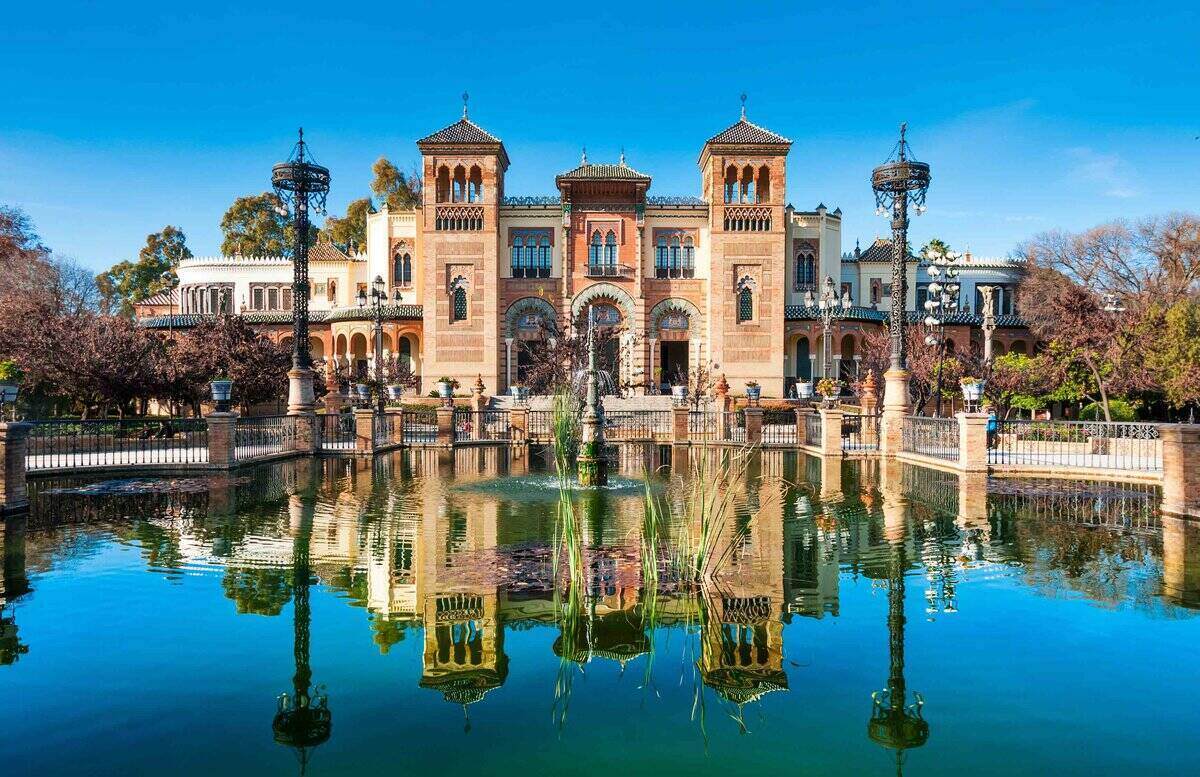
The Museum of Arts and Popular Customs can be found inside the grand building of the Mudejar Pavilion within the María Luisa Park.
This incredible space hosts an amazing collection of different objects which capture the rich history and culture of Andalusia.
From stunning ceramics and traditional clothing to antique glassware and over 7,000 postcards, the museum offers diverse and fascinating collections.
Marvel at the flamboyant flamenco frocks or discover the different toys and games.
Insider travel tip: I’d say that The Museum of Arts and Popular Customs is best suited to those with a genuine interest in history, crafts and ethnography. You’ll only need about 1-1.5 hours to explore.
Want up to 25% off hotels?
Subscribe to my newsletter and get immediate access to my guide on how to save money on flights and hotels. Our weekly emails are filled with adventure inspiration, insider travel tips and exclusive discounts.
9. Tomb of Christopher Columbus
Opening times: As per Seville Cathedral:
Prices: As per Seville Cathedral:
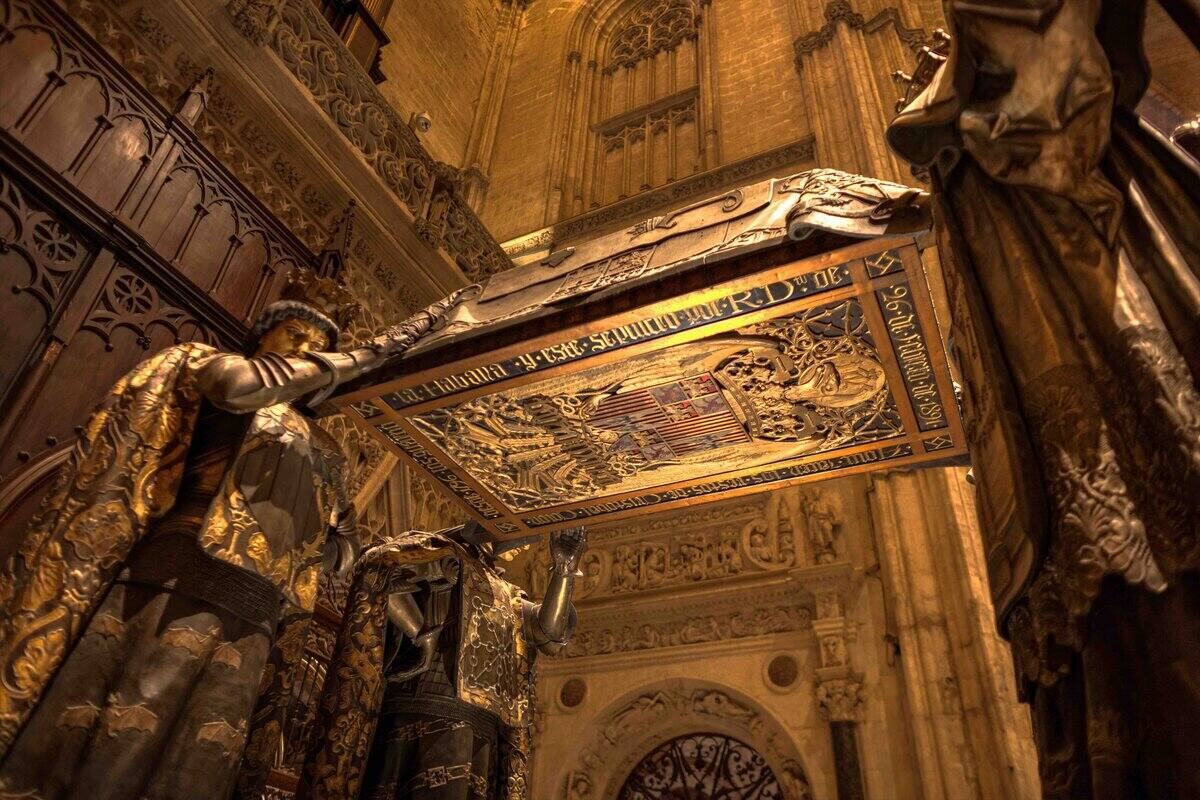
Although technically part of the Catedral de Sevilla, I still wanted to highlight the tomb of Christopher Columbus as one of the best things to see in Seville. The tomb can be found just inside the cathedral door and was installed in 1899.
The tomb itself is held up by four heralds representing the four Spanish kingdoms during Columbus’ life: Castile, Leon, Aragón and Navarre.
It’s an impressive sight and one that you don’t want to miss on your visit to the cathedral.
Insider fact: For many years, there was some dispute over whether the body in the tomb was actually that of Christopher Columbus. Unfortunately we still can’t be sure, but forensic tests carried out in 2006 confirmed that the body is either Christopher Columbus or his brother!
10. Mercado de Triana
Opening times:
- Monday to Saturday: 09:00 to 15:00
- Closed on Sundays
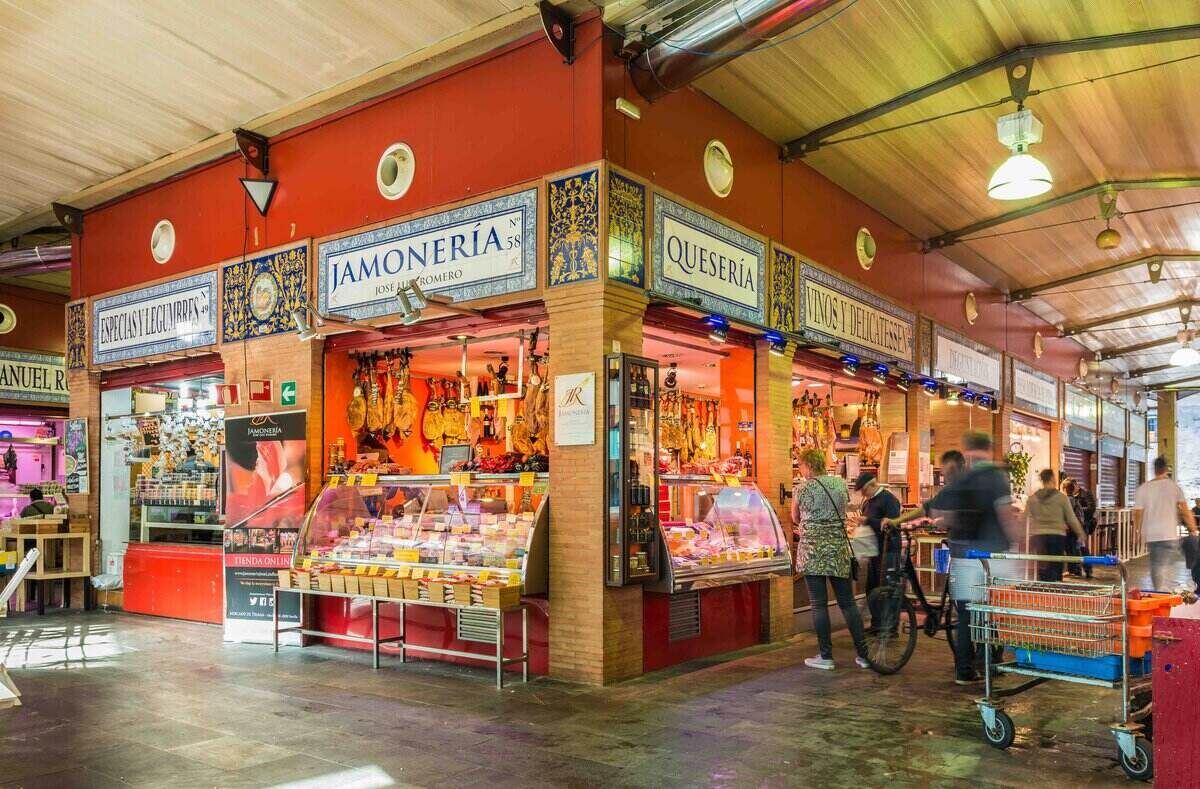
The Mercado de Triana is a lively indoor market in Seville. Quaint vendor stalls sell a range of fresh produce, from fruit and vegetables to meat and fish. It’s a delightful smorgasbord of colours, scents and flavours.
Teeming with both locals and tourists, it’s a bustling market that I think is well worth a visit if you’re in the area.
As well as the stalls, I love that there are also a handful of small restaurants where you can sample some tapas.
Good to know: If you’re a food lover with a penchant for cooking, I’d recommend booking a Spanish cooking class and Triana market tour .
One of the best things to do in Seville, I think it’s the perfect way to learn a new skill and immerse yourself in Spanish cuisine.
11. Barrio Santa Cruz
Opening times: N/A
Prices: N/A
Tickets: N/A
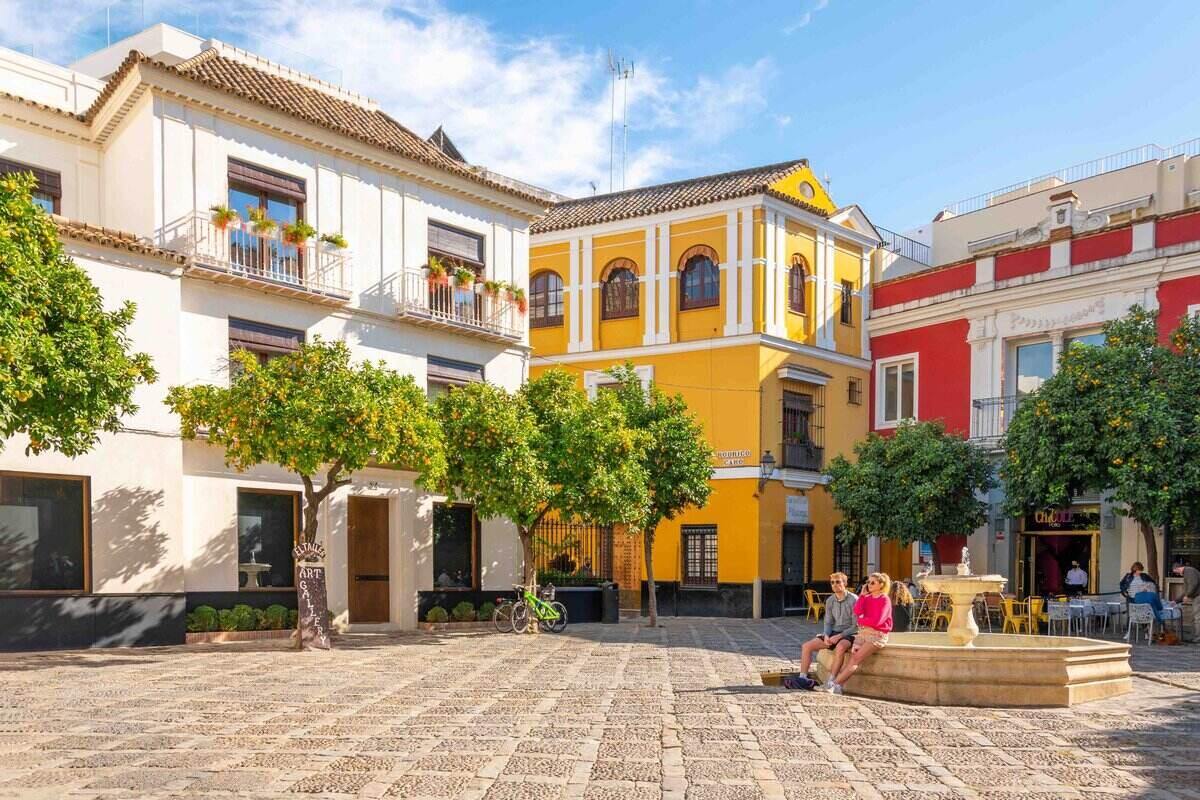
For a captivating introduction to the culture and history of the city, I’d recommend exploring the charming neighbourhood of Barrio Santa Cruz.
Take a stroll along the cobblestone lanes and discover hidden plazas. Admire the churches, ancient houses and colourful facades which line the streets.
Formerly the Jewish quarter, I think Barrio Santa Cruz is the most picturesque part of the city. It’s also home to many of the key tourist attractions in Seville, such as the Alcazar Palace and Seville Cathedral.
At night, the area comes alive with plenty of great restaurants and Sevillian bars . I recommend taking the opportunity to sample the local cuisine while listening to authentic flamenco music.
The sounds of Andalusian flamenco combined with the aroma of Spanish cuisine offer a lasting taste of Spanish culture.
Insider travel tip: To learn about the fascinating history of the area, I’d advise booking a Santa Cruz walking tour .
Discover the legends and secrets of the city, and seek out all the best hidden gems in this part of Seville.
12. Casa de Pilatos
Opening times:
- November to March: 09:00 to 18:00 everyday
- April to October: 09:00 to 19:00 everyday
- Whole house: €12.00
- Ground floor only: €10.00
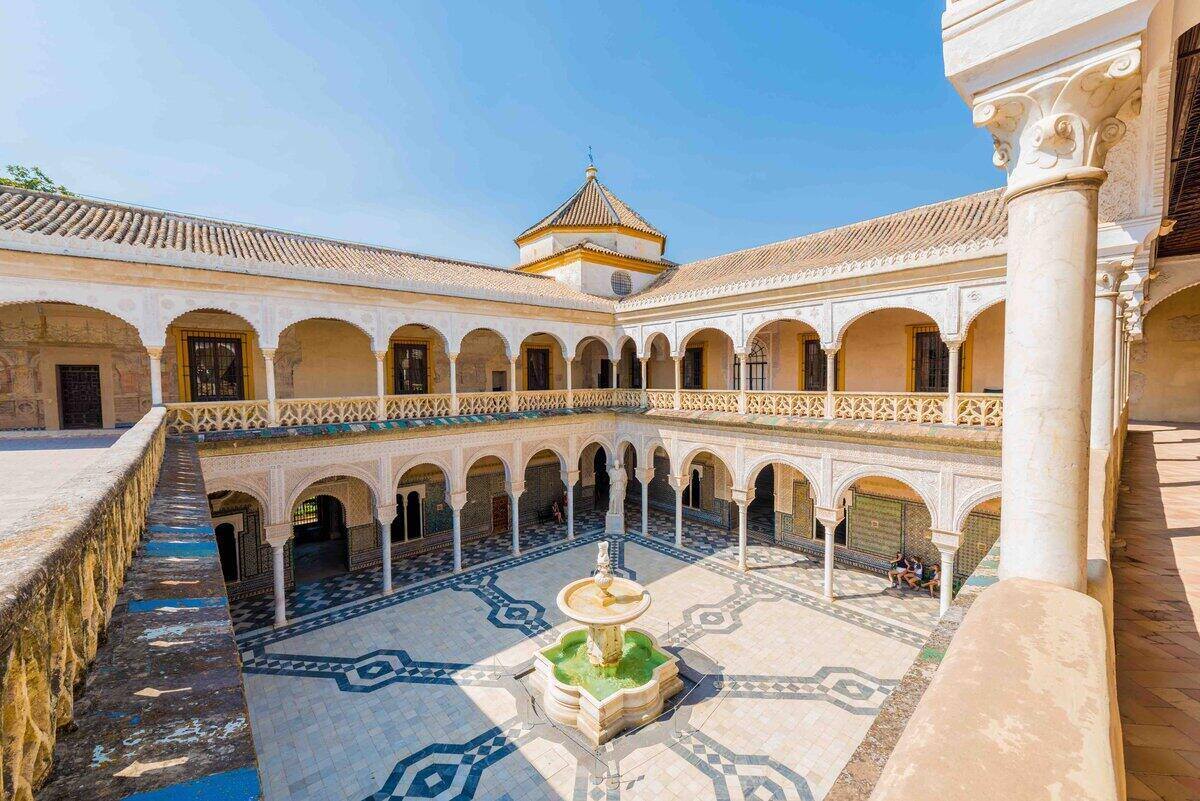
This luxurious 16th-century palace is the home of aristocracy – specifically the 18th Duchess of Medinaceli and her family.
Casa de Pilatos brings together a beautiful blend of Baroque, Mudéjar and Renaissance styles. Take a stroll through the impressive courtyards, lined with centuries-old walls and mangroves.
Marvel at the breathtaking frescoes that adorn each ceiling, then explore the gorgeous mosaic tiles which cover the marble fountains and tiled pathways.
Insider travel tip: If you love the Real Alcázar then you’ll love Casa de Pilatos. I find that it’s similar in terms of its impeccable architecture and fine classical sculptures, but on a slightly smaller scale and with fewer tourists.
13. Parque de María Luisa
- Monday to Sunday: 08:00 to 22:00
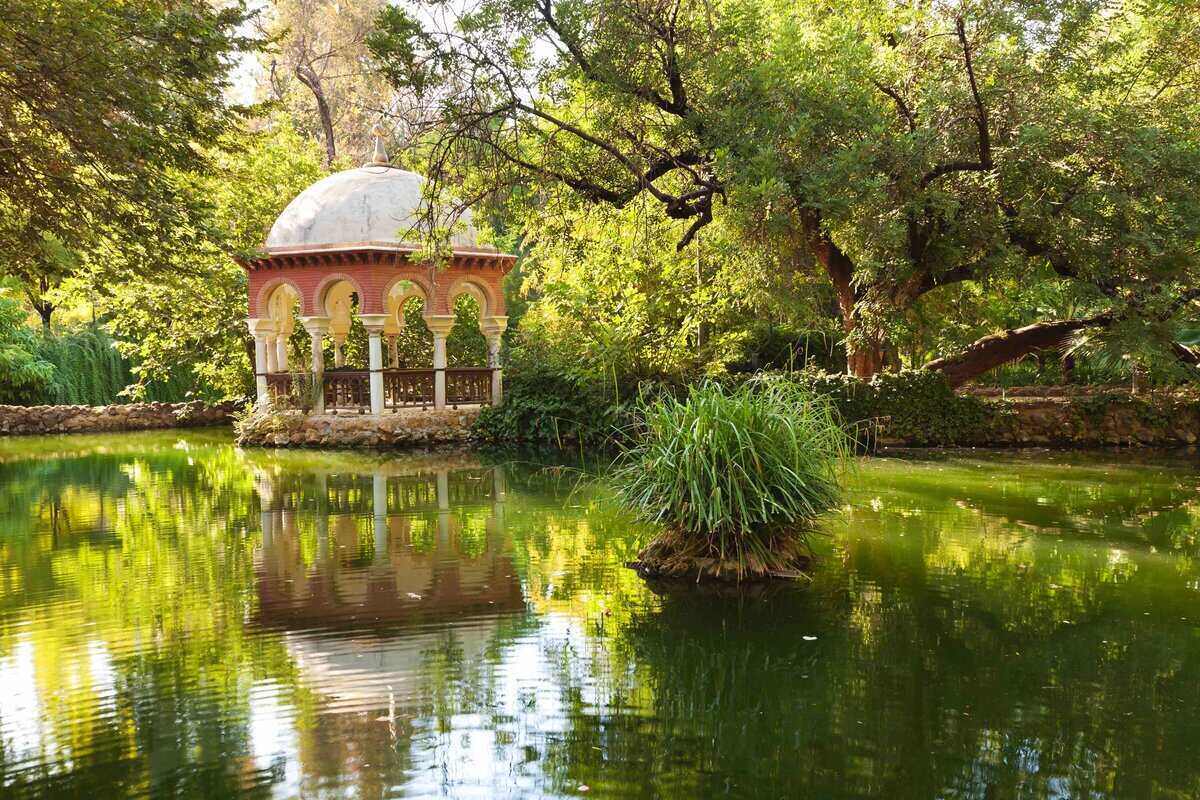
In my opinion, one of the best things to do on a sunny day in Seville is to wile away an afternoon at María Luisa Park.
Located next to Plaza de España, this beautiful green space is a peaceful oasis away from the hustle and bustle of city life. Here, you can escape the heat of the sun in the dappled shade of lush trees and shrubs.
Stroll amongst colourful flowers, quaint duck ponds and elegant fountains. All while horse-drawn carriages traverse the paths for a scene straight out of a fairytale.
Insider travel tip: The María Luisa Park is also a great place to explore by bike, or as part of a guided bike tour . For something more exhilarating, I’d recommend hiring quad bikes at €14 per half-hour.
14. Córdoba Day Trip
Train time: From 42 minutes
Prices: From €9.65
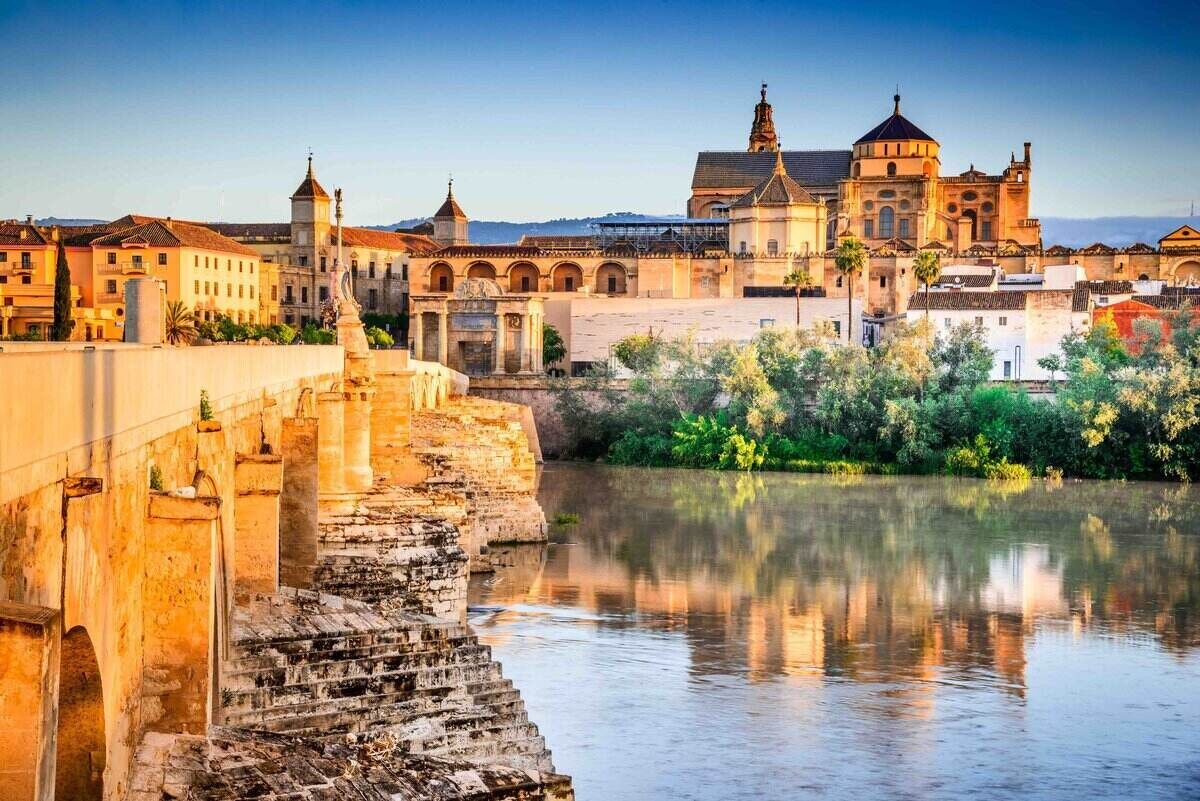
My favourite day trip from Seville , Córdoba is an excellent way to experience two of the most beautiful cities in Andalusia, Spain. Get a 42 minute train to Córdoba and explore one of Europe’s oldest cities.
Once an empire adorned with grand monuments, Córdoba offers some stunning tourist attractions.
Most notable is the breathtaking Mosque-Cathedral of Córdoba , one of Spain’s most incredible UNESCO World Heritage sites.
Wander down winding cobblestone alleys and ancient streets, situated among a landscape of stunning Spanish countryside.
If you have time, I’d recommend taking a leisurely boat ride across the Guadalquivir River. Before watching the sun set over this picturesque cityscape.
Insider travel tip: The Mosque-Cathedral is so spectacular that it gets absolutely overwhelmed with tourists. It opens at 10am, so if you’re up for an early start, I advise trying to get there just before it opens.
Discover more of my favourite day trips from Seville .
15. Hospital de los Venerables
- Monday to Saturday: 10:00 to 19:00
- Sundays: 10:00 to 15:00
- Adults: €10.00
- Students and 65+: €8.00
- Under 12s: Free entry
Tickets: Buy on the door
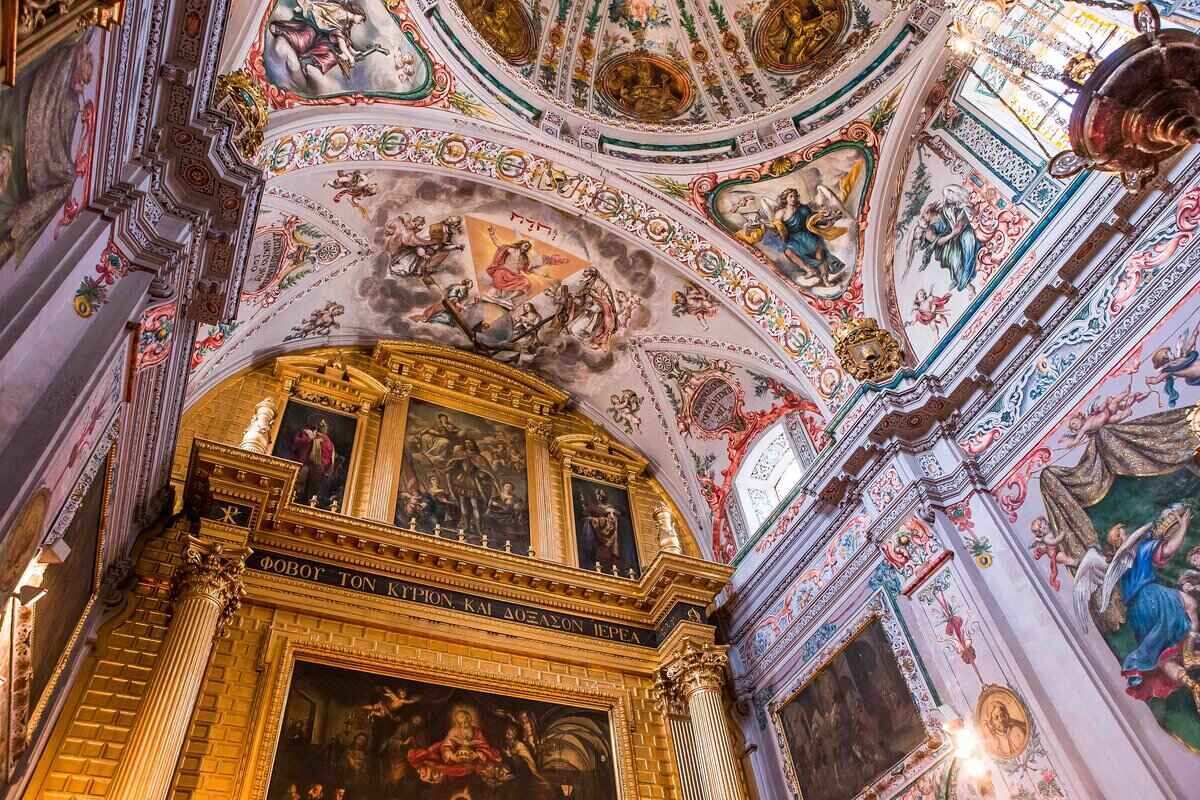
Hospital los Venerables was originally founded as a hospital for elderly and impoverished priests.
Located in a pretty square complete with orange trees in Barrio Santa Cruz, this baroque 17th-century building is now used as an art gallery.
Visitors to Hospital los Venerables can explore the Velázquez Centre, containing a collection of paintings by Diego Velázquez. There is also an ornate church and a central courtyard with a stepped fountain.
Insider travel tip: For those with a strong interest in art and the history of this unique attraction, I’d recommend booking a private guided tour .
If you don’t have a vested interest in art, then I’d suggest seeing it from the outside as part of a Barrio de Santa Cruz tour .
16. Torre del Oro
- Monday to Friday: 09:30 to 18:45
- Saturday and Sunday: 10:30 to 18:45
- Closed on public holidays
- General admission: €3.00
- Students, children from 6-14 and 65+: €1.50
- Under 6: Free entry
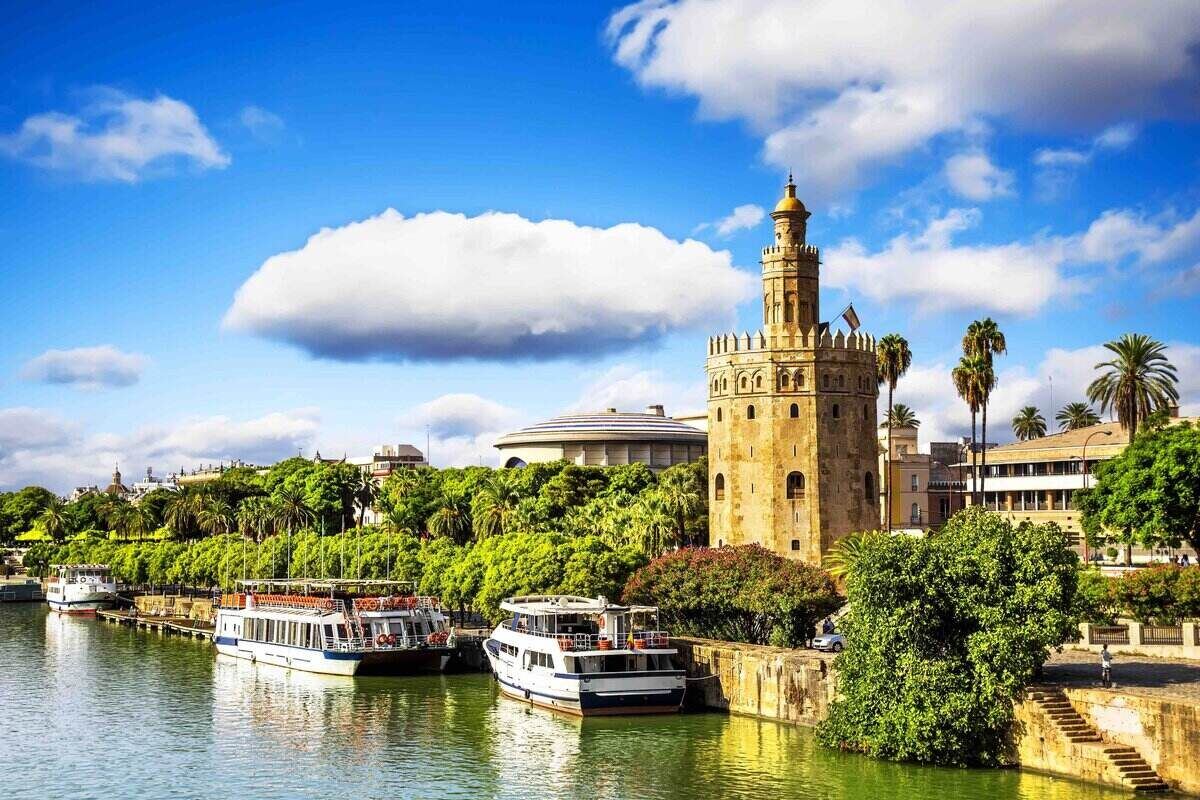
This iconic golden tower has stood at the edge of the Guadalquivir River for centuries. Originally constructed during the mediaeval caliphate of Alfonso X, it was built to store loot from his conquests.
Today, visitors to this grand old structure can take in its remarkable architecture and learn about its fascinating history.
With its distinctive 12-sided shape and unmistakable copper shingles, the Torre del Oro stands as a symbol of Seville’s illustrious past.
Insider travel tip: In my opinion, a fun way to see the Torre del Oro is from the water on a Guadalquivir Yacht Tour .
You can admire the views, sip on a drink and indulge in a delicious meal onboard the boat while it saunters down the river.
17. Museo de Bellas Artes
- From August 1 to August 31: Tuesday to Saturday, 09:00 to 15:00
- Sundays and public holidays: 09:00 to 15:00
- General admission: €1.50
- Guided tours also available
- Free entry for EU citizens
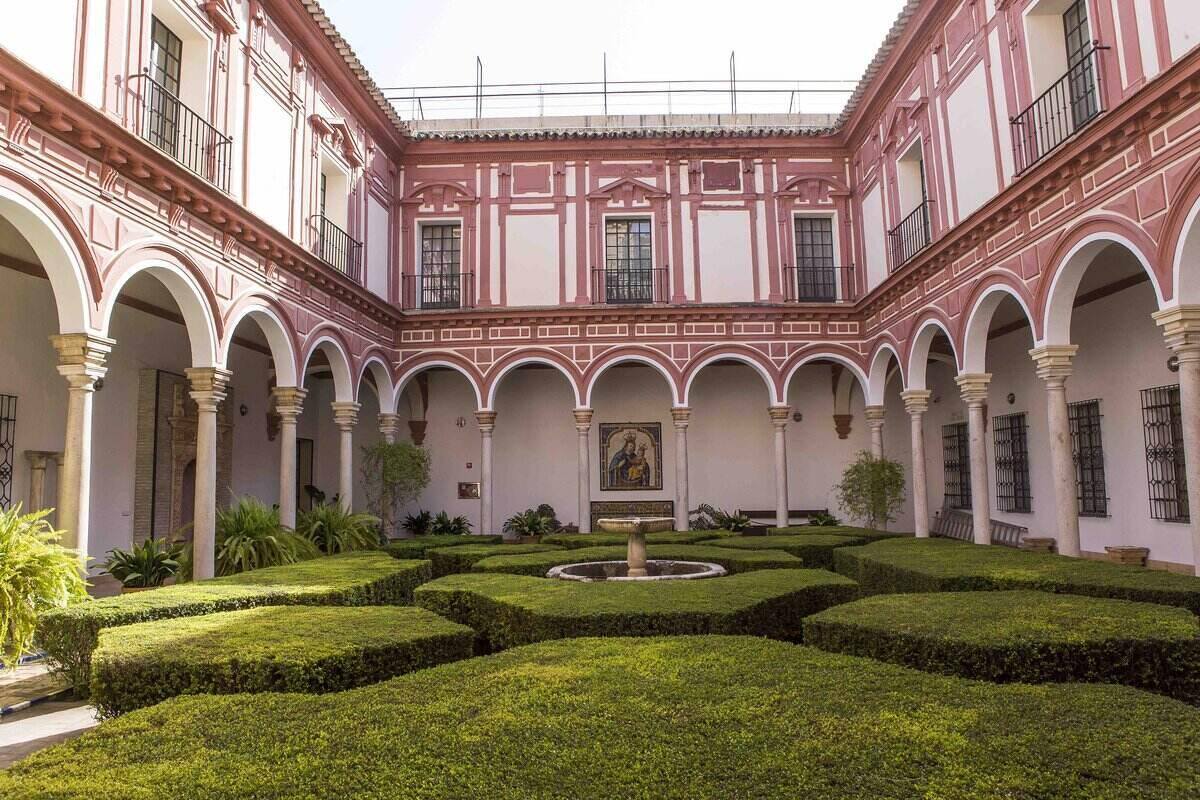
Founded in 1838, the Museo de Bellas Artes (Museum of Fine Arts) houses a vast collection of artefacts from both historical and modern art.
From its impressive interior design to the captivating exhibits presented throughout its galleries, I love that there’s something for every art-enthusiast at this museum.
Spanning over 3,000 years of Spanish history, the art ranges from the Middle Ages, Renaissance and Baroque era, up to the 20th century.
The museum can be found in the Plaza del Museo, where you’ll also find a bronze statue of Baroque Spanish painter Bartolomé Esteban Murillo.
The Museum of Fine Arts is the second-largest art gallery in Spain, and it’s therefore one of the best things to do in Seville for art lovers.
18. Plaza de Toros
- Monday to Sunday 09:30 to 19:30
- Museum entrance & guided tour: €10.00
- Students and 65+: €6.00
- 7 to 11 years old: €3.50
- Children under 6: Free entry
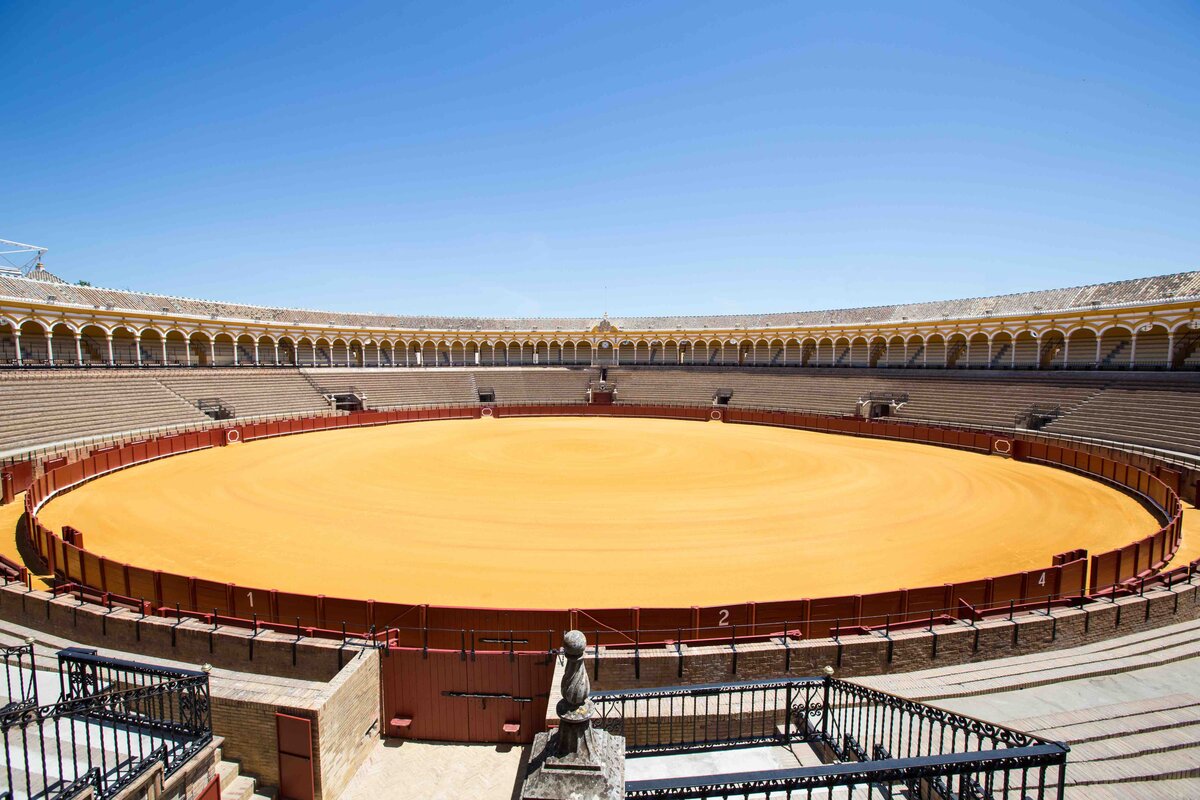
The Plaza de Toros de la Maestranza is Seville’s bullfighting arena and a place of much historical and cultural significance.
On a guided tour you can learn about the controversial bullfighting practices which have taken place in Spain for centuries.
As part of your visit, explore the Bullfight Museum, wander the horses’ courtyard and see the chapel where the bullfighters pray.
The tour will take you through all parts of the arena, including the same route walked by bullfighters before they enter to battle with the bulls.
The arena itself is a spectacular sight to behold. Its beautiful Baroque façade and grand entrance make the Plaza de Toros one of the most impressive attractions in Seville.
Good to know: There are around 20 bullfights per year from Easter Sunday until mid-October and they usually take place on Sunday evenings.
Although the history of this Spanish tradition is fascinating, it is somewhat unethical and I wouldn’t personally recommend seeing a bullfight.
19. Hospital de la Caridad
- Monday to Friday: 10:30 to 19:00
- Saturdays and Sundays: 14:00 to 19:00
- Adults: €8.00
- Children 8 to 18 years old: €2.50
- Seniors: €5.00
- Children under 7: Free entry
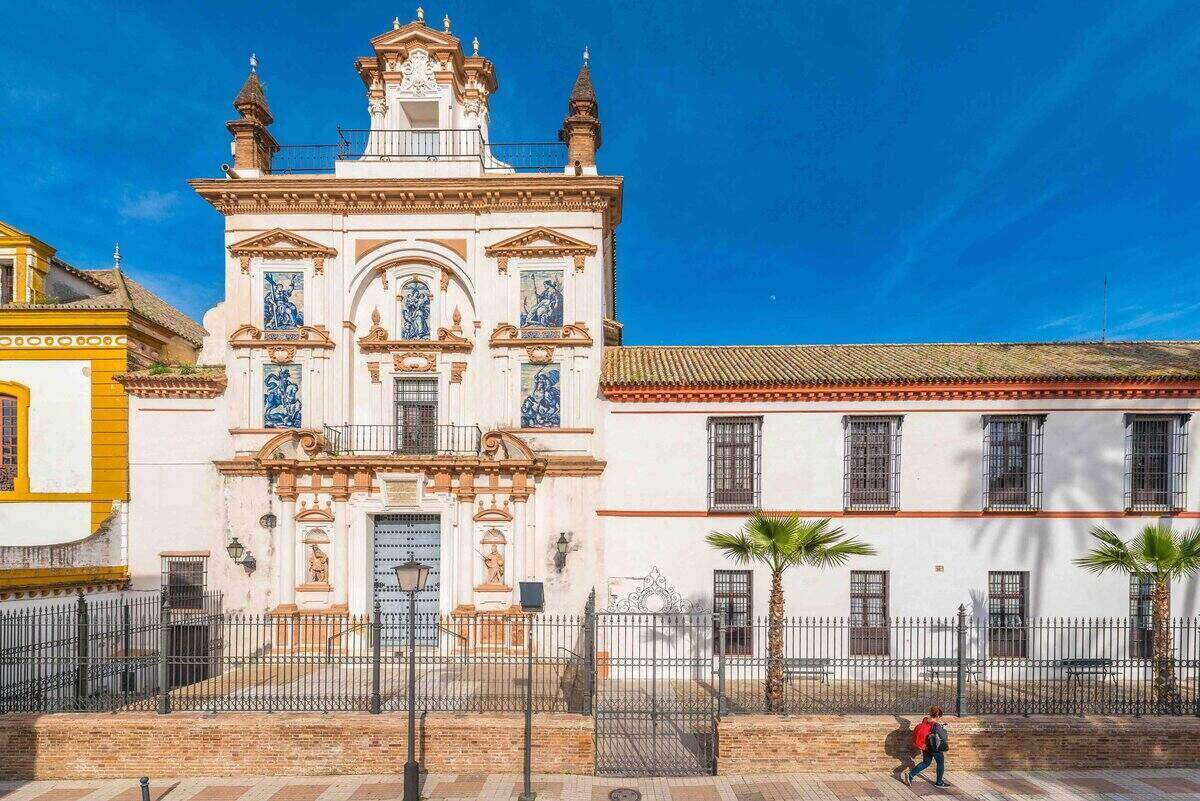
The Hospital de la Caridad was originally founded in the 15th century as a burial ground for those who were executed or drowned in the river. Then in the 17th century, it became a hospice for the poor and elderly.
The name translates to ‘Holy Charity Hospital’ and it’s a place that’s revered by locals. The gilded chapel is the main attraction of the Hospital de la Caridad.
It’s a Baroque masterpiece decorated with art from various painters and sculptors, including Murillo, Valdes Leal and Roldan.
In fact, four out of six of the Murillo paintings were stolen during the War of Independence. Replicas now hang in their place – I’d recommend seeing if you can spot the reals from the fakes!
Good to know: The hospital continues to look after the elderly today and money from tourism helps to maintain the facilities.
20. Try the tapas
- From about 13:00 to 16:00 for lunch
- From about 20:00 to 23:30 for dinner
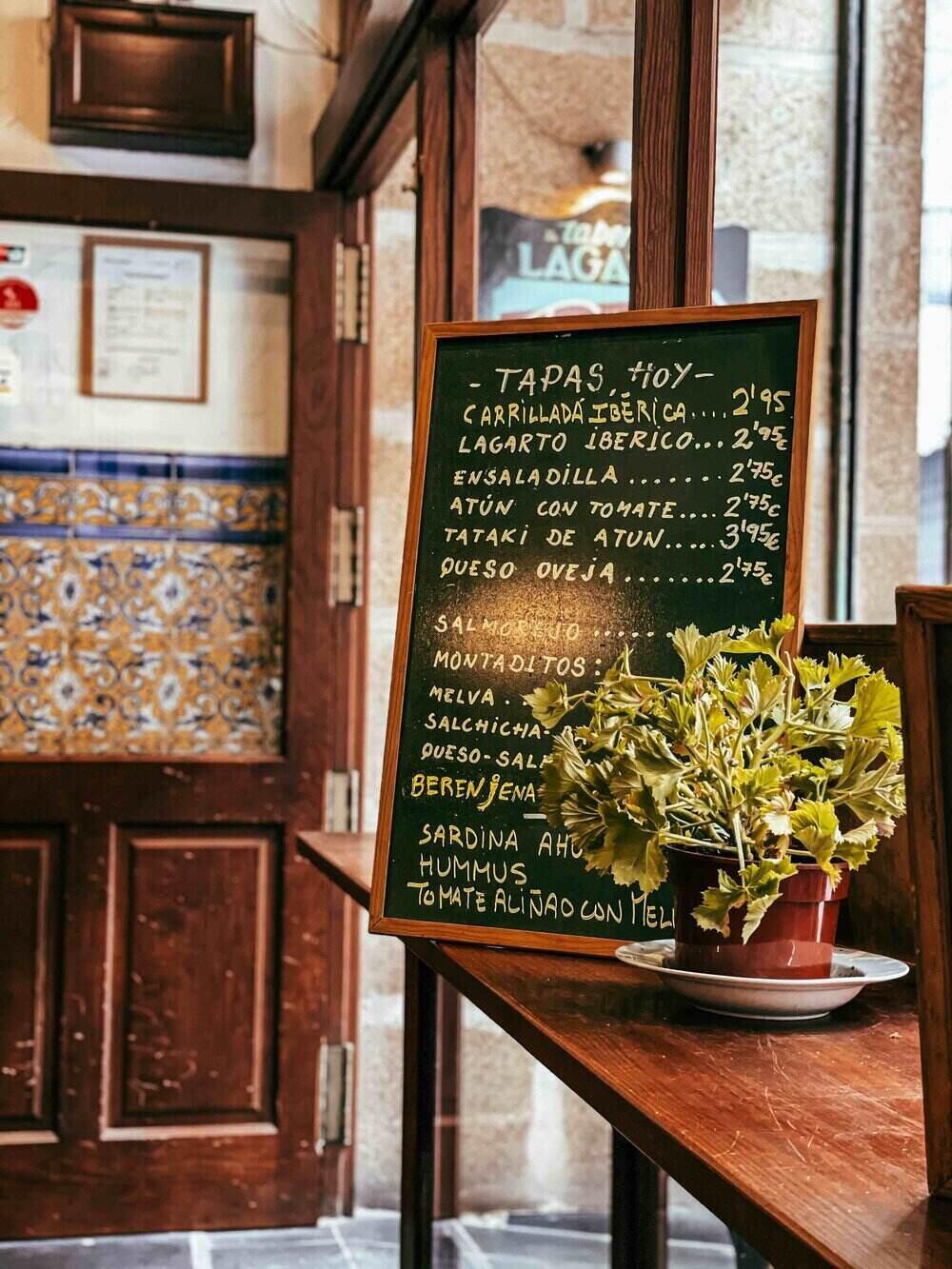
I could not complete my guide to the best things to do in Seville without mentioning the tapas!
Immerse yourself in Andalusian tapas and explore the incredible food scene of Seville. From cured meats and croquettes to fresh fish and perfectly cooked pork, trust me when I say that it’s a foodie’s dream!
Some of the best places to eat tapas in Seville include Bodeguita Romero, Restaurante Eslava and Bar Pelayo.
For somewhere steeped in history, I recommend heading to El Rinconcillo, Seville’s most ancient tapas bar. The food is good but the setting is exceptional.
You’ve heard of a pub crawl, but have you heard of a tapas crawl? Spend an evening unearthing the very best tapas bars in Seville on a guided tapas crawl .
Discover historical tapas bars and hidden gems, indulging in some of the best local dishes away from the main tourist traps. Make sure you turn up with a strong appetite!
Insider travel tip: Most restaurants and tapas bars in Seville don’t open until about 8pm for dinner. Locals usually visit restaurants from 9pm, so you may need to eat a little later than you’re used to.
Some restaurants will be open all day, but the more authentic tapas bars will likely have the more restricted opening times.
Do let me know any of your favourite things to do in Seville in the comments below!
Planning a trip to this Spanish city? Now that you’re armed with the best things to do in Seville, discover my go-to hotels in Seville , the best bars in Seville and my favourite day trips from Seville .
Or for some sunshine and relaxation, browse my pick of the best beaches near Seville .
Save on Pinterest:
Jessie is a luxury travel expert with years of experience travelling the world to find the best destinations, hotels and adventures.
Find me on: Web | Instagram
Leave a Reply
Your email address will not be published. Required fields are marked *
This site uses Akismet to reduce spam. Learn how your comment data is processed .
Pocket Wanderings is a luxury travel and lifestyle brand run by London-based content creator, Jessie Moore. Here you’ll find a community of fellow wanderlusters and adventurers.
Quick Links
About Contact Privacy Policy
Seville Travel Guide
This article may contain affiliate/compensated links. For full information, please see our disclaimer here.
Welcome to Seville, a city that exudes charm and history with its stunning architecture, delectable cuisine, and lively flamenco culture. With its intriguing combination of ancient history and modern flair, Seville is a destination in Spain that will capture your heart… as it did mine!
I’ve visited Seville three times now and each time, I discover something new to love about this vibrant city. Whether you’re exploring one of the largest Gothic cathedrals in the world, taking in the stunning views of the city from the quirky Las Setas , or savoring some tapas and local wines, Seville will captivate you with its beauty, authenticity, and passion.
Read on to learn more as I share my essential Seville travel tips so that you can plan your dream trip!
Seville Facts and Figures
Today, Seville is recognized as one of the most beautiful and culturally rich cities in Spain, with a deep history and heritage that continues to attract visitors from around the world.
Here are some interesting facts about this beautiful city.
- Seville is the capital and largest city of the autonomous community of Andalusia in southern Spain, with a population of over 690,000 people.
- Seville was founded as the Roman city of Hispalis in the 2nd century BC and later became a major center of commerce and culture during the Islamic period.
- Seville played an important role in the Age of Discovery, with Columbus setting out from the city on his second and fourth voyages to the Americas.
- During the Golden Age of Spanish literature, Seville was home to many prominent writers and artists, including the playwright Lope de Vega and the painter Diego Velázquez.
- Seville was a center of political and cultural resistance during the Spanish Civil War, and many of its historic buildings were damaged or destroyed during the conflict. The city has since undergone extensive restoration and renovation, including the restoration of the Alcázar of Seville, which suffered damage during the war.
- Seville hosted the 1992 World Exposition, which brought major infrastructure improvements to the city and helped to boost its tourism industry. The Plaza de España, a grand plaza in the Parque de María Luisa, was built for the exposition and features elaborate tilework and a moat. Today, it’s one of the city’s main tourist attractions.
- Seville is known for its hot and dry summers, with temperatures regularly exceeding 40°C (104°F) in July and August.
- The Cathedral of Seville is the one of the largest Gothic cathedrals in the world and is the final resting place of Christopher Columbus.
- The Alcázar of Seville is a royal palace originally built by the Moorish rulers of Andalusia and is now a UNESCO World Heritage Site.
- Seville is famous for its cuisine, including dishes such as gazpacho, salmorejo, and pescaíto frito (fried fish).
- Flamenco, the traditional music and dance of Andalusia, originated in Seville and is still a vibrant part of the city’s culture today.
- Seville is the setting for many famous works of literature, including Don Juan by Lord Byron and The Barber of Seville by Pierre Beaumarchais.
- Seville has a rich history of bullfighting, with the Real Maestranza de Caballería de Sevilla being one of the most prestigious bullrings in Spain.
- The University of Seville is one of the oldest universities in Spain, founded in 1505 by Cardinal Francisco Jiménez de Cisneros.
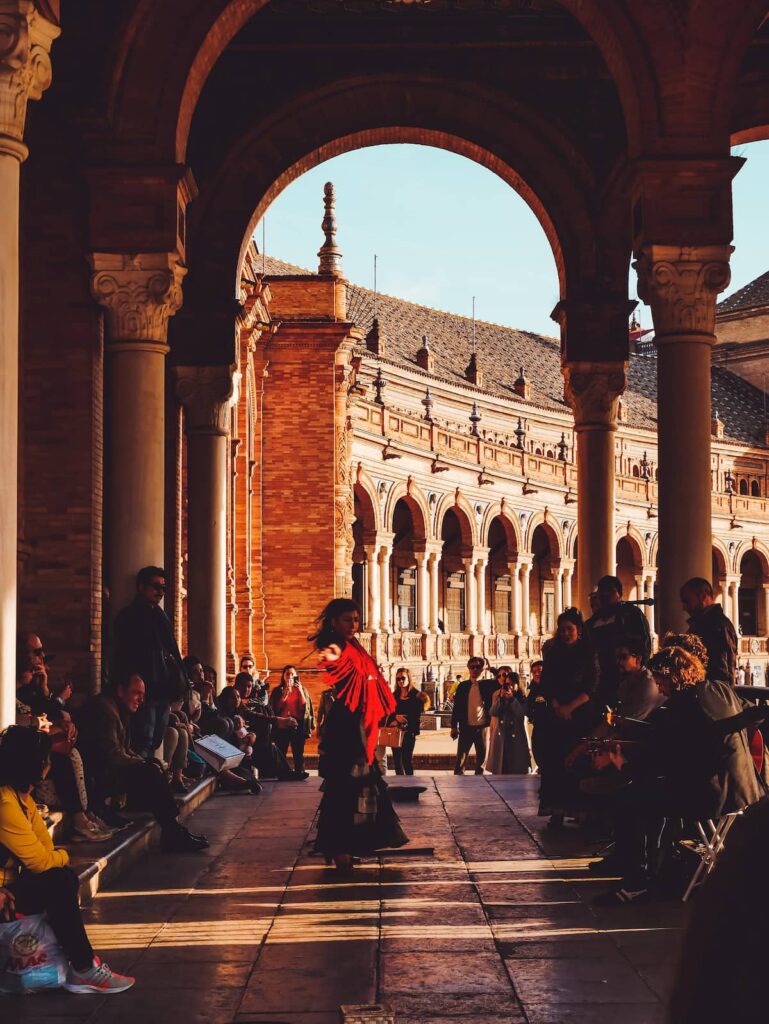
Visiting Seville, Spain: Travel Tips
Here’s what you need to know to plan your trip to Seville.
Getting to Seville
Seville is a major hub for transportation in southern Spain, with an international airport and high-speed rail connections to Madrid and other cities so it’s super easy to get here.
Travelling from Cadiz to Seville? Then check out our Cadiz-Seville transport guide for everything you need to know.
If you’re coming from outside of Spain, it’s best to fly into the city. Seville has its own international airport, the Seville Airport (SVQ), which is located about 10 km from the city center. It offers direct flights from many European cities, as well as some destinations in North Africa.
There are also some domestic flights from other Spanish airports but depending on where you’re coming from, you may be better off taking a train or bus versus flying (more on that next!).
The Seville airport is pretty small so don’t expect much on top of the basic services and amenities.
Seville is well-connected by rail to other cities in Spain, including Madrid, Barcelona, and Malaga. The Santa Justa train station is located about 2 km from the city center.
Here are approximate travel times for trains to Seville from other major Spanish cities:
- Train from Madrid to Seville: The AVE high-speed train connects Madrid and Seville in about 2.5 hours, making it the fastest way to travel between the two cities. I’ve done this journey before and it’s super comfortable and fast – I would highly recommend it!
- Train from Barcelona to Seville: The fastest way to travel from Barcelona to Seville is by AVE high-speed train, with a travel time of about 5.5 hours.
- Train from Valencia to Seville: The travel time between Valencia and Seville by train is about 6 hours, with direct connections available by high-speed train.
- Train from Malaga to Seville: The travel time between Malaga and Seville by train is about 2 hours, with direct connections available by high-speed train.
Tip: Travel times may vary depending on the specific train service, departure time, and any connections involved. It’s always best to check schedules and book your tickets in advance to ensure a smooth and efficient journey to Seville. Typically, tickets are available up to 4 months before your travel date. Head to the Renfe website (be sure to toggle to the English language for easy navigation) to search for your routes.
Seville has a modern bus station, the Estación de Autobuses Plaza de Armas, which serves many domestic and international destinations.
The bus station is located not too far from the historic center and depending on where you’re staying, you may be able to walk there. If not, no worries. Ths bus station is also a local transportation hub and there are numerous public buses that serve the station (lines 3, 6, 21, 43, A2, A7, C3, EA).
You can search for and buy bus tickets online and the bus company will depend on your departing destination. ALSA , which runs services across Spain, is a good place to check first.
Travel times may vary depending on the specific bus service, departure time, and any connections involved but here are some estimated travel times:
- Bus from Madrid to Seville: The travel time between Madrid and Seville by bus is approximately 6 hours, with several bus companies offering regular services.
- Bus from Barcelona to Seville: The travel time between Barcelona and Seville by bus is approximately 14 hours, with direct connections available from some bus companies.
- Bus from Valencia to Seville: The travel time between Valencia and Seville by bus is approximately 10-12 hours, with some services requiring a transfer in Madrid.
- Bus from Malaga to Seville: The travel time between Malaga and Seville by bus is approximately 2.5 hours, with frequent direct connections offered by several bus companies.
As you see, taking a bus to Seville takes longer so if you’re short on time, then traveling by train is the best option. That said, bus tickets are cheaper so there is a trade-off.
If you prefer to drive, Seville is well-connected to other cities in Spain by highways and roads.
However, keep in mind that parking in the city center can be challenging, so it’s best to park outside and take public transport or walk. On my last trip of Seville, our car basically stayed in its parking lot during our entire stay there as we walked everywhere.
Car Rental Recommendation
If you’re looking for the best prices for car rental during your stay in Spain, check out Discover Cars . Just plug in your location and dates and you’ll get the best deals available. Super convenient and easy!
Getting Around Seville
Once you’re safely in Seville, getting around the city is easy. Most of the key tourist attractions and places of interest are located within Seville’s historic center, so the best way to get around is by foot.
You can easily plan your days to focus on specific areas if you’d like to minimize walking across the city. Walking around Seville is also an awesome way to get a taste of the city’s vibe and maybe even stumble across some hidden gems!
If you’d like to be a bit more mobile, there are bike and electric scooter rentals located around the city. It’s fairly inexpensive and what’s more, it’s a fun way to explore Seville! There are bike lanes available on the larger streets, although I don’t believe any are available within the historic center itself. If you do decide to go with an electric scooter, do note that the uneven ground in the historic center will make it a bit challenging to scooter quickly.
Seville has an efficient and modern public transportation system, including buses, trams, and a metro line. The public transport network covers most areas of the city and is relatively inexpensive. As a visitor, I would say that you’re most likely to use the tram or buses.
Buses in Seville
The bus system in Seville is extensive and easy to use. Bus stops are clearly sign-posted and you can buy a bus ticket when you board. Buses typically run from around 6.00am to 11.30pm and there are some night buses that run until 2.00am. At the time of publishing, a single-journey ticket costs €1.40.
There are also two transport card options that offer more value for money:
- Tarjeta Multiviaje is a rechargeable card (with a refundable deposit for the card) that can be use on buses and the tram. The minimum amount is seven euros and when using this card, each journey costs less than a single-journey ticket (under €1). You can buy and recharge a card at kiosks and estancos (tobacconists). This is ideal if you’re taking multiple bus or tram journeys during your Seville visit.
- Intended for short visits, Tarjeta Turista offers a one-day card (€5) or three-day card (€10) with unlimited travel. These can be purchased in the TUSSAM Information Points at Prado San Sebastián, Plaza Ponce de León y en Avda. Andalucía, 11. Like the Multiviaje, there’s a €1.50 deposit fee.
For more information on buses in Seville, visit the TUSSAM website .
Tram in Seville
Called the MetroCentro, the T1 tram is a short-distance tram with just 4 stops. It goes south from Plaza Nueva through the centre of the city (with a stop next to the Alcazar( to the San Bernardo train station.
A one-way ticket costs €1.20 and you can buy tickets at the machines on the tram platform (be sure to validate them when you get on the tram!). It’s cheaper if you have a Tarjeta Multiviaje card.
Taxis in Seville
Taxis are a convenient and efficient way to get around Seville, especially for if you are traveling in a group, have mobility issues, or when you need to travel with luggage. That said, there are some taxi drivers that take advantage of tourists so here’s what you need to know about taking a taxi in Seville.
Taxi fares in Seville are metered and are based on the distance traveled and time taken. There are additional charges for weekends, holidays, night journeys, and for carrying luggage. You can expect a taxi from the airport to the center of Seville to cost around €20. ( Click here to see a breakdown of how tariffs and charges are imposed.)
There are taxi stands located throughout the city, including at major transport hubs, such as the airport, train station, and bus station. You can also flag down a taxi on the street, but it’s often more convenient to use a taxi stand to avoid any confusion or misunderstandings.
Taxis in Seville are generally safe and reliable, but it’s always best to take precautions when using any form of public transport. Make sure to only use licensed taxis, check the meter is running, and keep your belongings with you at all times.
Best Time to Go to Seville
In my opinion, the best time to visit Seville is during the spring (March to May) or autumn (September to November) months. During these periods, the weather is pleasant and comfortable, with warm days and cool nights. The crowds are also thinner, and prices for flights and accommodation are generally lower.
In spring, Seville is in full bloom with colorful flowers and lush greenery. This is the perfect time to visit the city’s many parks and gardens, including the famous Parque de María Luisa and the stunning Alcázar Gardens. The city also celebrates its annual Feria de Abril (April Fair) during this season, where locals and tourists come together to enjoy flamenco music, dance, and traditional food.
Autumn is another great time to visit Seville, as the weather is mild and perfect for exploring the city on foot. This is also the season for the annual International Film Festival of Seville, where film enthusiasts gather to watch the latest independent films from around the world.
I’ve visited Seville twice during the autumn months and it’s my favorite time to visit in terms of vibe, weather, and activities.
I would discourage you from visiting Seville in the summer months. Summer in Seville can be scorching, with temperatures often exceeding 40°C (104°F). The high temperatures can make it uncomfortable to explore the city during the day, and many locals take their holidays during this period. However, if you don’t mind the heat and crowds, summer can be a good time to experience the lively nightlife and outdoor events and festivals that take place throughout the city.
Winter in Seville is mild, with occasional rain and cool temperatures. If you’re looking to avoid crowds, then winter in Seville is for you. I’ve visited Seville in February towards the tail end of winter and loved my time there. It was still lively but not overly crowded and some days, with the warm sunshine on me, it didn’t even feel like winter! Learn more about winter in Seville in this article.
Overall, the best time to visit Seville depends on your preferences and travel style. Spring and autumn are generally the best seasons for comfortable weather, fewer crowds, and affordable prices. For a closer look at the weather in Seville and tips for enjoying the weather, read this article. You can also read our more in-depth article on the best time to go to Seville .
How Many Days to Spend in Seville?
Seville is lively and vibrant and there’s a lot to do here! On my first visit, I was in Seville for only 3 days and felt so sad to leave. I recommend spending at least three to four days in Seville to get a good sense of the city and its attractions. This timeframe would allow you to explore the historic center, visit the main landmarks, and experience the local culture and cuisine.
Ideally, if you have time to spare, I suggest 4 to 5 days in Seville as this would allow you to include a day trip in your itinerary. Seville to Cordoba is one of the most popular day trips and it’s well worth the effort – I’ve done it myself! Other day trip possibilities from Seville include the ancient Roman city of Italica or the charming town of Carmona.
However, if you’re short on time, it’s still possible to see the highlights of Seville in just a weekend (that is, 1 to 2 days). In this case, I recommend focusing on the must-see attractions and planning your itinerary carefully to make the most of your time in the city.
- Check out our One Day in Seville Itinerary to help you plan the perfect day!
- Have more time? Then our Seville 2-day itinerary might work for you
- For the ideal trip, spend 4 days in Seville
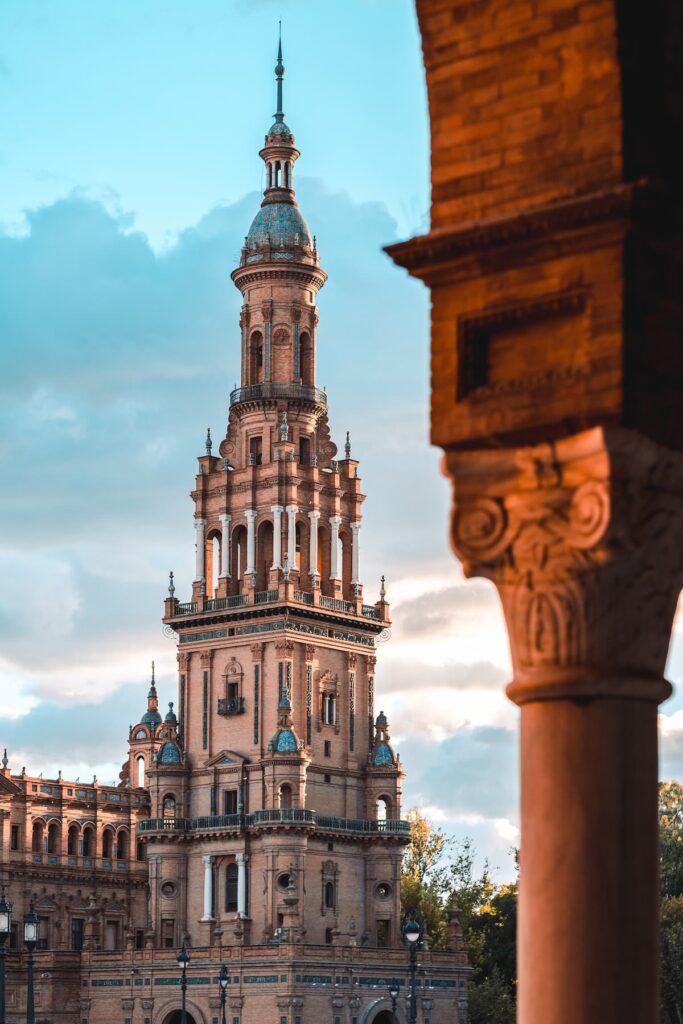
What to Do in Seville, Spain
Here’s a quick overview of the best things to do in Seville, Spain:
- Marvel at the Real Alcázar: This stunning palace complex is one of Seville’s top attractions, with its beautiful gardens, intricate architecture, and fascinating history. Here, you’ll get a closer look at the city’s Moorish past and it’s a wonderful complement to the Alhambra, if you’re visiting Granada as well.
- Explore the Cathedral of Seville: This massive Gothic cathedral is the third largest in the world and boasts impressive features such as the Giralda Tower and the tomb of Christopher Columbus. The walk up the Giralda is long and steep but the view is totally worth it!
- Wander around the Santa Cruz neighborhood: This charming, historic district is filled with narrow streets, picturesque courtyards, and traditional houses, making it the perfect place to wander and soak up the local culture. I’ve gotten delightfully lost in this neighborhood but didn’t mind it at all.
- See a flamenco performance: Seville is known as the birthplace of flamenco, and there are many opportunities to experience this passionate dance form through performances at local venues. I’ve watched flamenco twice in Seville and both times, the performances were so emotional and moving.
- Wander around the Plaza de España: When you say Seville, it’s often a picture of the Plaza de España that comes to mind. This iconic landmark is a must-see, with its grand size, stunning architecture, and intricate tilework depicting each province of Spain. If you’re lucky, you might come across flamenco artists performing here… it’s such a cool experience!
- Explore the Triana neighborhood: For a more authentic, down-to-earth side of Seville, head across the river to Tirana. This lively and colorful district is known for its vibrant nightlife, local markets, and ceramic shops. Tirana feels more lived-in and real and it’s fun to wander around the neighborhood.
- Go to the Metropol Parasol (aka Las Setas) : Here, you can enjoy a more quirky side of Seville. This modern and innovative wooden structure is a unique addition to Seville’s skyline and provides stunning views of the city. You’ll find a mix of locals and tourists just hanging out and it’s a great place to people-watch.
- Visit the Museum of Fine Arts: Calling all art-lovers! This museum houses an impressive collection of Spanish art, including works by famous painters such as Velázquez and Murillo. (Pssst, entry is free for EU nationals!)
- Stroll along the Guadalquivir River: If you want a spot of relaxation, a walk along the Guadalquivir will do the job. This scenic river provides a unique perspective of Seville, with views of iconic landmarks such as the Torre del Oro and the Maestranza bullring. Take in the sunshine, the sights, and mingle with locals.
- Visit the Mercado de la Encarnación: I love learning about a city through its food and there’s no better way to do that than to visit a local market. This indoor market is a food lover’s paradise, with its wide variety of fresh local produce, meats, and seafood.
These top 10 attractions provide a well-rounded experience of Seville’s history, culture, and beauty and you can easily cover them in 3 to 4 days! For the full list of things to do in Seville, click here .
And the fun doesn’t stop in Seville when the sun sets – check out the best things to do in Seville at night .
If you’re looking to spend some time by the sea, check out the best beaches close to Seville .

Recommended Tours & Activities in Seville
- Discover the city’s highlights on a free walking tour ! I love walking tours and take them whenever they’re available. They’re an awesome way to get to know a city when you first arrive.
- The line to enter Seville Alcazar is notoriously long (I once had to change my plans as the line was too long!) so it’s good idea to skip the line and buy your ticket in advance . If you’re a history lover like me, then you may also be interested in a guided tour of the monument so that you can learn more about its history.
- The Seville Cathedral is also a super popular tourist attraction. Click here to buy your entry ticket (includes the Giralda) in advance.
- Want to visit the Alcazar, Cathedral, and Giralda in one day? Join a local guide in this 2.5-hour tour which includes all entry tickets.
- It’d be a shame not to watch flamenco while in Seville! Check out this flamenco show in a historic venue or this flamenco show in Tirana .
- Enjoy a relaxing day out on the river on this 2-hour yacht tour when you can admire Seville from the water.
- Get acquainted with some of the best spots to eat in Seville in this tapas crawl (yummy!).
- Shop at the market like a local and learn how to make traditional Spanish dishes in this cooking class in Seville .
Here are other popular activities in Seville:
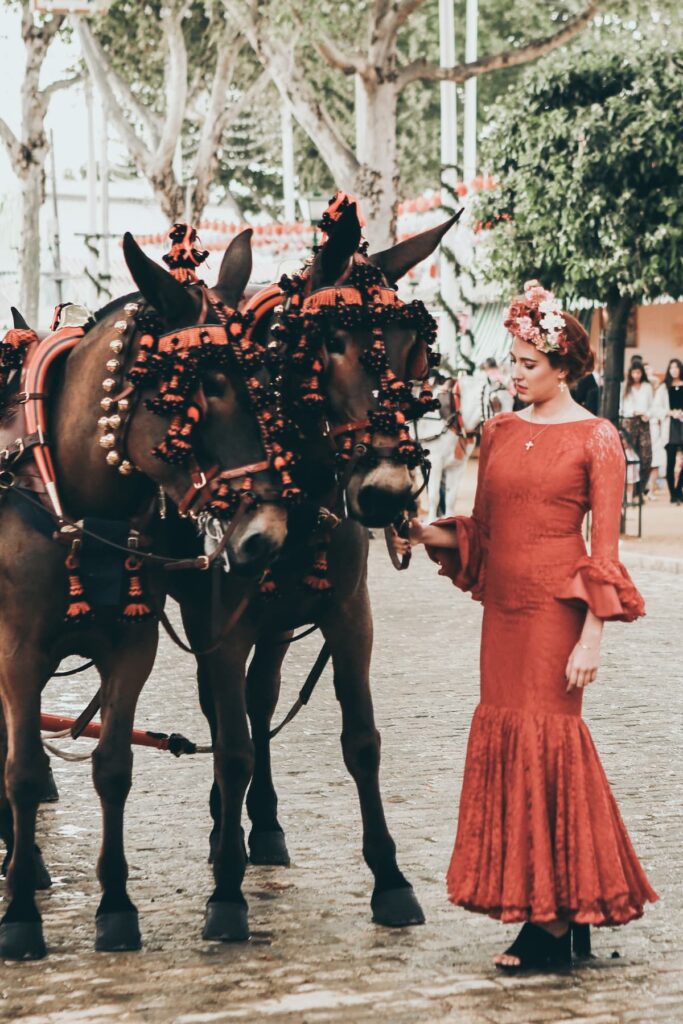
Festivals in Seville
Seville is known for its vibrant and colorful festivals which celebrate the city’s rich history and culture. These three festivals provide a glimpse into Seville’s rich history and culture, and they are a great way to experience the city’s unique traditions and customs.
Semana Santa (Holy Week)
Semana Santa is a major religious holiday in all of Spain and it is especially impressive in Seville. The celebrations in Seville are said to date back to the 16th century and today, the traditions live on.
Locals spend all year preparing for this week-long festival thattakes place in the week leading up to Easter.
Processions of elaborately decorated floats (called pasos ) carrying statues of the Virgin Mary and Jesus, wind through the streets of Seville, accompanied by the mournful sound of music played by marching bands. Some of the processions last up to 12 hours with devoted locals carrying the pasos !
The main processions take place in the city center, around the Cathedral and other historic churches. You can get more infromation on the Semana Santa routes in Seville on this website .
Tip: For a memorable sight, stand by the river and watch the processions come from Triana over the Puente de Isabel II.
Feria de Abril
This week-long festival of music, dancing, and traditional dress is one of the most important events on the Sevillian calendar. Feria de Abril typically takes place two weeks after Holy Week, and it celebrates Seville’s cultural heritage.
The fairground is set up in the district of Los Remedios, with hundreds of colorful tents (called casetas ) set up for eating, drinking, and dancing. The streets are filled with people wearing traditional flamenco dresses and suits, and the atmosphere is festive and joyful. Expect horse-drawn carriages, flamenco music, and tons of fun!
The fair also features a large amusement park, with rides and attractions for all ages. Feria de Abril is an unforgettable way to experience Seville’s vibrant culture and traditions.
Bienal de Flamenco
If you love music and dance, then you can’t miss the Bienal de Flamenco in Seville.
This biennial festival celebrates flamenco, a traditional Spanish art form that combines singing, dancing, and guitar playing. Today, it is one of the most important flamenco festivals in the world.
During the Bienal de Flamenco, you’ll find performances by some of the most renowned flamenco artists, as well as up-and-coming talents. The shows take place in various venues throughout the city, including historic theaters, flamenco clubs, and outdoor stages.
The festival also offers workshops, lectures, and exhibitions that explore different aspects of flamenco culture so it’s the ideal time to learn about the history and evolution of flamenco, as well as the various styles and techniques used in the art form.
The Bienal de Flamenco is a unique opportunity to experience the passion and intensity of flamenco, and to immerse oneself in the rich cultural heritage of Seville. It is a must-see for anyone interested in flamenco or Spanish culture.
The festival will be next held in 2024. For more information, check out the official website .
Tip: Seville goes into overdrive when there’s a festival so if you’re planning a visit during one of these times, it’s a good idea to book your accommodation in advance.
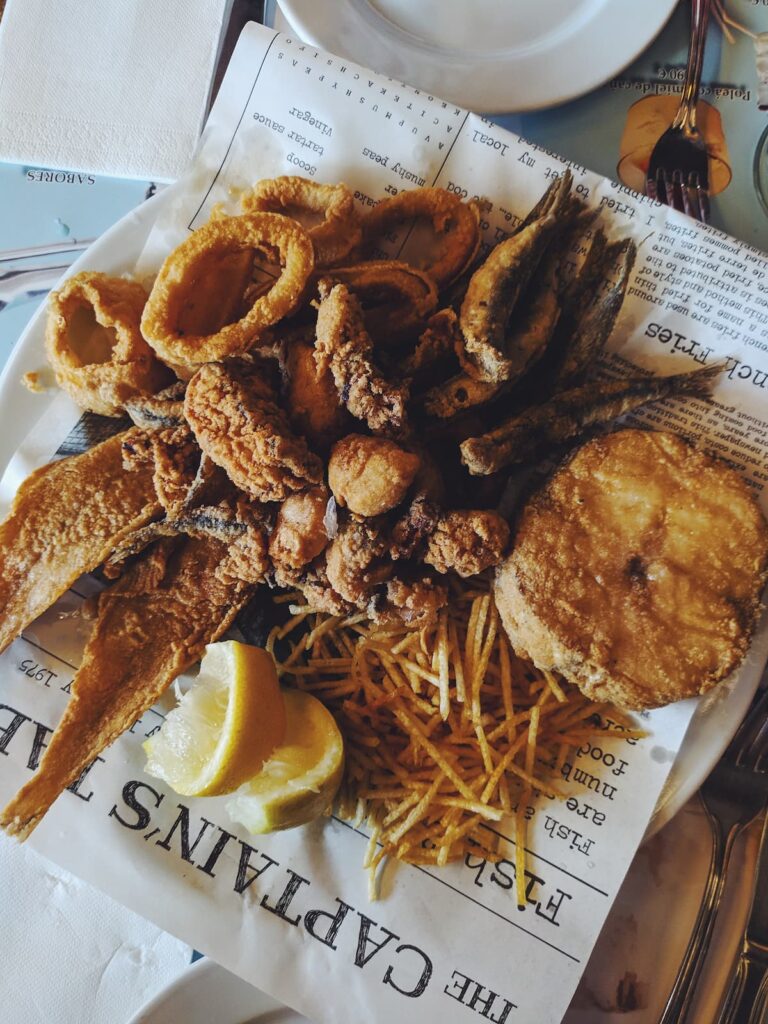
What to Eat in Seville
Ain’t nothing like food to get to know a place! If you’re excited to check out Seville’s culinary delights, you won’t be disappointed! Here, you’ll find some Spanish national favorites but also some local delicacies that are unique to the icty.
Some of the most popular local dishes and must-try foods in Seville include:
- Tapas: Seville is famous for its tapas, small plates of food that are perfect for sharing. Some popular tapas dishes include tortilla española (Spanish omelet), croquetas (deep-fried balls of bechamel and filling), and montaditos (small sandwiches).
- Gazpacho: This cold soup is made with tomatoes, peppers, cucumbers, bread, olive oil, and garlic. It’s perfect for hot days in Seville and is a refreshing and healthy option.
- Pescaíto frito : This is a fried fish dish that is popular throughout Andalucia. It’s usually made with small fish such as anchovies or sardines, and it’s often served as a tapa.
- Huevos a la Flamenca: This dish consists of baked eggs in a tomato sauce with chorizo, ham, and vegetables. It’s a hearty and flavorful dish that is perfect for breakfast or brunch.
- Solomillo al Whisky: This is a pork tenderloin dish that is cooked with whisky, garlic, and olive oil. It’s a classic Sevillian dish and is often served as a main course.
Sevillanos also love their desserts, and there are many delicious options to choose from, such as tocino de cielo (a rich egg yolk dessert), torrijas (similar to French toast), and yemas de San Leandro (sweet egg yolk candies).
So, as you wander around Seville, don’t forget to spot these items on the menu and give them a try!
More on Seville
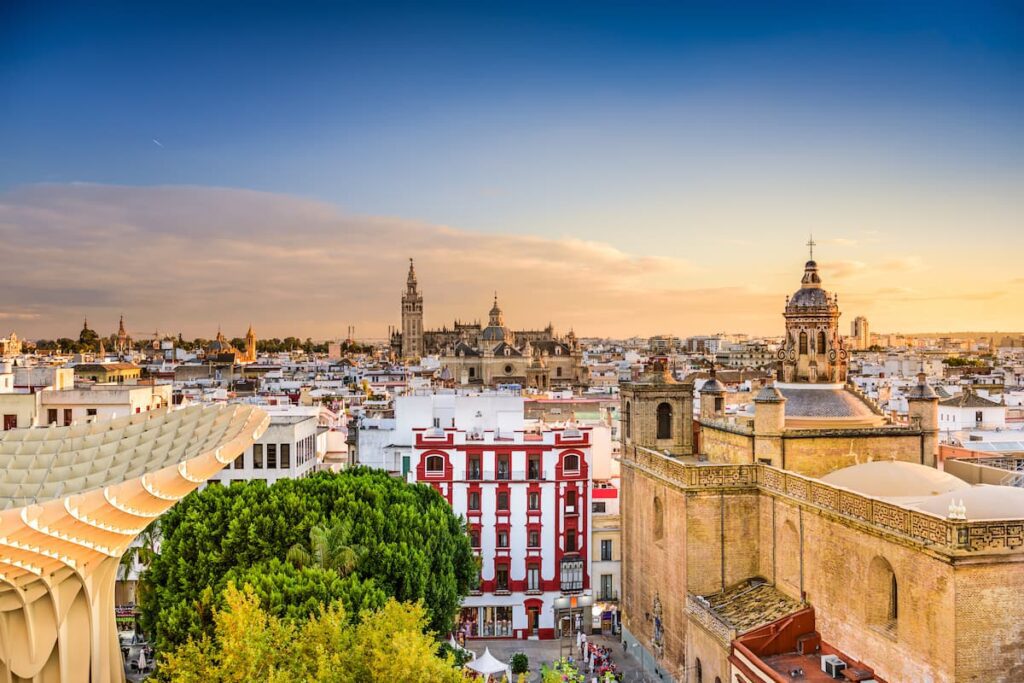
The Ultimate Guide to Seville in 2 Days

One Day Seville Itinerary: See the Best of Seville in 24 Hours
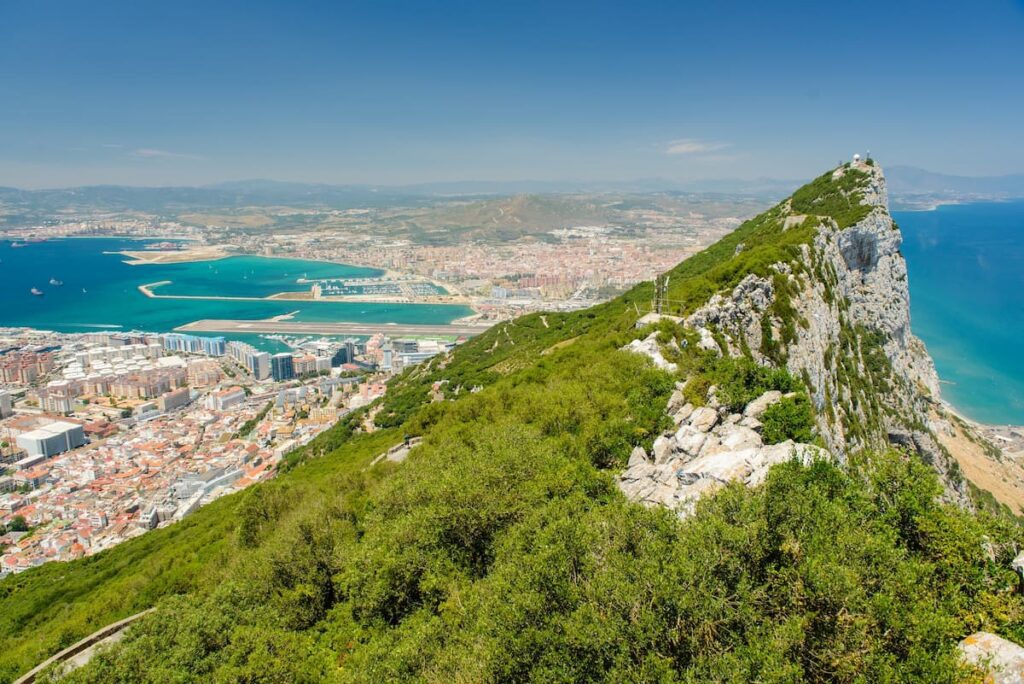
Gibraltar Day Trip from Seville: All You Need to Know (2023 Guide)

Seville to Granada Day Trip: The Perfect One Day Itinerary
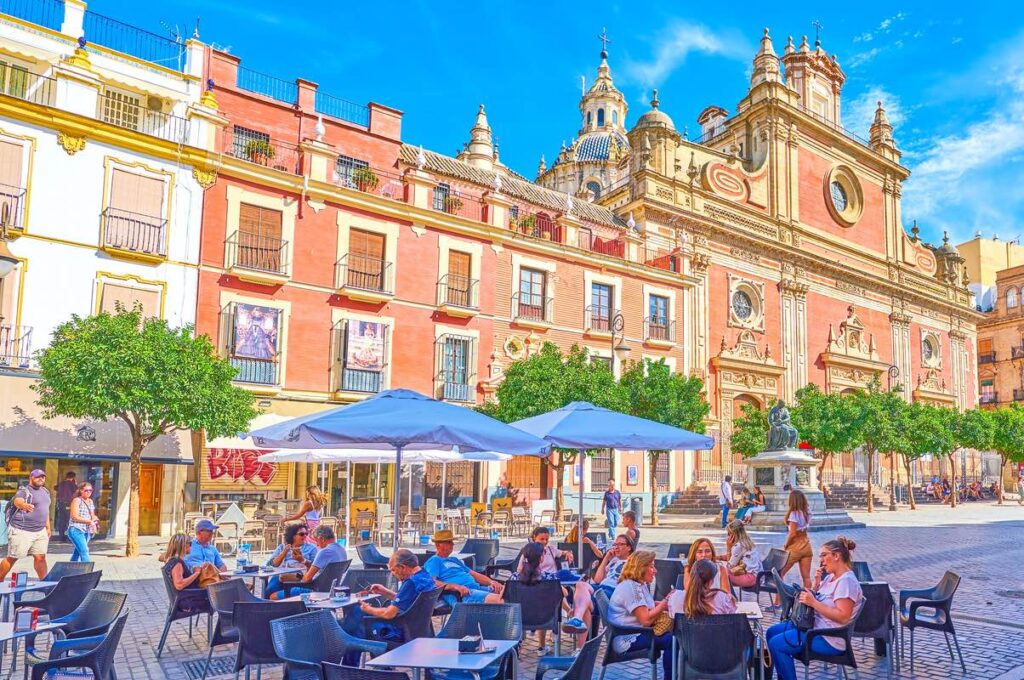
Cadiz to Seville: Ultimate Transport Guide (2023)
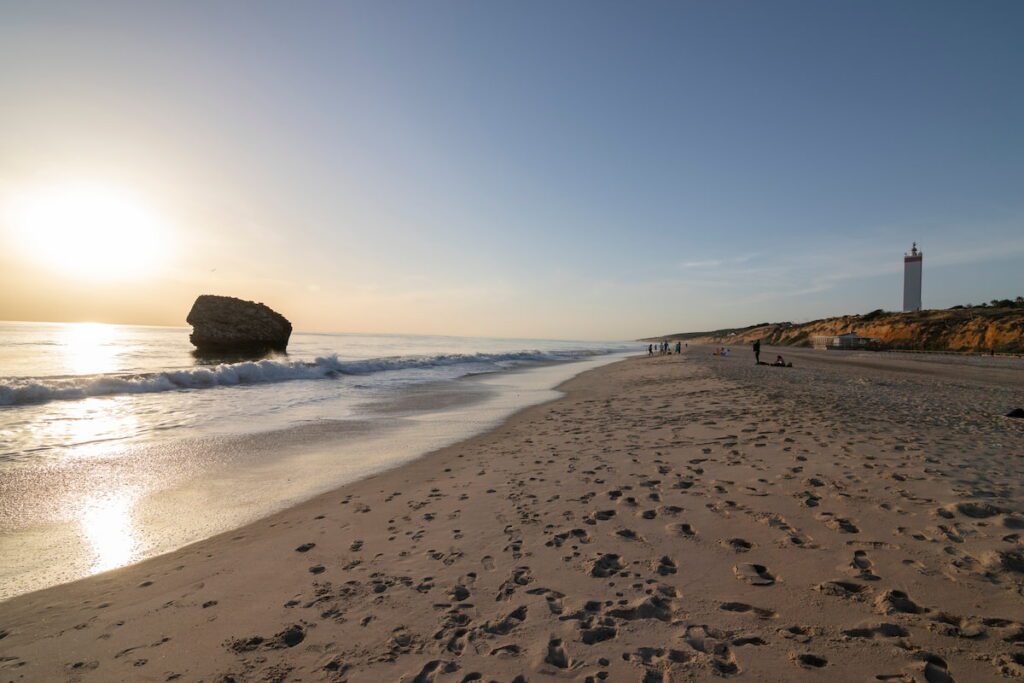
Discover the Best Beach Near Seville for Your Next Vacation (2023)
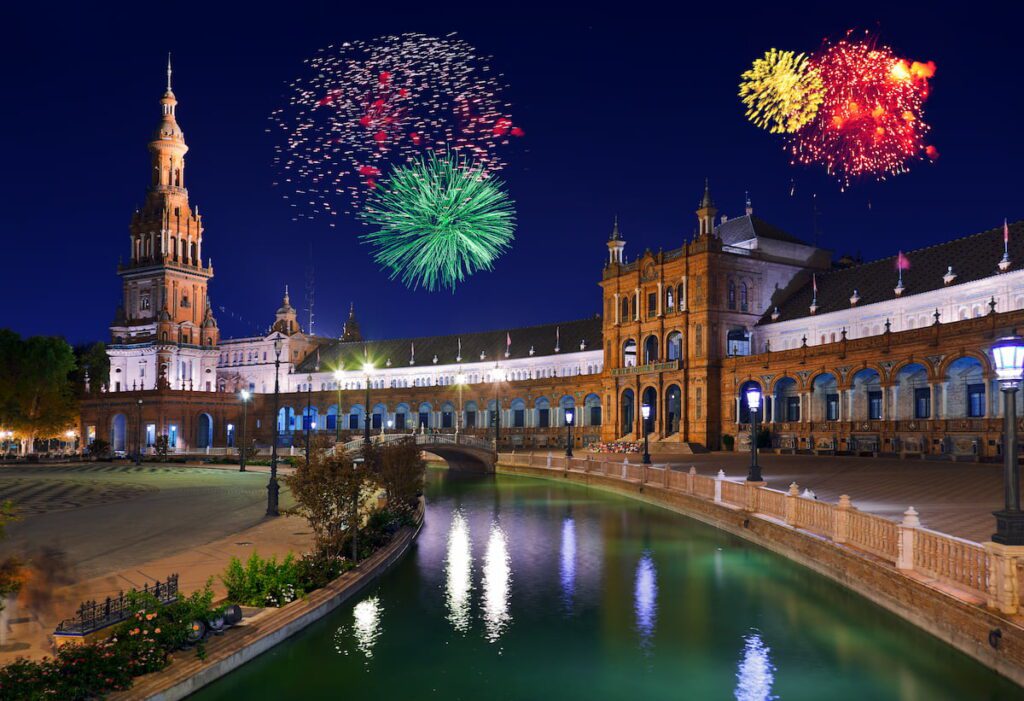
Winter in Seville: Weather, Things to Do, and What to Expect
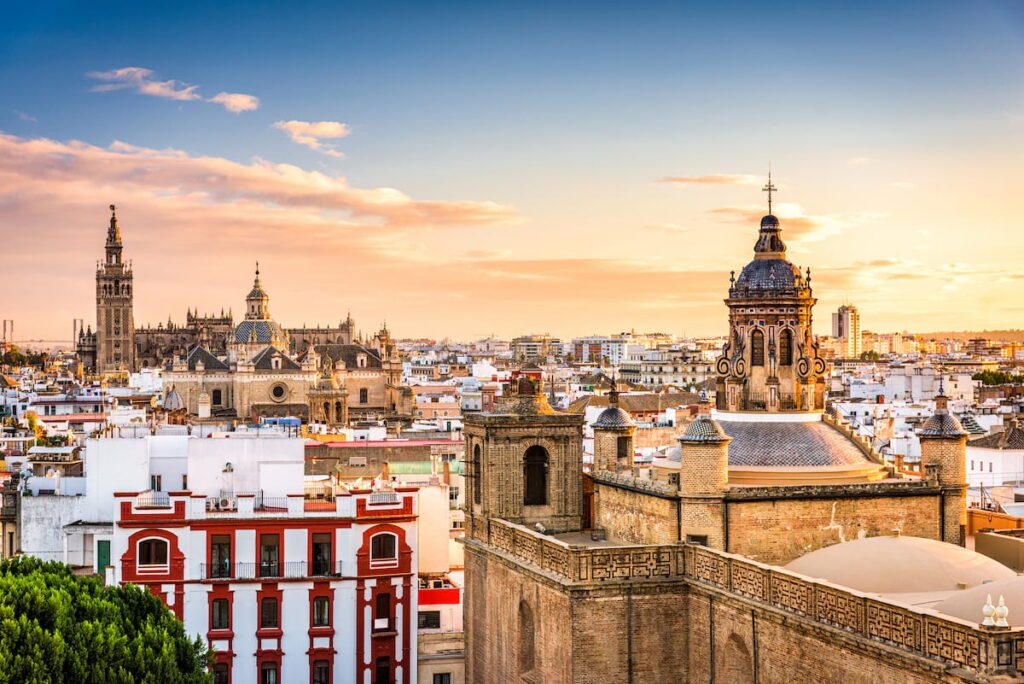
26 Marvelous Things to Do in Seville, Spain (Don’t Miss Them!)

4 Days in Seville: What to See and Do for an Unforgettable Trip
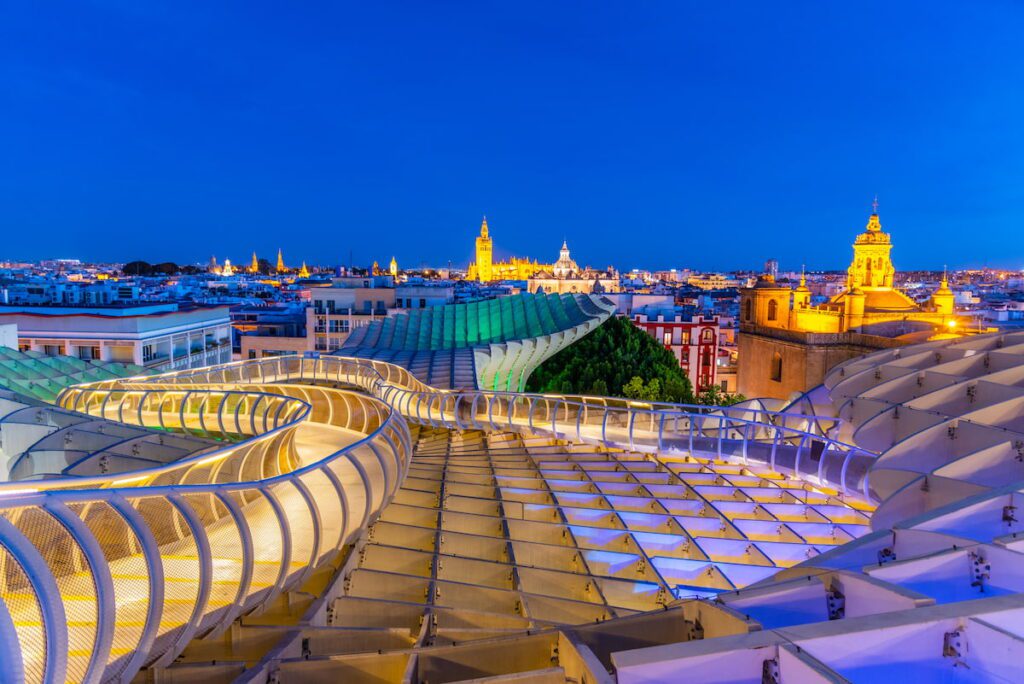
Best Things to Do in Seville at Night (2023 Guide)
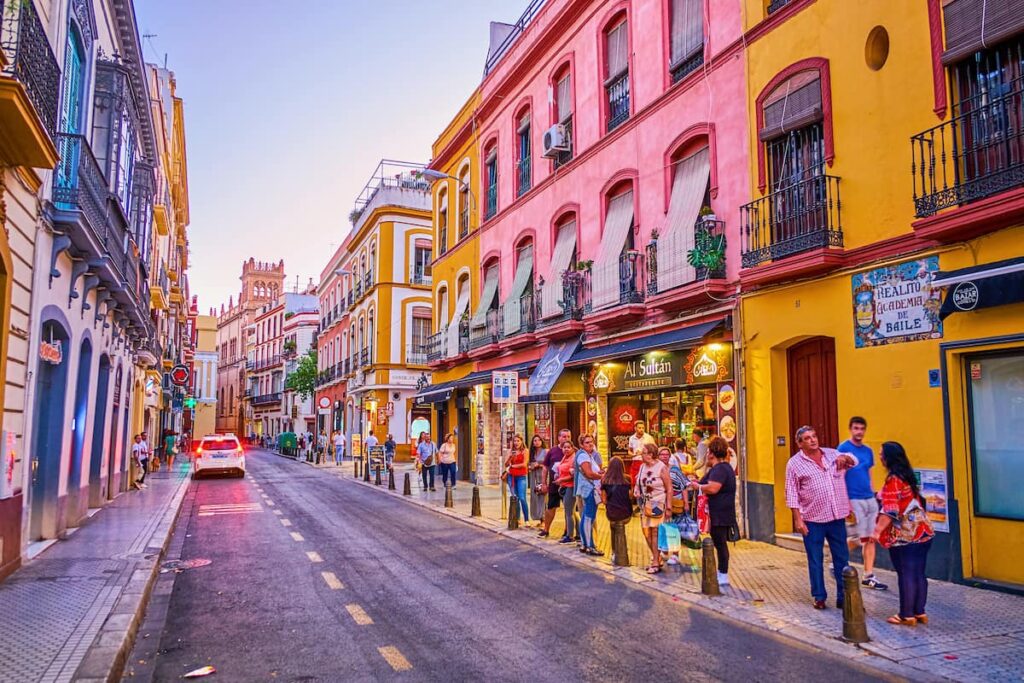
Best Time to Visit Seville, Spain: A Comprehensive Guide
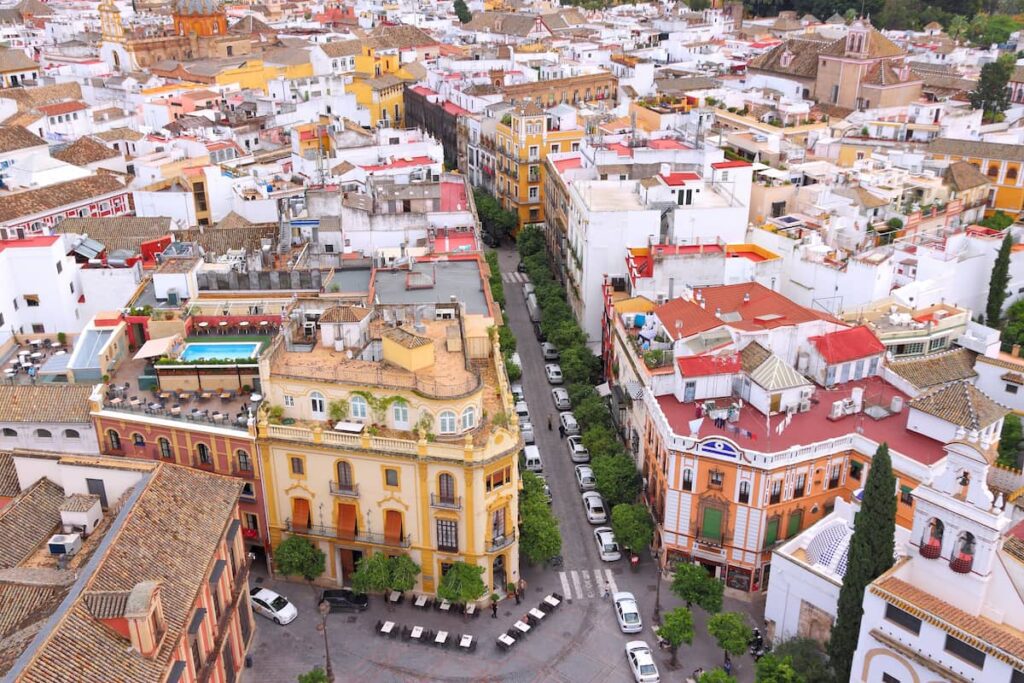
Seville, Spain Weather: When to Go, Travel Tips & FAQs
- What to See
Tourist Attractions in Seville
Find out about the main tourist attractions in Seville and the essential things to see in the city before you make your trip to Seville.
Essential Tourist Attractions
Seville cathedral, torre del oro, plaza de españa, triana bridge, real alcazar of sevilla, general archive of the indies, maría luisa park, santa cruz neighbourhood, palace of the countess of lebrija, antiquarium, casa de pilatos, metropol parasol, palace of the dukes of alba, hospital de los venerables, hospital de la caridad, divine salvador church, maestranza bullring, you may also be interested in.
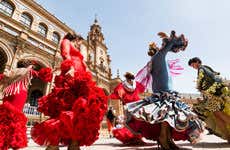
Music, singing, dancing and emotions, stated by UNESCO as an Intangible Cultural Heritage of Humanity, flamenco is the most representative Andalusian art and the most popular Spanish genre known all over the world.
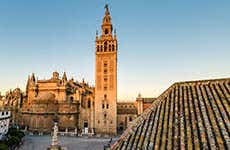
Built originally as the minaret for the mosque and years later converted into the cathedral's bell tower, the Giralda is the most emblematic monument in the city and one of the most visited.

One Day in Seville: Itinerary for First Visit (+Walking Map & Tips)
By Author Jurga
Posted on Last updated: January 15, 2024
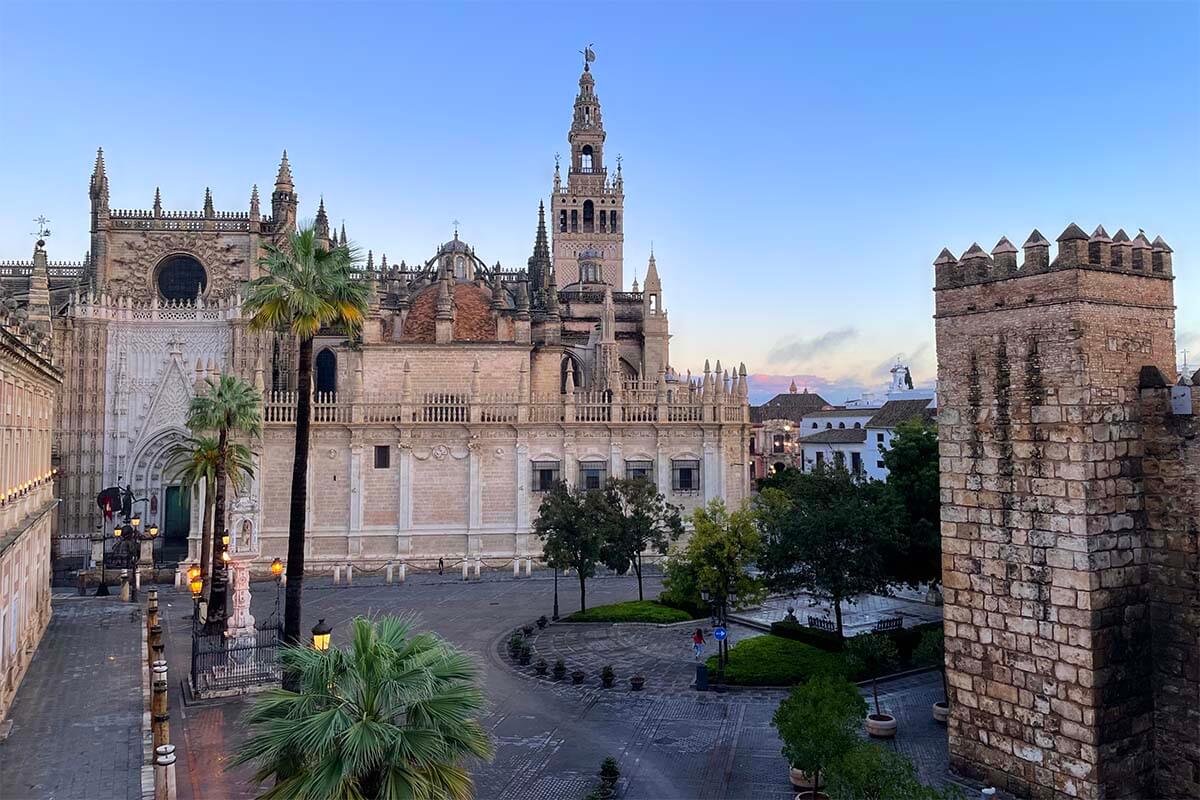
Visiting Seville for just a day and wondering how to see the best of the city in a short time? In this guide, we share a recommended one-day Seville itinerary that covers the main sights and gives you a good introduction to this beautiful city in Andalusia in southern Spain.
This itinerary takes into account the opening times and the time that it takes to actually visit the main attractions or walk between different places. We also share our experience-based suggestions and tips on how to avoid the long queues and make the most out of your day in Seville.
To help you plan your sightseeing itinerary, we also created a map indicating a scenic walking route that connects all the top places (you can see it below). Please note that the walking route doesn’t indicate the evening part of the itinerary – that is because we have three different suggestions for you to choose from, and so where exactly to walk will depend on that.
Also, remember that the best way to explore any European city is by simply wandering around – you may discover some beautiful hidden gems that way. So simply use this 1-day Seville itinerary as a guide to the best experiences that are worth your time the most, and adjust it based on your personal interests, ticket availability, etc.
READ ALSO: Spain Bucket List
How to use this map: Use your computer mouse (or fingers) to zoom in or out. Click on the icons to get more information about each place. Click the arrow on the top left corner for the index. Click the star next to the map’s title to add it to your Google Maps account. To view the saved map on your smartphone or PC, open Google Maps, click the menu and go to ‘Your Places’/’Maps’. If you want to print the map or see it in a bigger window, click on ‘View larger map’ in the top right corner.
1 Day in Seville Itinerary – Overview
Here’s our recommended itinerary for one day in Seville in a nutshell:
- 9.30 – 11 AM: Royal Alcázar timed-entry tickets or early-access tour .
- 11.15 AM – 12 PM: Seville Cathedral and Giralda Tower: timed-entry tickets or guided tour .
- 12 – 2 PM: Explore the old town + lunch.
- 2 – 2.30 PM: Plaza de Toros (bullring).
- 2.30 – 3.30 PM: Torre del Oro and riverside walk.
- 3.30 – 4.30 PM: Plaza de España and Maria Luiza Park.
- Evening: Flamenco show and dinner (we booked this flamenco + tapas tour , and there are many other options ).
- Late evening: Setas de Sevilla.
You can find all the details, pictures, and useful information for each of these sights and attractions further below. Read on!
TIP: If you are not interested in tours and rather just get tickets, this Seville Super Combi includes the main attractions and allows you to choose all the time slots in one booking.
READ ALSO: How to See the Best of Seville in 2 Days

Here is a detailed Sevilla 1-day itinerary:
Royal Alcázar of Seville
9.30 – 11 AM.
The Royal Alcazar (Real Alcázar) is one of the absolute must-sees in Seville. Because it opens earlier in the morning than many other places, we suggest starting your day here. Plus, it’s so popular and so busy that the best way to make the most of your visit (and plan the rest of your day) is by coming here first thing in the morning.
Real Alcarzar is an impressive palace complex that was built in different phases spanning over many centuries starting from the High Middle Ages. This has led to a unique mix of architectural styles with a strong Moorish influence, but also Baroque and Renaissance styles.
The palace is huge, with multiple buildings and countless rooms, and it’s surrounded by vast gardens. You could easily spend half a day here alone and still not see everything… But with just a day in Seville, we recommend that you plan 1.5-2.5 hours for Alcazar.
Good to know: No matter how you decide to visit Royal Alcazar – on your own or with a tour – be sure to book in advance and get the earliest possible time slot (or the earliest tour). The palace normally opens at 9.30 AM and by 9 AM there is already a queue that stretches for a few blocks… So – once again – be sure to book ahead or you will waste too much time!
Planning info: For this itinerary, we recommend either timed-entry tickets (get the 9.30 AM slot, but arrive earlier!) or this ‘Alone in the Alcazar’ tour (that starts at 8.30 AM). We opted for this tour and could enter the palace an hour before it opened to the public. It’s an absolutely unique experience and worth every cent. However, availability is limited and these tours only run a few times a week. Be sure to check if it’s possible during your visit and don’t hesitate – it’s a once-in-a-lifetime experience.

Cathedral & Giralda Tower
11.15 AM – 12 PM.
The Seville Cathedral is another must-see in the city, just as its impressive tower, Giralda . The Cathedral is located just near the Alcazar and so we suggest continuing your sightseeing itinerary here.
In 1401, the city decided to demolish an old mosque that served as a cathedral at that time and to build a new church that would be “so beautiful and so grand that those who see it will say we were mad”. Indeed, the Cathedral of Seville is immense. It’s also the largest Gothic church in the world and one of the largest Catholic churches ever built.
The exterior of the church is absolutely impressive, but the interior is well worth seeing too. Some of the must-sees inside include the main altar, the monumental grave of Christopher Columbus, and the works by Goya, Zurbaran, and Murillo.
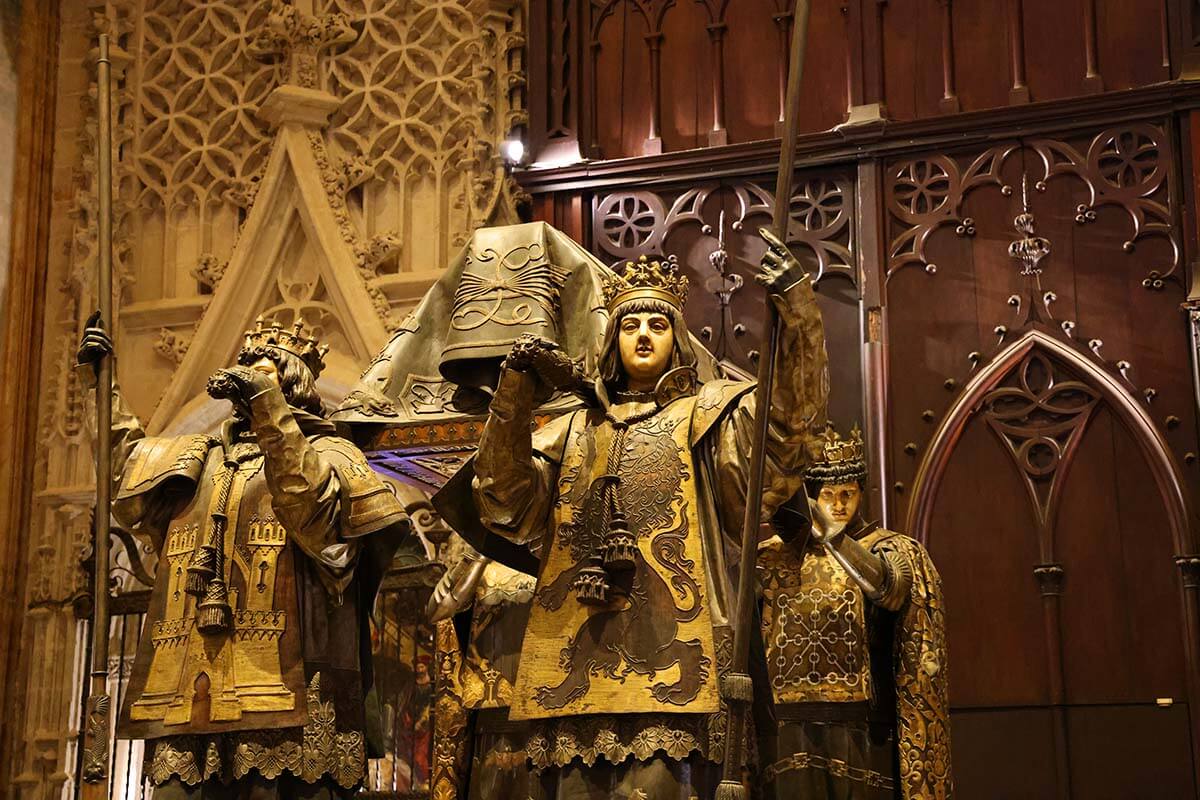
From the Cathedral you can also access the Giralda Tower . The 96-meter-high tower was part of an old mosque and was kept as a bell tower when the new church was built. It is possible to climb the tower to enjoy 360° views of the city. However, keep in mind that a metal safety net obstructs the views so taking any decent pictures from the top is very difficult.
TIP: If you want to be sure to visit the Cathedral, you have to book a timed-entry ticket in advance! Also, if you want to climb the tower, do that first thing after the security check (before you even enter the church). When it’s busy, they give priority to those who are entering from the outside with timed tickets rather than people who are already inside the church. You can visit the church itself after you come down from the tower.
Planning info: For this itinerary, we recommend booking a time slot at around 11-11.30 AM. If you want to spend more time at the Alcazar, plan to visit the Cathedral a bit later (but keep in mind the rest of the itinerary and what else you want to see with a day in Seville).
Good to know: On Sundays, the Cathedral only opens late in the afternoon. So if you are visiting Seville on a Sunday (and this is the only day that you have in town), you’ll have to adjust this itinerary. Because many sights are located relatively close to each other, it’s easy to do.
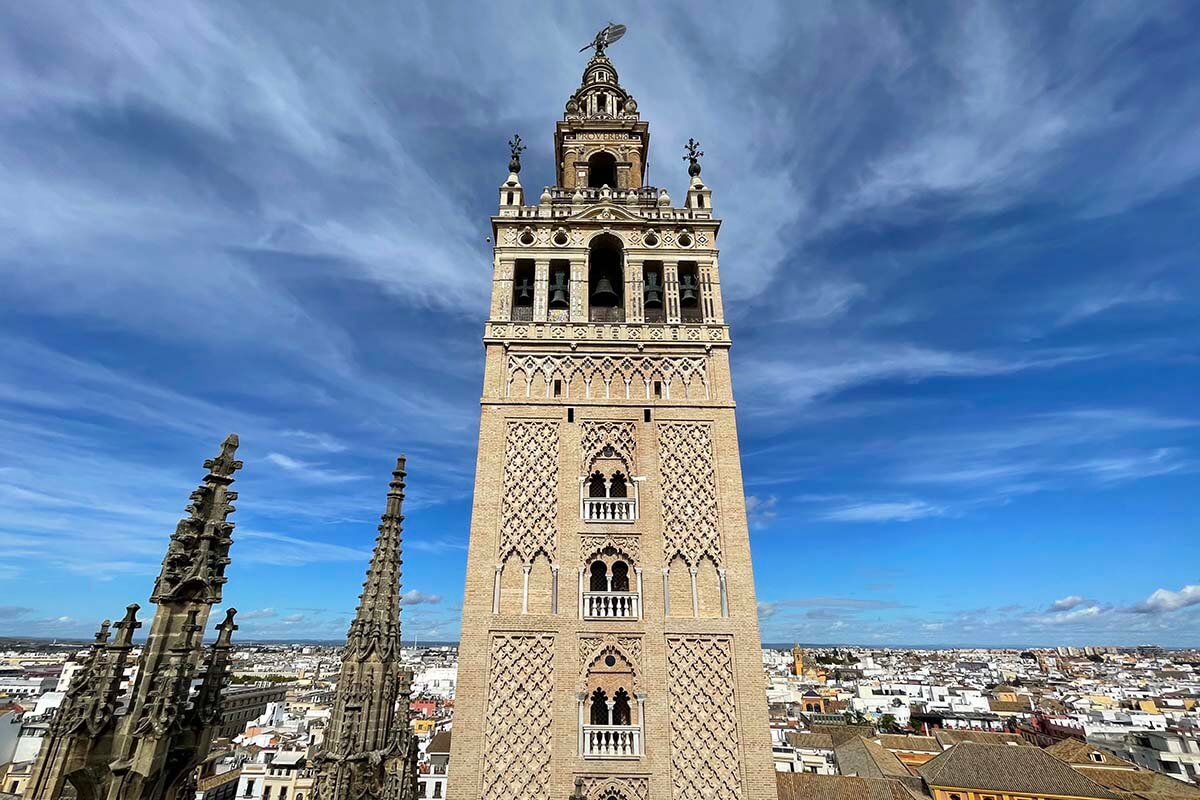
Lunch + Barrio de Santa Cruz
12 – 2 PM.
After all that sightseeing and slow walking at the Alcazar and the Cathedral, you’ll likely be exhausted by noon. So we recommend sitting down for lunch and taking some time to rest and enjoy local food.
There is no shortage of eateries in the old town of Seville, so you’ll definitely find a nice place for some tapas. Just be sure to quickly check reviews (we usually use Google Maps) so that you can avoid tourist traps. I also indicated a few excellent places for tapas on our map – we tried some of them personally and others were recommended by local guides.
Also note that the Spanish tend to eat later, so some restaurants don’t open until 1 PM. However, there are usually plenty of places that are open earlier and if you go to eat around noon, it’s much easier to find a table – an hour later, everything is full.
While you are looking for a place for lunch (or after that), take some time to explore the neighborhood called Barrio de Santa Cruz . Located to the east of the Cathedral and the Alcazar, this is a cozy labyrinth of narrow streets and beautiful historic buildings.
There is a lot more to see here (Hospital los Venerables, La Casa del Flamenco, Casa de Salinas, etc.) but with just a day in Seville, just walk around, have lunch, maybe get some souvenirs, and move on. We indicated a suggested walking route on the map, but you don’t have to follow it to the t, it’s just a suggestion.
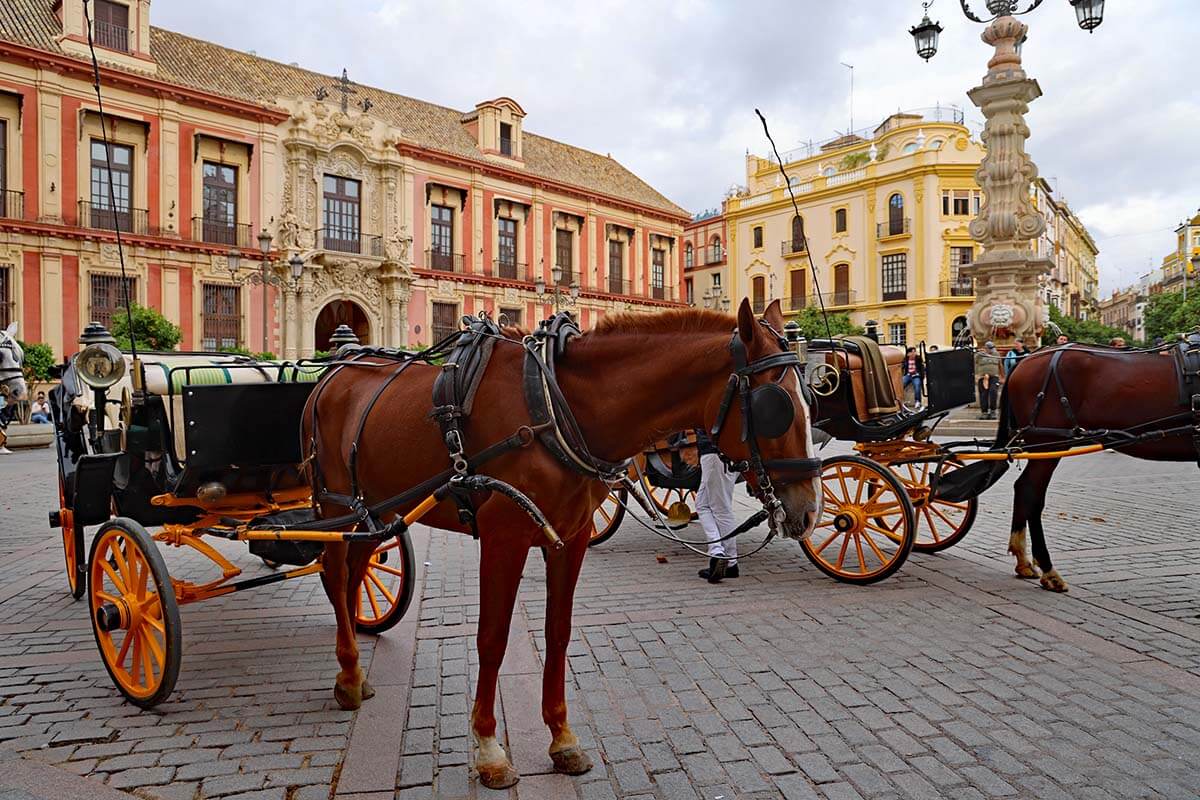
General Archive of the Indies and/or Plaza del Cabildo
Depending on your interests and how you feel on the day itself, there are a few extra places that you could easily add to this one-day Seville itinerary.
One is the General Archive of the Indies (Archivo de Indias), an archive and library that holds important documents about Spain’s colonization of the New World. The archive is located inside a beautiful 16th-century merchants’ exchange building and is free to visit. The exhibition is limited, but the building is nice to see. It’s not a must, but you’ll pass here anyway so if you have a few minutes to spare, you may want to check it out.
Another place that I really recommend seeing is Plaza del Cabildo . This is a very picturesque little plaza surrounded by a unique arched building. It’s a real hidden gem just steps from the main tourist routes and you only need a few minutes to see it. We were here on a Sunday and there was a flea market in the area. Otherwise, it’s much quieter with just a few souvenir and antique shops inside.
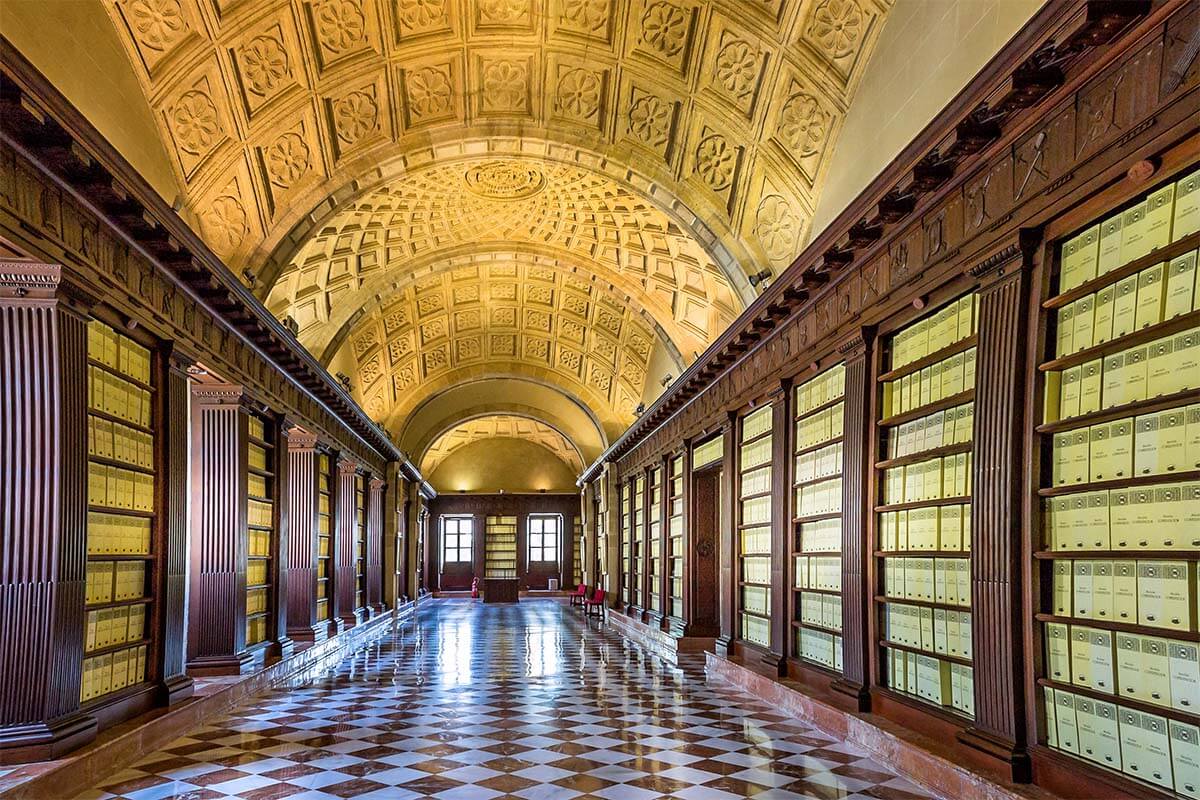
Seville Bullring – La Real Maestranza
2 – 2.30 PM.
Plaza de Toros de la Real Maestranza de Caballería de Sevilla is the bullring of Seville. Built in the 18-19th centuries it’s one of the oldest arenas in Spain and offers space for almost 13,000 spectators. And yes, it’s still used for bullfighting nowadays, although only several times a year. The rest of the time, it functions as a museum.
No matter how you feel about this Spanish tradition, we highly recommend a visit to Seville’s bullring. The building itself is very impressive and you can learn more about Corrida and see paintings, posters, as well as bullfighter’s capes and costumes.
You can also take a peek behind the scenes – the animal stalls, the bullfighter’s chapel, etc. The visit ends at the impressive arena itself.
Good to know: You need about half an hour for a thorough visit. If you want to learn more about the place, you can download a free audioguide using QR codes inside the museum.
Planning info: Normally, you can just get the tickets for the bullring on the spot, but sometimes the queue can be quite long (and other times, no queue at all). If you want to enter without a wait, you can prebook your tickets on their website . We just paid at the entrance and had to wait less than 5 minutes to get in. There are also guided tours available.
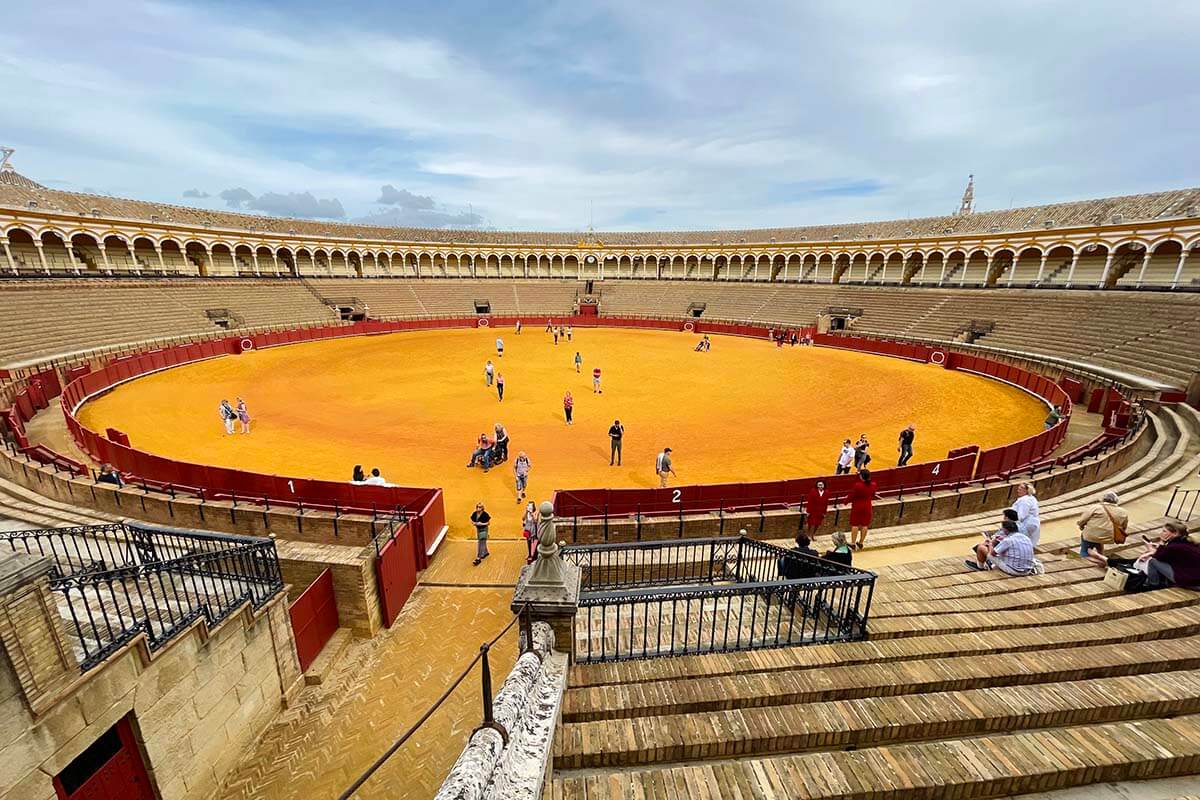
Riverside Walk & Torre del Oro
2.30 – 3.30 PM.
After leaving the bullring, cross the street toward the Guadalquivir River. There is a nice pedestrian walkway here, on several levels (closer to the water or higher, at street level). It’s a very nice area for a stroll, offering a bit of a breeze and great riverside views.
You have a few options here – simply walk along the river in the southeasterly direction toward Maria Luiza Park (next stop on this itinerary), or take a river cruise to rest your legs a bit and see the city from a different perspective.
If you walk, you’ll pass a few places of interest along the way. One is the Nao Victoria 500 , a replica of the first ship that circumnavigated around the world. You can visit this ship and there is a small museum inside, but the fee is quite steep for a rather small exhibition, and you can just see the ship from the outside.
Next, you will pass Torre del Oro (the Golden Tower), a 13th-century tower that was part of the city’s military fortifications. Nowadays, there’s a small maritime museum inside, and you can climb to the top of the tower to enjoy elevated views of the river. It’s nice to do if there is no wait and the ticket price is just a few euros. But it’s not something I would stand in line for, especially if you only have a day in Sevilla and your time is limited.
Continue further south following the river until you reach the entrance to Maria Luiza Park.
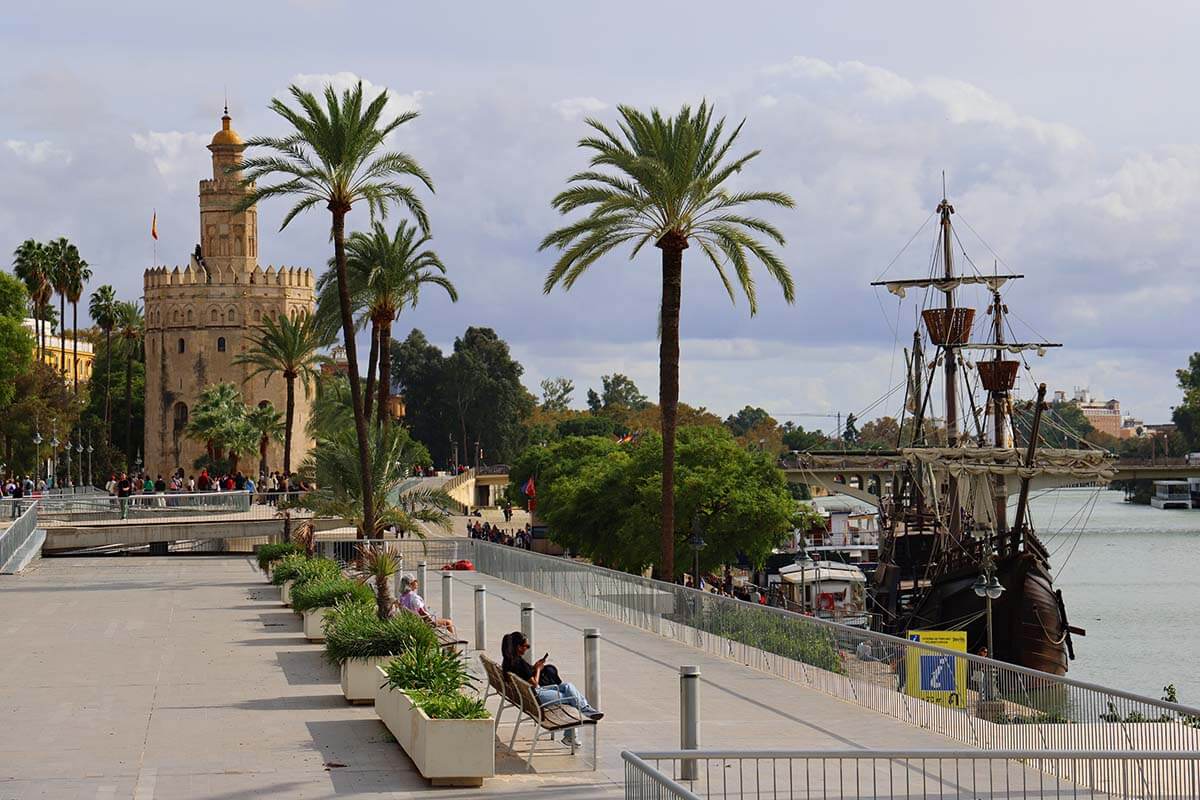
Plaza de España and Maria Luiza Park
3.30 – 4.30 PM.
Parque de Maria Luisa is the biggest and most beautiful park in Seville’s city center. You could rent a bike for half an hour to explore the park in a more relaxing way or simply walk around a bit.
There is a service at the park that rents bikes, tandems, and ‘cyclobuses’ for the whole family. We indicated the location of this rental service on the map, but you’ll likely just pass there as you enter the park from the riverside.
The park is adjacent to Plaza de España , a monumental half-moon-shaped square that you probably saw in Seville travel brochures. This huge square was the centerpiece of the Ibero-American Exposition of 1929 and is absolutely impressive with a canal, several bridges, and a large fountain in the middle. The walls of the buildings surrounding the square are lined with alcoves with azulejo tiles representing different provinces of Spain.
Plaza de Espana is an absolute must-see in Seville. So even though it’s a bit out of the way from all the other places in this itinerary, don’t miss it!
Planning info: The park and the square are public spaces and are free to visit.
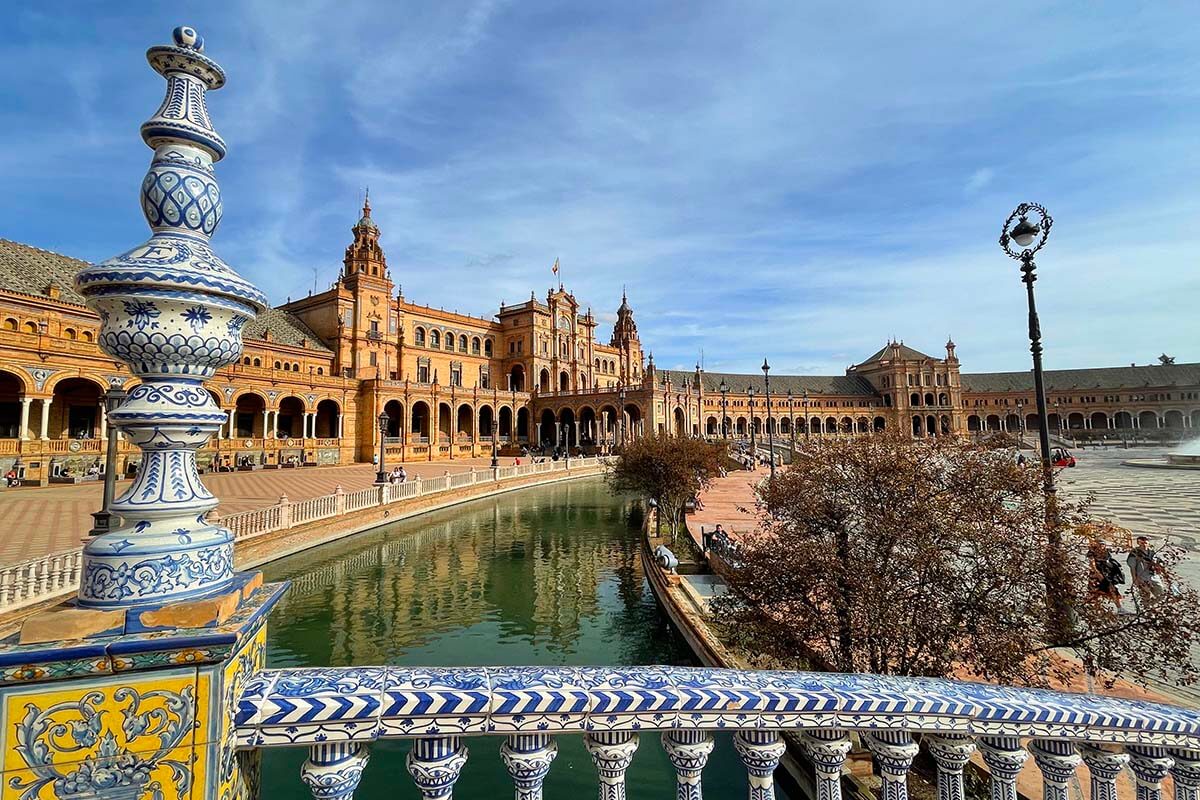
Flamenco Show + Dinner
TIMING DEPENDS ON WHAT EXACTLY YOU CHOOSE
No visit to Seville would be complete without seeing a Flamenco show. After all, Seville is the birthplace of Flamenco, so if there is one place in Spain where you have to see it, it’s in Seville.
There are countless places in the city where you can see Flamenco shows. Often, you will also see performers dancing on the streets. But for the most authentic experience, visit a small traditional theater where the spaces are quite small, the public sits very close to the performers, and the experience is more intimate.
Here are a few suggestions on how to plan your evening in Seville:
OPTION 1 (this is what we did). We opted for this highly-rated Flamenco + tapas tour . It starts at Plaza de San Francisco at 5.30 PM and just walking there (+-25 minutes from Plaza de España), you will see more of the old town along the way. The tour includes tapas and aperitif at abacería (a small grocery store/bar), a traditional Flamenco show, and a sitting dinner at a wonderful local restaurant where you are served so many amazing tapas and wines that you can hardly fit it all in…
This is a long tour – about 4 hours, but there is little walking and it’s a very relaxing and authentic experience. We did it with our teenagers and I was a bit worried that they would find it boring, but they loved it. To my husband, this was the best experience in Seville.
If you opt for this option, the restaurant where you will end the tour is in the center, about 15 minutes walk from Setas de Seville, which is the last place we recommend visiting at the end of the day (more info below).
If you rather explore more of the city on your own, you can easily plan your own Flamenco and tapas evening. Below are two more options – depending on how much walking you want to do.
LEARN MORE: Tapas & Flamenco Tour in Seville

OPTION 2 (Flamenco in Triana). Triana neighborhood, on the other side of the river, is where Flamenco originated. There are several theaters in Triana where you can see a Flamenco show. One of the most popular places here is Teatro Flamenco Triana (also about 25 minutes walk from Plaza de España).
Afterward, head to the area around Mercado de Triana for a tapas dinner. This popular food market will likely be closed by the time you get there, but there are many nice restaurants in the area.
OPTION 3 (Flamenco in the old town = less walking, especially if you follow this itinerary and visit one more place late in the evening – see further). For this option, book tickets for Flamenco in the old town (e.g. Casa de la Memoria or at Flamenco Museum , and then find a nice restaurant for dinner in the same area, before or after the show.
Depending on which theater you choose, the walk from Plaza de España is about 20-30 minutes, but then you are already much closer to the last place in this itinerary (just 3-8 minutes).
I indicated all these theaters on our map (at the top of the article) so that you have a better idea of the location. On the same map, you will also see some recommended restaurants, but there is really no shortage of good places for tapas anywhere in Seville.
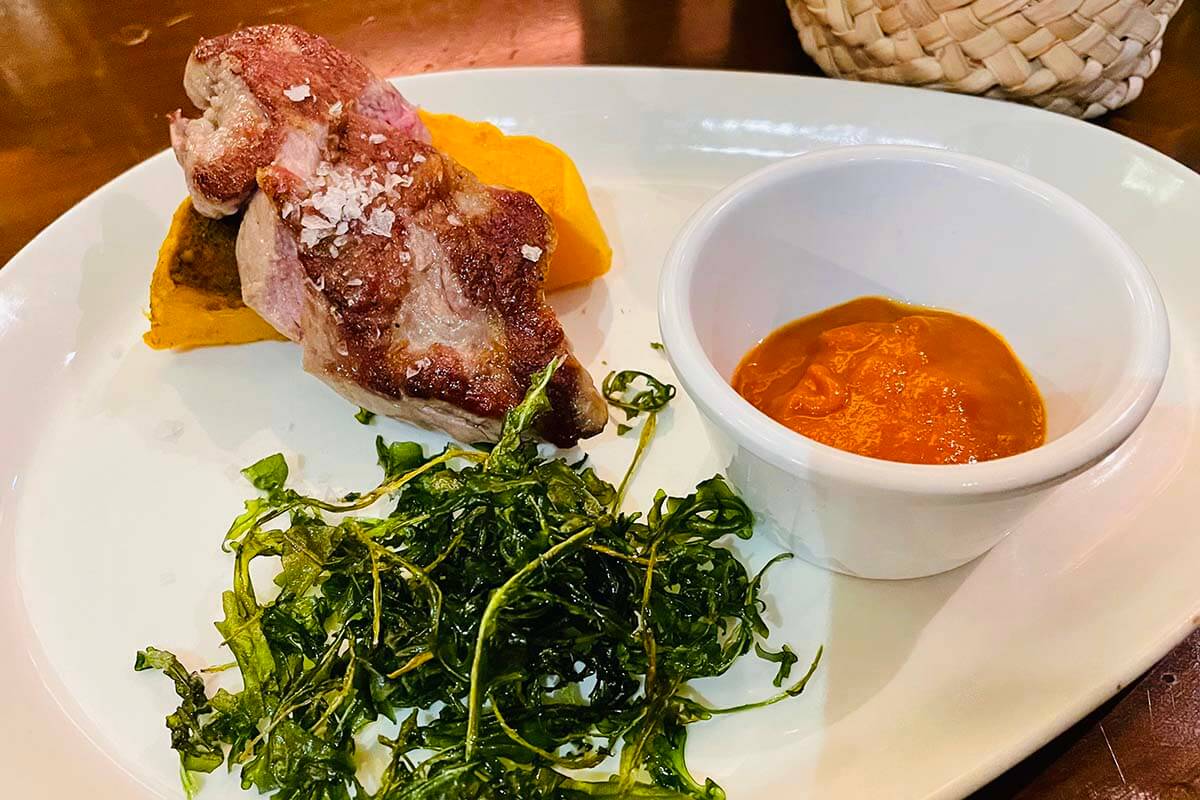
Setas de Seville
LATE EVENING.
There is no better place to end your day in Seville than Setas de Seville , aka Metropol Parasol . So if you want to make the absolute most out of your visit, we highly recommend you check it out!
Setas de Seville is a large modern wooden structure with a viewing platform on top. You can see it from the outside just like that, but you will need a ticket to visit the rooftop.
The views from the top are really nice and many people say that it’s a wonderful place to come at sunset. But we recommend visiting here in the dark when you can enjoy a beautiful LED show ‘Aurora’ as well – it’s absolutely spectacular. The light show starts as soon as it gets dark, so if you come at sunset, hang around a bit longer and see the best of both – day and night views.
Your ticket also includes a ‘Feeling Seville’ experience, which is basically a short film about the city, but it comes with some extra touches that allow you to literally feel the city. I won’t tell more, but it’s really nice, so don’t miss it.
Planning info: The Setas de Seville viewing platform is open very late (usually past midnight), so it’s very simple to fit it into your itinerary. You can reserve timed tickets on the official website in advance, but normally, it’s not absolutely necessary. We got our tickets on the spot, but had to wait over half an hour to get in, so if you absolutely want to be sure to visit (and at a specific time), then you may want to book ahead.

Some Tips for Your First Visit to Seville
Here are some additional tips for your visit to Seville:
- Best time to visit Seville is outside of the summer months. This is one of the hottest places in Spain and sightseeing at over 40°C (104°F) is really not the best way to enjoy the city. If you are traveling in the summer, carry plenty of water with you!
- Avoid visiting Seville during Holy Week (Semana Santa) – it’s so busy that sightseeing is practically impossible. It’s nice to see religious processions, but very difficult to do much else. It’s also the most expensive time to visit.
- Dress comfortably and according to the weather forecast, but remember that the Cathedral has a ‘modest’ dress code. Wear comfortable shoes – you will be walking a lot.
- Book all the tickets/tours that you absolutely don’t want to miss in advance . Otherwise, you won’t be able to see as much in a day and will waste hours in endless queues.
- €€€€€€€€€+ Hotel Alfonso XIII – the iconic historic grand hotel of Seville.
- €€€€€ Radisson Magdalena Plaza – a very highly-rated modern 5* hotel.
- €€€€ Hotel Amadeus Sevilla – a charming, music-themed boutique 4* hotel.
- €€€ Hotel Doña María – a very popular mid-budget 4* hotel set inside an old palace.
- €€ Hotel Cervantes – excellent value hotel a bit outside of the main tourist areas (no pool though).
So, this sums up our recommended one-day Seville itinerary.
As you can see, it offers a nice mix of the most famous historic sights, and unique landmarks, as well as Flamenco and tapas, the two ‘musts’ in any Seville itinerary!
I hope that this guide, our walking map, and tips help you plan an unforgettable visit and make the most out of your time.
TIP: If you are still planning your trip and can slightly adjust the itinerary, we highly recommend staying in Seville longer than a day; there is so much to see and do! Take a look at our 2-day Seville itinerary for additional recommendations for a longer visit.
Have a great trip!
More tips for your trip to Spain:
- Barcelona Travel Tips
- Best Things to Do in Barcelona
- Barcelona 1-Day Itinerary
- Barcelona 2-Day Itinerary
- How to Visit Montserrat from Barcelona
- Montserrat Tour Review
- How to See the Best of Madrid in One Day
- Toledo Day Trip from Madrid
If you found this post helpful, don’t forget to bookmark it and share it with your friends. Are you on Pinterest? Pin these images!
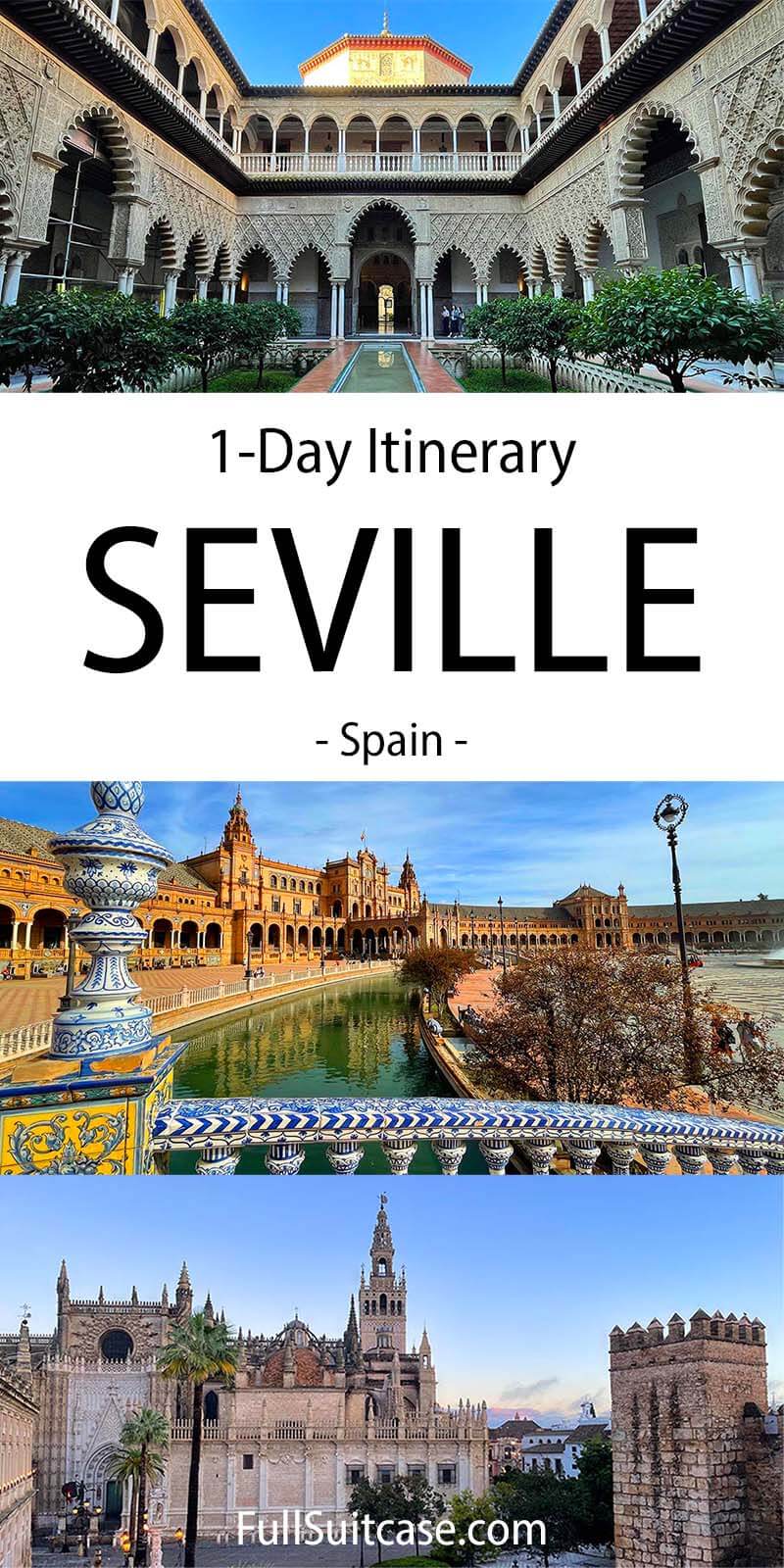
More 1-day itineraries for some of the nicest European cities:
- 1 Day in Amsterdam (Netherlands)
- 1 Day in Edinburgh (UK)
- 1 Day in Florence (Italy)
- 1 Day in Glasgow (UK)
- 1 Day in Lisbon (Portugal)
- 1 Day in London (UK)
- 1 Day in Milan (Italy)
- 1 Day in Manchester (UK)
- 1 Day in Naples (Italy)
- 1 Day in Rome (Italy)
- 1 Day in Salzburg (Austria)
- 1 Day in Venice (Italy)
- You may also like our guide with insider tips on how to plan a trip to Europe .
This site uses Akismet to reduce spam. Learn how your comment data is processed .

- UNESCO Heritage Sites
- Monuments and Must See
- Museums and Galleries
- Churches and Basilicas
- Monuments & Museums Prices and Schedule
- Day Trips from Seville
- Guided Tours and Experiences
- Seville for Children
- Sports in Seville
- Free PDF Travel Guide
- Seville in 5 days
- Itineraries and Useful Information
- Blog about Seville
Pictures of Seville
Welcome to the Best city in the World
Visit Seville and explore the Best City in the World
Visit Seville and explore the rich, intimate streets of the city , become captivated by the immemorial culture surrounding you, and fall in love with heart of Andalucia . Discover a city brimming with life and history and learn how its evolved through the centuries and inspired the rest of the world. The city of Seville is a welcoming one and will captivate you immediately .
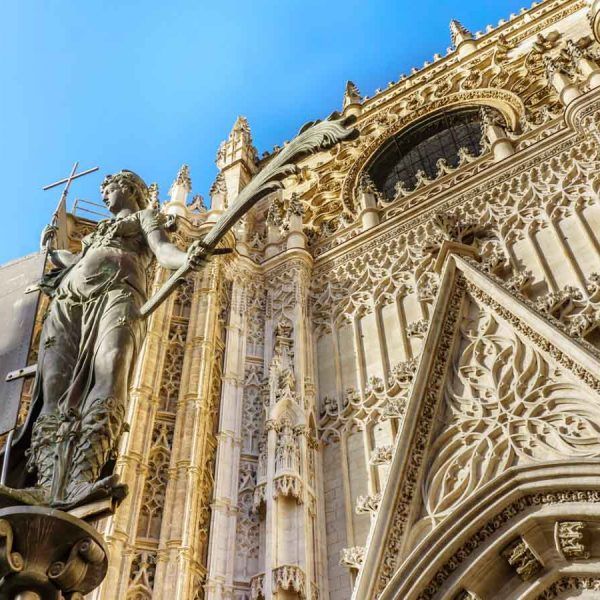
Seville UNESCO Heritage Sites
Timeless icons recognized by the entire world: this is what Seville is known for. These wonders should be your first stops.

+ Things to See in Seville
Whether you are here to learn, mentor, or just take a good picture, these are the cornerstones of history that can’t be missed.

Seville Guided Tours & Experiences
Hit every site and learn everything you could ever want about this illustrious city all while skipping the queues.

Best Day Trips from Seville
Stray outside the city and discover that the beauty of southern Spain is vast, ancient, and unlike anything else in the world.

Itineraries & Useful Information
Tips and Tricks: Use these maps and time tables to make your experience fun and easy.

Seville in 5 days Itinerary
A lively city with activities and events all year round, while here for even a few days you can still dive into rich culture and activities.

Flamenco in Seville
Find the best places to never miss one of the highest form of art and expression in Southern Spain.
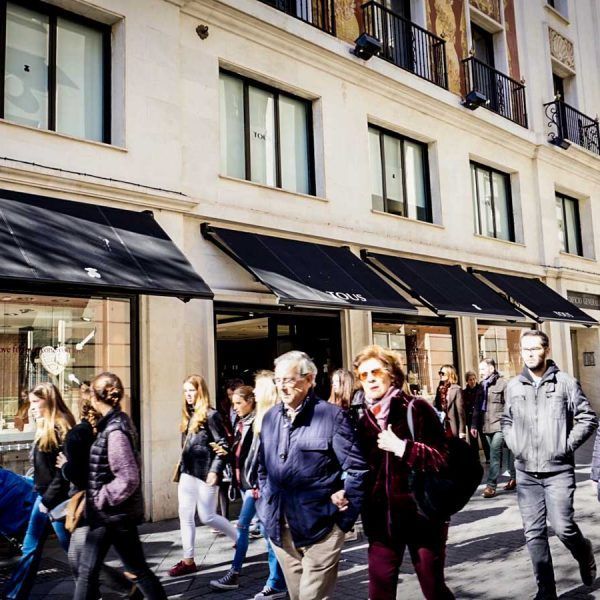
Shopping in Seville
The style of Seville is unique, often mimicked but never perfected and here you will find the best stores and districts in the city.

Seville Gastronomy
Tapas are the the highlight of Seville and finding the best place to relax and enjoy is an important choice.

Picture perfect proof. Seville’s beauty cannot simply be captured in pictures, however. You must see it for yourself.
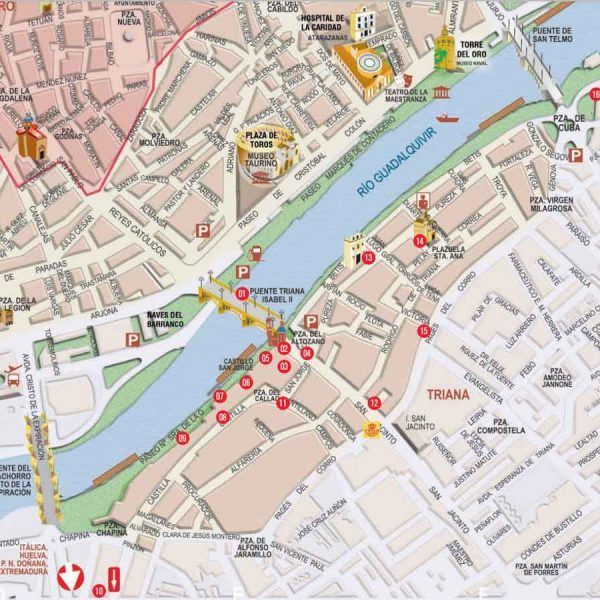
Seville Tourist Map
Here you can download and print the only map you’ll ever need here in Seville.

Seville Monuments Prices and Schedule
Find here the schedules and information of all the monuments of the city.
Trending Tours and Experiences in Seville
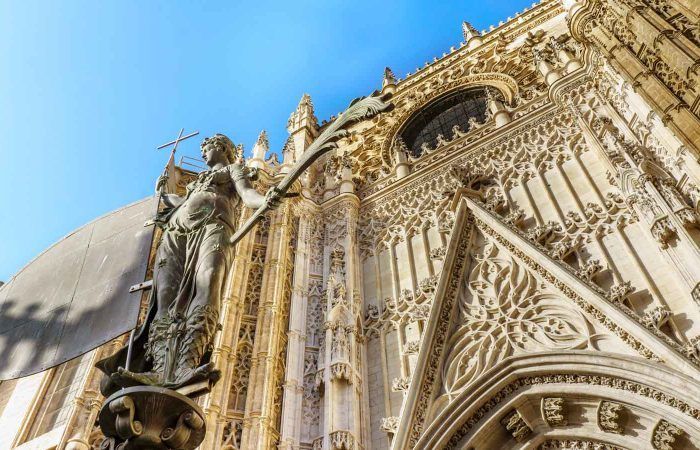
Alcazar and Cathedral of Seville Tour (Tickets included & Skip the line)

Horse Riding Tour in Aljarafe from Seville

Seville Bike Tour

Seville Kayak Tour

Visit an Olive Oil Farm in Seville

Wine Cellar Visit from Seville

Royal Alcazar Seville Guided Tour

Cathedral and Giralda of Seville Guided Tour

Seville Bike Rental
Trending day trips from seville.
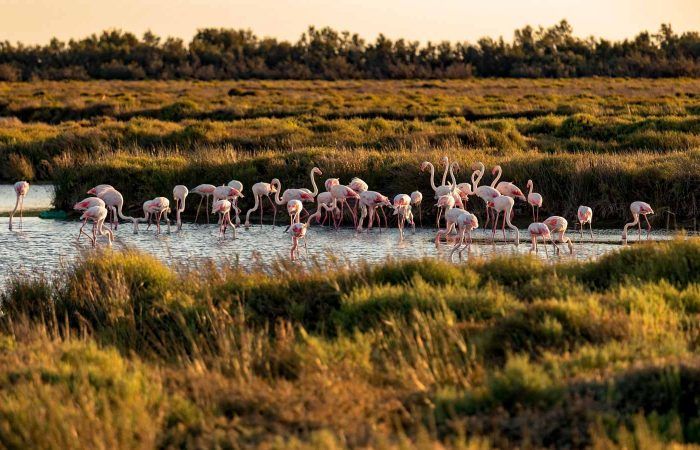
Seville to Doñana National Park 2 day 1 night trip

Tarifa to Tangier day trip
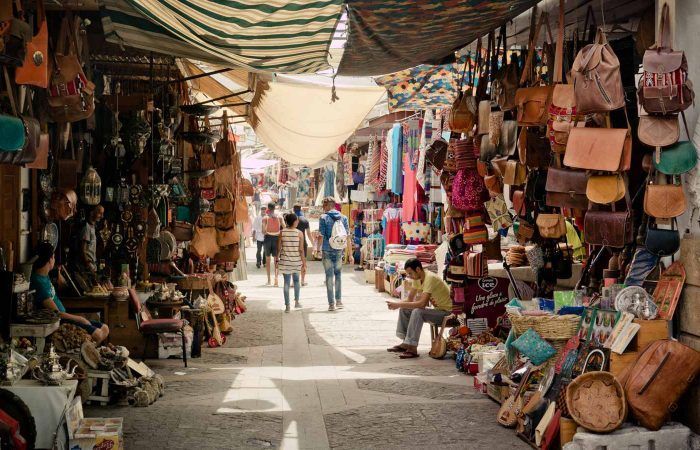
Seville to Tangier 2 day 1 night trip

Seville to Ronda and White Villages 2 day 1 night trip

Seville to Tangier Morocco day trip

Ronda and White Villages Day Trip from Seville

Seville to Aracena day trip. Cave of Wonder and Rio Tinto Mines

Seville to Cadiz and Jerez day trip

Seville to Cordoba Day Trip
Why do you have to visit seville, a unique and different lifestyle.
Come to Andalucia and live like a Sevillano. Enjoy the tranquility of the city and wander the streets during the day, taking in the Guadalquivir river, followed by tapas and flamenco as you watch the city come to life.
An Incomparable Historical Heritage
The 22 hundred years of history of this city and its influencers are obvious in its structure and architecture. The Muslim and Christian occupation throughout its history has molded Seville into the accepting and intellectual city it is today. The city itself tells its own story of art, expression, and exploration unlike any other.
Seville and its Cultural Heritage
Seville and it’s geography make it a mixing bowl of people and culture. Influenced clearly by their neighbors to the south, African and Arab accomplishment and influence can be seen throughout all aspects of the city, especially from its inhabitants.
Andalusia a Privileged Natural Environment
There is more to see in Andalucia than just its timeless architecture. The Iberian peninsula is home to some of the most spectacular sites on earth, the most gorgeous surrounding Seville. Journey to the Rock of Gibraltar and through Morocco, or visit breathtaking beauties such as the Alhambra in Granada and the lush Doñana National Park.
Our last posts to enjoy your holidays in Seville
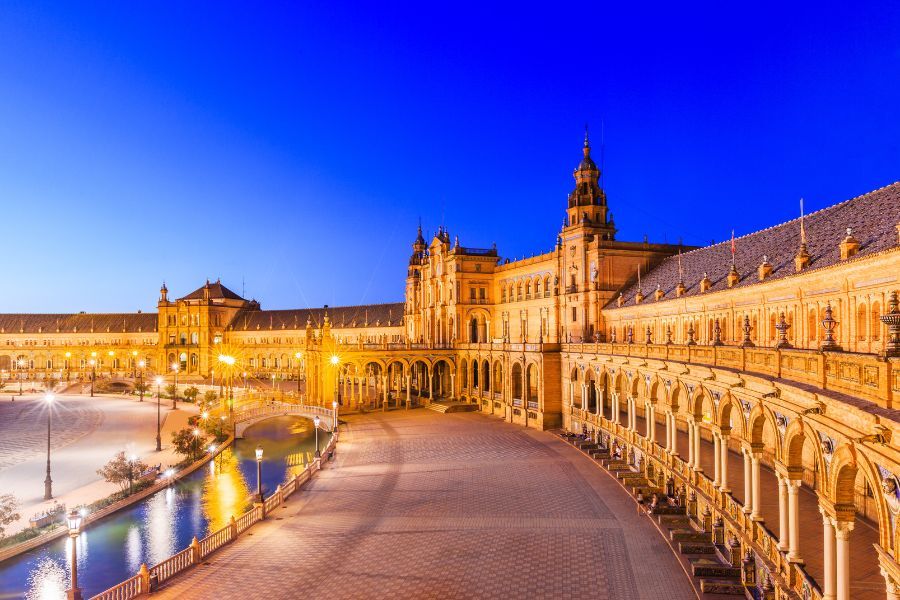
Best time to visit Seville
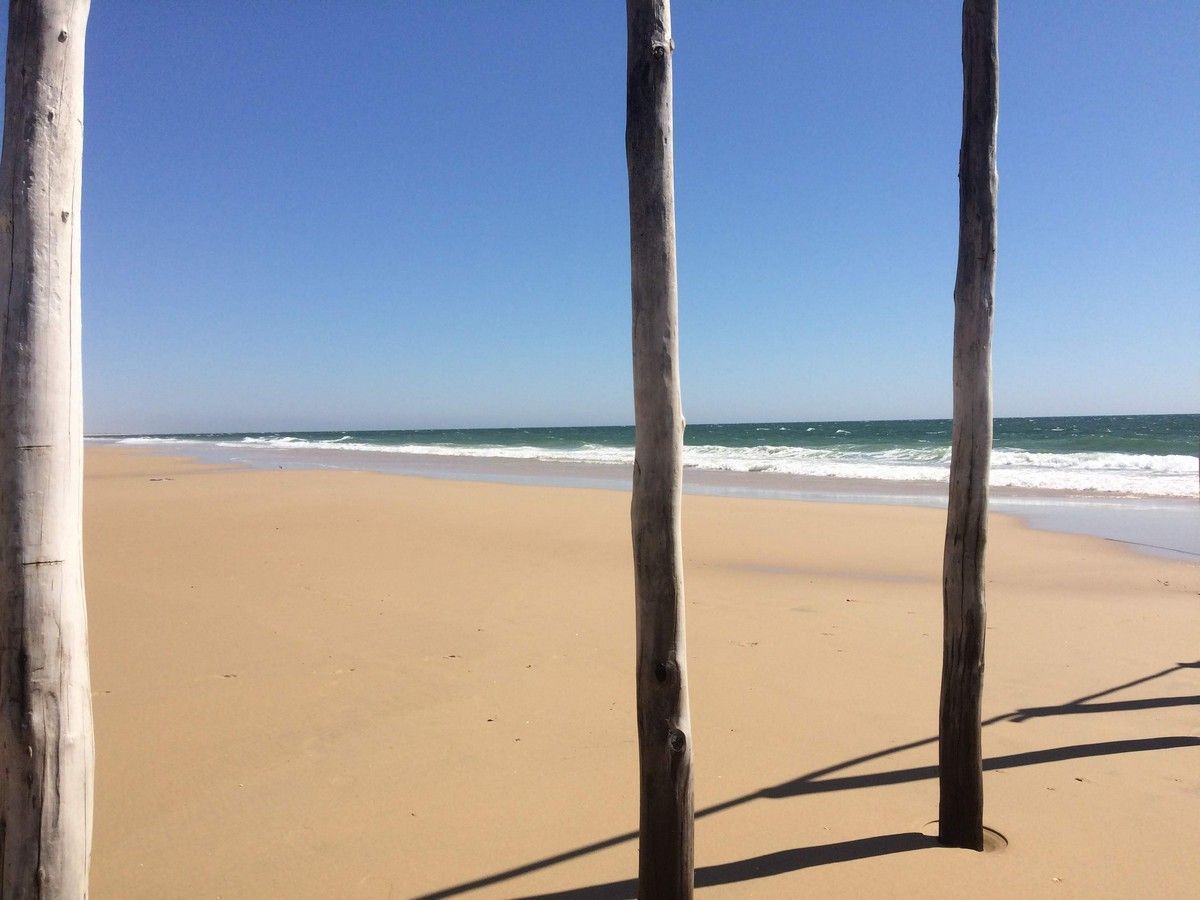
Beach destinations near Seville

Seville in 2 days
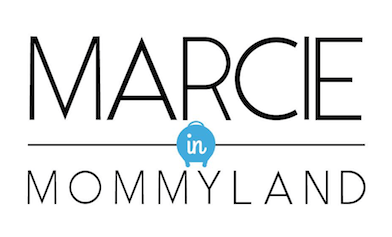
Your Guide to the Top Tourist Attractions in Seville, Spain
Posted on Last updated: January 3, 2024
Home » Destinations » Europe » Spain » Your Guide to the Top Tourist Attractions in Seville, Spain

Sharing is caring!
Planning a trip to Seville and want to know what to add to your Spain itinerary? Keep scrolling to check out the best tourist attractions in Seville worth doing!
This list of tourist attractions in seville spain was co-written by family travel expert marcie cheung and contains affiliate links which means if you purchase something from one of my affiliate links, i may earn a small commission that goes back into maintaining this blog..
G uest post by Chris from aroundtheworldwithme.com
Are you headed to southern Spain and looking to learn about Seville’s best attractions? Then you’ve come to the right place, as we will go over all the amazing Seville tourist attractions in this article.
Tucked away in the south of Spain, Seville is a lovely city full of beautiful streets and plazas.
Oranges grow from orange trees along the road and flamenco dancers entertain tourists in the squares. Exquisite palaces flank the medieval streets, and the food is to die for.
I’m sure you’ll love this unique Spanish city!

Seville – What You Need to Know
Where is seville .
Seville is in southwest Spain, not too far from the Portuguese border and just north of Gibraltar.
It’s not a huge city, with a population of around 700,000 (metro area 1.5 million), and the central region is actually quite compact and easy to walk around.
It’s the capital of the province of Andalusia, which also includes Cordoba, Malaga, and Granada.
How to Get to Seville
It’s very easy to get to Seville by plane, train, or car. The airport, however, is not large so if you’re coming from outside of Europe, you will not get a direct flight.
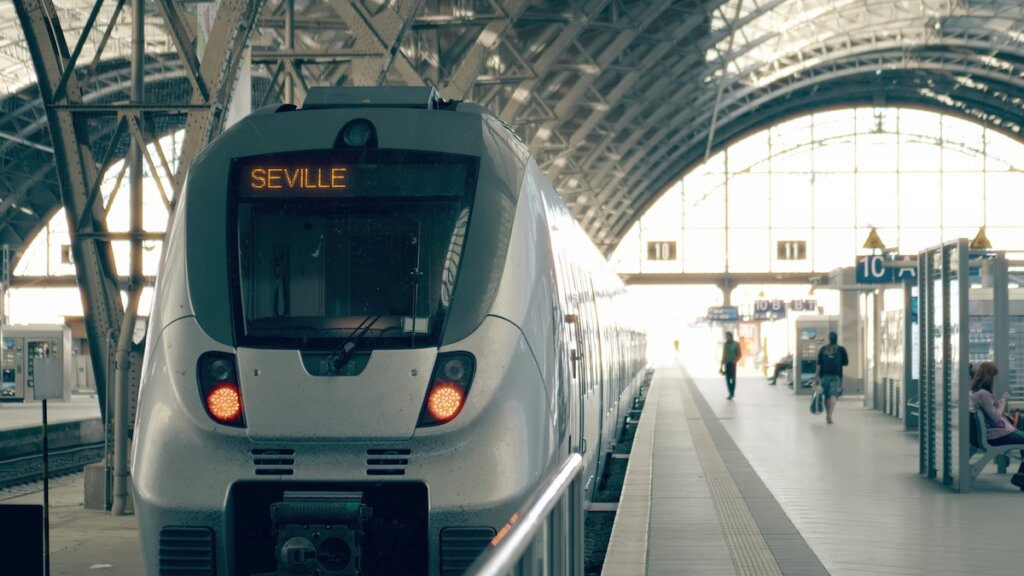
From the airport, there is a bus that will take you into the city or it’s only about a 10-15 minute drive should you wish to hop in a taxi.
If a stopover isn’t your thing, the closest major international airport is Lisbon, about 4-5 hours away by car. However, a better and quicker option is to fly to Madrid and take the train from there.
The Renfe zooms you across southern Spain to Seville is less than three hours from central Madrid. If you’re driving into the city, be sure to check out my guide to driving in Europe first.
How to Get Around Seville
Seville is a very walkable city, and every street is gorgeous.
You shouldn’t have to take a taxi or any public transport on your visit to Seville once you’ve arrived in the city center. It’s tiny compared to Madrid and Barcelona and if you are okay with walking, it’s the ideal city.
If you’re tired, there are plenty of taxis available. Uber does operate in Seville but is not as common as taxis so wait times can be significant.
Weather and When to Visit Seville
Summers in Seville can be downright brutal. Summer highs are often over 100 degrees (38 C) and air conditioning is not always guaranteed. Ensure where you stay has air conditioning no matter when you go.

Spring and fall are warm but nice and winter can be warm enough for T-shirts and shorts. It’s a semi-arid climate so mostly dry and sunny.
In terms of the best time of year to visit, the summer is just too hot. Seville is a spring or fall trip. I went in late April and the weather was perfect.
It’s also somewhere you can easily visit in the winter and still have clear skies and not be cold. Just remember the days are far shorter in the winter and it will get chilly after the sun sets.
You might have heard before that a lot of Spanish folks don’t really speak any English. And that’s certainly true in Seville. It’s likely that your server at the restaurant won’t speak any English, but they’ll have English menus.
It’s a very touristy city so speaking Spanish is not necessary. People at hotels, guest houses and the main tourist attractions will speak English.
Food in Seville
The food in Seville was sublime. See the section below about eating in Seville.
The currency in Spain is the Euro and it’s vital to carry around cash. Spain is cheaper than Northern Europe. But in the tourist-heavy central city prices will be inflated.
Where to Stay in Seville
Be sure to stay in the city center, within the old city walls. That way you’ll be able to walk everywhere. Accommodation is affordable and it’s worth it to stay where the action is.
There is a wide range of hotels, hostels, and Airbnbs to choose from when visiting Seville. A few of my top picks include Basic Hotel Sevilla Catedral , Puerta Catedral Apartments , and the Inglaterra Hotel.
How Long to Stay in Seville
The ideal stay in Seville is 2-3 nights, more if you want to taste more of the local food and see more flamenco performances. Two days will provide you with ample time to hit all the sights and enjoy some sangria on a nice terrace.
The flamenco comes from Seville. If you’re not familiar with this unique dance style you should definitely attend a flamenco performance.

There are many throughout the city and I can’t say that any are necessarily better than others. I went to Casa Del Flamenco and enjoyed it. There are many others though to check out.
The Top Tourist Attractions in Seville
Seville is loaded with beautiful sights and sounds. Just walking the city and taking it all in is enough to keep anyone entertained.
But here are a few of the top tourist attractions in Seville that you need to check out in order to have the best experience.
Plaza de España
The Plaza de España is arguably the most popular spot in the city. Though outside the ancient city walls and built relatively recently in European terms, it’s an architectural masterpiece.
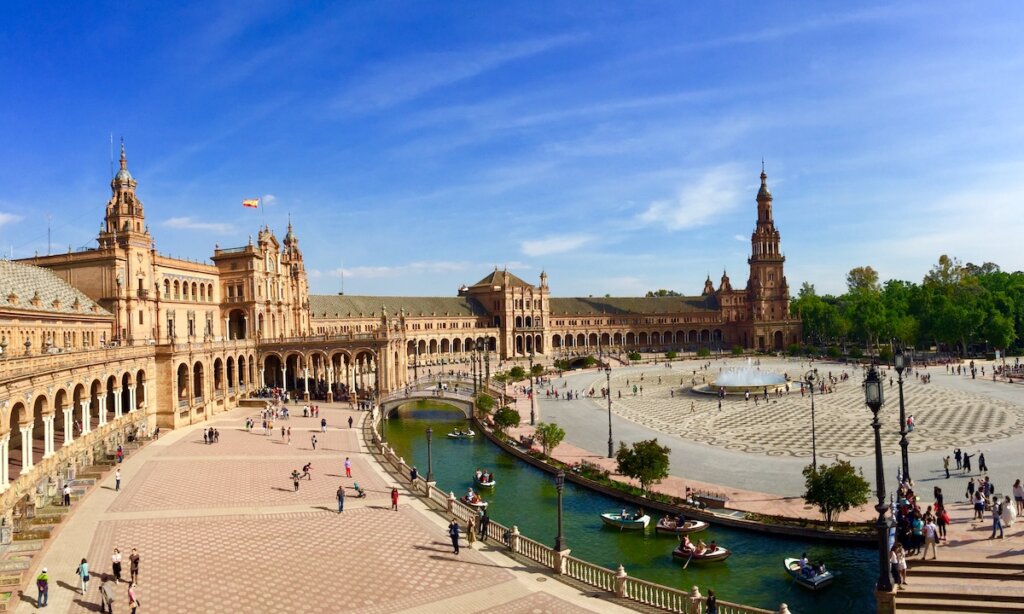
It’s essentially a large semicircular plaza flanked by a massive semicircular building that contains various government offices. A small canal runs around the plaza and there are some gorgeous footbridges over the canal.
The plaza is a popular tourist destination, and you can also find flamenco dancers and street performers.
The plaza is surrounded by beautiful park areas on nearly all sides. You’ll find the parks full of orange trees, should you want some fresh fruit. Andalusia is one of Europe’s top orange-producing regions, along with Sicily and the Peloponnese Peninsula in Greece.
Catedral de Seville
The gothic cathedral in Seville is the largest of its kind in the world and the fourth-largest church in the world. There’s no denying it is simply massive.

Completed in the early 1500s, it symbolized the wealth and prosperity of Seville at the time. Today it’s a well-known landmark and one of the most recognized cathedrals in the world.
Entry to the church – which includes the tower – costs 10 Euros. The church recommends booking online in advance. Operating hours are ever-changing so check the website for the latest details.
Setas de Seville
No one can describe exactly what the Setas de Seville is. It’s like a giant architectural wooden sculpture that’s also an observation deck that you can walk around. It’s modern – from this century – and stuck right in the middle of the city.

There are walkways that take you along the top of the structure, which loosely resembles a forest of trees. From up there you can get some nice views of the city. The structure itself is the attraction though.
Maybe I’m biased since the company I worked for in Europe designed it, but it’s pretty impressive! Check the latest rates and availability .
Real Alcazar de Seville
This is one of the most iconic palaces in Spain. Located within Jardines de Morillo (a beautiful large park), the Real Alcazar de Seville was constructed over a period of about 500 years.
These days it’s been restored and is well kept. Book tickets online in advance as it gets quite popular.
Casa de Pilatos
Another beautiful palace in the city. Book in advance online . Casa de Pilatos is a very common spot to stop on a tour around Seville.
Torre del Oro
An ancient defensive tower at the edge of the city wall, Torre del Oro is small but popular. Check the website for the latest information.
As of 2023 the museum at Torre del Oro is open daily and costs only 3 euros for entrance (free on Mondays).
Museo de Baile Flamenco
If you want to learn the full history of flamenco dance, Museo de Baile Flamenco is the place to be. Flamenco is hugely popular in Seville and Spain.
After checking out the museum, be sure to hit a flamenco show. They last about an hour and a half and will thrill you with rhythmic dancing and classical guitar.
Plaza de Toros de la Real Maestranza de Caballeria de Seville
No cultural tour of Spain is complete without at least recognizing the history of bullfighting in the country. We can debate all day whether or not the practice should still remain well into the 20th century, but that’s for another day.
At Seville’s bullfighting ring you can tour the stadium – which dates back to the 1700s – and learn all about bullfighting in Seville in the museum. Entrance is 10 EUR.
Mercado de Triana
If you’re looking for some local foods or goods, stop by the Mercado de Triana.

It’s a large indoor market that sells just about every type of Spanish food you can think of. You’ll see the standard cured pig legs hanging from the jamon shop, as well as tons of sweets and fresh produce.
Other Stops to Make
There are literally endless other things you can see in Seville. Here are a few of the other stops you might want to make.
- Seville Museum of Fine Arts
- Palacio de las Duenas
- Archivo de Indias
- Hospital los Venerables
- Alameda de Hercules
- Universidad de Seville
Eat and Drink Seville
Food is like religion in Seville. Tapas are said to originate from Seville and the city is loaded with tapas bars and fantastic restaurants.
Regional cuisine in the Andalusian province is unique so be sure to try some and not be tempted to just order paella because you’re in Spain. If you’re in Barcelona, sure, get some paella.
But here in Seville, have your taste buds experience the rich flavors of southern Spain.
I’m not a huge fan of tapas – I always feel that by the time I get enough food to feel satisfied I’ve spent half my paycheck – but I loved the food in Seville.

I probably had the best octopus tentacle I’ve ever had at a small cafe in central Seville (close call with the octopus I had in Barcelona). So don’t skimp on the food bill in Seville. Live it up!
What to eat in Seville
Some of the local dishes you might want to try:
- Pork cheek: usually slow-cooked in a tomato-based sauce
- Bull’s tail: exactly what it sounds like, slow-cooked to perfection
- Solomillo al whiskey: fried pork loin in whiskey sauce
- Jamon de Iberia: the famous Spanish cured pig leg (eat plain or in a sandwich or both)
- Flamenquines: Spanish croquettes filled with jamon and goat cheese
- Espinacas con Garbanzos: one of the few choices, if you’re vegetarian, is this spinach and chickpea curry-like dish
- Gazpacho: this well-known cold tomato soup comes from Seville
- Churros: these can be found the world over these days, but they originated in Seville. Have them for breakfast.
You can also find great grilled octopus in Seville (and pretty much anywhere near the coast of Spain for that matter). For a more detailed list, you can check out this post about eating in Seville.
Dinner Time
If you’ve never been to Spain before you might be a little thrown off by how late the Spanish eat dinner. Typical dinner time is around 9:00 p.m., and most restaurants won’t even open till 8:00 p.m.
Closer to the city center there will be restaurants that are open all day to cater to tourists though. And tapas bars are typically open throughout the day and evening.
If you really want to be one with the locals, make your dinner reservations for 9:00 p.m. Note that most restaurants don’t offer their menu on their website so seeing the menu in person is really the only way.
Tapas Bar vs. Restaurant
They might seem synonymous, but there is a clear distinction between tapas bars and restaurants in Seville. Tapas bars usually don’t have set meal times and feature only tapas on the menu.
While restaurants will also usually have an assortment of tapas options, they’ll also offer larger, proper meals. It can be hard to tell the difference from the outside. The tapas bar will usually say “tapas bar” though. Either way, you’re bound to get some great food.
Vegetarians and Vegans
Traditional Spanish food is not too kind to vegetarians and vegans. You won’t be able to try most of the local delicacies.
But Seville is a modern city and there are plenty of restaurants in Seville that cater to vegetarians and vegans these days.
So it’s not like you’ll starve or anything. Just be aware that if you go to a traditional restaurant, you might have slim pickings on the menu.
What to Drink
It’s not agreed upon exactly where in Spain sangria originated from, but it’s possible it came from the Seville region. The fruity mixture of watered-down red wine and fruit juice is a staple in Spain.
In fact, according to EU law the drink can only be called sangria if made in Spain or Portugal. So be sure to try this refreshing beverage when you’re in Seville.
If you want something local but less popular worldwide, opt for a tinto de verano. This literally means “summer wine” and is similar to sangria in that it’s red wine-based and served cold. Mixed with lemon or lemon-lime soda and a slice of lemon, it’s perfect for a hot day.
And lastly, there is always just good old-fashioned wine. Spain is more known for its red wines, so be sure to get a glass of local wine wherever you go.
Outside Seville
Southern Spain is loaded with world-class destinations. The following sites are all close enough to be a day trip from Seville. So if you have a few extra days why not check out one of these spots.
- Amphitheater of Italica : an ancient Roman amphitheater right outside the city
- Granada : historic Spanish city home to the Alhambra Palace (Link)
- Cordoba : beautiful southern Spanish city home to four UNESCO World Heritage Sites
- Cadiz : hit the beach in this ancient port city on the Atlantic side of the Strait of Gibraltar
- Setenil de las Bodegas : a village of white houses literally built into the cliffs
- Parque Natural Sierra de Hornachuelos : If you’re up for some hiking in nature
Final Word About Seville Tourist Attractions
Seville is a fantastic city to get lost in. Full of culture, the city will charm you and leave you wanting more.
You could spend days just wandering the bustling streets and trying all the different local dishes at the tapas bars. And don’t forget to check out a flamenco performance!
Looking for more Spain content? Check out How to Plan a Trip to Spain: Step-by-Step Guide , 8 Best Day Trips from Benidorm, Spain Worth a Visit , Meaningful Mallorca Tips for First-Timers to Spain , and Hidden Gems in Spain You Won’t Want to Miss !

Unlock Your Free eBook
Our exclusive eBook, Top 10 Unforgettable Family Adventure Destinations , is your ticket to a world of wonder and excitement. Get your free copy today!
This site uses Akismet to reduce spam. Learn how your comment data is processed .

COMMENTS
This historic quarter of Seville has its own distinct character and identity. Across the river from the main tourist attractions of Seville, the neighborhood has the ambience of being a world apart. Similar to the Barrio de Santa Cruz, the Barrio de Triana is a maze of narrow cobblestone streets and alleyways leading to atmospheric squares.
Here are the 25 most visited Seville tourist attractions. What to do in Sevilla?: 1. Must see: ... The Iglesia del Salvador, or 'Savior Church', is the most important church in the city after the great cathedral of Seville. It has a beautiful main altar and numerous wall and ceiling paintings. This landmark is definitely worth a look inside.
5. Clap along to an entrancing flamenco show. Raw, passionate and utterly hypnotic, flamenco in Seville is rooted in Triana. This typically working-class neighborhood was originally home to the Roma community, people who migrated from eastern Europe in the 15th and 16th centuries.
One of the church's main highlights is the Chapel of the Holy Christ, which has a striking crucifix. Another is the Chapel of the Virgen del Carmen, known for its exquisite artwork. ... (Patio of Maidens), the Palacio de Don Pedro is considered one of the top tourist attractions in Seville. 2. La Giralda
10. Museo De Bellas Artes De Sevilla. The Museum of Fine Arts of Seville, founded in 1839, contains a collection of works from medieval times through the early 20th century. It displays a choice selection of works by Spanish artists from the 17th century, the so-called Golden Age of Sevillian painting. Monday Closed.
Discover the best things to do in Seville, Spain, from exploring the grand Seville Cathedral and La Giralda tower to tasting your way through Barrio Santa Cruz. ... is now a tourist information ...
La Macarena & Alameda de Hércules. Housed in the basement of the Metropol Parasol, this small museum showcases the ancient finds that were unearthed during excavation of the plaza. Raised…. 1. 2. Discover the best attractions in Seville including Real Alcázar, Catedral & Giralda, and Museo de Bellas Artes.
It reflects the three main cultures (Catholic, Arab and Jewish) that dominated Seville throughout its history. See ways to experience (21) 8. Setas de Sevilla (Metropol Parasol) ... Other Top Attractions around Seville. 2023. Archaeological Ensemble of Italica. 1,426. 7.6 km away. Santiponce. Ancient Ruins. 2023. Mezquita Cathedral de Cordoba ...
8. Discover Triana neighborhood. Triana is one of the most iconic and more traditional areas of Seville. And while the old town is the historic district where you can find most attractions. Triana is one of the most legit neighborhoods, mostly locals live here, and it has a heavy cultural significance.
10. Museo De Bellas Artes De Sevilla. The Museum of Fine Arts of Seville, founded in 1839, contains a collection of works from medieval times through the early 20th century. It displays a choice selection of works by Spanish artists from the 17th century, the so-called Golden Age of Sevillian painting.
The Best Landmarks, Attractions, and Top Sights to Visit in Seville: Royal Alcázar of Seville • Catedral de Sevilla • Plaza de España • Setas de Sevilla • Casa de Pilatos • La Giralda • Plaza de toros de la Real Maestranza • Palacio San Telmo • Puente de Triana • Maria Luisa Park.
It is one of the top Seville tourist attractions you must see. Book a fast track to the cathedral and Giralda. 3. The magnificent Real Alcazar of Seville. The Alcázar, a royal palace, is the city's cultural centerpiece; a hybrid of Moorish and Christian Castilian architecture and design known as Mudéjar.
We created a top 15 with the best tourist attractions, including a tourist map of Seville. Spain January 31, 2022 August 24, ... It has two of Seville's biggest tourist attractions, the Real Alcázar and the Cathedral, ... The city was once the main trading center for overseas and colonial trade, so the wealth was endless. ...
A visit to the Royal Alcázar is included on our four-day Mini Trip to Seville. 2. Cathedral. Cathedral, Mosque. Share. Add to Plan. Seville's greatest Catholic monument amazes with its sheer size: it is the largest Gothic cathedral in the world. Construction of this sprawling Gothic complex, which houses 80 chapels and has the longest ...
1. Visit the Alcázar Palace. The Réal Alcazar (Royal Alcazar) is a "must-see "in Seville. In fact, if you only have time for one sight here, see this remarkable palace! It was at the top of my Spain bucket list once I could afford more travel.. This UNESCO World Heritage Site holds the evolution of the city here in its walls, from the Arabic period and Middle Ages to the Renaissance and ...
The main tourist attractions in Seville are all about a 5 -10-minute walk. Treat yourself to a stay at the opulent Moorish-inspired hotel and experience the charm and sights of Seville that surround you on the doorstep. To book, check prices or availability for Hotel Alfonso XIII;
Discover historical tapas bars and hidden gems, indulging in some of the best local dishes away from the main tourist traps. Make sure you turn up with a strong appetite! Insider travel tip: Most restaurants and tapas bars in Seville don't open until about 8pm for dinner. Locals usually visit restaurants from 9pm, so you may need to eat a ...
The Plaza de España, a grand plaza in the Parque de María Luisa, was built for the exposition and features elaborate tilework and a moat. Today, it's one of the city's main tourist attractions. Seville is known for its hot and dry summers, with temperatures regularly exceeding 40°C (104°F) in July and August.
The Maestranza is one of the most important bullrings in Spain and one of the most visited monuments in Seville. Discover it here. Seville Airport. Seville Santa Justa Train Station. US$ 61.10. Book. Seville Santa Justa Train Station. City of Seville. US$ 57.30.
Here's our recommended itinerary for one day in Seville in a nutshell: 9.30 - 11 AM: Royal Alcázar timed-entry tickets or early-access tour. 11.15 AM - 12 PM: Seville Cathedral and Giralda Tower: timed-entry tickets or guided tour. 12 - 2 PM: Explore the old town + lunch. 2 - 2.30 PM: Plaza de Toros (bullring).
Visit Seville and explore the rich, intimate streets of the city, become captivated by the immemorial culture surrounding you, and fall in love with heart of Andalucia. Discover a city brimming with life and history and learn how its evolved through the centuries and inspired the rest of the world. The city of Seville is a welcoming one and ...
People at hotels, guest houses and the main tourist attractions will speak English. Food in Seville. The food in Seville was sublime. See the section below about eating in Seville. ... But here are a few of the top tourist attractions in Seville that you need to check out in order to have the best experience.
Print. Get App. Interactive map of Seville with all popular attractions - Alcázar, Catedral de Sevilla & Giralda Tower, Barrio de Santa Cruz and more. Take a look at our detailed itineraries, guides and maps to help you plan your trip to Seville.